|
|||||||
| Community Links |
| Pictures & Albums |
| Members List |
| Search Forums |
| Advanced Search |
| Go to Page... |
 |
|
|
Thread Tools | Display Modes |
|
|
#101 |
|
⊙▃⊙
|
Sorry i'm late: Returned my laptop to the school last night and I could only pick up my new laptop until now. For the sake of putting some content down today I am posting here, but will get back later.
What's in the sky tonight? May 4, 2012 -Look above the bright Moon this evening for Saturn and Spica, as shown here.  Astro Picture of the Day May 4, 2012 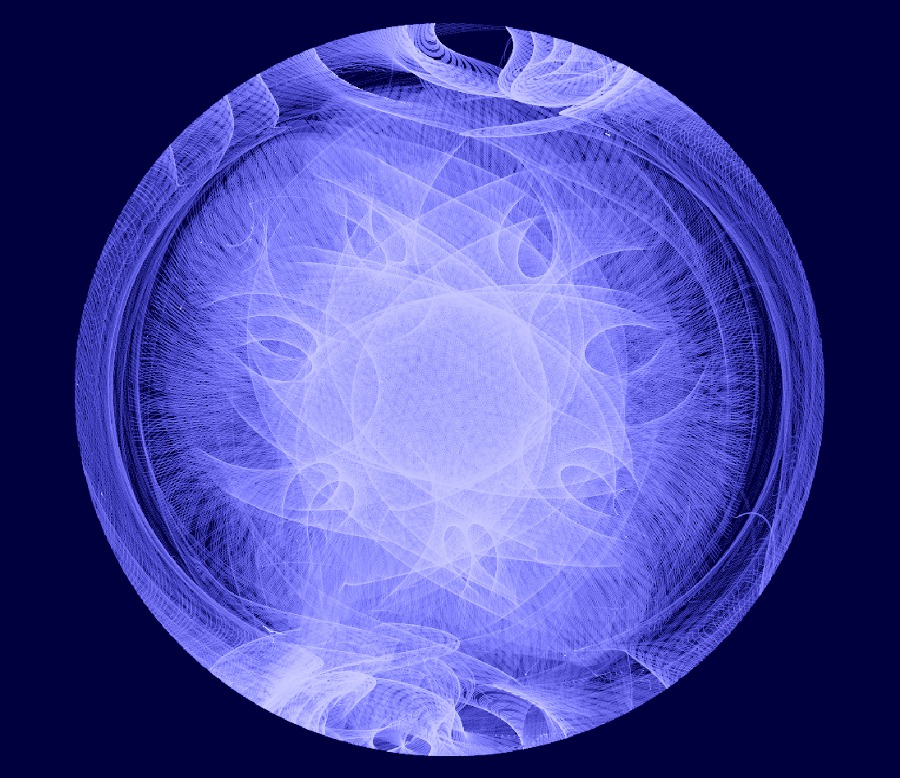 Source: http://apod.nasa.gov/apod/ap120504.html Exploring the cosmos at extreme energies, the Fermi Gamma-ray Space Telescope orbits planet Earth every 95 minutes. By design, it rocks to the north and then to the south on alternate orbits in order to survey the sky with its Large Area Telescope (LAT). The spacecraft also rolls so that solar panels are kept pointed at the Sun for power, and the axis of its orbit precesses like a top, making a complete rotation once every 54 days. As a result of these multiple cycles the paths of gamma-ray sources trace out complex patterns from the spacecraft's perspective, like this mesmerising plot of the path of the Vela Pulsar. Centered on the LAT instrument's field of view, the plot spans 180 degrees and follows Vela's position from August 2008 through August 2010. The concentration near the center shows that Vela was in the sensitive region of the LAT field during much of that period. Born in the death explosion of a massive star within our Milky Way galaxy, the Vela Pulsar is a neutron star spinning 11 times a second, seen as the brightest persistent source in the gamma-ray sky. Suspicious0bservers Daily Post Archive January 1, 2014 - May 31, 2014 May 31, 2014 May 30, 2014 May 29, 2014 May 28, 2014 May 27, 2014 May 26, 2014 May 25, 2014 May 24, 2014 May 23, 2014 May 22, 2014 May 21, 2014 May 20, 2014 May 19, 2014 May 18, 2014 May 17, 2014 May 16, 2014 May 15, 2014 May 14, 2014 May 13, 2014 May 12, 2014 May 11, 2014 May 10, 2014 May 9, 2014 May 8, 2014 May 7, 2014 May 6, 2014 May 5, 2014 May 4, 2014 May 3, 2014 May 2, 2014 May 1, 2014 April 30, 2014 April 29, 2014 April 28, 2014 April 27, 2014 April 26, 2014 April 25, 2014 April 24, 2014 April 23, 2014 April 22, 2014 April 21, 2014 April 20, 2014 April 19, 2014 April 18, 2014 April 17, 2014 April 16, 2014 April 15, 2014 April 14, 2014 April 13, 2014 April 12, 2014 April 11, 2014 April 10, 2014 April 9, 2014 April 8, 2014 April 7, 2014 April 6, 2014 April 5, 2014 April 4, 2014 April 3, 2014 April 2, 2014 April 1, 2014 March 31, 2014 March 30, 2014 March 29, 2014 March 28, 2014 March 27, 2014 March 26, 2014 March 25, 2014 March 24, 2014 March 23, 2014 March 22, 2014 March 21, 2014 March 20, 2014 March 19, 2014 March 18, 2014 March 17, 2014 March 16, 2014 March 15, 2014 March 14, 2014 March 13, 2014 March 12, 2014 March 11, 2014 March 10, 2014 March 9, 2014 March 8, 2014 March 7, 2014 March 6, 2014 March 5, 2014 March 4, 2014 March 3, 2014 March 2, 2014 March 1, 2014 February 28, 2014 February 27, 2014 February 26, 2014 February 25, 2014 February 24, 2014 February 23, 2014 February 22, 2014 February 21, 2014 February 20, 2014 February 19, 2014 February 18, 2014 February 17, 2014 February 16, 2014 February 15, 2014 February 14, 2014 February 13, 2014 February 12, 2014 February 11, 2014 February 10, 2014 February 9, 2014 February 8, 2014 February 7, 2014 February 6, 2014 February 5, 2014 February 4, 2014 February 3, 2014 February 2, 2014 February 1, 2014 January 31, 2014 January 30, 2014 January 29, 2014 January 28, 2014 January 27, 2014 January 26, 2014 January 25, 2014 January 24, 2014 January 23, 2014 January 22, 2014 January 21, 2014 January 20, 2014 January 19, 2014 January 18, 2014 January 17, 2014 January 16, 2014 January 15, 2014 January 14, 2014 January 13, 2014 January 12, 2014 January 11, 2014 January 10, 2014 January 9, 2014 January 8, 2014 January 7, 2014 January 6, 2014 January 5, 2014 January 4, 2014[/b] January 3, 2014 January 2, 2014 January 1, 2014 What's in the Sky Tonight Archive January 1, 2014 - May 31, 2014 May 31, 2014 -The Moon, Jupiter, and Pollux above them form a nearly straight line in twilight as seen from North America, as shown here. -The crescent Moon and Jupiter are converging for a sunset sky show. When the sun goes down tonight, step outside and look for them beaming through the western twilight. The two bright bodies are less than 10o apart--very pretty.  May 30, 2014 -When the sun goes down tonight, step outside and look west. A beautifully-slender crescent Moon is shining through the twilight not far below the planet Jupiter. It's a nice way to end the day. -For years, researchers have been studying red sprites and blue jets--strange forms of lightning that come out of the tops of clouds. On May 27th, a new form appeared. Pilot Cherdphong Visarathanonth was in the cockpit of an A320 at the airport in Bangkok, Thailand, when he saw a white tornado-like beam dancing atop this cumulonimbus cloud. "We could see the same phenomenon through both windshields even after the aircraft has pushing back in a different direction," says Visarathanonth. "I made a 4 minute video in which we can see the phenomenon quickly moving and disappearing from time to time." Brian Whittaker, another pilot with extensive sky watching experience, says, "I have seen Blue Jets and Sprites, but this is something totally different. Good luck figuring out what it is." The video is found below. One possible scenario could be found in this APOD link: http://apod.nasa.gov/apod/ap111108.html The description is as follows: What's happening above those clouds? In the past few years, videos have appeared on the web detailing an unusual but little known phenomenon: rapid light changes over clouds. Upon inspection and contemplation, a leading hypothesis for its cause has now emerged. In sum, this hypothesis holds that a lightning discharge in a thundercloud can temporarily change the electric field above the cloud where charged ice crystals were reflecting sunlight. The new electric field quickly re-orients the geometric crystals to a new orientation that reflects sunlight differently. In other words, a lightning discharge can cause a sundog to jump. Soon, the old electric field may be restored, causing the ice crystals to return to their original orientation. To help this curious phenomenon become better studied, sky enthusiasts with similar jumping or dancing sundog videos are encouraged to share them. 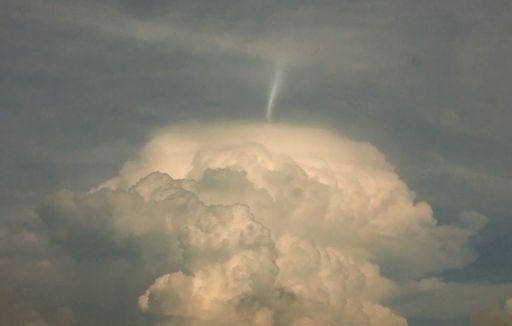 May 29, 2014 -As twilight turns to darkness, Mars shines brightly fire-colored in the south. Look below it for the four-star pattern of Corvus, the Crow. -Today, Comet 209P/LINEAR is passing remarkably close to Earth. At a distance of only 5 million miles (0.0554 AU), it is making the 9th closest comet flyby in recorded history. Such an encounter should be good news for sky watchers. Just one problem: the comet is not only remarkably close, but also remarkably dim. Observing from Australia, Nirmal Paul needed a half-meter telescope to take this picture of the comet approaching on May 28th. Despite its proximity to Earth, the comet is shining like a 10th or 11th magnitude star--that is, about 100 times too dim to see with the unaided eye. The comet is not very active and it currently produces very little dust. This will come as no surprise to anyone who watched the May Camelopardalid meteor shower on May 24th. Caused by dust from Comet 209P/LINEAR, the shower was a visual dud. 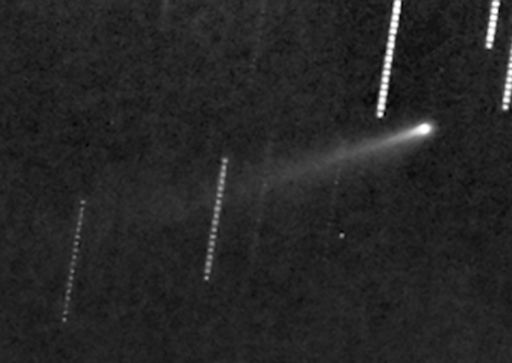 May 28, 2014 -On May 24th, many sky watchers were disappointed when the Camelopardalid meteor shower produced a measley 5 to 10 shooting stars per hour. At least 10 times that number had been expected. In fact, they were there, just invisible to the human eye. "The shower was quite strong as seen by radar, but almost exclusively in underdense echoes - that is, it was rich in faint meteors (i.e., 6th to 7th magnitude)," reports Peter Brown of the University of Western Ontario. This all-sky radar map obtained during the shower's peak by the Canadian Meteor Orbit Radar clearly shows a Camelopardalid 'hot spot' near the north celestial pole. "CMOR detected about one hundred orbits from the stream, making this comparable to the 2011 Draconids in terms of strength as seen by the radar," says Brown. "[Compared to other minor showers active on May 24th], the May Camelopardalids were at the top of the list -- relatively speaking a major outburst." Clearly, the debris stream of parent comet 209P/LINEAR did not contain as many large particles as forecasters anticipated. This gave the advantage to the radar. Even so, some beautiful Camelopardalids were seen by the naked eye. -New Moon today (exact at 2:40pm EDT). 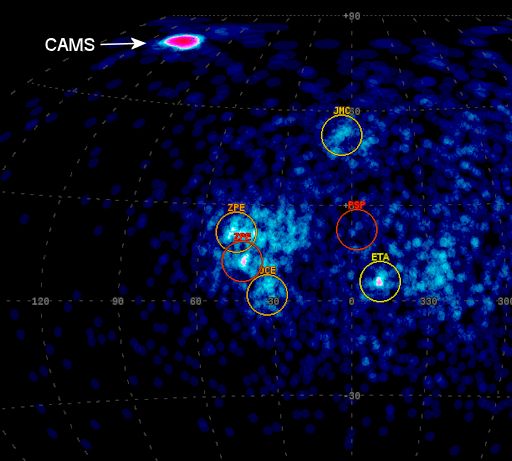 May 27, 2014 -Comet 209P/LINEAR, the source of last Saturday morning's meteors, is closest to Earth for the next five days. It was only 13th magnitude as of May 22nd, but if you want to try for it with a large telescope, finder charts can be found here: http://www.skyandtelescope.com/astro...buzzing-earth/ It's south of Leo, crossing Sextans and Crater. -Solar activity is low. However, departing sunspot AR2065 has a 'beta-gamma' magnetic field that harbors energy for M-class solar flares. If such an explosion does occur, it would be well-connected to Earth. The sun's spiralling magnetic field leads from the sun's western limb, where AR2065 is located, almost directly back to our planet. -Data from NASA's AIM spacecraft have shown that noctilucent clouds (NLCs) are like a great "geophysical light bulb." They turn on every year in late spring, reaching almost full intensity over a period of no more than 5 to 10 days. News flash: The switch has been flipped. "The first NLCs of the northern hemisphere season appeared on May 24th," reports Cora Randall, AIM science team member at the University of Colorado. Pale-blue and wispy, they are circled in this image of the Arctic Circle taken by AIM's CIPS instrument just three days ago. Last year, for reasons that are not fully understood, noctilucent clouds appeared earlier than usual. In 2014, however, "we are having a fairly normal start," says Randall. "Since AIM was launched in 2007, we have seen start dates typically ranging from May 15th to May 27th, with four seasons (like this one) getting underway between May 24th and May 27th." If this season follows the pattern of earlier seasons, the small wispy patches pictured above will grow into a magnificent ring of electric-blue clouds in 5 to 10 days--that is, by the first week of June. Then the geophysical light bulb will be fully aglow. Stay tuned for sightings. Observing tips: NLCs favor high latitudes, but they are not confined there. In recent years the clouds have been sighted as far south as Colorado and Virginia. Look west 30 to 60 minutes after sunset when the Sun has dipped 6o to 16o below the horizon. If you see luminous blue-white tendrils spreading across the sky, you may have spotted a noctilucent cloud. 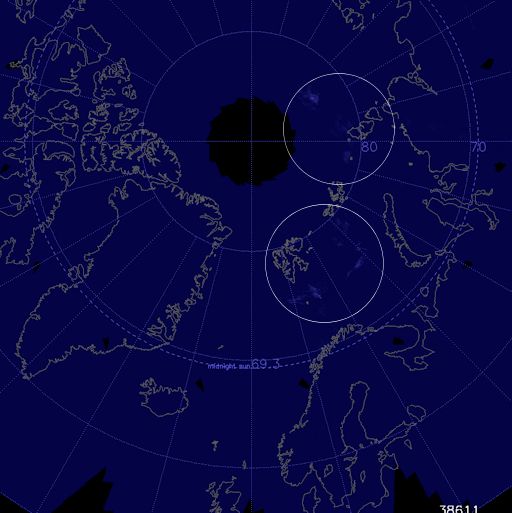 May 26, 2014 -Arcturus shines high in the southeast these nights. Vega shines much lower in the northeast. Look a third of the way from Arcturus to Vega for dim little Corona Borealis, the Northern Crown, with its one modestly bright star, Alphecca or Gemma. Two thirds of the way from Arcturus to Vega glimmers the dim Keystone of Hercules. Continue on down past Vega, and you hit Cygnus. May 25, 2014 -At dusk this evening, Mercury appears the same distance lower right of Jupiter and lower left of Capella. -Solar activity ticked upward on May 24th with the eruption of an M1-class solar flare from sunspot AR2065. Sunspot AR2073 also poses a threat for M-class flares, so the weekend might not be as quiet as previously supposed. -On May 24th, as predicted, Earth passed through a stream of debris from Comet 209P/LINEAR, and the encounter did produce a number of fine meteors. However, contrary to some forecasts, there was no intense outburst. Typical naked-eye meteor rates were no more than 5 or 10 per hour, a far cry from the "meteor storm" some headlines anticipated. "Even though the meteor shower was less than spectacular, it was still nice to spend the night camping out under dark skies," says Kevin Palmer of Illinois. " I captured this fireball over the Green River State Wildlife Area at 2:24 am." The modest display was hardly surprising. The parent comet, 209P/LINEAR, is faint and currently produces only a small amount of dust. Most forecasters acknowledged that there might be less debris in Earth's path than their models suggested. It is worth noting, and perhaps marveling, that forecasters correctly predicted the onset of a never-before-seen meteor shower. They got the timing almost perfectly correct; only the rates were off. Such a prediction would have beeen impossible only 20 years ago before the development of physics-based dust stream models. In this respect, the May Camelopardalids were a success if not a spectacle. 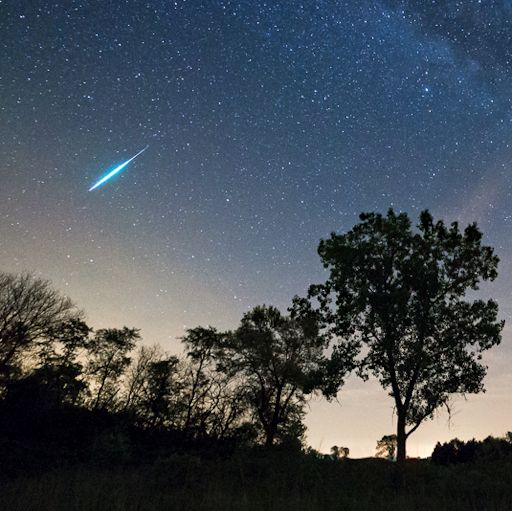 May 24, 2014 -Low in the dawn of Sunday the 25th for the Americas, Venus shines beautifully below the thin crescent Moon, as shown below. Look east. -Solar activity is low. Two sunspots (AR2071 and AR2073) have 'beta-gamma' magnetic fields that harbor energy for M-class solar flares, but both are stable. A quiet weekend seems likely. -As predicted, during the early hours of May 24th Earth passed through a cloud of debris from from Comet 209P/LINEAR. The encounter produced some fine meteors. However, contrary to some forecasts, there was no intense outburst. Meteor rates in many places were no more than 5 or 10 per hour. Photographing such a sparse shower can be tricky. Nevertheless, Glen Wurden of Los Alamos, New Mexico, managed to catch one. "I photographed this Camelopardalid through clouds using a 30 second exposure," says Wurden. "We saw about one meteor every 10 minutes." Although this is a far cry from predictions, it is hardly a surprise. The parent comet, 209P/LINEAR, is faint and currently produces only a small amount of dust. Most forecasters acknowldged that there might be less dust in Earth's path than the models suggested. Another possibility is that the shower is not a dud, just delayed. If models mis-located the debris zone, an outburst could still occur later on May 24th.  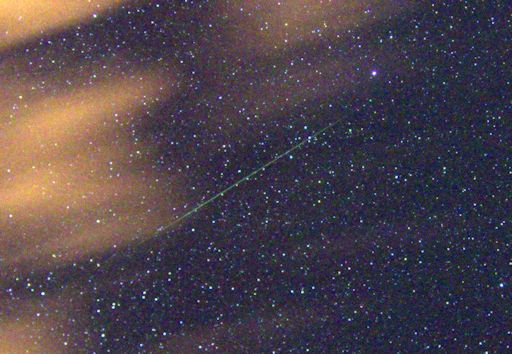 May 23, 2014 -A possible strong meteor shower may arrive in the early-morning hours of Saturday the 24th, timed for North America (perhaps peaking around 3 a.m. EDT, midnight PDT). For just a few hours we'll pass through the predicted debris trail of Comet 209P/LINEAR, which is making an unusually close flyby of Earth. There's even a (slim) possibility that the shower could approach "meteor storm" proportions. The comet itself is closest on May 29th, but it's very small and faint and may reach 11th magnitude at best. -As dawn brightens on Saturday morning the 24th, look for Venus well to the lower left of the waning crescent Moon, as shown above. -It is often said that this is a new shower, and no one has ever seen a Camelopardalid meteor before. Well...maybe just one. "We searched through our database of several thousand bright meteors and found a likely candidate," reports Bill Cooke of NASA's Meteoroid Environment Office. "Back on May 9th of 2012, one of our all-sky cameras caught it burning up at an altitude of 66 kilometers." "Peaking at a magnitude of -2 (Mars brightness), our now-extinct visitor was about 3.3 cm in diameter - a little smaller than a ping pong ball," continues Cooke. "We believe it was a May Camelopardalid because it had an orbit that greatly resembles that of parent Comet 209P/LINEAR." The diagram, below, shows the match. "So why is this good?" asks Cooke. "Looking back to 2012, our computer models show very little comet debris near Earth. We predicted nothing, yet got one meteor. Does this mean that a legion of his siblings will show up this year, when the models suggest the potential of a full-fledged meteor outburst? I'm getting excited about Friday night/Saturday morning." Earth won't be the only body passing through the debris zone. The Moon will be, too. Meteoroids hitting the lunar surface could produce explosions visible through backyard telescopes on Earth. The inset in this picture of an actual lunar meteor shows the region of the crescent Moon on May 24th that could be pelted by May Camelopardalids. According to NASA's Meteoroid Environment Office, the best time for amateur astronomers to scan the Moon for lunar meteors is after 0800 UT (4 a.m. EDT) on May 24th. There is much uncertainty about the strength of this shower, both on Earth and on the Moon. As far as we know, our planet has never passed directly through a debris stream from Comet 209P/LINEAR, so no one knows exactly how much comet dust lies ahead. A magnificent meteor shower could erupt, with streaks of light in terrestrial skies and sparkling explosions on the Moon--or it could be a complete dud.  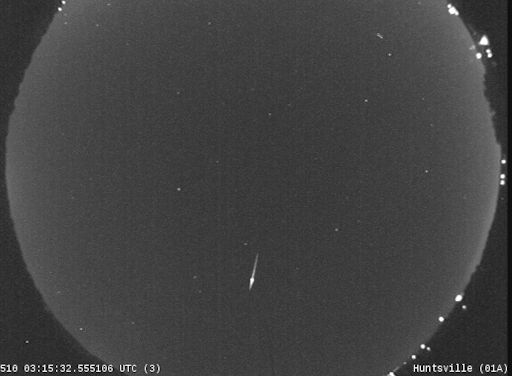   May 22, 2014 -As twilight fades, spot Mercury low in the west-northwest. It's about 2½ fists to the lower right of bright Jupiter. This evening Mercury is between the horn-tips of Taurus: Beta Tauri (El Nath) to its upper right, and Zeta Tauri to its lower left. Binoculars will help. -Solar activity is low. Although there are more than half-a-dozen sunspots on the solar disk today, not one has the type of complex magnetic field that harbors energy for strong eruptions. NOAA forecasters estimate a 10% chance of M-flares and a scant 1% chance of X-flares on May 22nd. May 21, 2014 -The western twilight Arch of Spring is sinking, but you can still catch this big landmark when the stars come out. Jupiter in the west lies within it. Pollux and Castor, above Jupiter, are lined up roughly horizontally; they're the Arch's top. Look far to their lower left for Procyon, and farther to their lower right for Menkalinen and then bright Capella. Jupiter is moving closer to the Arch's upper-left side. -Anticipation is building as Earth approaches a cloud of debris from Comet 209P/LINEAR. This weekend, meteoroids hitting Earth's atmosphere could produce a never-before-seen shower called the "May Camelopardalids" peaking with as many as 200 meteors per hour. The best time to look is on Saturday, May 24th, between 0600 UT and 0800 UT (2 a.m. and 4 a.m. EDT). Earth won't be the only body passing through the debris zone. The Moon will be, too. Meteoroids hitting the lunar surface could produce explosions visible through backyard telescopes on Earth. The inset in this picture of an actual lunar meteor shows the region of the crescent Moon on May 24th that could be pelted by May Camelopardalids. According to NASA's Meteoroid Environment Office, the best time for amateur astronomers to scan the Moon for lunar meteors is after 0800 UT (4 a.m. EDT) on May 24th. There is much uncertainty about the strength of this shower, both on Earth and on the Moon. In recent history, our planet has never passed directly through a debris stream from Comet 209P/LINEAR, so no one knows exactly how much comet dust lies ahead. A magnificent meteor shower could erupt, with streaks of light in terrestrial skies and sparkling explosions on the Moon--or it could be a complete dud.  May 20, 2014 -As the stars come out, Saturn in the southeast, Vega in the northeast, Capella in the northwest, and Procyon in the west-southwest are all at about the same altitude (as seen from about 40° north latitude). On May 24th, the heavens could put on a display of irony. Forecasters say Earth will cross a stream of debris from Comet 209P/LINEAR, and the encounter could trigger a bright new meteor shower. The ironic thing is, the comet is so faint. Aaron Kingery of NASA's Meteoroid Environment Office took the picture on May 18th using a 0.5 meter telescope at the Marshall Space Flight Center. "209P is not a very photogenic comet," says Kingery. "This is the best I could do with a 60-second exposure." How could such a dim comet produce a bright meteor shower? In 2014, 209P is producing very little dust. However, the debris Earth is about to encounter didn't come from 2014. It was shed by the comet mainly in the 19th and 20th centuries. In those days, forecasters hope, the comet was more active. We will find out this weekend. If a magnificent meteor shower erupts on Saturday morning, it will be safe to say that the comet wasn't always so underwhelming. 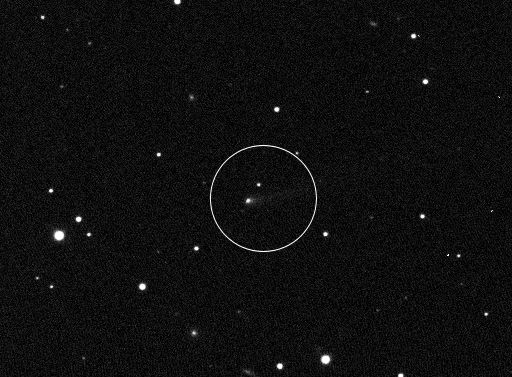 May 19, 2014 -Now that Vega is well up in the northeast in the evening, look to its lower left (by two or three fists) for Deneb. As Deneb rises higher through the night, a dark sky will reveal that it lies inside the Milky Way band looming up all across the eastern sky. -According to data from the NASA/French Space Agency Jason-2 satellite, something is brewing in the Pacific. Researchers say it could be a significant El Niño with implications for global weather and climate. -Last month at the Space Weather Workshop in Boulder, Colorado, solar cycle expert Doug Biesecker of NOAA announced that "Solar Maximum is here, finally." According to his analysis, the sunspot number for Solar Cycle 24 is near its peak right now. Spoiler: It's not very impressive. "This solar cycle continues to rank among the weakest on record," says Workshop attendee Ron Turner of Analytic Services, Inc. To illustrate the point, he plotted the smoothed sunspot number of Cycle 24 vs. the previous 23 cycles since 1755. In the composite plot, Cycle 24 is traced in red. Only a few cycles since the 18th century have have had lower sunspot counts. For this reason, many researchers have started calling the ongoing peak a "Mini-Max." "By all Earth-based measures of geomagnetic and geoeffective solar activity, this cycle has been extremely quiet," notes Turner. "However, Doug Biesecker has presented several charts showing that most large events such as strong flares and significant geomagnetic storms occur in the declining phase of the solar cycle." In other words, there is still a chance for significant solar activity in the months and years ahead. 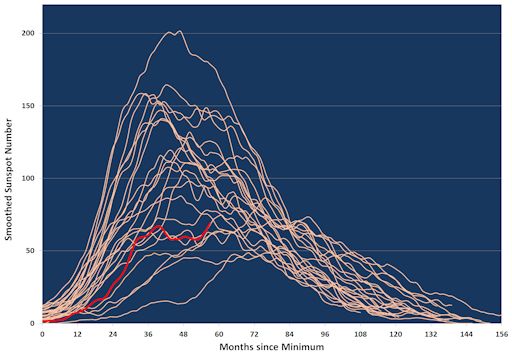 May 18, 2014 -Look south after dark for Mars at its highest. Straight below Mars, by more than a fist at arm's length, is the distinctive springtime constellation Corvus the Crow. Its four brightest stars form a distorted rectangle less than a fist in size. -Mercury and Saturn are in conjunction in the night sky. Just one problem: You have to be on the far side of the sun to see it. NASA's STEREO-B probe is perfectly positioned to observe the convergence. On Saturday, May 17th, the distance between the two planets was so narrow that they became nearly indistinguishable. If this event were visible from our side of the sun, it would surely be headline news. NASA's STEREO probes see many things that we cannot. From their orbits high above the farside of the sun, they track hidden sunspots, anti-Earth-directed solar flares, and interplanetary CMEs. STEREO's wide-field Heliospheric Imagers also have a unique view of the planets. See above. This weekend's conjunction of Mercury and Saturn is bracketed by Mars and Earth itself, an arrangement impossible to observe from terra firma. 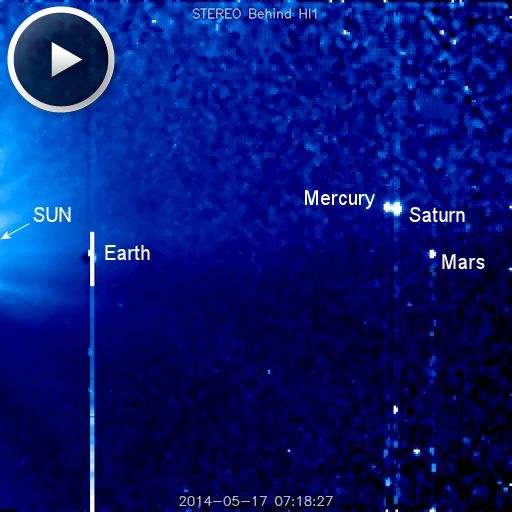 May 17, 2014 -Arcturus shines high in the southeast these nights. Vega shines much lower in the northeast. Look a third of the way from Arcturus to Vega for dim little Corona Borealis, the Northern Crown, with its one modestly bright star, Alphecca or Gemma. Two thirds of the way from Arcturus to Vega glimmers the dim Keystone of Hercules. Continue on down past Vega, and you hit Cygnus. May 16, 2014-A new study published in the May 15th edition of Environmental Research Letters finds that lightning rates over Europe are modulated by the solar wind. The results contradict some previous studies, and the physical mechanism linking lightning and solar wind is uncertain. Nevertheless, the research appears credible and worthy of follow-up with global studies beyond Europe. Report: http://iopscience.iop.org/1748-9326/9/5/055004/article -Look for Mercury as twilight darkens. It's low in the west-northwest, far to the lower right of Jupiter and lower left of Capella. Mercury is having its highest showing of 2014 (for skywatchers at mid-northern latitudes). May 15, 2014 -Jupiter's moon Io crosses the face of the planet from 9:41 to 11:57 p.m. Eastern Daylight Time. Io's tiny but more visible shadow follows it across from 10:42 p.m. to 12:59 a.m. EDT. -Last night, May 14th, a Japanese spy satellite passed over Brazil. Leonardo Caldas of Brasilia saw it backlit by the full Moon. Click to view the split-second transit: "Looking at Calsky, I noticed a possible transit of a satellite called IGS 7A," says Caldas. "I set my Canon SX50 HS digital camera to film at the predicted time--and there it was!" The dark silhouette of the satellite zipped across the Moon in only 0.48 seconds. "IGS 7A is a Japanese reconnaissance satellite, launched from Tanegashima on Dec. 12, 2011," explains Caldas. "It is a member of Japan's Information Gathering Satellite (IGS) system whose primary mission is to provide early warning of impending hostile launches." According to folklore, this month's full Moon is the "Flower Moon," named after the abundant flowers of northern spring.  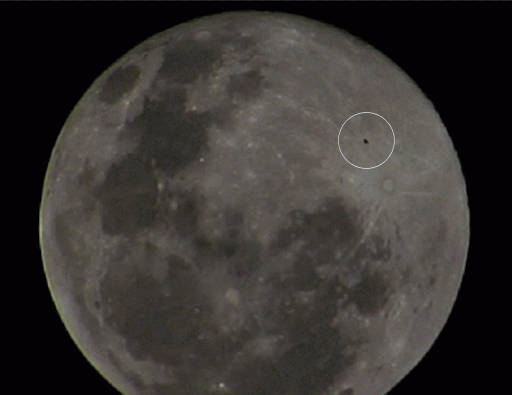 May 14, 2014 -Full Moon (exact at 3:16 p.m. Eastern Daylight Time.) Look for Saturn to its upper right. Once the Moon is well up after dark, look for Antares and the other stars of upper Scorpius below it. By dawn they're lying down in the southwest. -NOAA forecasters estimate a 30% chance of polar geomagnetic storms on May 14th when a co-rotating interaction region (CIR) is expected to hit Earth's magnetic field. CIRs are transition zones between fast and slow solar wind streams. Solar wind plasma piles up in these regions, producing density gradients and shock waves that do a good job of sparking auroras. -Today, the sun's atmosphere is split down the middle by a canyon-shaped coronal hole. NASA's Solar Dynamics Observatory photographed the chasm, which is almost directly facing Earth. Coronal holes are places where the sun's magnetic field opens up and allows solar wind to escape. This hole is straddling the sun's equator so the solar wind stream emerging from it will intersect Earth's orbit. ETA: May 16-17. High-latitude sky watchers should be alert for auroras on those dates.  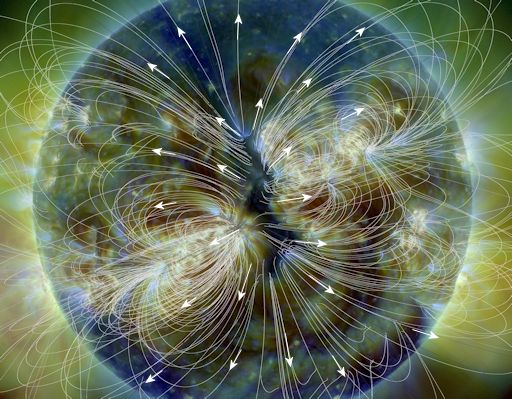 May 13, 2014 -The bright Moon, practically full, shines near Saturn. The Moon creeps to within 1° to 3° of Saturn before dawn Wednesday morning for the Americas. For New Zealand and most of Australia, the Moon occults (covers and uncovers) Saturn during nighttime; map and timetables. http://www.lunar-occultations.com/io...0514saturn.htm   May 12, 2014 -Three zero-magnitude stars shine after dusk in May: Arcturus high in the southeast, Vega much lower in the northeast, and Capella in the northwest. They appear so bright because each is at least 60 times as luminous as the Sun, and they're all relatively nearby: 37, 25, and 42 light-years from us, respectively. -NOAA forecasters have boosted the odds of an M-class solar flare today to 50% mainly in response to the rapid growth of a new sunspot in the sun's southern hemisphere. The sunspot, designated AR2060, has a 'beta-gamma' magnetic field that harbors energy for strong eruptions  May 11, 2014 -Now the Moon is positioned between Mars and Spica (for the Americas in the evening). -Jupiter shines within the western Arch of Spring as twilight fades. The top of the Arch is formed by Pollux and Castor, roughly horizontal. To their lower left is Procyon, the left end of the Arch. The right end is formed by Menkalinen and then Capella. Jupiter is gradually moving toward the Arch's upper left side.  May 10, 2014 -Bright Mars shines left of the Moon. Although they look rather close together, Mars is 260 times farther away — and twice as big in diameter. -Imagine what it would be like if, from time to time, a hole opened up in Earth's atmosphere and air went blowing out into space. On the sun, this happens all the time. The openings are called "coronal holes." NASA's Solar Dynamics Obervatory is monitoring one right now; it is the dark wedge-shaped region in this extreme ultraviolet image of the sun's southern hemisphere. Coronal holes are places in the sun's atmosphere where the magnetic field bends back and allows gas to escape. From such openings, solar wind blows out into space. A stream of solar wind flowing from this particular coronal hole could reach Earth on May 11-12, sparking auroras when it arrives. On the other hand, the stream might sail south of our planet, delivering only a glancing blow. Stay tuned for updates.  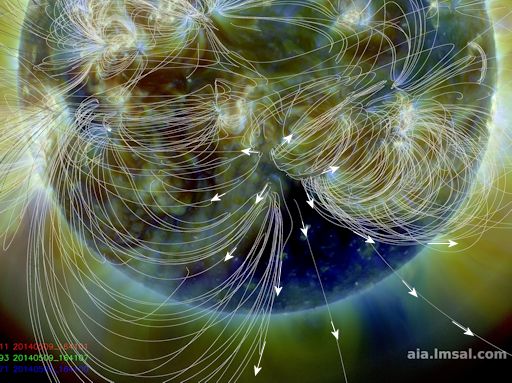 May 9, 2014 -The waxing gibbous Moon forms a curving line tonight with Mars to its left and Spica to Mars's lower left. -An interplanetary shock wave, origin unknown, hit Earth's magnetic field during the late hours of May 7th. Although the weak impact did not spark a geomagnetic storm, solar wind conditions in the wake of the shock have been favorable for auroras. Nancy Dean took this picture last night on Mount Spur, Alaska. "The sunset was still showing strong on May 8th when the Northern Lights came out to dance across the Alaskan sky," says Dean. As northern spring unfolds, persistent twilight is spreading into the night skies of Alaska. It takes a bright display of auroras to be seen against such a backdrop. Dean's photo is evidence that a weak shock does not necessarily produce weak auroras. More lights are possible tonight. NOAA forecasters estimate a 30% chance of polar geomagnetic storms as Earth exits the wake of the shock. 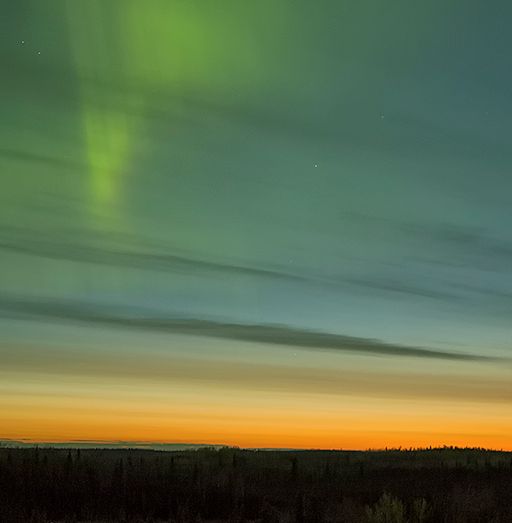 May 8, 2014 -Sometime late this evening (roughly 10 p.m. depending on where you live), bright Capella declining in the northwest will be exactly as high as bright Vega climbing in the northeast. How accurately can you time their altitude balance? Each day it will come four minutes earlier. -The sunspot number is increasing this week as a crowd of dark cores emerges over the sun's eastern limb. One of the spots in the crowd, AR2056, has a 'beta-gamma' magnetic field that harbors energy for M-class solar flares. The odds of a geoeffective eruption will increase in the days ahead as AR2056 turns toward Earth. NOAA forecasters estimate a 25% chance of M-flares on May 8th. -On May. 7, 2014, the network reported 20 fireballs.(12 sporadics, 8 eta Aquariids) 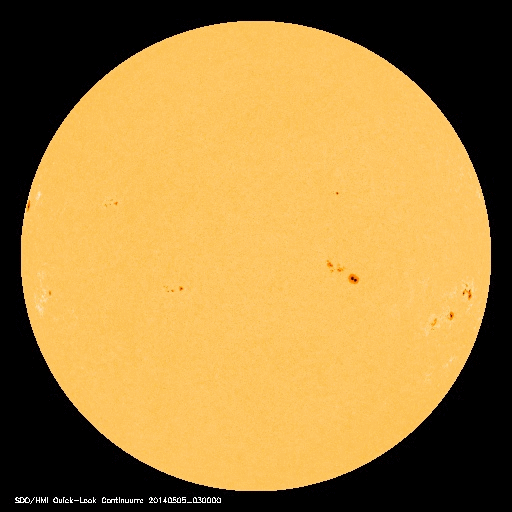  May 7, 2014 -Just above the Moon at nightfall are Regulus and the Sickle of Leo. -The eta Aquarid meteor shower, caused by debris from Halley's Comet, is still active on May 7th. Incoming data from the Canadian Meteor Orbit Radar show a hot spot of meteor activity near the head of Aquarius. These meteors are best seen during the dark hours before sunrise. Set your alarm for dawn and take a look! -The odds of a geoeffective solar flare are dropping as sunspot AR2051 rotates off the visible solar disk. NASA's Solar Dynamics Observatory recorded this parting shot during the late hours of May 6th. This plume of plasma, propelled away from the sun's surface by an M-class explosion in the sunspot's magnetic canopy, is as tall as a dozen planet Earths. Much of the material escaped the sun in the form of a coronal mass ejection (CME), not Earth-directed: movie. Stronger blasts are possible on May 7th. The sunspot has a 'delta-class' magnetic field that harbors energy for powerful X-flares. Any such eruptions, however, will almost surely miss our planet as AR2051 heads for the farside of the sun. On May. 6, 2014, the network reported 28 fireballs. (21 sporadics, 7 eta Aquariids) 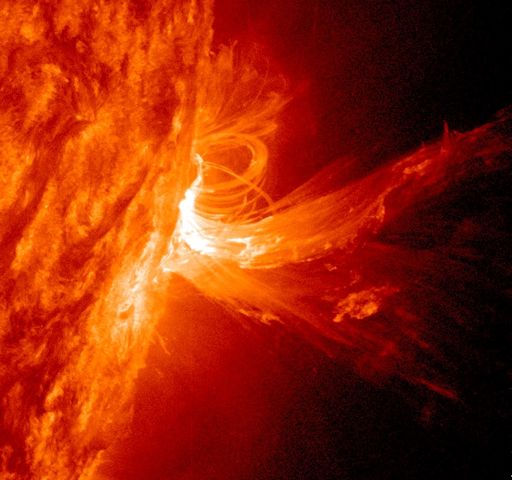  May 6, 2014 -First-quarter Moon (exactly so at 11:15 p.m. Eastern Daylight Time). The Moon shines in Cancer above the dim head of Hydra. Well to the Moon's upper left is Regulus, forming the bottom of the Sickle of Leo. -Earth is passing through a stream of debris from Halley's Comet, source of the annual eta Aquarid meteor shower. Forecasters expect the shower to peak on the night of May 5-6 with as many as 60 meteors per hour in the southern hemisphere and half that number in the north. No matter where you live, the best time to look is during the dark hours before local sunrise on May 6th. [photo gallery] [meteor radar] Alan Dyer caught this speck of "Halley dust" disintegrating over Portal, Arizona, on May 5th. "Portal, Arizona, has some of the finest skies on the continent," says Dyer. "Last night I saw several Eta Aquarids in just casual glances skyward as I was busy shooting images of the Milky Way in the pre-dawn hours. This frame nicely caught the entire meteor showing a change of colour in the ionization trail as it descended deeper into our atmosphere, typical of bright meteors." 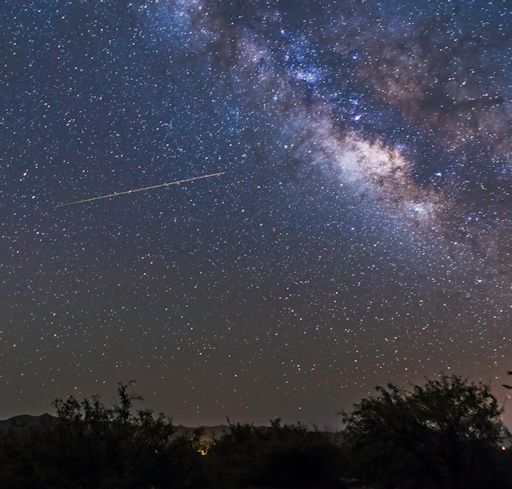 May 5, 2014 -Saturn (magnitude +0.1, in Libra) reaches opposition this week. It now rises in twilight and stands highest in the south around 1 or 2 a.m. By then it's far left of Mars, and half as far to the upper right of Antares. -Venus (magnitude –4.2) is the bright "Morning Star" low in the east during dawn. How late into the growing daylight can you follow it? May 4, 2014 -Earth is entering a stream of debris from Halley's Comet, source of the annual eta Aquarid meteor shower. Forecasters expect the shower to peak on the night of May 5-6 with as many as 60 meteors per hour in the southern hemisphere and half that number in the north. No matter where you live, the best time to look is during the dark hours before local sunrise on May 6th. -On May. 3, 2014, the network reported 6 fireballs. (5 sporadics, 1 eta Aquariid)  May 3, 2014 -The waxing crescent Moon shines below Jupiter in the west at dusk. Above Jupiter are Pollux and Castor. -New sunspot AR2051 is growing rapidly and has developed a 'delta-class' magnetic field that harbors energy for X-class solar flares. Any explosions this weekend would likely be geoeffective as the sunspot is approximately facing Earth. -On May 24th, Earth will pass through a cloud of debris from periodic comet 209P/LINEAR. The result could be a new meteor shower. Forecasters expect meteor rates as high as 200 per hour when Earth crosses the debris zone. There has even been talk of a possible meteor storm. These are lofty predictions for a comet that looks so puny. "This image was taken on April 30th (4:35 UTC) using our 20-inch telescope located in New Mexico," says Bill Cooke of NASA's Meteoroid Environment Office. "A 3 minute exposure, it shows 14th magnitude Comet 209P/LINEAR shining faintly among the stars of Ursa Major. At the time of this image, 209P was just over 40 million km from Earth, heading for a relatively close approach (8.3 million km) with us on May 29th." The comet is faint because it is a poor producer of dust. How, then, could it create a debris cloud capable of triggering a fine meteor shower? The answer is in the timing. The debris we are about to hit was shed by the comet not in 2014 but rather in the 1800s, when forecasters think the comet was probably more active. The best place to see the display is North America where it will be nighttime during the shower's peak. Meteors will emerge from a radiant point high in the sky, in the constellation Camelopardalis not far from the North Star. Peak rates are expected between 6:00 and 08:00 UT or 2 and 4 o'clock in the morning EDT on May 24th. No one can say for sure how strong this new shower will be; possibilities range from "storm" to "dud." Stay tuned for updates as the debris zone approaches.  May 2, 2014 -How soon after sunset can you see the first stars and planets coming out? The brightest is Jupiter. Look for it high in the west, almost two fist-widths at arm's length above or upper left of the Moon. The second brightest is Sirius, sinking in the southwest. -NOAA forecasters have boosted the odds of an M-class flare today to 35%. There are two possible blast sites: Earth-facing sunspots AR2047 and AR2049 both have 'beta-gamma' magnetic fields that harbor energy for strong eruptions. -Researchers pondering the possibilities of life on Mars have long focused their attention on halobacteria--a type of terrestrial extremophile that uses salt to shield itself from harsh radiation. On April 20th, the students of Earth to Sky Calculus flew a colony of halobacteria onboard a suborbital helium balloon to the Edge of Space. The microbes didn't merely survive, they are now thriving in the students' biology classroom back on Earth. During the ascent to 102,400 feet, these bacteria experienced temperatures as low as -60 C, air pressures only 1% that at sea-level, and radiation levels more than 25-times Earth-normal. All of these conditions are akin to those on Mars. ( See a 74 MB movie of the bacteria floating in the stratosphere.) Instead of chlorophyll, halobacteria use the photosynthetic molecule bacteriorhodopsin, which produces chemical energy from sunlight without producing oxygen. This photosynthetic pigment colors the halobacteria colony pinkish-red--the same hue visible in the incubated petri dish. The students are planning to repeat the experiment with another flight possibly as early as this weekend.  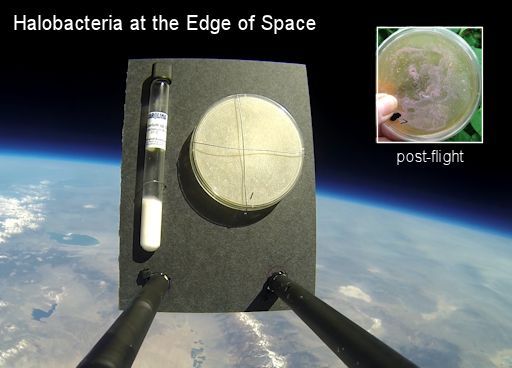 May 1, 2014 -Brilliant Mars, shining in the southeast after dusk, has been drawing closer to Gamma Virginis (Porrima), magnitude 2.7. Look for the little star about 2° to Mars's upper right. They'll appear closest (1.4° apart) on May 4th and 5th. Gamma Vir is a fine, tight telescopic double with a current separation of 2.1 arcseconds. Take a look at it with your scope at high power after you're done with Mars! -Last night, April 30th, the interplanetary magnetic field (IMF) near Earth tipped south, opening a crack in our planet's magnetosphere. Solar wind poured in and ignited a display of auroras bright enough to pierce the Spring twilight around the Arctic Circle. Nancy Dean sends this picture from Sterling, Alaska. "Bright and beautiful auroras danced all night across our Alaskan sky," says Dean. "The colors of sunset made the display even better." Meanwhile in the southern hemisphere, autumn is unfolding, and the night sky is growing darker. The display was even more dramatic there. Photographer Brendan Davey says "the glow from Tasmania was very bright." The crack in Earth's magnetosphere has mostly closed, but the IMF could open it again. NOAA forecasters estimate a 50% chance of polar geomagnetic storms on May 1st. 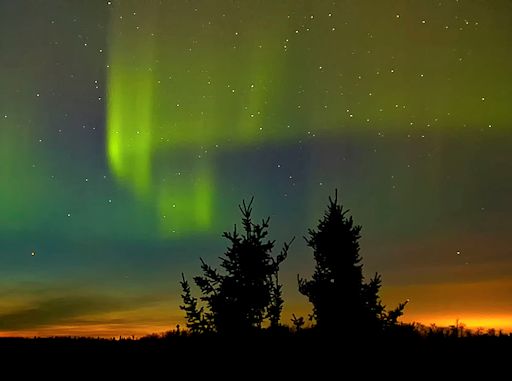 April 30, 2014 -Can you see the hairline Moon yet in the west in twilight? It's about a fist-width to the lower right of Aldebaran for North American skywatchers. Binoculars will help. How about the departing Pleiades? -When the sun set over Australia on April 29th, sky watchers noticed something odd. A piece of the sun was missing. The new Moon passed in front of the sun producing a partial eclipse as deep as 70%. This was the view from Adelaide, South Australia. "Here the eclipse peaked at 51% and was still in progress as the sun was setting," says photographer Martin Lewicki. "We could see it clearly through the clouds." Visibility of this eclipse was restricted to Australia and the coast of Antarctica. While Australians witnessed a partial eclipse, in Antarctica the Moon passed directly in front of the sun, producing a "ring of fire" annular eclipse. Photographs of that phase, however, might not be forthcoming because of the remote location.  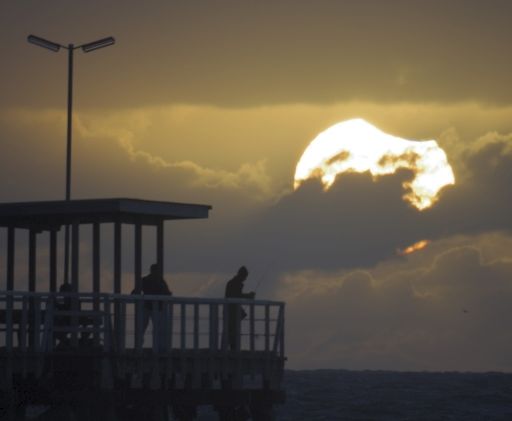 April 29, 2014 -New Moon (exact at 2:14 a.m. on this date EDT). A partial eclipse of the Sun occurs for Australia, and the eclipse is annular on the horizon for a bit of Antarctica. - http://eclipse.gsfc.nasa.gov/OH/OH20...l#SE2014Apr29A -Sky watchers around the Arctic Circle have a problem: too much daylight. As spring unfolds, twilight is spreading into the night, washing out all but the brightest auroras. Thomas Kast of Haukipudas, Finland, photographed the competition on April 25th. "We aurora chasers, hunters and worshippers fight a battle against the magic midnight sun which cannot be won," says Kast. "Every night it gets brighter and the chances for auroras fade. As you can see from this photo - taken at 1.30am - the aurora is barely visible against the twilight. There are still a few nights with the sun more than 10 degrees below the horizon, but we will need a strong impact to see some nice auroras overhead." The next impact might not be strong enough. NOAA forecasters expect a relatively weak stream of solar wind to brush past Earth's magnetic field on April 29th and 30th, sparking minor geomagnetic activity. Arctic sky watchers should be alert for auroras, but don't be surprised if all you see is twilight. 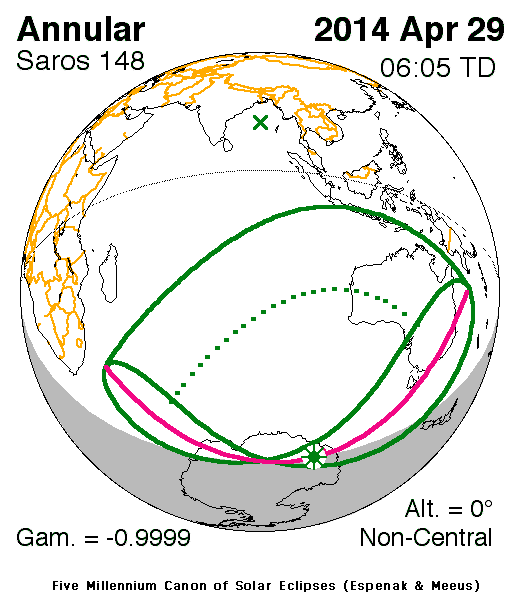 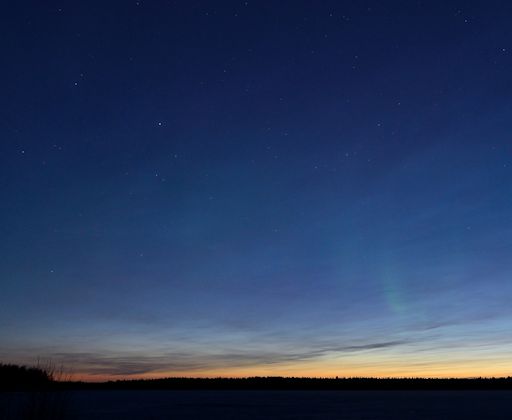 April 28, 2014 -Solar activity remains low. Only a few sunspots are facing Earth, and none has the kind of complex magnetic field that harbors energy for strong explosions. NOAA forecasters estimate a 10% chance of M-class flares and only a 1% chance of X-flares on April 28th. -Many of us have witnessed sun pillars--columns of light that lance upwards from the horizon just as the sun is rising or setting. They are caused by plate-shaped ice crystals in clouds that bend the rays of the low-hanging sun. While sun pillars are frequently seen, in all seasons and at all latitudes, elusive companions of sun pillars may have been frequently overlooked. They are called sun pillar "echos". Atmospheric optics expert Les Cowley explains: "13 years ago in Finland, three halo experts saw peculiar 'echoes' straddling an otherwise ordinary sun pillar. They could not be explained and there the matter rested for want of confirmation by another observation. Then, last week, Jon Inghram sent me several sun pillar images. He too had noticed faint 'echoes' on each side of his pillar – the mysterious ice halo was at last confirmed!" "More details and pictures may be found in an article here: http://www.atoptics.co.uk/fz1004.htm But we still cannot explain them. The Finland observers, Jon and I have each tried simulations using the flattened pyramid crystals invoked to account for elliptical halos. They do not work at all well. We need many more observations! Take plenty of pictures of each pillar. The echoes are easily overlooked or mistaken for cloud patches and have probably been seen many times. Observations under different conditions could help unravel their mystery." Image credit: Jon Inghram.  April 27, 2014 -To the left of Mars after dusk, by about three fists at arm's length, shines Arcturus in the east. High to Arcturus's upper left, you'll encounter the handle of the Big Dipper. -Solar activity is low. Only a few sunspots are facing Earth, and none has the kind of complex magnetic field that harbors energy for strong explosions. NOAA forecasters estimate a waning 10% chance of M-class flares and only a 1% chance of X-flares on April 27th. -Mars has two small moons: Phobos and Deimos. One of them is doomed. Phobos orbits so close to Mars - about 5,800 kilometers above the surface compared to 400,000 kilometers for our own Moon - that gravitational tidal forces are dragging it down. In 100 million years or so Phobos will likely be shattered by tidal shear, the debris forming a decaying ring around Mars. With the countdown clock clicking, astrophotographer Peter Rosén was determined to photograph the diminutive moon, and on April 24th he succeeded. "My previous attempt at photographing Phobos and Deimos resulted in Deimos alone, so I tried again last night, slightly changing my setup," says Rosén. "This time I managed to get the even more elusive Phobos at mag. 11.8 , separated only by 11 arcseconds from the blindingly bright Mars at mag. -1.28." "I inserted the orbital path of both moons to show how much closer Phobos is to the planet compared to Deimos and also that Phobos is on track." April 26, 2014 -An X-class solar flare on April 25th irradiated Earth's upper atmosphere with extreme ultraviolet radiation. Waves of ionization rippled around the dayside of the planet, causing a widespread blackout of shortwave radio transmissions. Radio astronomer Dick Flagg recorded the event at his observatory at the Windward Community College on Oahu. "This is a dynamic spectrum," explains Flagg. "The vertical axis is frequency (MHz) and the horizontal axis is time (UTC)." All of the horizontal lines corresponding to terrestrial radio stations vanished in the aftermath of the flare. The active region responsible for the flare rotated off the solar disk yesterday, so even if it flares again, another radio blackout is unlikely this weekend. NOAA forecasters estimate the odds of an X-flare on April 26th to be a scant 1%. -Brilliant Mars, shining in the southeast after dusk, has been drawing closer to Gamma Virginis (Porrima), magnitude 2.7. Look for the little star about 2° to Mars's upper right. They'll appear closest (1.4° apart) on May 4th and 5th. Gamma Vir is a fine, tight telescopic double with a current separation of 2.1 arcseconds. Take a look at it with your scope at high power after you're done with Mars! 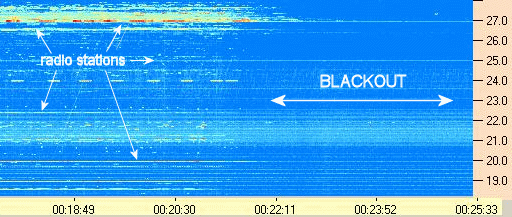  April 25, 2014 -Up before sunrise? Step outside and look east. The crescent Moon is passing close to Venus in the pre-dawn sky on April 25th and 26th. It's a beautiful way to start the day. -Departing sunspot complex AR2035-AR2046 erupted on April 25th at 0032 UT, producing a strong X1.3-class solar flare and an HF communications blackout on the dayside of Earth. NASA's Solar Dynamics Observatory recorded a flash of extreme ultraviolet radiation from the explosion. The explosion also produced a CME, but because the blast site was so close to the sun's western limb, the cloud is not heading toward our planet. The chance of a geomagnetic storm remains low.  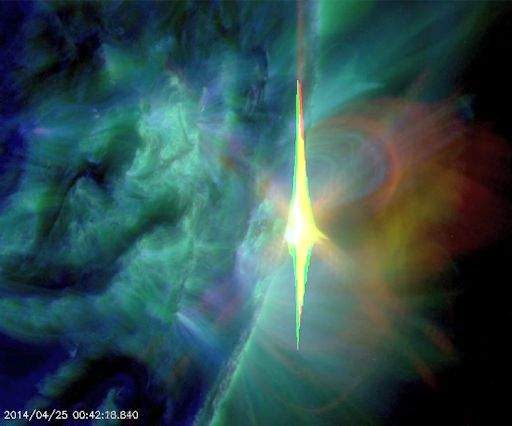 April 24, 2014 -During dawn tomorrow morning (the 25th), look below the waning crescent Moon for Venus, as shown at right. Think photo opportunity! -Solar activity is low. There are only a few sunspots facing Earth, and none of them is strongly flaring. NOAA forecasters put the odds of an X-flare today at no more than 1%.  April 23, 2014 -As soon as twilight fades out, look moderately low in the west-northwest (far below Capella) for the little Pleiades star cluster, the size of your fingertip at arm's length. How much later through the spring can you follow the Pleiades before they're lost in the sunset? -The annual Lyrid meteor shower, caused by debris from ancient Comet Thatcher, is subsiding. During the shower's peak on April 22nd, dark-sky observers saw as many as 15 meteors per hour. On Apr. 22, 2014, the NASA All-sky network reported 25 fireballs. -NOAA forecasters estimate a 30% chance of polar geomagnetic storms on April 23-24 when the interplanetary magnetic field (IMF) is expected tip south, opening a crack in Earth's magnetosphere. Solar wind pouring in could ignite auroras. Ronan McLaughlin of Malin head, Ireland, took this picture on April 20th during the Easter Sunday geomagnetic storm. "My son Oisín and I were admiring the Milky Way when, suddenly, the auroras made an appearance." The Easter storm was sparked by a CME strike. The storms of April 23-24, if any, will be less potent because no CME is involved. The best time to look for faint auroras is during the hours around local midnight.  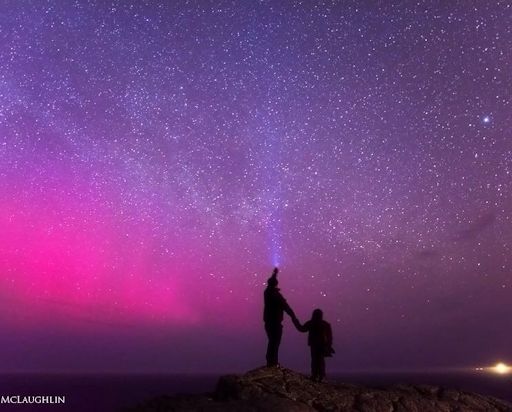 April 22, 2014 -Bright Jupiter, high in the west at dusk, forms the top of a huge, sideways-compressed pentagon with other bright celestial landmarks. Look left of Jupiter for Procyon, far below Procyon for bright Sirius, to the right of Sirius and somewhat lower for Rigel in Orion's foot, then above Rigel for Betelgeuse, and back to Jupiter. -NOAA forecasters have downgraded the chance of geomagnetic storms today to 35% as Earth exits a stream of high-speed solar wind. High-latitude sky watchers should be alert for fading auroras. -Earth is passing through a stream of debris from ancient Comet Thatcher, source of the annual Lyrid meteor shower. Last night, NASA's All-Sky Fireball Network detected this bright Lyrid flying over Allegheny, Pennsylvania. Usually the Lyrid meteor shower is mild (10-20 meteors per hour), but unmapped filaments of dust in the comet's tail sometimes trigger outbursts ten times stronger. So far this year's shower is trending toward the usual--that is, mild--but surprises are possible. Forecasters espect the shower to peak on April 22nd between the hours of 10:00 UT and 21:00 UT. Got clouds? Listen for Lyrid radar echoes on Space Weather Radio. http://spaceweatherradio.com/ 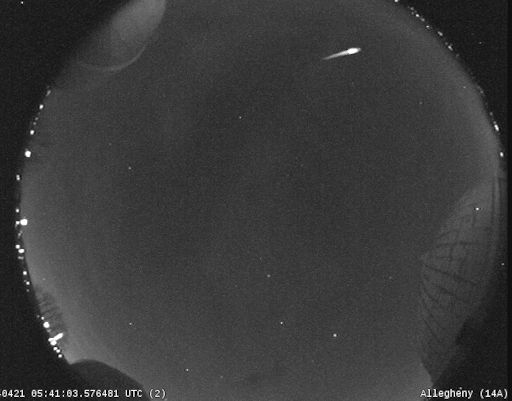 April 21, 2014 -Last-quarter Moon (exact at 3:52 a.m. Tuesday morning Eastern Daylight Time). The Moon rises around 2 a.m. local time Tuesday morning, far below Altair near the wide double stars Alpha and Beta Capricorni. The weak Lyrid meteor shower should be active in the moonlight before dawn. Even in years with no moonlight, meteor watchers usually report fewer than 20 Lyrids visible per hour. -A minor geomagnetic storm that lit up the Arctic Circle on Easter Sunday is subsiding. At its peak, just after an instigating CME strike around 1057 UT, the disturbance registered G1 on NOAA storm scales. Arctic auroras were briefly visible despite the brightening spring twilight: "Here in Kuusamo, Finland, near the Polar circle, spring nights are becoming lighter and lighter, but still the auroras can be seen," says photographer Asko Aikkila. NOAA forecasters estimate a 60% chance of renewed geomagnetic storms on April 21st as Earth passes through the windy wake of the CME. High-latitude sky watchers should remain alert for auroras. 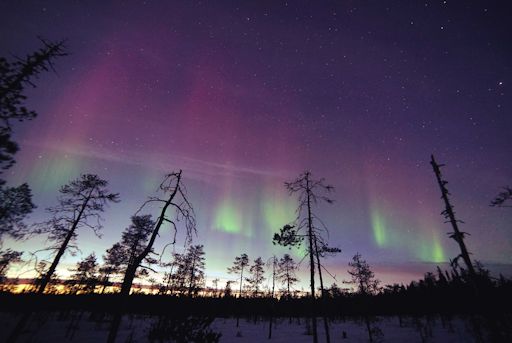 April 20, 2014 -The Big Dipper floats upside down near the top of the sky these evenings (for skywatchers at mid-northern latitudes), as though pouring out April showers to bring May flowers. Vesta, the brightest asteroid, and Ceres, the biggest one, are both barely past opposition. They're just 2½° apart in eastern Virgo, easy targets in binoculars at magnitudes 5.9 and 7.0. -Earth is approaching a stream of debris from ancient Comet Thatcher, source of the annual Lyrid Meteor Shower. Usually the shower is mild (10-20 meteors per hour) but unmapped filaments of dust in the comet's tail sometimes trigger outbursts ten times stronger. Forecasters expect this year's peak, however strong it may be, to occur on April 22nd. April 19, 2014 -Have you said hello to Vega yet this year? The "Summer Star" is now sparkling low in the northeast at nightfall. By dawn it's high overhead. -There's a new crater on the Moon. NASA's LADEE spacecraft, on a mission since Sept. 2013 to study the lunar atmosphere, has crashed. The impact was deliberate. LADEE was near the end of its planned mission and the grazing impact gave researchers a chance to study "lunar air" very close to the Moon's surface. The full story can be found here: http://www.nasa.gov/press/2014/april...l#.U1FveVdnCWc -Sunspot AR2036 erupted on April 18th at 1307 UT, producing a strong M7-class solar flare. NASA's Solar Dynamics Observatory recorded the extreme ultraviolet flash. A CME emerged from the blast site. The Solar and Heliospheric Observatory recorded the storm cloud racing away from the sun at aproximately 800 km/s. This CME could deliver a glancing blow to Earth's magnetic field on April 20-21. Two or three minor CMEs traveling ahead of this one are expected to arrive on April 19-20, and the combined impacts could generate geomagnetic activity throughout the weekend. NOAA forecasters put the odds of a geomagnetic storm at 55% on Saturday, increasing to 75% on Sunday. High-latitude sky watchers should be alert for auroras. -Chalking up another success for commercial spaceflight, SpaceX's Dragon cargo carrier is in orbit and en route to the International Space Station. The spacecraft launched atop a Falcon 9 rocket from Cape Canaveral on Friday, April 18th, at at 3:25 p.m. EDT. Shortly after the launch, observers across Europe watched the spacecraft sail through their darkening evening sky. The brightest dot in the movie is the Dragon itself. As for the other three objects, "I don't know what they are!" says Legault. "They are probably debris such as solar panel covers or the rocket cap. I would be interested to know." Dragon will reach the ISS on Sunday, April 20th, at 7:14 am EDT. Using the space station's robotic arm, ISS Commander Koichi Wakata will take hold of the spacecraft and maneuver it to its docking port, where astronauts will begin to unload 2.5 tons of supplies and science experiments. On its way to the ISS, SpaceX's Falcon rocket jettisoned five CubeSats. One of the satellites, PhoneSat 2.5, is the third in a series of CubeSat missions designed to use commercially available smartphone technology as part of a low-cost development effort to provide basic spacecraft capabilities. Another of the small satellites, SporeSat, is designed to help scientists study how plant cells sense gravity -- valuable research in the larger effort to grow plants in space. Dragon is scheduled to depart the space station May 18th for a splashdown in the Pacific Ocean, west of Baja California, bringing from the space station nearly 3,500 pounds of science, hardware, crew supplies and spacewalk tools. Dragon's ability to return materials from space sets it apart from other cargo carriers that burn up upon re-entry. 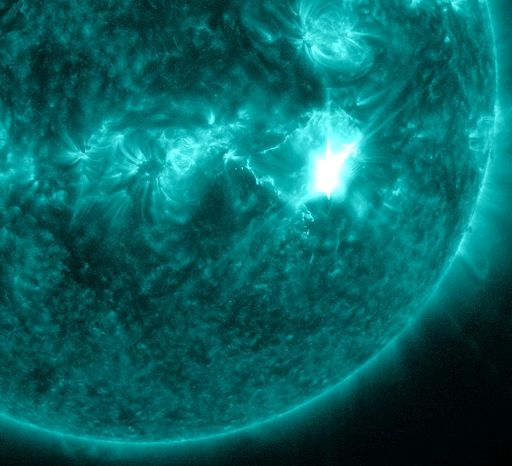 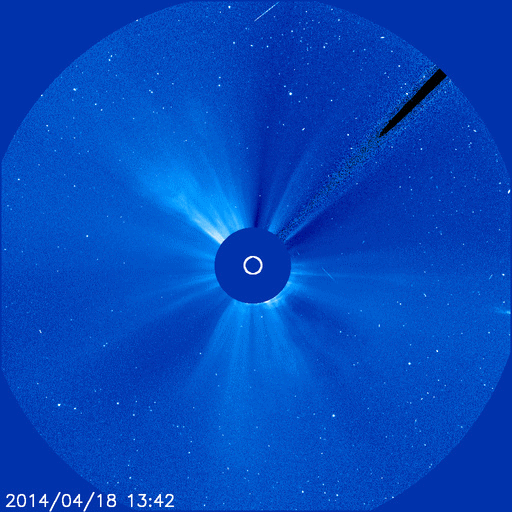 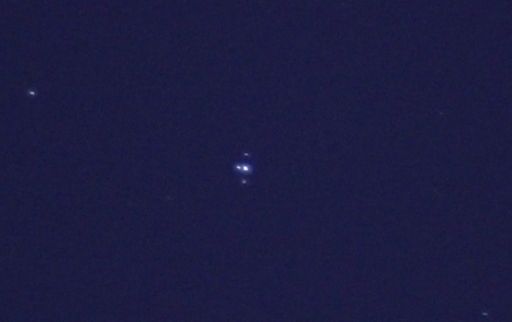 April 18, 2014 -Jupiter shines right under the big Arch of Spring this year. The Arch spans much of the western sky. Pollux and Castor form its top (as seen from mid-northern latitudes). To their lower left is one end of the Arch, Procyon, and farther to their lower right is the other end, Capella. -Using NASA's Kepler Space Telescope, astronomers have discovered the first Earth-size planet orbiting in the "habitable zone" of another star. The planet, named "Kepler-186f" orbits an M dwarf, or red dwarf, a class of stars that makes up 70 percent of the stars in the Milky Way. http://science.nasa.gov/science-news...pr_firstearth/ April 17, 2014 -Ganymede, the largest satellite of Jupiter, emerges from behind Jupiter's eastern limb around 10:18 p.m. Eastern Daylight Time. It disappears into eclipse by Jupiter's shadow around 12:06 a.m. EDT, then reappears around 3:29 a.m. EDT. -NASA's AIM spacecraft is discovering surprising "teleconnections" in Earth's atmosphere that link weather and climate across vast distances. Strange but true: The ground temperature in Indianapolis is correlated with the frequency of noctilucent clouds over Antarctica. NASA story: http://science.nasa.gov/science-news...leconnections/ -Lunar eclipses are supposed to be red, yet when the Moon passed through Earth's amber shadow on April 15th, many observers witnessed a softly-glowing band of turquoise blue. Robert and Elisabeth Slobins send this picture of the phenomenon from Fort Myers, Florida. The source of the turquoise is ozone. Prof. Richard Keen, an atmospheric scientist from the University of Colorado explains: "During a lunar eclipse, most of the light illuminating the Moon passes through the stratosphere, and is reddened by scattering. However, light passing through the upper stratosphere penetrates the ozone layer, which absorbs red light and actually makes the passing light ray bluer!" This can be seen, he says, as a turquoise fringe around the red. For years, Keen has been using lunar eclipses to probe the transparency of the stratosphere. When the stratosphere is clogged with volcanic ash and other aerosols, lunar eclipses tend to be dark red. The bright orange color of the April 15th eclipse, along with the ready visibility of the turquoise fringe, suggests that the stratosphere is clear. This is a key finding for climate change models.  April 16, 2014 -The waning gibbous Moon rises soon after dark with Saturn hanging right close by. Watch them cross the sky together for the rest of the night. The Moon occults (covers) Saturn for southern South America. Click the link to see if your city will be in view to watch the show. http://www.lunar-occultations.com/io...0417saturn.htm -Scarcely 24 hours ago, sunspot AR2036 didn't exist. Now it is three times as wide as the planet Earth. Click to view a movie from the Solar Dynamics Observatory showing the sunspot's almost-explosive growth. This new sunspot has a beta-gamma magnetic field that harbors energy for M-class solar flares, Earth-directed because the sunspot is almost directly facing our planet. The region's rapid growth could destabilize the field, making an eruption even more likely. NOAA forecasters estimate a 35% chance of M-flares and a 5% chance of X-flares.   April 15, 2014 -After dark, look east for the lineup of Mars, Spica, and the just-past-full Moon, in that order from top down. -NASA's Cassini spacecraft has photographed a small icy object forming at the edge of Saturn's rings. Informally named "Peggy," it may be a new moon caught in the act of genesis. -During the early hours of April 15th, the Moon spent more than three hours gliding through the shadow of Earth. The Moon turned red during the transit because the core of our planet's shadow is red. Why red? A quick trip to the Moon provides the answer: Imagine yourself standing on a dusty lunar plain looking up at the sky. Overhead hangs Earth, nightside down, completely hiding the sun behind it. The eclipse is underway. You might expect Earth seen in this way to be utterly dark, but it's not. The rim of the planet is on fire! As you scan your eye around Earth's circumference, you're seeing every sunrise and every sunset in the world, all of them, all at once. This incredible light beams into the heart of Earth's shadow, filling it with a coppery glow and transforming the Moon into a great red orb.  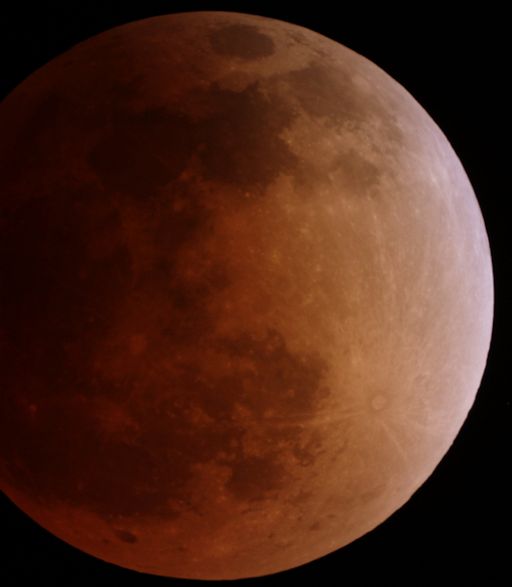 April 14, 2014 -A total lunar eclipse happens very late tonight for the Americas. The mainstream media is abuzz with reports of a "blood moon" on Tuesday morning. The scientific term is "lunar eclipse." On April 15th at 6 minutes past midnight Pacific Time (3:06 a.m Eastern Time), the Moon will enter the sunset-colored colored shadow of Earth, producing a total eclipse of the Moon. The color of Earth's shadow, and thus the color of the eclipsed Moon, depends substantially on the amount of volcanic ash and other aerosols floating in the stratosphere. According to atmospheric sciences professor Richard Keen of the University of Colorado, the stratosphere is clear. This means the eclipse will be not "blood red," but rather bright orange. See for yourself. The event will be visible from Australia, New Zealand, and all of the Americas. It's so bright, even observers in light-polluted cities will have no trouble enjoying the show. Got clouds? No problem. The event will be broadcast live on the web by the Coca-Cola Science Center at Columbus State University in Georgia. http://www.ccssc.org/webcast.html -Meanwhile Mars shines near the Moon all night, and Mars is at its closest to Earth tonight. And in addition, Spica shines much closer to the Moon than Mars does (for the Americas).   April 13, 2014 -Vesta, the brightest asteroid, is at opposition. Ceres, the biggest asteroid, is just 2½° from Vesta and only 2 days from opposition. They're in Virgo, easy in binoculars at magnitudes 5.8 and 7.0, respectively. -On the morning of April 15th, there will be a total eclipse of the Moon visible from Australia, New Zealand, and all of the Americas. The action begins on Tuesday at 2 AM Eastern time. Information can be found here: http://science.nasa.gov/science-news.../27mar_tetrad/ April 12, 2014 -This evening, look far lower left of the waxing gibbous Moon for fiery, glary Mars. By about midnight they're lined up horizontally in the south. -A polar geomagnetic storm that began during the late hours of April 11th is subsiding now. At its peak, the storm registered 5 on the Kp scale of magnetic disturbances, which means it was a relatively minor event. Nevertheless, it was strong enough to spark naked-eye auroras. A family of "aurora addicts" traveling through Boden, Sweden, took this picture of the display. The cause of the storm is a fluctuation in the interplanetary magnetic field (IMF). During the late hours of April 11th, the IMF tipped south, opening a crack in Earth's magnetosphere. Solar wind poured in to fuel the auroras. As April 12th begins, solar wind conditions remain favorable for Northern Lights. NOAA forecasters estimate a 40% chance of continued polar geomagnetic storms during the next 24 hours. 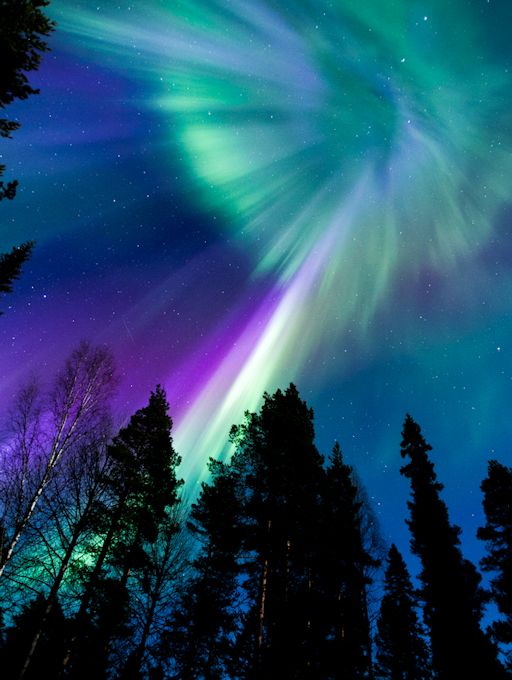 April 11, 2014 -The waxing gibbous Moon shines under Leo tonight. Leo is where you get if you follow the pointer stars of the Big Dipper far enough backward. -Mark your calendar. On April 15th, there will be a total eclipse of the Moon visible from Australia, New Zealand, and all of the Americas. The action begins on Tuesday at 2 AM Eastern time. -Two nights ago, astrophotographers Pete Lawrence and Ian Sharp stood in Sharp's back garden in Ham UK waiting for a spaceship to pass in front of the Moon. When it happened, their eyes barely registered the event. High-speed cameras, however, recorded a beautiful view of the ISS speeding over the Sea of Tranquillity. "Thanks to Pete Lawrence for alerting me to this," says Sharp, who took the picture using a 5-inch refractor. "Pete made the 5 mile trip to setup here and we both imaged the event separately and successfully." The ISS transiting the Moon sounds like a rare event, but it happens more often than you might suppose. Only one night earlier, on April 8th, Maximilian Teodorescu of Daia (Giurgiu), Romania, photographed a similar flyby. Most transits go unnoticed because they are so brief. The ISS, moving faster than 17,000 mph, completes its trip across the lunar disk in only a fraction of a second. If you would like to catch the ISS in the act, check Calsky for predicted lunar transits over your home town. 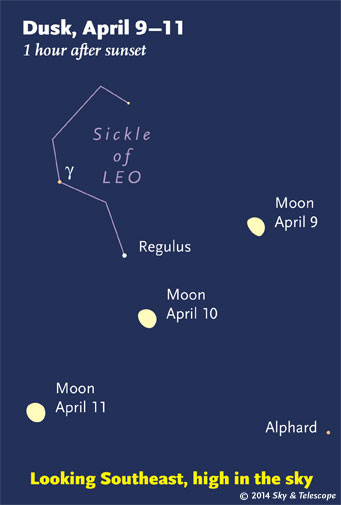 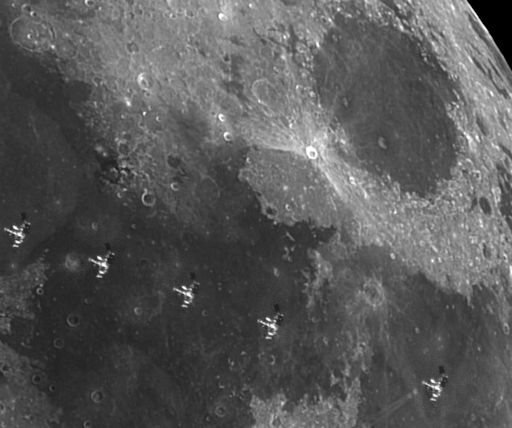 April 10, 2014 -Look above the waxing gibbous Moon this evening for Regulus. The Sickle of Leo extends nearly upright from Regulus. -For the past 24 hours, plumes of hot plasma have been rising and falling over the sun's southeastern limb. April 10th began with this eruption recorded by NASA's Solar Dynamics Observatory. The surge heralds the approach of a new sunspot. Because we cannot yet discern the complexity of the region's magnetic field, its potency remains unknown. However, the fact that it has been producing C-flares while still partially eclipsed suggests that much stronger flares are possible when the region fully emerges in the days ahead. -NASA's Solar Dynamics Observatory is monitoring a pair of coronal holes straddling the sun's equator. They are the deep-blue wedges in this extreme ultraviolet image of the sun taken mid-day on April 9th. Coronal holes are places in the sun's atmosphere where the ambient magnetic field opens up and allows solar wind to escape. A double-stream of solar wind flowing from these coronal holes could reach Earth on April 12-14. It is possible that neither stream will be geoeffective as they flow north and south of our planet. On the other hand, a "brush pass" might still spark polar auroras. NOAA forecasters estmate a 40% chance of polar geomagnetic storms when the streams arrive. 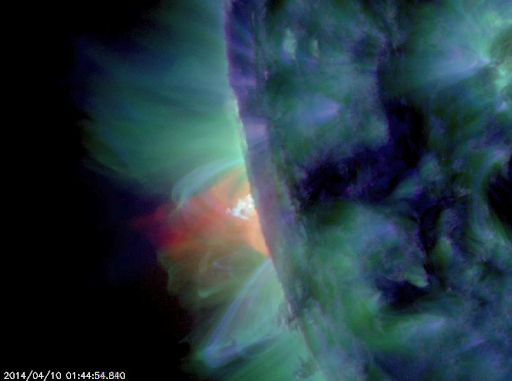 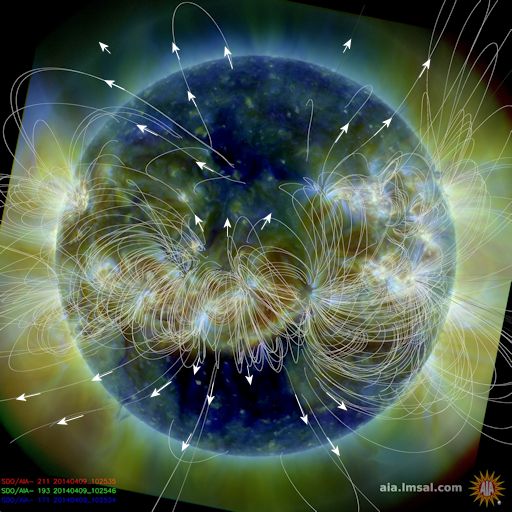 April 9, 2014 -This evening, look left of the Moon by about a fist-width at arm's length for Regulus in Leo. -In only 5 days, Mars will make its closest approach to Earth since 2012. Australian astrophotograher Anthony Wesley couldn't wait. Using a 16 inch telescope, he took this picture last night. His high-reolution images shows the rapidly evaporating north polar cap (summer began there in February), orographic clouds over the Elysium volcanoes near the Martian equator, and an even brighter blue cloud over the Hellas impact basin in the southern hemisphere. Hellas is the lowest point on Mars, and some of the haze evident there could be icy fog. Getting such Hubblesque results from a 16-inch telescope requires a combination of good seeing and long years of experience. Wesley is one of the world's top amateur astrophotographers and he routinely produces images like this. Observers with less experience can take good photos, too, especially in the nights ahead as Mars nears Earth.  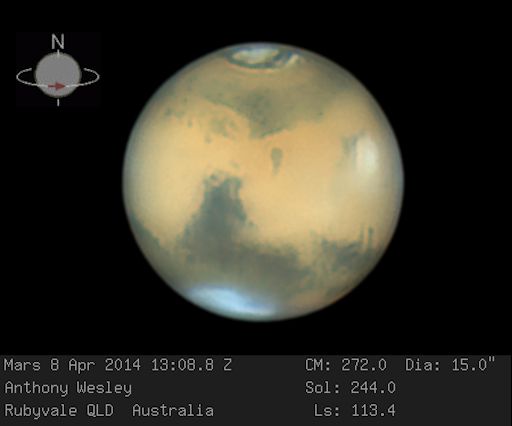 April 8, 2014 -Mars, blazing at magnitude –1.5 in Virgo, is at opposition. It rises around sunset and dominates the southeast after dark. Fainter Spica shines about 7° below it during evening. They're highest in the south around 1 a.m. daylight-saving time. -Now's the time for Mars in a telescope! It's practically at the 15.1-arcsecond diameter it will display when passing closest by Earth on April 14th. -Mars was imaged by Christopher Go on April 5th from the Philippines, where Mars is seen about half a rotation out of phase with the view we have from the Americas. South here is up. This is the "interesting" side of Mars. Dark Syrtis Major is left of center. Sinus Sabaeus and Sinus Meridiani are upper right of center. Go writes, "Hellas [south of Syrtis Major] is covered with bright cloud. Utopia and Ismenius Lacus [in the north] are well resolved. There are morning clouds at Chryse (left) and evening clouds at Aetheria (right)." The North Polar cap has shrunk, exposing the dark band around it. Faint lines paralleling sharp edges are a processing artifact. -With no sunspots actively flaring, solar activity is low. NOAA forecasters put the odds of an X-flare today at no more than 1%.  April 7, 2014 [left]-Mars is at opposition — its closest opposition since December 2007. Mars is actually nearest to Earth on the 14th, but the difference is barely a trace. This is the month for Mars with your telescope! -With no sunspots actively flaring, solar activity is low. NOAA forecasters put the odds of an X-flare today at no more than 1%. -"A year ago, I was standing in the staircase on the top floor of my apartment building talking to a neighbor," recalls Peter Rosén of Stockholm, Sweden. "Suddenly he noticed a perfect image of the Sun slowly moving across the wall behind me. The Sun was shining through a keyhole which acted as a lens, just like a gigantic pinhole camera. It only lasted for a couple of minutes." Rosén is a photographer, and he wanted to record the phenomenon. "Unfortunately I had not taken note of the exact date and time. So, this spring, I have been waiting for days with my camera ready on a tripod." Finally, on April 4th, the alignment occurred: "When the Sun finally appeared on the 4th of April, there was not one but two perfect tiny Suns, slowly moving across the opposite wall," says Rosén. "Our building is perfectly oriented to the cardinal points so theoretically it could have occured on the spring equinox, but as the windows are slightly offset, we have to wait for 2 more weeks before getting this perfect alignment." "But it still is like having a miniature Stonehenge at home!" -The International Space Station made a bright pass over Toronto last night at approximately 9:30pm EST. I stepped outside of my house and recorded the appearance as it passed between the moon and Jupiter. It appears as the long streak in these images. Check http://www.heavens-above.com for additional times in your region when the ISS passes over! 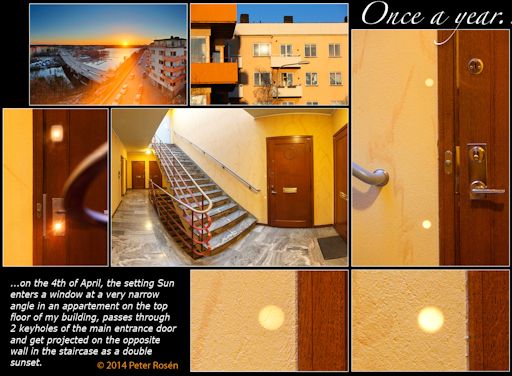    April 6, 2014 -First-quarter Moon. It's shining near Jupiter, which by no coincidence was at quadrature (90° east of the Sun) just a few days ago. -When the weekend began, several sunspots had tension-filled magnetic fields that posed a threat for Earth-directed eruptions. Now, however, those magnetic fields have relaxed, and the chance of flares is dropping. Solar activity should remain low for the next 24 hours. -This week, the International Space Station is making a series of bright passes over towns and cities in North America. On April 5th in Albany, Missouri, Dan Bush witnessed an ISS-lunar conjunction: "The moon was surrounded by a beautiful ice halo when the space station passed by," says Bush. "This is a composite of eight 20-second exposures." Soon, the streak the ISS makes when it passes overhead will double. On Monday, April 14th, SpaceX will launch a Dragon spacecraft to rendezvous with the space station. Filled with almost 5,000 pounds of scientific experiments and supplies, the Dragon will dock with the ISS two days later on April 16th. Prior to docking, sky watchers might be able to see the two spacecraft, ISS and Dragon, moving in tandem through the night sky. Dragon will remain attached to the space station's Harmony module until mid-May and splash down in the Pacific Ocean off the coast of Baja California with more than 3,000 pounds of experiment samples and equipment returning from the station. -The first very visible ISS pass happens tonight at approximately 9:28pm EST over Toronto. Go to Heaven's Above, change your observing location to your city on the map or somewhere close to you, and click the ISS link on the home page: http://www.heavens-above.com/main.aspx For Downtown Toronto residents, the following is the path of the ISS pass:    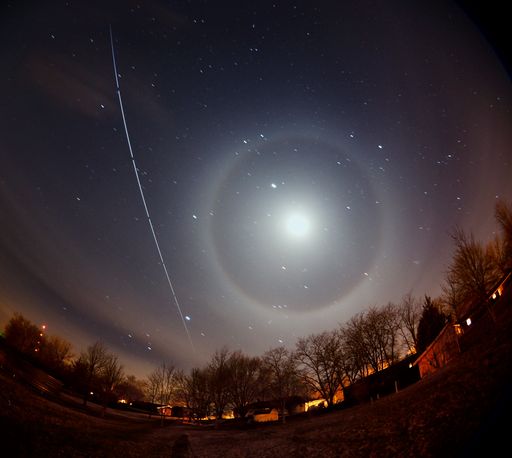 April 5, 2014 -The Moon passes below Jupiter in Gemini this weekend, as shown at right. Although they look close together, Jupiter is currently almost 2,000 times farther away. And it's 40 times bigger than the Moon. -All week look above Jupiter for Pollux and Castor, left of it for Procyon, and farther right of it for Capella. Way down below it is Betelgeuse, the top corner of Orion. -A slight increase in solar energetic particles swarming around Earth probably heralds the imminent arrival of two CMEs that have merged en route from the sun. NOAA forecasters expect a glancing blow from the amalgam on April 5th. Chance of geomagnetic storms = 55%. High-latitude sky watchers should be alert for auroras. April 4, 2014 -Spot Mars and Spica in the southeast after dark and look far left from them to find Arcturus, the "Spring Star," shining in the east. Arcturus forms the pointy bottom of the long, narrow kite asterism made by the brightest stars of Bootes. The kite is currently lying on its side to the left of Arcturus, with its head at the far left bent slightly upward. The kite is 23° long, about two fist-widths at arm's length. -Yesterday, during the late hours of April 3rd, three active regions on the sun exploded in quick succession. Play the movie, then consider the question: Was that three explosions, or just one? Visually, the rapid-fire explosions appear to be causally linked, and indeed they might have been. Since 2010, when SDO was launched, solar physicists have increasingly appreciated the interconnectedness of explosions on the sun. SDO's full-disk view has shown that magnetic instabilities can hop from one sunspot to another, propagating hundreds of thousands of kilometers to cause chain reactions on a titanic scale. The Global Eruption of August 2010 is the iconic example. 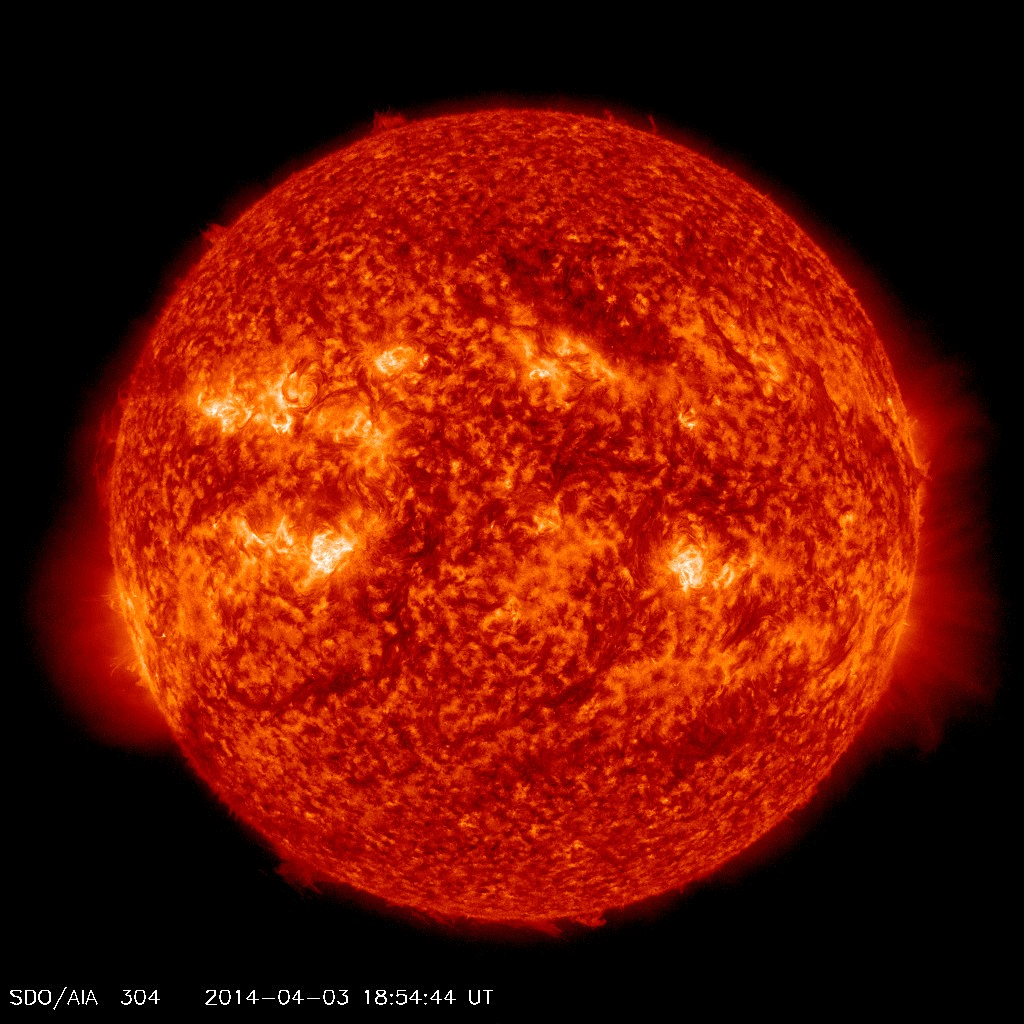 April 3, 2014 -With binoculars or a telescope, North Americans can watch the waxing crescent Moon crossing the Hyades star cluster. The Moon's dark, earthlit limb will occult three 4th- and 5th-magnitude stars depending on where you are. -NOAA forecasters have downgraded the chance of geomagnetic storms on April 3rd to only 1%. This follows a storm warning on April 2nd when a group of CMEs were expected to sideswipe Earth's magnetic field. However, all of the CMEs appear to have missed our planet.  April 2, 2014 -Arriving a little later than expected, at least three CMEs are still en route to Earth. NOAA forecasters expect glancing blows to commence on April 2nd with a 60% chance of polar geomagnetic storms when the impacts begin. High-latitude sky watchers should be alert for auroras. -In the night sky, there are thousands of stars visible to the unaided eye, and thousands of times more stars in range of backyard optics. Not a single one of those faraway balls of fire, however, looks any bigger than a pinprick. For a better view of a star, you need some daylight. This star is the sun. Francois Rouviere of Mougins, France, took the picture on March 31st using no more than a 7-inch refracting telescope and an "H-alpha" filter tuned to the red glow of solar hydrogen. "I caught this impressive explosion at the sun's western limb near sunspot AR2014," says Rouviere. "The inset, which is at a wavelength 1 Å shorter than H-alpha, shows fast moving material blue-shifted by the Doppler effect." Got a solar telescope? NOAA forecasters estimate a 40% chance of M-class flares and a 5% chance of X-flares on April 2nd. Train those optics on the daylight sky. -The crescent Moon shines below the Pleiades, Aldebaran, and the V-shaped Hyades, as shown below. 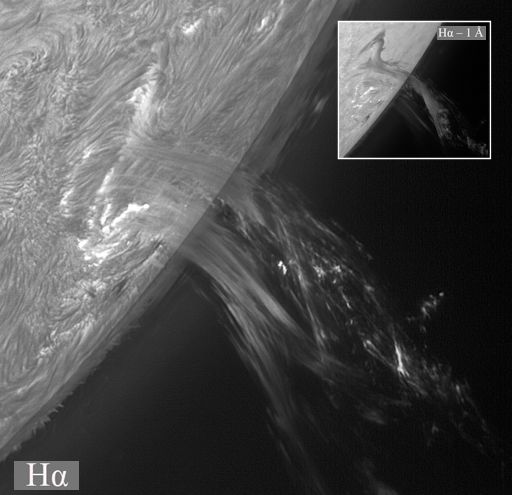  April 1, 2014 -The first of three or more CMEs en route to Earth are expected to arrive late in the day on April 1st. None of the incoming clouds is squarely Earth-directed. The series of glanciing blows, however, will rattle Earth's magnetic field and possibly spark auroras. NOAA forecasters estimate a 60% chance of polar geomagnetic storms on April 2nd. -The biggest and brightest asteroids, 1 Ceres and 4 Vesta respectively, are only about 2° apart in eastern Virgo, some 12° northeast of Mars. They've brightened to magnitudes 7.1 and 5.9, respectively. They'll be at opposition in mid-April. March 31, 2014 -NOAA forecasters estimate a 35% to 60% chance of polar geomagnetic storms on April 1-2 when at least three CMEs are expected to deliver glancing blows to Earth's magnetic field. The best-guess forecast calls for minor G1-class storms. High-latitude sky watchers should be alert for auroras. -On Saturday, March 29th, the magnetic canopy of sunspot AR2017 erupted, producing a brief but intense X1-class solar flare. A flash of extreme UV radiation sent waves of ionization rippling through Earth's upper atmosphere and disturbed the normal propagation of terrestrial radio transmissions. Radio engineer Stan Nelson of Roswell, NM, was monitoring WWV at 20 MHz when the signal wobbled then disappeared entirely for several minutes. "The Doppler shift of the WWV signal (the 'wobble' just before the blackout) was nearly 12 Hz, the most I have ever seen," says Nelson. The flare not only blacked out radio signals, but also produced some radio signals of its own. The explosion above sunspot AR2017 sent shock waves racing through the sun's atmosphere at speeds as high as 4800 km/s (11 million mph). Radio emissions stimulated by those shocks crossed the 93 million mile divide to Earth, causing shortwave radio receivers to roar with static. A plot of the outburst detected by Nelson using a 20.1 MHz RadioJove receiver is shown below. Elsewhere, strong bursts were recorded at frequencies as high as 2800 MHz. It was a very broad band event. 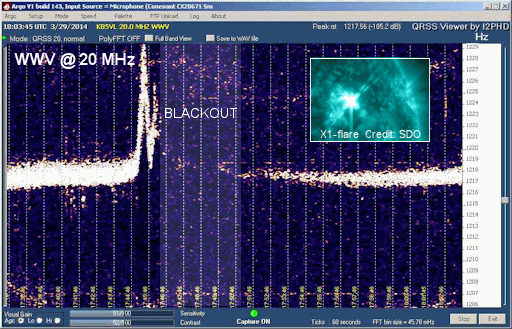  March 30, 2014 -This is the time of year when the dim Little Dipper juts to the right from Polaris (its handle-end) during evening hours. The much brighter Big Dipper curls over high above it, "dumping water" into it. -New Moon (exact at 2:45 p.m. Eastern Daylight Time). -Polar geomagnetic storms are possible on April 1st when one or more CMEs are expected to deliver glancing blows to Earth's magnetic field. The source of the incoming CMEs is active sunspot AR2017. High-latitude sky watchers should be alert for auroras. -On March 29th at 17:52 UT, the magnetic canopy of sunspot AR1890 erupted, producing a brief but intense X1-class solar flare. Radiation from the flare caused a surge in the ionization of Earth's upper atmosphere--and this led to a rare magnetic crochet, measuring 17 nT at the magnetometer in Boulder, Colorado. A magnetic crochet is a ripple in Earth's magnetic field caused by electrical currents flowing in air 60 km to 100 km above our heads. Unlike geomagnetic disturbances that arrive with CMEs days after a flare, a magnetic crochet occurs while the flare is in progress. They tend to occur during fast impulsive flares like this one. The explosion also hurled a CME into space. The bulk of the CME is sailing north of the sun-Earth line, but there appears to be a faint Earth-directed component that could deliver a glancing blow to our planet's magnetic field on April 1-2. More flares are possible this weekend. NOAA forecasters estimate a 55% chance of M-class flares and a 20% chance of X-class flares on March 30th. March 29, 2014 -You can tell winter is gone for good, astronomically speaking: As soon as the stars come out, the Big Dipper is already higher in the northeast than Cassiopeia is in the northwest. -Later this year, Mars is going to have a close encounter with a comet. On Oct. 19, 2014, Comet Siding Spring (C/2013 A1) will buzz the Red Planet about 10 times closer than any known comet has ever flown past Earth. Mars could actually find itself inside the comet's extended atmosphere as the comet passes by only 138,000 km away. Needless to say, NASA is watching carefully. The latest images from the Hubble Space Telescope show jets spewing from the comet's core. The image, captured on March 11th, shows comet Siding Spring at a distance of 353 million miles from Earth. Hubble can't see the icy nucleus because it is hidden inside the comet's glowing dusty atmosphere. Nevertheless, image processing did reveal what appears to be two jets of dust coming off the nucleus in opposite directions. This observation allows astronomers to calculate the direction of the nucleus's pole, and axis of rotation. "This is critical information that we need to determine whether, and to what degree, dust grains in the [atmosphere] of the comet will impact Mars and spacecraft orbiting Mars," says Jian-Yang Li of the Planetary Science Institute in Tucson, Arizona. Indeed, meteoroids from the comet could hit NASA's Mars orbiters and damage them even as the orbiters try to study the comet. The level of risk won't be known for months, but NASA is already evaluating possible precautionary measures. Data from Hubble and other observatories in the months ahead will clarify the dangers. 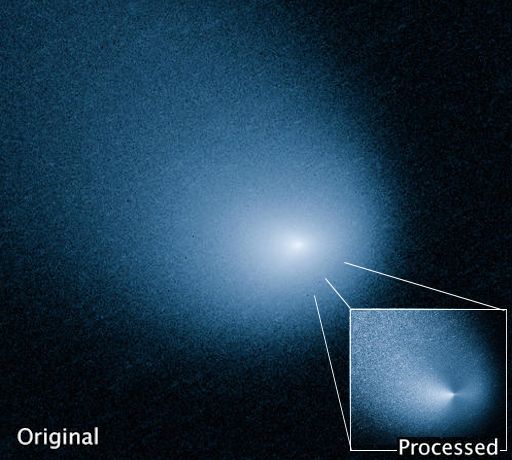 March 28, 2014 -The huge, bright Winter Hexagon nearly fills the southwestern sky at dusk. Start with bright Sirius in the south, marking the Hexagon's lower left corner. High above Sirius is Procyon. From there look even higher to Pollux and Castor with bright Jupiter below them, then from Castor farther lower right to Menkalinen and Capella, then lower left to Aldebaran, then duck around lower left to Rigel at the bottom of Orion, and back to Sirius. Within the Hexagon shine Jupiter and Betelgeuse. March 27, 2014 -On the traditional divide between the winter and spring sky is the dim constellation Cancer. It's between Gemini to its west and Leo to its east. Cancer holds a unique object: the Beehive Star Cluster, M44, in its middle. The Beehive shows to the naked eye as a dim, cloudy glow if your sky is fairly dark. Look for it a little less than halfway from Pollux to Regulus. With binoculars it's a snap even in a polluted sky. -On the sun today, two sunspots (AR2010 and AR2014) have unstable magnetic fields that harbor energy for significant flares. However, neither one is flaring. Solar activity is low and likely to remain so for the rest of the day. NOAA forecasters estimate a 25% chance of M-class flares (that is, a 75% chance of no M-class flares) on March 27th. -At a press conference in Brazil, astronomers announced the surprising discovery of an asteroid with rings. The 250-km-wide asteroid, named Chariklo, is located in the outer solar system between Saturn and Uranus. In June 2013, observers used seven different telescopes in South America to watch the asteroid pass in front of a distant star. The star winked out not just once, as would be expected for a solitary asteroid, but multiple times, revealing a pair of dense narrow rings surrounding the space rock. Below is an artist's concept of the system. "We weren't looking for a ring and didn't think small bodies like Chariklo had them at all, so the discovery — and the amazing amount of detail we saw in the system — came as a complete surprise!" says Felipe Braga-Ribas of Observatório Nacional/MCTI in Rio de Janeiro. He planned the observing campaign and is the lead author of a March 26th paper in Nature describing the results. According to their analysis, the rings are only 3 km and 7 km wide, respectively, with a 9 km gap between them. "I try to imagine how it would be to stand on the surface of this icy asteroid and stare up at a such a ring system 1000 times closer than the Moon," adds team member Uffe Gråe Jørgensen of the Niels Bohr Institute in Denmark. Because the rings are so narrow, they are probably confined and shepherded by small satellites. "So, as well as the rings, it's likely that Chariklo has at least one small moon still waiting to be discovered," adds Felipe Braga Ribas. For more information about this discovery, click here: http://www.eso.org/public/news/eso1410/  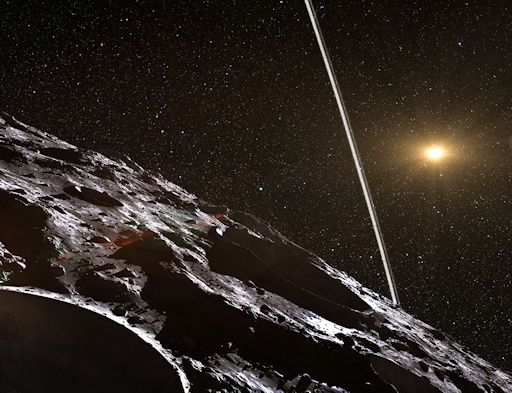 March 26, 2014 -As dawn brightens on Thursday morning the 27th, you'll find Venus near the thin waning crescent Moon, as shown here. -The waning Moon pairs with Venus on Thursday morning the 27th in the longitudes of the Americas. European observers: move each Moon symbol a quarter of the way toward the one for the previous date. In the Far East, move it halfway. The Moon here is drawn three times actual size. -A CME hit Earth's magnetic field on March 25th at approximately 19:45 UT. The glancing blow was relatively weak, but auroras appeared anyway. Hours after the impact, green lights dueled with the blue glow of dawn over Sørkjosen, Norway." The sky was really bright at 3am, but I could still see the auroras," says photographer Tommy Richardsen. "Times around equinoxes really are special. You can see auroras even when you should not be able to." He's right. For reasons researchers do not fully understand, equinoxes favour auroras. As northern spring unfolds, even relatively small gusts of solar wind and weak CME impacts can spark a good display. NOAA forecasters estimate a 40% chance of geomagnetic storms on March 26th as Earth passes through the wake of the CME.  March 25, 2014 -The biggest and brightest asteroids, 1 Ceres and 4 Vesta respectively, are only about 2° apart in eastern Virgo in the early morning hours, some 12° northeast of Mars. They've brightened to magnitudes 7.3 and 6.1, respectively. They'll be at opposition in mid-April. -Earth is looking down the double barrel of two potentially active sunspots: AR2010 and AR2014 have complex magnetic fields that harbor energy for strong eruptions, and both have grown since the week began. The CME expected to sideswipe Earth later today was propelled toward us by a C-flare from sunspot AR2014 on March 23rd. Otherwise the two sunspots have been mostly quiet. Is it the calm before the storm? NOAA forecasters estimate a 45% chance of M-class flares and a 5% chance of X-flares on March 25th 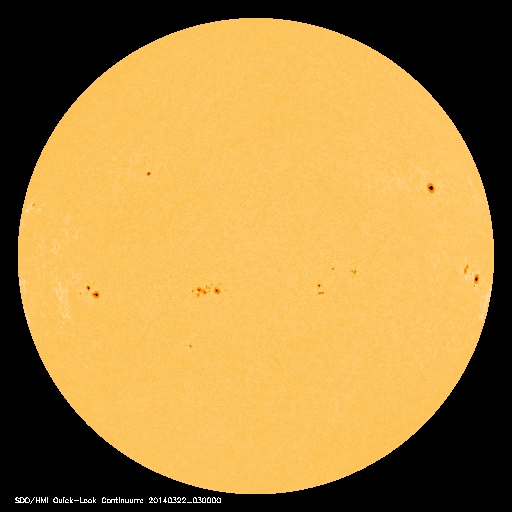 March 24, 2014 -By 10 or 11 p.m. Mars and Spica are well up in the southeast. Look almost two fists at arm's length to their right for the four-star pattern of Corvus, the Crow. Normally the Crow eyes Spica in Virgo's hand. Now he may be more interested in the brighter shiny right close by. -A CME launched from sunspot AR2014 on March 23rd is expected to deliver a glancing blow to Earth's magnetic field on March 25th. NOAA forecasters estimate a 30%-40% chance of polar geomagnetic storms on March 25-26. -Jupiter, among the legs of Gemini all week, forms the top of this year's Winter Diamond — which is still standing high as spring pushes winter aside. Procyon and Betelgeuse form the Diamond's side corners. This is how they're oriented in twilight as the stars come out. (Sirius is the Diamond's bottom.) The 3rd-magnitude star closest to Jupiter is Epsilon Geminorum, a yellow-orange supergiant 900 light-years away. Can you see its tint with your unaided eyes?  March 23, 2014 -Double shadow transit on Jupiter: Ganymede and Io are both casting their tiny black shadows onto the giant planet from 10:08 to 10:32 p.m. EDT (9:08 to 9:32 p.m. CDT). -Last quarter Moon (exact at 9:46 p.m. EDT). The Moon, in northern Sagittarius, rises around 2 or 3 a.m. Monday morning. By dawn Monday look for Antares very far to the Moon's right, Altair about equally far to the Moon's upper left, and bright Venus about equally far to its lower left. -A long line of sunspots is stretching across the sun's southern hemisphere, and at least two of them (AR2010 and AR2014) have 'beta-gamma' magnetic fields that harbor energy for M-class solar flares. NASA's Solar Dynamics Observatory photographed the "sunspot train" in motion on March 22nd. -Most of these sunspots are facing Earth, so if any of them erupts the blast would likely be geoeffective. NOAA forecasters estimate a 45% chance of M-class flares and a 5% chance of X-flares this weekend.  March 22, 2014 -When the stars come out this week, the Big Dipper is standing on its handle in the northeast. As evening grows late, the Dipper climbs higher and starts tipping to the left. -Long ago researchers thought solar flares were isolated events. Magnetic fields above a single sunspot became unstable and exploded--end of story. The Solar Dynamics Observatory's global view of the sun has shown, however, that widely-separated sunspots can explode in tandem. That's what happened on March 20th when AR2010 and AR2014 combined for a double flare. Transparent arcs of magnetism stretching across the 400,000 km divide between the two sunspots allow them to communicate magnetohydrodynamically, so instabilities in one can affect the other. This appears to be a textbook example of a 'sympathetic flare.' The most famous example occurred on August 1, 2010. SDO watched as instabilities jumped vast distances from one sunspot to another, setting off a chain reaction that engulfed more than half the sun. Compared to that global eruption, today's double flare was puny--or as puny as two explosions more powerful than a billion nuclear bombs can be. Welcome to the sun. 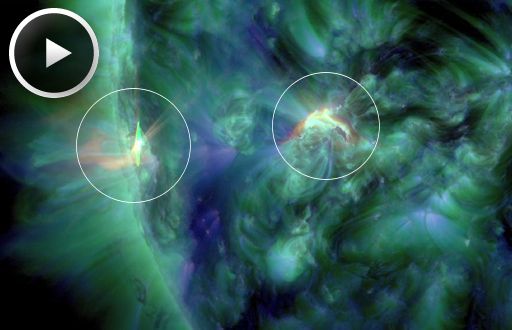 March 21, 2014 -This year's huge "Winter Diamond" — bright Jupiter on top, bright Sirius on the bottom, and Procyon and Betelgeuse forming the left and right corners — persists well into spring. It stands straight up in the south around dusk, then tips westward as the evening advances. -China's lunar rover, the "Jade Rabbit", is awake and communicating with Earth. The rover had recently hunkered down to survive its third night on the Moon. Mission controllers weren't sure the Jade Rabbit could survive as darkness fell for two weeks and temperatures plunged as low as -170 C. But survive it did, although the rover can no longer move. Stuck in place, Jade Rabbit continues to gather data about its surroundings in Sinus Iridum (the Bay of Rainbows). The mission was designed to last only 3 months, so every byte that comes back now is a bonus. March 20, 2014 -Spring begins in the Northern Hemisphere, and fall in the Southern Hemisphere, at the equinox: 12:57 p.m. Eastern Daylight Time (16:57 UT). This is when the Sun crosses the equator heading north for the year. The waning gibbous Moon rises around 11 or midnight tonight with Saturn shining near it. They reach their highest station in the south before the beginning of dawn. Although they look paired, Saturn is 3,600 times farther away in the background. -The heliophysics communitty is buzzing today in response to an article in Nature Communications, which describes an intense solar storm that narrowly missed Earth almost two years ago. On July 23, 2012, a CME rocketed away from the sun at 2000 km/s, almost four times faster than a typical eruption. The storm tore through Earth orbit, but fortunately Earth wasn't there. Instead it hit the STEREO-A spacecraft, which experienced the most intense solar proton storm since 1976. Researchers have been analyzing the data ever since, and they have concluded that the storm was akin to the Carrington Event of 1859. "Had it hit Earth, it probably would have been like the big one in 1859," says Janet Luhmann of UC Berkeley, a co-author of the paper. "The effect today [on] our modern technologies would have been tremendous." The Carrington Event was a series of powerful CMEs that hit Earth head-on, sparking Northern Lights as far south as Tahiti. Intense geomagnetic storms caused global telegraph lines to spark, setting fire to some telegraph offices and disabling the 'Victorian Internet." A similar storm today would have a catastrophic effect on modern power grids and telecommunication networks. According to a study by the National Academy of Sciences, the total economic impact could exceed $2 trillion or 20 times greater than the costs of a Hurricane Katrina. Multi-ton transformers fried by such a storm could take years to repair. The paper in Nature Communications describes what gave the July 2012 storm Carrington-like potency. For one thing, the CME was actually two CMEs separated by only 10 to 15 minutes. Plus the CMEs traveled through a region of space that had been cleared out by another CME four days earlier. As a result, they were not decelerated as much as usual by their transit through the interplanetary medium. The storm clouds crossed Earth's orbit in a place where Earth itself would be about 1 week later, so it was a relatively narrow escape. The whole episode highlights the perils of space weather. Many observers have noted that the current solar cycle is weak, perhaps the weakest in 100 years. Now we see that even a weak solar cycle can produce a very strong storm. Earth is not safe from these kind of events, so it's time to be prepared. The original research reported here may be found in Nature Communications: "Observations of an extreme storm in interplanetary space caused by successive coronal mass ejections" by Ying D. Liu et al., published on March, 18, 2014. http://www.nature.com/ncomms/2014/14...comms4481.html -The biggest structures on the sun today are not sunspots. Dwarfing all of the ordinary active regions, a pair of dark magnetic filaments are stretching across the almost-entire circumference of the sun's southern hemisphere. NASA's Solar Dynamics Observatory took this picture mid-day on March 19th. Containing masses of relatively cool plasma held suspended above the solar surface by magnetic forces, the sinuous structures are each more than 600,000 km long. If you put one end on Earth, the other would stretch far beyond the orbit of the Moon. Their dimensions make them easy targets for backyard solar telescopes. Sometimes, magetic filaments such as these become unstable and collapse. This can lead to a Hyder flare--a type of explosion that does not require sunspots. Hyder flares this week would likely be Earth directed as the filaments are both facing our planet.  March 19, 2014 -Asteroid to occult Regulus. For skywatchers in the New York City region and certain areas northward, the faint asteroid 163 Erigone (eh-RIG-uh-nee) will black out 1st-magnitude Regulus for up to 14 seconds a little after 2 a.m. EDT Thursday morning. This is the best asteroid occultation ever predicted to cross such a heavily populated area. And, anywhere from the Carolinas to Nova Scotia to Manitoba, it's also worth watching to see if Regulus might be occulted by a yet-unknown satellite of Erigone! The International Occultation Timing Association is working up a big public observing campaign. http://www.skyandtelescope.com/obser...249327421.html http://occultations.org/Regulus2014/ This effort is being spearheaded by the International Occultation Timing Association (IOTA). Its website for the public telling all about the event and how to participate is occultations.org/Regulus2014. The goal is to see (1) whether the star disappears as seen from your location, and (2) for how long — especially if you can time the event to high precision. Read full details and instructions at the website. From this data, astronomers hope to obtain a very precise profile of Erigone's size and shape, something that cannot be done any other way short of sending a spacecraft there. This has been done for many asteroids in the past that have occulted fainter stars. -Two past successes. The double asteroid Antiope and big, roundish Interamnia blotted out faint background stars on July 19, 2011, and March 23, 2003, respectively. In each case, dozens of observers scattered across hundreds of miles set up equipment to time the star's disappearance and reappearance. Each yellow line represents one observer watching the star. Accurate timings of when the star vanished and returned (breaks in the yellow line) could be properly fitted with each other to yield the asteroid's actual silhouette. Or for Antiope, two silhouettes! The map of the occultation is shown below.   March 18, 2014 -The Moon, Mars, and Spica form a striking triangle after they rise in the east late tonight and on into dawn on the morning of the 19th. -Tomorrow, For skywatchers in the New York City region and certain areas northward, the faint asteroid 163 Erigone (eh-RIG-uh-nee) will black out 1st-magnitude Regulus for up to 14 seconds a little after 2 a.m. EDT Thursday morning. This is the best asteroid occultation ever predicted to cross such a heavily populated area. -Despite a relatively high sunspot number, solar activity is low. None of the half-a-dozen sunspot groups on the solar disk is actively flaring. NOAA forecasters estimate a 35% chance of M-class flares and a 5% chance of X-flares on March 18th.  March 17, 2014 -Once the Moon is well up in the southeast late this evening, look below it to spot bright Mars and fainter Spica. By dawn on the 18th they're off in the west-southwest. -NOAA forecasters estimate a 15% chance of polar geomagnetic storms on March 17th. That means the odds of green skies on St. Patrick's Day are low. -Yesterday, the students of Earth to Sky Calculus launched a pair of research balloons into the stratosphere. One of the balloons carried an experimental Space Weather payload designed for rapid deployment during unexpected solar storms. Here it is, photographed in flight by the campanion balloon. One balloon photographing another is a rare and possibly unique occurance in the growing field of high-altitude ballooning. Congratulations to the students for breaking new ground in the air. There was no solar storm yesterday. The test flight of the Rapid Response Space Weather Payload prepares the team for another day when a strong flare or geomagnetic storm takes forecasters by surprise. This fast-turnaround payload can be displatched on a moment's notice to probe the stratosphere while the storm is underway. It includes a high-energy radiation sensor, a cryogenic thermometer, a GPS altimeter and other devices. Stay tuned for more data and images from the flight.   March 16, 2014 -Full Moon (exact at 1:08 p.m. EDT). The Moon rises around sunset and shines far below Leo in the evening, as shown above. Later in the night, look far to the Moon's lower left for Mars and fainter Spica. -On March 12th, an unexpected geomagnetic storm erupted around the Arctic Circle. The G1-class event was mostly minor, but a few longitudes experienced something more. Over the Finnish Lapland, geomagnetic activity and the auroras it sparked were locally intense. Juan Carlos Casado photographed the display from Saariselkä, a mountain village in northern Finland. "I took these pictures from the longest toboggan run in the world, in Saariselkä,using a circular fisheye lens,' says Casado. "I was with a group of observers and the reactions of people were very emotional, with shouts, laughter and tears in the eyes!" "Time marks inserted in the full-sized image give an idea of the speed of the phenomenon," he continues. "You can see the big bang of activity (top right) and how only in two minutes the whole sky is filled with auroras." The unexpected storm was caused by a fluctuation in the interplanetary magnetic field (IMF). As March 12th turned to 13th, the IMF tilted south, opening a crack in Earth's magnetosphere. Solar wind poured in and fueled the display. The time difference between the first image in the top left and the last image in the bottom right is 8 minutes. The full size image can be found here: http://spaceweathergallery.com/indiv...pload_id=95488  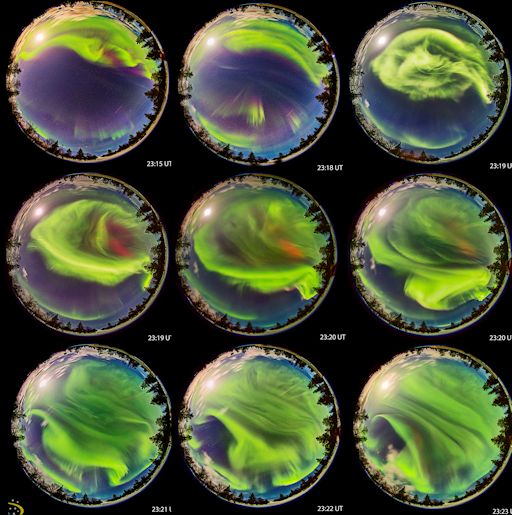 March 15, 2014 -The Big Dipper glitters high in the northeast these evenings, standing on its handle. You probably know that the two stars forming the front of the Dipper's bowl (currently on top) are the Pointers; they point to Polaris, currently to their left. And, you may know that if you follow the curve of the Dipper's handle out and around by a little more than a Dipper length, you'll arc to Arcturus, now rising in the east. But did you know that if you follow the Pointers backward, you'll land in Leo? Draw a line diagonally across the Dipper's bowl from where the handle is attached, continue far on, and you'll go to Gemini. And look at the two stars forming the open top of the Dipper's bowl. Follow this line past the bowl's lip far across the sky, and you crash into Capella. -Amateur astronomers are noting an outbreak of dark magnetic filaments on the sun. The longest, which measure 100,000 km to 250,000 km from end to end, are snaking around the sun's southeastern limb. Sergio Castillo sends this picture from his backyard observatory in Inglewood, CA. "If they collapse, these monster solar filaments could produce a Hyder flare," says Castillo. Indeed, he continues, "one of them erupted just yesterday." With all of the sunspots on the Earthside of the sun currently quieting, these filaments could be the source of greatest solar activity this weekend. Amateur astronomers with solar telescopes are encouraged to monitor developments.  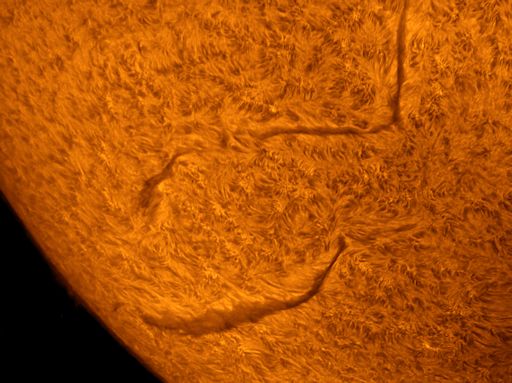 March 14, 2014 -This evening, look for Regulus and the Sickle of Leo above the almost-full Moon. -Today, March 14th (3.14), is Pi day, and all around the world pi-philes are celebrating one of the most compelling and mysterious constants of Nature. Pi appears in equations describing the orbits of planets, the colors of auroras, the structure of DNA. The value of pi is woven into the fabric of life, the universe and ... everything. Humans have struggled to calculate for thousands of years. Divide the circumference of a circle by its diameter; the ratio is pi. Sounds simple, but the devil is in the digits. While the value of is finite, the decimal number is infinitely long. Supercomputers have succeeded in calculating more than 2700 billion digits and they're still crunching. The weirdest way to compute: throw needles at a table or frozen hot dogs on the floor. Party time! http://www.angelfire.com/wa/hurben/buff.html http://www.wikihow.com/Calculate-Pi-...rozen-Hot-Dogs  March 13, 2014 -Look left of the Moon this evening for Regulus. It's the bottom star in the handle of the Sickle of Leo. -Departing sunspot AR1996 erupted on March 12th at 2234 UT, producing an M9-category blast that almost crossed into X-territory. NASA's Solar Dynamics Observatory captured the extreme ultra-violet flash. UV radiation from the flare caused waves of ionization to ripple through Earth's upper atmosphere, but they quickly subsided. Otherwise the flare was not geoeffective. The sunspot's location near the sun's eastern limb mitigated any Earth effects. The next flare could have a greater influence on our planet. Sunspot AR2002 is directly facing Earth, and it has a 'beta-gamma-delta' magnetic field that harbors energy for strong explosions. NOAA forecasters estimate an 80% chance of M-class flares and a 15% chance of X-flares on March 13th. -Observers around the Arctic Circle were surprised last night when the skies overhead erupted in swirls of verdant color. Rayann Elzein sends this picture from Inari in the Finnish Lapland. "Although there was no forecast of strong activity, auroras were dancing high in the sky--very bright and very fast," says Elzein. "They were the most breathtaking auroras that I have ever seen up here in Lapland!" The unexpected storm, a relatively minor G1-class event, was caused by a fluctuation in the interplanetary magnetic field (IMF). As March 12th turned to 13th, the IMF tilted south, opening a crack in Earth's magnetosphere. Solar wind poured in and fueled the display.  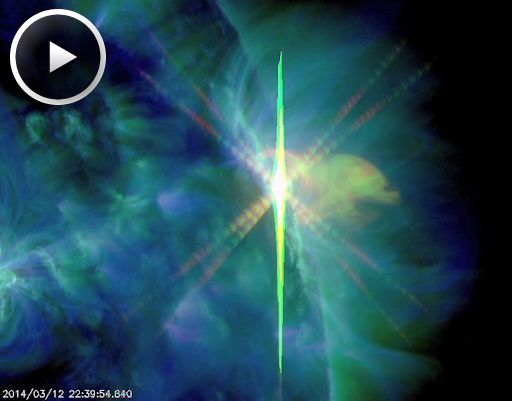 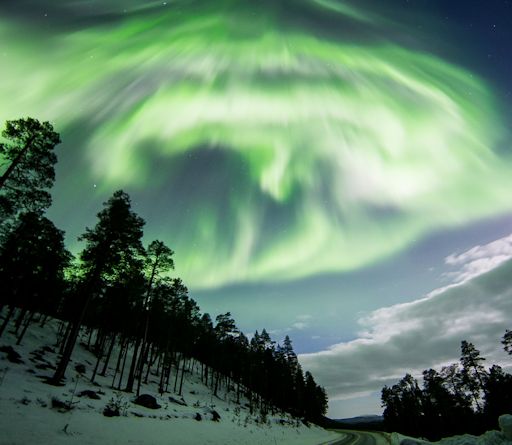 March 12, 2014 -It's still 8 days until spring, so Orion's Belt isn't yet quite horizontal in early evening. But it's getting there, as Orion tips down toward the southwest for its seasonal decline and eventual departure. -Unlike Jupiter's moons Io and Europa, Ganymede and Callisto are darker than most of Jupiter's surface, as seen dramatically in this high-resolution image of Ganymede near Jupiter's central meridian taken by Christopher Go at 11:20 UT March 2nd. You might even mistake it for its shadow! (The faint light ring that appears inside Ganymede is a processing artifact caused by its sharp dark edge against the lighter background). South is up. The reddish oval near Ganymede is Oval BA in the South Temperate Zone.  March 11, 2014 -Late twilight is when Sirius now stands due south, and twilight is also a time when the atmospheric seeing sometimes steadies. So it may be a good time to try to detect the faint white-dwarf companion of Sirius, now 10.2″ east of dazzling Sirius A. -Sunspot AR2002 poses a growing threat for solar flares. Since the week began, the active region has more than tripled in size. It now has more than a dozen dark cores and sprawls across 100,000 km of solar terrain. Karzaman Ahmad sends this picture, taken just hours ago, from the Langkawi National Observatory in Malaysia. "AR2002 is so large," says Ahmad, "that I was able to photograph it using an ordinary 11-inch Celestron telescope capped with a Thousand Oaks Glass Filter." The exceptionally crisp image shows thousands of boiling granules surrounding the sunspot's dark cores. Each granule is about the size of Texas. -A 48-hour movie from NASA's Solar Dynamics Observatory shows the sunspot's development. The rapid growth of AR2002 has destabilized its magnetic field, which makes it more likely to erupt. NOAA forecasters estimate a 60% chance of M-class flares and a 10% chance of X-class flares during the next 24 hours. 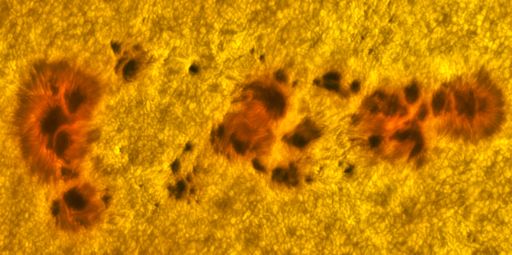 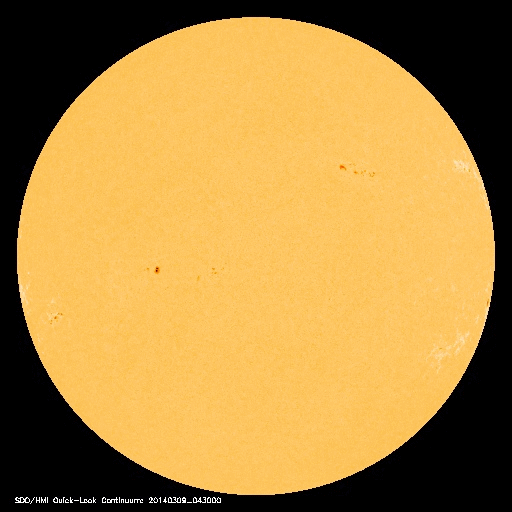 March 10, 2014 -The Moon forms a distorted rectangle with Jupiter, Castor, and Pollux this evening. In addition, the Moon and Jupiter form a bent line of three with Procyon to their lower left. -Mercury (magnitude +0.2) is low above the east-southeast horizon during dawn, about 20° lower left of bright Venus. -Saturn (magnitude +0.4, in Libra) rises around 11 p.m. and is highest in the south before dawn. By then it's far left of Mars and Spica, and less far to the upper right of Mars-colored Antares.  March 9, 2014 -Jupiter shines above the Moon this evening, as shown above. Although they look fairly close together, Jupiter is almost 1,800 times farther away — and 40 times larger in diameter. -Episode 1 of the reborn Cosmos series airs tonight (Fox network, 9 p.m. Eastern, 8 Central). -NOAA forecasters estimate a 30% chance of minor geomagnetic storms on March 9th when a solar wind stream is expected to brush against Earth's magnetic field. High-latitude sky watchers should be alert for auroras. The best time to look is during the hours around local midnight.  March 8, 2014 -As the stars begin to come out, the first-quarter Moon shines above Orion standing in the south. -Daylight-saving time begins at 2 a.m. Sunday morning for most of North America. Clocks spring forward an hour. -NOAA forecasters estimate a 25% to 35% chance of minor geomagnetic storms on March 8-9 when a solar wind stream is expected to brush against Earth's magnetic field. High-latitude sky watchers should be alert for auroras. The best time to look is during the hours around local midnight. -Next month, Earth and Mars will converge for their closest approach of 2014. Opposition occurs on April 8th. That's when Mars rises in the east at sunset, almost perfectly opposite the sun, and soars overhead at midnight shining 8 times brighter than a 1st-magnitude star. Although closest approach is still weeks away away, astronomers are already enjoying great views of the Red Planet. Australian astrophotographer Anthony Wesley took this picture using a 16-inch telescope on March 6th. -His high-resolution image shows orographic clouds over the Elysium volcanoes just north of the Martian equator and an even brighter blue cloud over the Hellas impact basin in the southern hemisphere. Hellas is the lowest point on Mars, and some of the haze evident there could be icy fog. Getting such Hubblesque results from a 16-inch telescope requires a combination of good seeing and long years of experience. Wesley, who is one of the world's top amateur astrophotographers, had both working for him on the morning of March 6th. "Skies were stable and clear," he says. "Using a Point Grey Research low-light Grasshopper3 camera, I recorded 2 minutes through red, green and blue filters with red @ 83fps, green @ 70fps and blue @ 50fps. I sorted all the frames according to image sharpness and stacked the best 2000 in each channel to make the color image, with additional wavelet sharpening in Registax, deconvolution in Astra Image and final color correction and touchups+captioning in the GIMP." Observers with less experience can take good photos, too, especially as March gives way to April and Mars approaches Earth. Look for burnt-orange Mars rising in the east around around 10 p.m. about 5° from the blue 1st-magnitude star Spica. The Moon passes by Mars on March 19-20 and provides a convenient "landmark" for finding the Red Planet. -From Earth's point of view, Mars is approaching opposition. The Red Planet is in the midnight sky, almost directly opposite the sun. NASA's STEREO-Behind spacecraft has a different point of view. STEREO-B is stationed over the farside of the sun. From there, Mars and the Sun are in conjunction. This coronagraph image taken by STEREO-B on March 5th shows the sun and Mars side-by-side. On the day this picture was taken, several explosions occured on the farside of the sun, hurling CMEs into space.  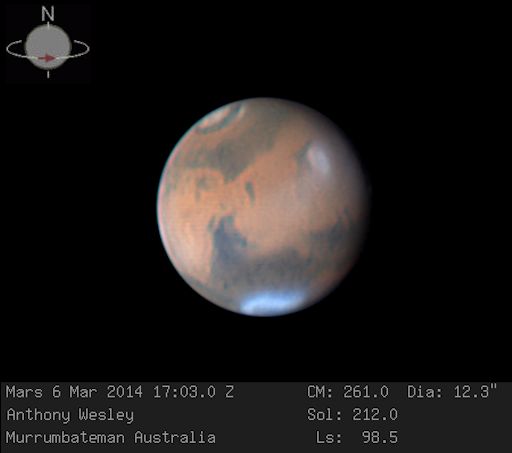 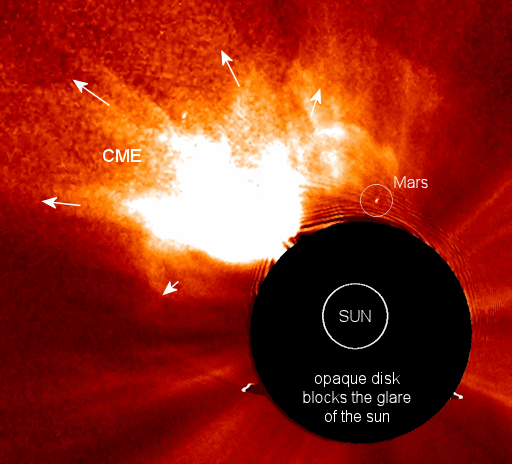 March 7, 2014 -Look below the Moon this evening for orange Aldebaran, an orange giant star 65 light-years from Earth. Far off to their left is Betelgeuse in the top of Orion. Less far to their right are the Pleiades. -March 6th began with a bang. "Last night, here was a significant fireball over north central New Mexico at precisely 00:19:20 am MST," reports Thomas Ashcraft. "It was brighter than the full Moon and shook houses from its sonic boom." Ashcraft operates a fireball camera and forward-scatter meteor radar at his private observatory near Santa Fe. Turn up the volume and play the movie he recorded: http://www.spaceweather.com/images20...AshcraftSW.mp4 Approximately two hours later, a similar fireball streaked over Yellowknife, Canada, exploding so brightly that the flash turned the night sky blue: Yuichi Takasaka took the picture from the verge of Vee Lake. "I was leading an Aurora Photography Tour," says Takasaka. "We had quite colourful auroras all night. All of sudden at 02:13 local time, one shooting star started from Western sky and exploded towards North. It got so bright that I had to close my eyes like someone used electric flash in front of me. A few minutes later, we could hear the huge explosion from the direction of the fireball fell. What an exciting night!!!" As far as we know there is no conection between these two events or the asteroid 2014 EC, which flew past Earth on March 6th. They are probably random meteoroids of the type that strike Earth's atmosphere every night. -NASA's Hubble Space Telescope has recorded the never-before-seen break-up of an asteroid into as many as 10 smaller pieces. http://science.nasa.gov/science-news...6mar_asteroid/   March 6, 2014 -After nightfall, look for Aldebaran to the upper left of the Moon and the Pleiades to the Moon's upper right, as shown below. -For the second time in as many days, an asteroid is flying through the Earth-Moon system. Yesterday, March 5th, 30-meter asteroid 2014 DX110 passed just inside the orbit of the Moon--about 0.9 lunar distances away. Today, March 6th, 10-meter asteroid 2014 EC is coming even closer--only 0.2 lunar distances. Neither space rock poses an immediate threat to Earth. According to NASA, asteroids thread the Earth-Moon system more than 20 times a year. -Hours ago, a bright coronal mass ejection (CME) flew over the sun's southeastern limb. If such an event had occured years ago, we wouldn't know if this CME was a threat because, as viewed from Earth orbit, CMEs heading toward and away from Earth look much the same. Today, however, all CMEs are observed from multiple points of view. Dual coronagraph images from SOHO (stationed on the Earthside of the sun) and the STEREO-A probe (stationed on the farside) clearly show that this CME is a farside event. Radio emissions from shock waves at the leading edge of the blast suggest the cloud is racing away from Earth at approximately 1400 km/s (3 million mph). If it were racing in the opposite direction, we would have a significant geomagnetic storm in the offing. Instead, space weather around Earth is expected to remain calm for the rest of this week.  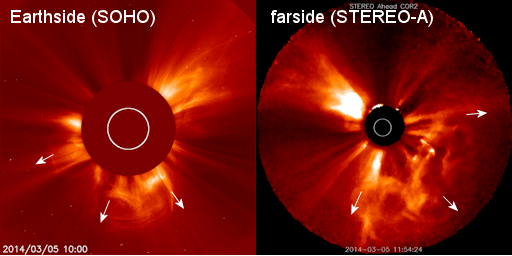 March 5, 2014 -The huge "Winter Diamond" of 2014 stands upright in the south around 8 p.m. now. It's formed by Jupiter on top and Sirius on the bottom — the two brightest points in the evening sky — and Procyon forming its left corner and Betelgeuse as its right corner. -The lifespan of a typical sunspot is two to three weeks. This one is about to turn three months. Carried around by the sun's 27-day rotation, AR1990 is making its third transit of the visible solar disk. In previous apparitions it was known as AR1944 and AR1967. Each time it has appeared, the sunspot has unleashed at least one strong flare, the most recent being the X4.9-class blockbuster of Feb. 25th. Since then, AR1990 has quieted and started showing signs of decay. 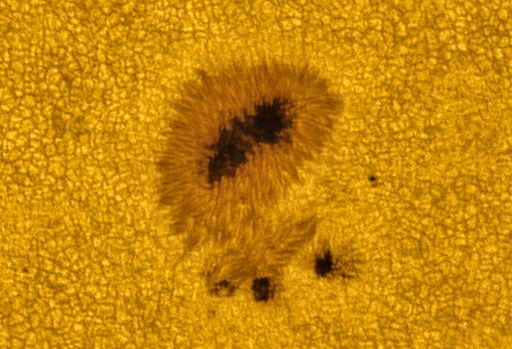 March 4, 2014 -Mars (magnitude –0.5, in Virgo) rises around 9 or 10 p.m., a fiery blaze 6° to the left of icy Spica. The two of them are highest in the south around 2 or 3 a.m., with Spica now lower right of Mars. -In a telescope Mars has grown to about 12 arcseconds wide, on its way to an apparent diameter of 15.1″ when it passes closest by Earth in mid-April. -On the night of March 3rd, with green lights swirling overhead, scientists at the University of Alaska's Poker Flat Research Range launched a 48-foot sounding rocket directly into the aurora borealis. "For weeks we've been sitting out all night every night, and though we've seen many good aurora, we haven't seen the type we wanted, in the position we wanted - until now," says graduate student Jason Ahrns, who took this picture of the rocket in flight. The rocket launch was part of a NASA-sponsored campaign called GREECE - short for "Ground-to-Rocket Electrodynamics-Electrons Correlative Experiment." Marilia Samara, a space scientist at the Southwest Research Institute in San Antonio, Texas, is the principal investigator. -GREECE aims to solve a long-standing mystery about auroras: Often, when a display begins, the lights are placid and widely spread across thousands of kilometers. Then, for reasons no one fully understands, the auroras will break up into highly-structured and rapidly changing arcs, swirls, curls, pillars, even "flames," with changes occurring on fraction-of-a-second time scales. Sensors on the Data from the sounding rocket will help researchers unravel the electrodynamics underlying these sudden and unpredictable transitions. "Preliminary expectations are that the launch was a total and complete success with lots of good science to come out of it," reports Ahrns. Updates on GREECE can be found here: http://greece.ssl.berkeley.edu/nightly-update/ 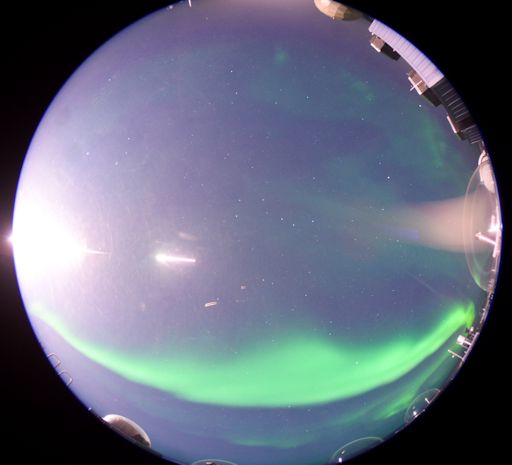 March 3, 2014 -Look high above the Moon in the west after dark for the stars of Aries hanging almost vertically. -Northern Lights are usually green, and sometimes red. Those are the colors produced by oxygen when it is excited by electrons raining down from space. On Feb. 22nd, Micha Bäuml of Straumfjord, Norway, witnessed an appariton of aurora-blue. "All of a sudden the sky exploded," says Micha. "The aurora looked like a giant flame." -In auroras, blue is a sign of nitrogen. Energetic particles striking ionized molecular nitrogen (N2+) at very high altitudes produces a cold azure glow of the type captured in Micha's photo. Why it overwhelmed the usual hues of oxygen on Feb 22nd is unknown. Auroras still have the capacity to surprise. -Any auroras tonight, blue or otherwise, will be a bit of a surprise. Geomagnetic conditions are quiet. NOAA forecasters estimate a scant 5% chance of polar geomagnetic storms on March 3rd. 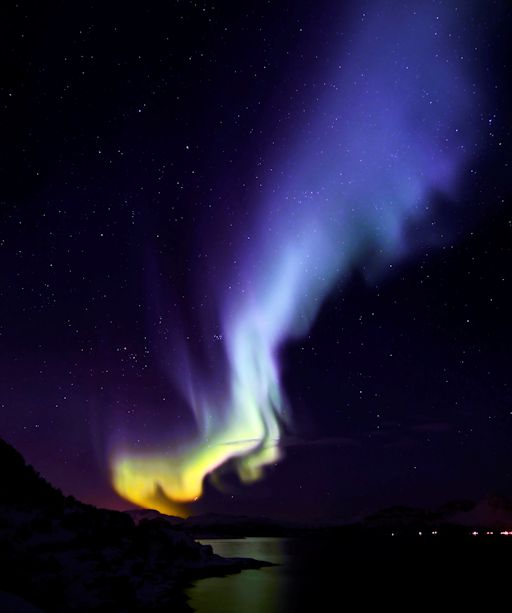 March 2, 2014 -The 7th-magnitude asteroid 2 Pallas is now passing 3° east of Alphard in Hydra in the southeastern evening sky. -The face of the sun is peppered with spots. One of them in particular merits attention. AR1991 is rapidly growing, almost doubling its number of dark cores since yesterday. AR1991 has a 'beta-gamma' magnetic field that harbors energy for M-class solar flares. The rapid evolution of the sunspot could destabilize the field, making an eruption more likely. NOAA forecasters estimate a 70% chance of M-class flares and a 30% chance of X-flares on March 2nd. 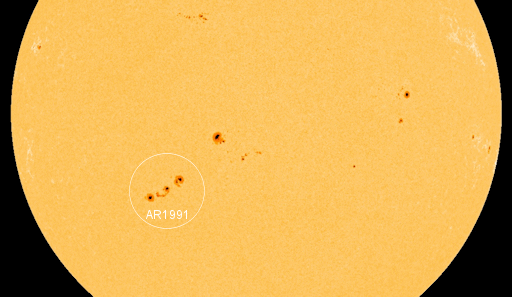 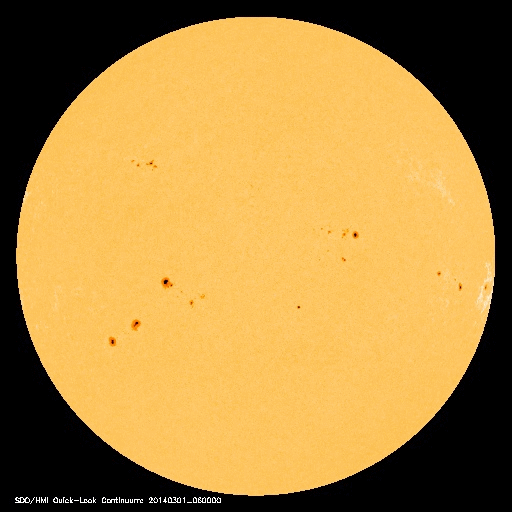 March 1, 2014 -Look east after dusk this week for the constellation Leo already climbing up the sky. Its brightest star is Regulus, and the Sickle of Leo extends upper left from there. As the saying goes, Leo announces spring. -Twice every year, around the time of the equinoxes, Earth can pass directly between the Sun and NASA's Solar Dynamics Observatory (SDO), producing a series of beautiful eclipses. SDO's vernal eclipse season began yesterday, producing a near-total blackout of the sun: -For the next three weeks these eclipses will repeat once a day around 07:30 UT. At the beginning of the season, the eclipses are short, only a few minutes long. Their duration increases to 72 minutes, mid-season, before tapering off to minutes again as the season winds down. Because most eclipses are relatively short, there is still plenty of uninterrupted time for SDO to monitor activity on the sun. Researchers estimate a scant 2% data loss averaged over the weeks ahead. 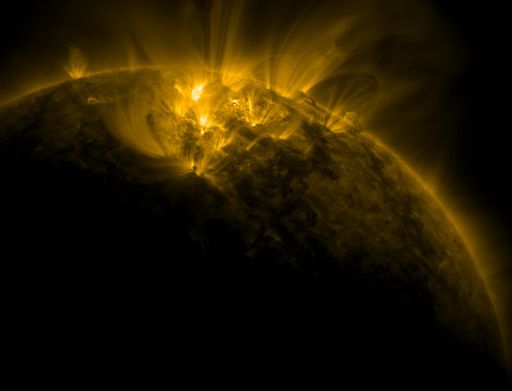 February 28, 2014 -Have you ever seen Canopus, the second-brightest star after Sirius? In one of the many interesting coincidences that devoted skywatchers know about, Canopus lies almost due south of Sirius: by 36°. That's far enough south that it never appears above your horizon unless you're below latitude 37° N (southern Virginia, southern Missouri, central California). And there you'll need a flat south horizon. Canopus crosses the south point on the horizon just 21 minutes before Sirius does. When to look? Canopus is due south when Beta Canis Majoris — Mirzim, the star a few finger-widths to the right of Sirius — is at its highest point due south. Look straight down from Mirzim then! -Jupiter's moon Io crosses in front of Jupiter's face from 5:56 to 8:11 p.m. Eastern Standard Time this evening. Its tiny black shadow follows behind from 7:02 to 9:17 p.m. EST. Jupiter's Great Red Spot transits the planet's central meridian around 9:09 p.m. EST. -A geomagnetic storm that started on Feb. 27th when a CME sideswiped Earth's magnetic field is subsiding. At its peak, the storm measured G2 on NOAA storm scales and sparked bright auroras over northern Europe, Greenland and Iceland. Tryggvi Már Gunnarsson was driving out of Reykjavik when he saw the display. "As I was driving from Reykjavik to north Iceland I saw this red halo on the sky. My first thought was: A volcano must be erupting!," says Gunnarsson. "Then, as the green colors appeared, I realized this was the aurora borealis. It was one of the most magnificent aurorashows I have ever seen." -If the magnetic storm had lasted just a little longer, bright lights would have appeared over some northern-tier US states, too. Instead, the display was rapidly fading by the time night fell over North America. High-latitude sky watchers should remain alert for auroras as Earth moves through the wake of the CME. NOAA forecasters estimate a 55% chance of resurgent storms on Feb. 28th. 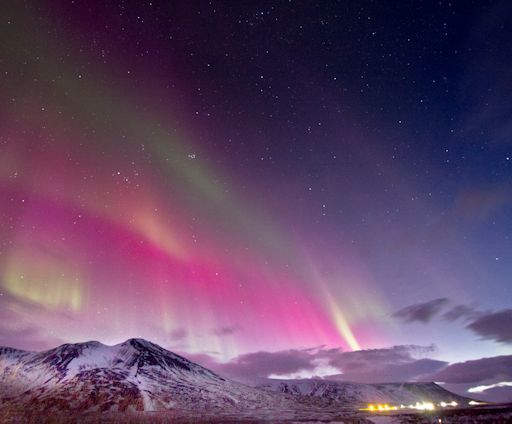 February 27, 2014 -Sirius shines at its highest in the south by 8 or 9 p.m. Use binoculars to look for the dim open star cluster M41 straight below it by 4°. That's a little less than the width of a typical binocular's field of view. -NOAA forecasters estimate a 45% chance of minor geomagnetic storms on Feb. 27th when a CME from Tuesday's X4-flare is expected to deliver a glancing blow to Earth's magnetic field. A dark and moonless midnight sky favors the visibility of high-latitude auroras. -Yesterday, NASA announced a breakthrough addition to the catalog of new planets. Researchers using Kepler have confirmed 715 new worlds, almost quadrupling the number of planets previously confirmed by the planet-hunting spacecraft. Some of the planets are similar in size to Earth and orbit in the habitable zone of their parent stars. February 26, 2014 -Set your alarm for dawn. Venus and the crescent Moon are having a beautiful pre-sunrise conjunction on Wednesday, Feb. 26th. Look east! It's a great way to start the day. [more] In a broad path stretching from central Africa across the Indian Ocean to China, the conjunction was so tight that the Moon actually eclipsed Venus. Ravindra Aradhya sends this picture from Bangalore, India, taken moments before Venus disappeared behind the lunar limb." A crescent moon occulting a crescent Venus in broad daylight was an amazing sight," says Aradhya. -About 30 minutes before sunrise Thursday morning, scan with binoculars very low in the east-southeast (far lower left of Venus) for the superthin crescent Moon with Mercury to its lower left, as shown here (as seen from North America).  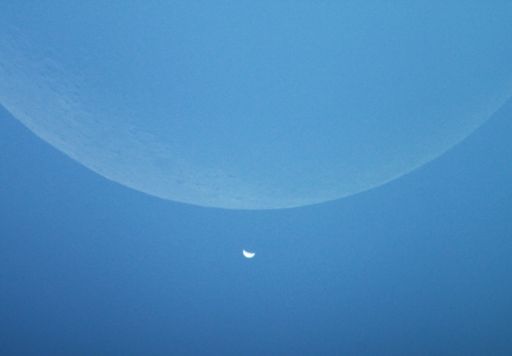  February 25, 2014 -During dawn on Wednesday the 26th, Venus shines upper right of the waning Moon low in the southeast, as shown here. At the time of dawn in the Americas they appear closer together than they did on Tuesday morning. Several hours earlier, the Moon passes right across — occults — Venus for central and western Africa, India, and parts of China and Southeast Asia (at roughly 5h Universal Time February 26th). Table is found here: http://www.lunar-occultations.com/io.../0226venus.htm -Returning sunspot AR1967 unleashed a powerful X4.9-class solar flare on Feb. 25th at 00:49 UTC. This is the most intense flare of 2014 so far, and one of the most intense of the current solar cycle. NASA's Solar Dynamics Observatory recorded the extreme ultraviolet flash. Although this flare is impressive, its effects are mitigated by the location of the blast site -near the sun's southeastern limb, and not facing Earth. Indeed, a bright coronal mass ejection (CME) which raced away from the sun shortly after the flare appears set to miss our planet: Radio emissions from shock waves at the leading edge of the CME suggest an expansion velocity near 2000 km/s or 4.4 million mph. If such a fast-moving cloud did strike Earth, the resulting geomagnetic storms could be severe. However, because its trajectory is so far off the sun-Earth line, the CME will deliver a glancing blow, at best, and probably no blow at all. The source of the eruption is long-lived sunspot AR1967, now beginning its third trip across the Earthside of the sun. This region was an active producer of flares during its previous transits, and it looks like the third time will be little different. By tradition, sunspots are renumbered each time they return, so AR1967 will be designated AR1990.  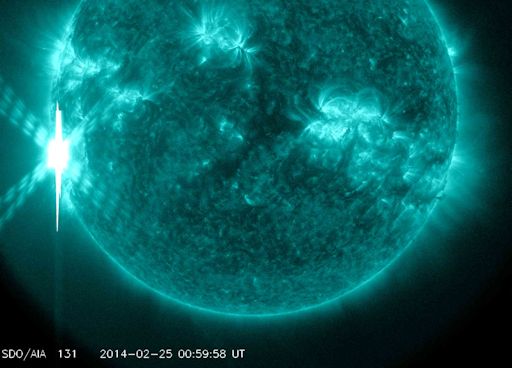 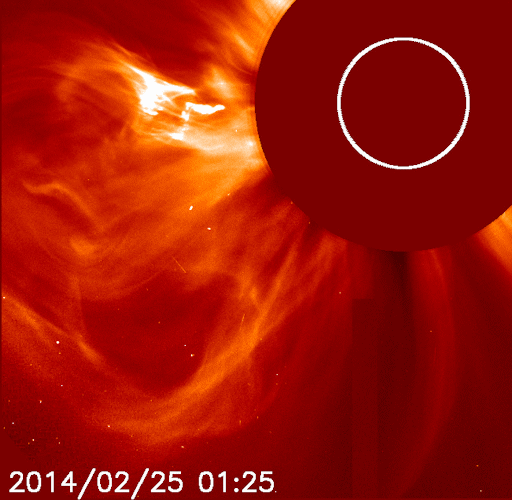 February 24, 2014 -During dawn on Tuesday the 25th, the waning crescent Moon shines upper right of Venus in the southeast. -The solar wind blowing around Earth is gusty and unsettled--probably a side-effect of one or more minor CMEs that swept past our planet over the weekend. This is sparking intermittent auroras around the poles, but no widespread geomagnetic storms. The forecast for the next 24-48 hours calls for growing calm. -Although the Earth-facing side of the sun is peppered with spots, that's not where the action is. For the past few days, most solar activity has been coming from a location hidden behind the sun's southeastern limb. It is likely old sunspot AR1967, set to return from a two-week transit around the farside of the sun. The place to watch is circled. If AR1967 does come back, it will mark the third time the active region has crossed the visible face of the sun. The first time was in early January when it was called "AR1944." Sunspots seldom last more than two or three weeks; two or three months is remarkable. By now the returning spot is probably a decayed shell of its former self, although flares and CMEs flying over the southeastern limb hint at some remaining potency.  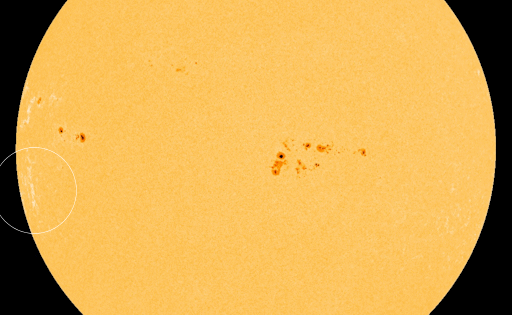 February 23, 2014 -The asteroid 2 Pallas, barely past opposition, is a few degrees southeast of Alphard in Hydra. It remains at magnitude 7.0 all week as it creeps northward, visible in binoculars and small telescopes. -NOAA forecasters estimate a 50% chance of minor geomagnetic storms on Sunday, Feb. 23rd, in response to glancing blows from one or two incoming CMEs. Arctic sky watchers should remain alert for auroras. -On the night of Feb. 20/21, photographer Dennis Mammana was stationed on Pedro Dome near Fairbanks, Alaska, in hopes of recording the Northern Lights. "I caught this instead—a tiny and bright cloud that rose from the western sky and spread slightly and faded over an hour or so," says Mammana. Here is a composite of two of his shots. The cloud resembles a rocket fuel dump. Scientists from the University of Alaska frequently launch rockets from the nearby Poker Flat Research Range to study auroras. But on this night there were no rocket launches on Poker Flat. There was, however, a launch thousands of miles away. A Delta 4 rocket blasted off from Cape Canaveral carrying a GPS satellite. Veteran satellite watcher Marco Langbroek says this is it: "The mystery object on the Mammana photo from Pedro Dome near Fairbanks, Alaska, is a fuel vent from the Feb 20 launch of GPS 2F-05 (USA 248, 20114-008A, #39533). Although the satellite is in an orbit with a 54.98 degree inclination, that does not mean it was not visible from Mammana's location at 65N," he continues. "It is in a very high orbit and was at an altitude of over 20,000 km at that moment. At such an altitude it is visible from 65 N, low in the west in this case." The attached sky map prepared by Langbroek shows the position of the satellite (labeled "Object A") in the sky above Alaska at the time Mammana photographed the cloud. The sky map and the photo are a good match.  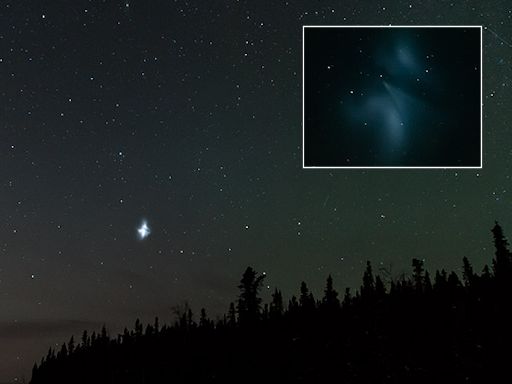 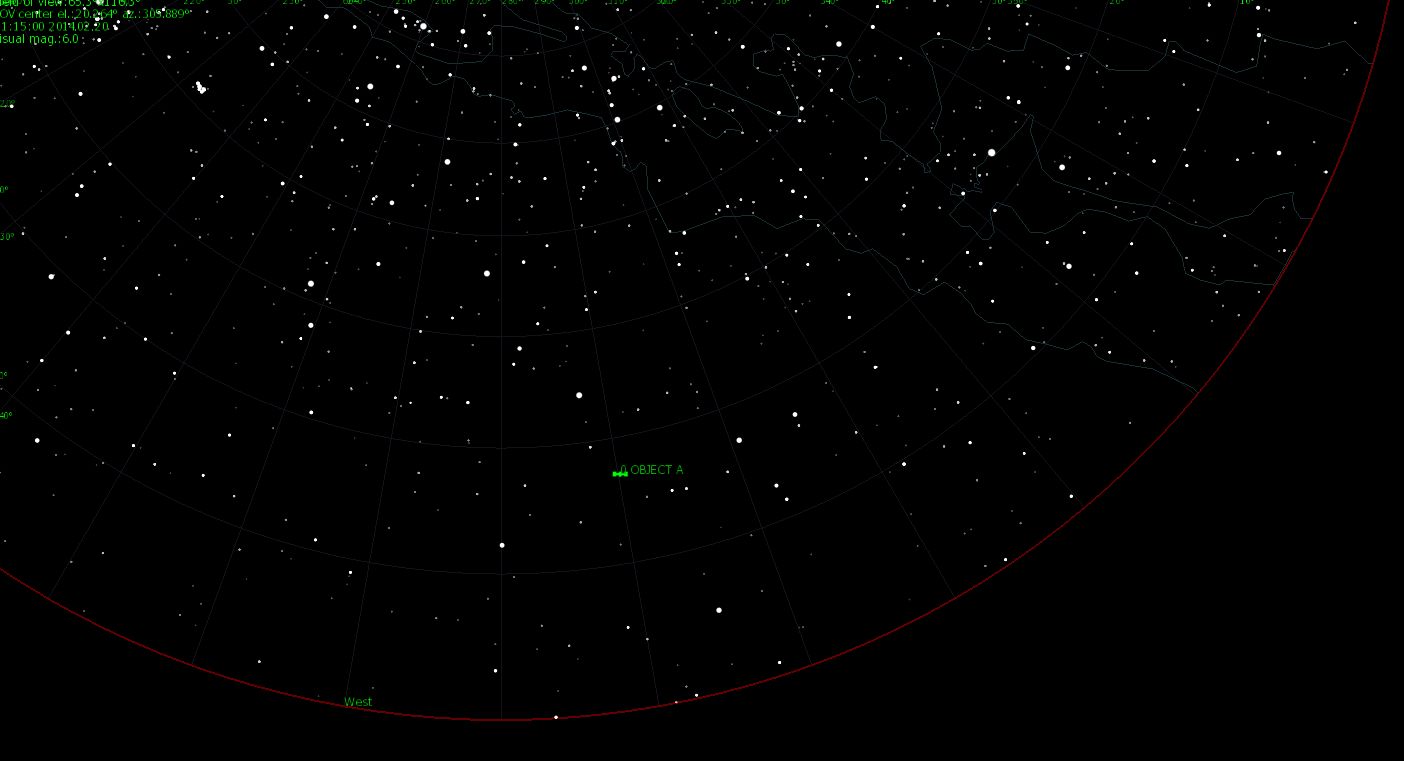 February 22, 2014 -This year's big, bright "Winter Diamond" — Jupiter at the top, Sirius at the bottom, and Procyon and Betelgeuse forming the two side corners — stands upright in the south around 8 or 9 p.m. now. -NOAA forecasters estimate a 50% chance of geomagnetic storms this weekend in response to CMEs due to arrive on Saturday and Sunday. Both CMEs are minor, but the 1-2 punch could cause significant magnetic disturbances around the poles. High-latitude sky watchers should remain alert for auroras. -One month ago, sunspot AR1967 emerged over the sun's eastern limb and unleashed almost two dozen M-class solar flares as it crossed the solar disk. Is it about to happen again? This weekend, the long-lived sunspot is due to return from the farside of the sun. A farside CME that billowed over the eastern limb on Feb. 21st suggests that AR1967 is still active. -If AR1967 reappears as expected it will mark the third time the active region has crossed the face of the sun. The first time was in December 2013 when it was called AR1944. Sunspots rarely last more than a few weeks; a few months is remarkable. By now the returning spot is probably a decayed shell of its former self, although the CME hints at some remaining potency.  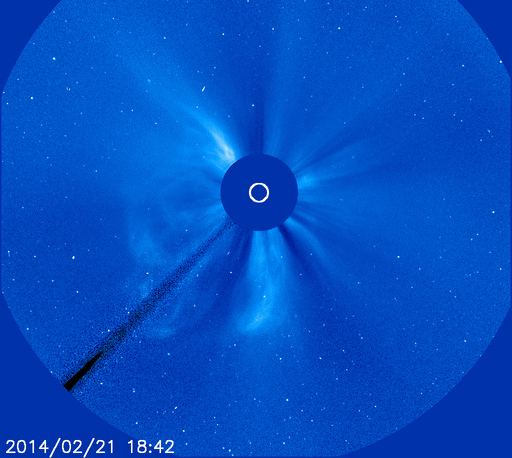 February 21, 2014 -Capella passes closest to straight overhead (for skywatchers at mid-northern latitudes) around 7 p.m. now, depending on how far east or west you are in your time zone. At the time this happens, Rigel in Orion's leading foot marks due south.  February 20, 2014 -A minor geomagnetic storm was already in progress on Feb. 19th when a CME struck Earth's magnetic field at approximately 0200 UT. The impact revved-up the storm and sent Northern Lights spilling across the Canadian border into the United States. Douglas Kiesling sends this picture from Sauk Rapids, Minnesota. "The auroras were so bright, I could actually see a snowy owl on power pole back lit by the green glow," says Kiesling. "The owl itself was illuminated by bright moonlight." High-latitude sky watchers, if it's dark where you live, look for auroras. For the second time in 24 hours, a CME has hit Earth's magnetic field. The impact on Feb. 20th at ~0300 UT re-energized a subsiding geomagnetic storm that sparked bright auroras over North America on Feb. 19th. As Earth's magnetic field reverberates from this second blow, auroras are spreading around the Arctic Circle and possibly down toward lower latitudes. -As dawn breaks Friday morning the 21st, spot the waning Moon in the south with Saturn to its left. Off to their right are Mars and Spica (out of the frame above).   February 19, 2014 -Go out after 11 tonight, and low in the east-southeast, where the Moon has just risen or is about to rise, you'll find bright, fiery Mars with Spica to its right. -A minor geomagnetic storm is in progress on Feb. 18-19. The cause: Magnetic fields in the interplanetary medium have tipped south, opening a crack in Earth's defenses against the solar wind. High-latitude sky-watchers should be alert for auroras.  February 18, 2014 -Major news outlets are reporting the close approach of a "huge asteroid" to Earth on February 17-18. 2000 EM26 is about as wide as 2 football fields and it is flying past our planet 2 million miles away at 27,000 mph. It's all true. It's also all hype. This asteroid is little different than half-a-dozen other space rocks that have already whizzed passed Earth at similar distances in February, including one, 2006 DP14, that is almost 4 times larger. The sudden attention to 2000 EM26 is disproportionate to its actual uniqueness or potential impact. -On Feb. 17th at approximately 04:50 UT, a magnetic filament erupted from the sun's western limb. NASA's Solar Dynamics Observatory captured this high-resolution image of the blast. Because of its location on the sun's western limb, the eruption did not send a CME toward Earth. However, there was an effect on our planet: Shortwave radio loudspeakers roared with static, an event called a Type II radio burst. Here's how it works: The explosion sent shock waves rippling through the sun's atmosphere. Those shock waves, in turn, triggered plasma instabilities in the solar corona that emit strong radio emissions. The static-y "roar" of the explosion was picked up by solar observatories and ham radio stations across the dayside of our planet. Based on the sweep of radio frequencies from 20 MHz to 500 MHz, analysts estimate a shock velocity of 776 km/s or 1.7 million mph. That may sound fast, but it is typical for this type of eruption. -By 11 p.m. the waning gibbous Moon is up in the east. Lower left of it shines Spica, and left of Spica, brighter Mars. Very far off to their left, the spring star Arcturus is already climbing the sky. See the scene at left for how the Moon, Mars and Spica are arranged by dawn on Wednesday morning. 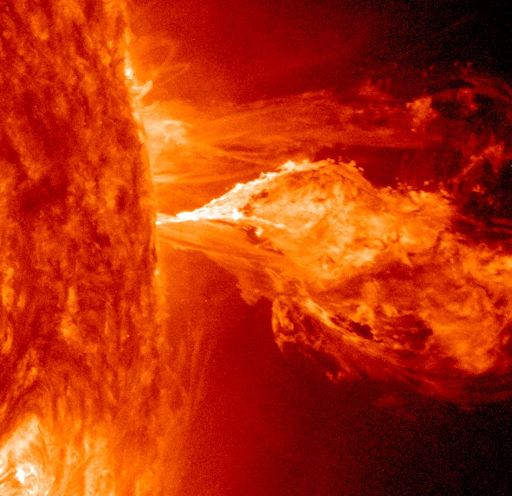  February 17, 2014 -Sirius now shines at its highest in the south around 8 or 9 p.m. Use binoculars to look for the dim open star cluster M41 straight below it by 4° (a little less than the width of a typical binocular's field of view). -Saturn (magnitude +0.5, in Libra) rises around midnight or 1 a.m. and is highest in the south at the beginning of dawn. By then it's far to the left of Mars and Spica, and less far upper right of Antares. -The shadows of Jupiter's four Galilean moons are not alike — or equally visible in small telescopes. These two were cast by Callisto (top) and Io, which aren't even the largest and smallest (those are Ganymede and Europa, respectively). Io and Callisto are, however, the nearest and farthest from Jupiter, so Io's shadow is always sharp and Callisto's is fuzzier. The fuzziness difference is evident only in superb images of Jupiter like this one, taken by Christopher Go at 12:16 UT February 6th. -Jupiter's orange Oval BA is nearly between the shadows, in the South Temperate Zone. South here is up.  February 16, 2014 -The thick waning gibbous Moon rises in the east around the end of twilight. Look higher above it now for Regulus. Extending upper left from Regulus is the Sickle of Leo. -A brief geomagnetic storm on Feb. 15th sparked by a CME impact has petered out, and the chances for auroras this weekend are subsiding. The CME appears to have been a merger of three minor clouds that, even together, could not cause a sustained disturbance in Earth's magnetic field. The hoped-for Valentine's display of auroras never materialized. -After days of nonstop activity, big sunspot AR1974 is quieting. The sunspot's magnetic field appears to be losing some of its unstable complexity, prompting NOAA forecasters to downgrade the chance of an X-class flare today to only 5%. February 15, 2014 -This is the time of year when, soon after dark, skywatchers at mid-northern latitudes see bright Capella crossing near the zenith and Orion standing highest in the south. Orion's diagonal belt points lower left toward bright Sirius, and upper right more or less toward Aldebaran. Beyond Aldebaran lie the Pleiades.  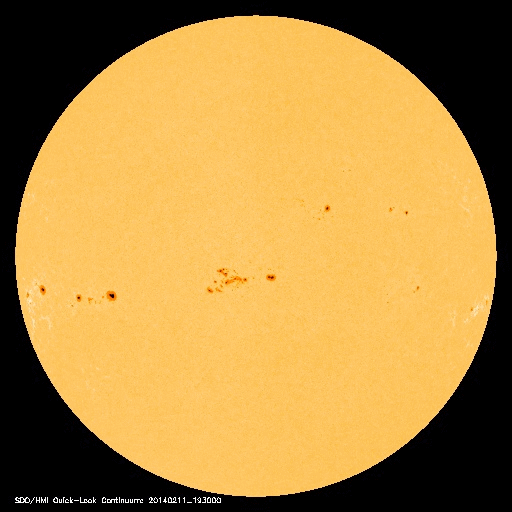 February 14, 2014 -Full Moon (exactly full at 6:53 p.m. EST). Look for Regulus in Leo to the Moon's left during evening, as shown here. A February full Moon is never far from Regulus. -Algol in Perseus should be at its minimum light, magnitude 3.4 instead of its usual 2.1, for a couple hours centered on about 10:30 p.m. EST (7:30 p.m. PST). Algol takes several additional hours to fade and to rebrighten.  February 13, 2014 -The wheel of the year is turning, and spring is only a little more than a month away. So by 9 or 10 p.m. (depending on your location), you'll find the Big Dipper already standing on its handle in the northeast as high as Cassiopeia has descended in the northwest. -Saturn (magnitude +0.5, in Libra) rises around 1 a.m. and is highest in the south at dawn. By then it's far to the left of Mars and Spica (by 28°). Look for Antares 18° to Saturn's lower left. This week Saturn is at western quadrature (90° west of the Sun). February 12, 2014 -To the right of the Moon this evening, by more than a fist-width at arm's length, sparkles Procyon, the Little Dog Star, one of our near stellar neighbors at a distance of 11.5 light-years. About twice as far to Procyon's lower right is brighter Sirius, the Big Dog Star, only 8.6 light-years away. -The biggest and brightest asteroids, 1 Ceres and 4 Vesta respectively, are only about 4° apart in eastern Virgo in the early morning hours. They're magnitude 8.1 and 7.1, respectively. -Two minor CMEs that left the sun on Feb. 11th are expected to merge and hit Earth's magnetic field on Feb. 14th. The combined impact could spark geomagnetic storms and auroras around the Arctic Circle on Valentine's Day. -Sunspot AR1974 is growing rapidly and poses an increasing chance of Earth-directed flares. During the past two days, the sunspot has sprouted dozens of new dark cores under an increasingly complex magnetic canopy. The region's unstable 'beta-gamma-delta' magnetic field harbors energy for strong explosions, prompting NOAA forecasters to boost the daily odds of M-flares to 45%, and X-flares to 10%.  February 11, 2014 -Jupiter shines above the Moon in early evening. Lower right of the Moon is Procyon, as shown here. Upper left of the Moon are Pollux and, farther on, Castor. -On Sunday, sky watchers around Calgary, Canada, witnessed a magnificent display of ice halos around the sun. "It was magical--the best I've ever seen," reports photographer Dee Cresswell, who needed four exposures to capture all of the glowing arcs. "The temperature was around -22 C, with a windchill in the mid minus thirties," she continues. "You could actually see the ice crystals shimmering in the air. There was a 22° halo, a 46° halo, infralateral arcs, tangent arcs, circumzenithal arc, a parhelic circle and more." Atmospheric optics expert Les Cowley created a diagram labeling the halos. He says they were created by a special kind of ice crystal called "diamond dust." "Diamond dust - that is, low level ice crystals shaped as hexagonal plates and columns - make the very best halos because the crystals are large and of good optical quality," explains Cowley. "Plates made the bright sundogs and the circumzenithal arc while column crystals generated the upper tangent arc and the rarer supralateral and infralateral arcs. More peculiarly oriented columns gave the not often seen Parry arc. A few randomly tilted crystals produced the faint 22-degree halo and only a hint of the 46-degree circle. Supralateral arcs and the rarer 46° halo can be hard to tell apart." "Even though wintry diamond dust is the king of halos,ordinary ice crystals in high clouds can give fine displays all year long," he says. "No matter where you live, or what time of year, keep an eye out for halos." 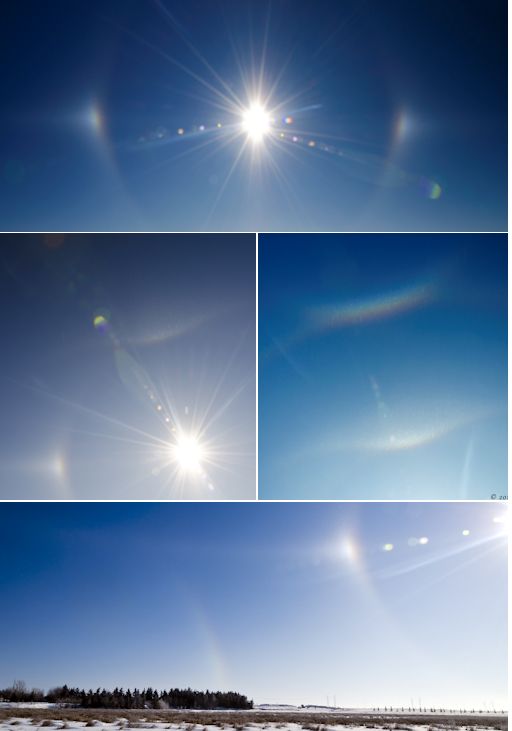 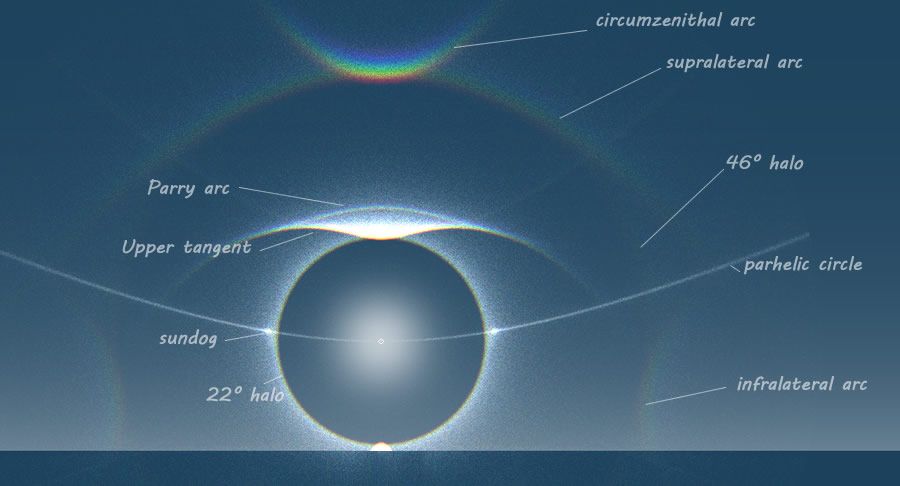 February 10, 2014 -The Moon and Jupiter shine about 5° apart this evening (for North America). They're in the feet of Gemini. Although they look close together, Jupiter is 1,630 times farther away — and 40 times larger in diameter. -Today, big sunspots AR1967 and AR1968 are rotating over the sun's western limb to begin a two-week transit of the sun's farside. Ironically, this could result in elevated levels of radiation near Earth. At their current location, the two sunspots are well-connected to our planet by the sun's spiraling magnetic field. Any flares today could funnel energetic particles in our direction, possibly triggering a radiation storm. -Earth's magnetic field is still reverberating from the impact of a CME on Feb. 7th. Intermittent storming around the poles has produced bright auroras across Scandinavia, Iceland and Canada. Zoltan Kenwell sends this picture from Edmonton, Alberta. "I was driving home when I noticed a dim green blob on the eastern horizon," says Kenwell. "I pulled off the highway for a better look and, to my surprise, I saw this corona dancing right above me. The reverberations are subsiding now, but they could begin anew on Sunday when a solar wind stream is expected to sweep past Earth. NOAA forecasters estimate a 45% chance of polar geomagnetic storms on Feb. 9-10. High-latitude sky watchers should remain alert for auroras.  February 9, 2014 -Last year when the Cassini spacecraft photographed Earth through the rings of Saturn, the whole world was alerted to smile and wave. Last week, Curiosity did the same thing with less fanfare. Except for a few scientists, no one knew the Mars rover would be taking this picture of the Earth-Moon system on Jan. 31st. Mission controllers used the left eye of Curiosity's Mast Camera (Mastcam) to capture the scene about 80 minutes after local sunset in the Dingo Gap. Our planet was the brightest thing in the darkening Martian sky. A human observer with normal vision, if standing on Mars, would have easily seen Earth and the Moon as two distinct "evening stars." The distance to Earth when Curiosity took the photo was about 99 million miles. 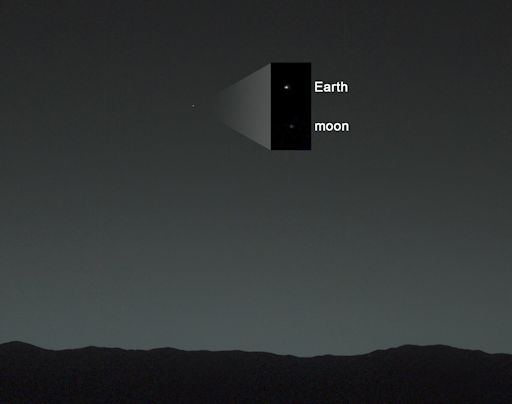 February 8, 2014 -Look to the right of the Moon after dinnertime for Aldebaran. Below the Moon stands Orion. -Jupiter (magnitude –2.6, in Gemini) dominates the eastern sky in early evening. It crosses nearly overhead (for mid-northern observers) around 9 or 10 p.m. In a telescope Jupiter remains a big 46 or 45 arcseconds wide. February 7, 2014 -This season, Jupiter turns the Winter Triangle into a bigger, brighter Winter Diamond! The Diamond's bottom is Sirius, its two side corners are Betelgeuse and Procyon, and Jupiter forms its top. It tilts leftward in early evening, then stands vertically in the south around 9 p.m. (depending on your location east or west in your time zone). -Polar geomagnetic storms are possible on Saturday, Feb. 8th, when a solar wind stream and a minor CME are expected to hit Earth's magnetic field. This will not be a major storm, but the double-impact could spark high-latitude auroras. -All week long, big sunspot AR1967 has has been crackling with activity, seemingly on the edge of producing an X-class solar flare. That hasn't happened. However, a new sunspot growing alongside AR1967 could push things over the edge. Emerging active region AR1968 has an unstable 'beta-gamma-delta' magnetic field that harbors energy for strong explosions. NOAA forecasters estimate an 60% chance of M-class solar flares and a 20% chance of X-class solar flares on Feb. 7th. Last night in Key West, Florida, Scott Wilson looked out over the Gulf of Mexico and saw the two big sunspots melting into the sea: The strange shape of the sun in Wilson's picture is a mirage caused by refraction in warm air just above the sea surface. There are many types of sunset mirages. This one is called the "Omega Sun" because the sun resembles the Greek letter omega. 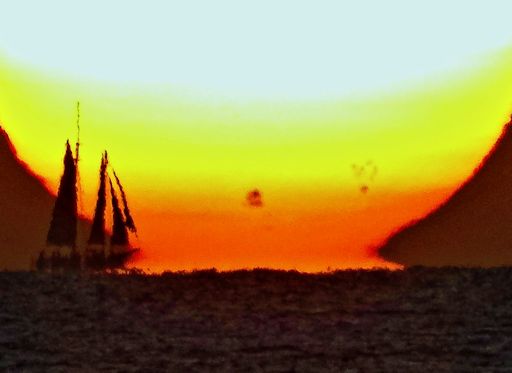 February 6, 2014 -First-quarter Moon. The Moon shines at the Aries-Taurus border, below the Pleiades throughout the evening hours. -Polar geomagnetic storms are possible on Saturdy, Feb. 8th, when a solar wind stream and a minor CME are expected to hit Earth's magnetic field. This will not be a major storm, but the double-impact could spark high-latitude auroras. -There is a place on Earth where you can see auroras almost every clear night even when there is no geomagnetic storm. It is under the auroral oval. The auroral oval is a donut of light around the poles which never goes completely dark because it is excited by energetic particles raining down from Earth's magnetosphere. Feb. 3rd was a very good night to be under the oval. "What an amazing night this was!" says Alan Dyer of Churchill, Manitoba, Canada. "On the night of Feb 3-4, despite all indicators showing quiet levels of activity, the sky exploded with a stunning all-sky display of rippling curtains across the sky. Churchill is under the prime auroral oval, so we see Northern Lights almost every clear night, even when official indicators are reading low or no geomagnetic storms." "These images are from the Churchill Northern Studies Centre, a non-profit research institute for Arctic science and that also offers aurora-watching and other Arctic tours through the year, including polar bear viewing in the autumn," he continues. "No words can describe the view of rapidly waving curtains of light rippling from horizon to horizon. All the tour group members left satisfied they had seen the celestial experience of a lifetime." According to NOAA forecasters there is only a 5% chance of geomagnetic storms on Feb. 6th. That's more than enough, however, under the oval. -Carried along by the sun's 27-day rotation, big sunspot AR1967 is turning away from Earth. Ironically this is making the active region even more dangerous. AR1967 is moving toward a location where the sun's spiraling magnetic field is well-connected to our planet and energetic particles can be funneled in our direction. An explosion there could spark a radiation storm around Earth. AR1967 has a 'beta-gamma-delta' magnetic field that harbors energy for strong eruptions. The past 24 hours has been relatively quiet, but that could be the calm before the storm. NOAA forecasters estimate an 80% chance of M-class solar flares and a 25% chance of X-class solar flares on Feb. 6th. 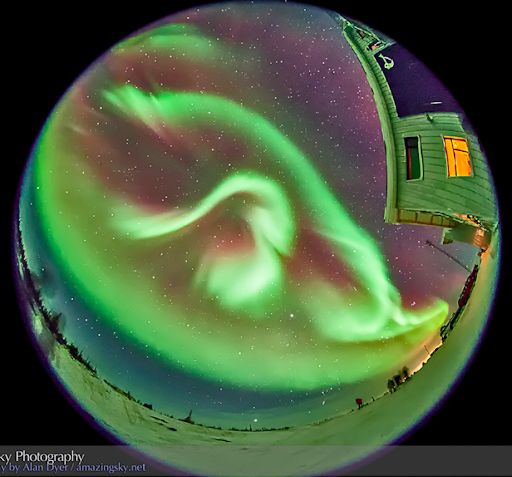 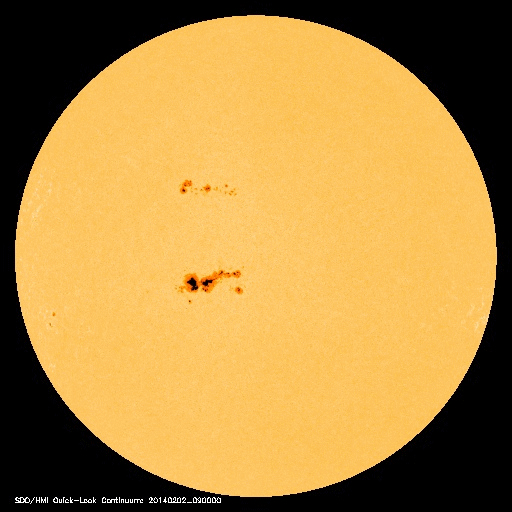 February 5, 2014 -The biggest and brightest asteroids, 1 Ceres and 4 Vesta respectively, are only about 4° apart in eastern Virgo in the early morning hours. They're magnitude 8.2 and 7.2, respectively. -A CME expected to sideswipe Earth's magnetic field on Feb. 4th missed. The solar wind around our planet was undisturbed by the distant passage of the cloud, which left the sun on Jan. 31st. February 4, 2014 -Jupiter's moon Io disappears behind Jupiter's western limb around 8:57 p.m. EST. Twenty minutes later, Jupiter's Great Red Spot crosses the planet's central meridian. Finally, Io reappears out of eclipse from Jupiter's shadow, just east of the planet, around 11:56 p.m. EST (8:56 p.m. PST). -NOAA forecasters estimate an 80% chance of M-flares and a 50% chance of X-flares on Feb. 4th. The source would be giant sunspot AR1967, shown here seething with activity in a photo from amateur astronomer Sergio Castillo of Inglewood, California. In Castillo's photo, a pair of magnetic filaments reaches out from the heart of the active region, where multiple dark cores big enough to swallow Earth are crackling with flares. "The activity in this region is just amazing," says Castillo. AR1967 has an unstable 'delta-class' magnetic field that harbors energy for strong flares and CMEs. Any eruptions today will surely be Earth-directed as the active region crosses the center of the solar disk.  February 3, 2014 -The crescent Moon this evening shines to the left of the Great Square of Pegasus. The Great Square is tipped up onto one corner, as it always is at this time of year. -A CME expected to sideswipe Earth's magnetic field on Feb 2nd did not arrive on time. A new analysis by NOAA forecasters suggests it will reach Earth on Feb. 4th instead. The late arrival could spark minor geomagnetic storms and auroras on Tuesday. -Solar activity reached high levels yesterday with seven M-class solar flares and three CMEs. Almost all of the explosions were produced by monster sunspot AR1967, shown here in a photo from Chris Schur of Payson, Arizona. AR1967 is wider than the planet Jupiter and its primary dark cores are big enough to swallow Earth many times over. The scale of the thing makes it an easy target for backyard solar telescopes. "I used an Explore Scientific AR152 to take the picture," says Schur. "This is one of the most photogenic sunspots I have ever seen." AR1967 has a 'delta-class' magnetic field that harbors energy for strong eruptions. The growing complexity of the region has prompted NOAA forecasters to boost the odds of X-flares to 50% during the next 24 hours. Because AR1967 is near the center of the solar disk, any eruptions will be squarely Earth directed. February 2, 2014 -Mercury is visible in evening twilight, low in the west-southwest. It fades rapidly, from magnitude –0.6 to +0.7 this week. -Venus (magnitude –4.8) shines brightly in the dawn; look southeast. In a telescope Venus is a crescent, thickening from 14% to 19% sunlit this week. February 1, 2014 -Mercury now shines below the thin crescent Moon low in the west-southwest after sunset. -Jupiter's moon Ganymede casts its tiny black shadow onto Jupiter from 5:42 to 8:22 p.m. EST. Jupiter's Great Red Spot crosses the planet's central meridian around 11:48 p.m. EST (8:48 p.m. PST). -NASA engineers are building a refrigerator for the International Space Station that can make atoms colder than anything else in the known universe. Inside this "Cold Atom Lab," researchers hope to discover new forms of matter and novel quantum phenomena. Get the full story from Science@NASA here: http://science.nasa.gov/science-news...0jan_coldspot/ -Big sunspot AR1967 is crackling with solar flares and hurling CMEs into space. The biggest CME so far was propelled away from the sun on Jan. 30th by an M6-class explosion in the sunspot's magnetic canopy. It is expected to reach Earth on Feb. 2nd. The blast was not squarely Earth-directed. Instead, it will deliver a glancing blow to our planet's magnetic field. NOAA forecasters estimate a 45% chance of polar geomagnetic storms when the cloud arrives on Sunday. High-latitude sky watchers should be alert for auroras.   January 31, 2014 -The Moon is back in the evening sky, as a thin waxing crescent to the lower right of Mercury. Look very low above the west-southwest horizon in twilight. -Yesterday, Jan. 30th, big sunspot AR1967 unleashed a strong M6-class solar flare. The explosion sent a CME racing away from the blast site faster than 1400 km/s (3 million mph). The cloud appears to have an Earth-directed component, and could deliver a glancing blow to our planet's magnetic field on Feb 1st. -On Jan. 30th, the Moon passed almost directly in front of the sun. No darkness fell on Earth, however, because the "lunar transit" was only visible from space. NASA's Solar Dynamics Observatory (SDO) recorded the entire passage from geosynchronous orbit. At maximum eclipse as much as 90% of the sun was covered. SDO is solar powered, but it did not "brown out" because mission controllers put an extra charge on the spacecraft's batteries ahead of time. Every year, SDO observes multiple lunar transits. This one, lasting almost 2.5 hours, was the longest in the history of the spacecraft's 4 year mission. A highlight of the movie occurs just after the eclipse is finished when sunspot AR1967 erupts. A plume of hot plasma flies away from one side of the sun just as the Moon is exiting the other. That eruption is the source of the CME that could deliver a glancing blow to Earth's magnetic field on Feb. 1st.   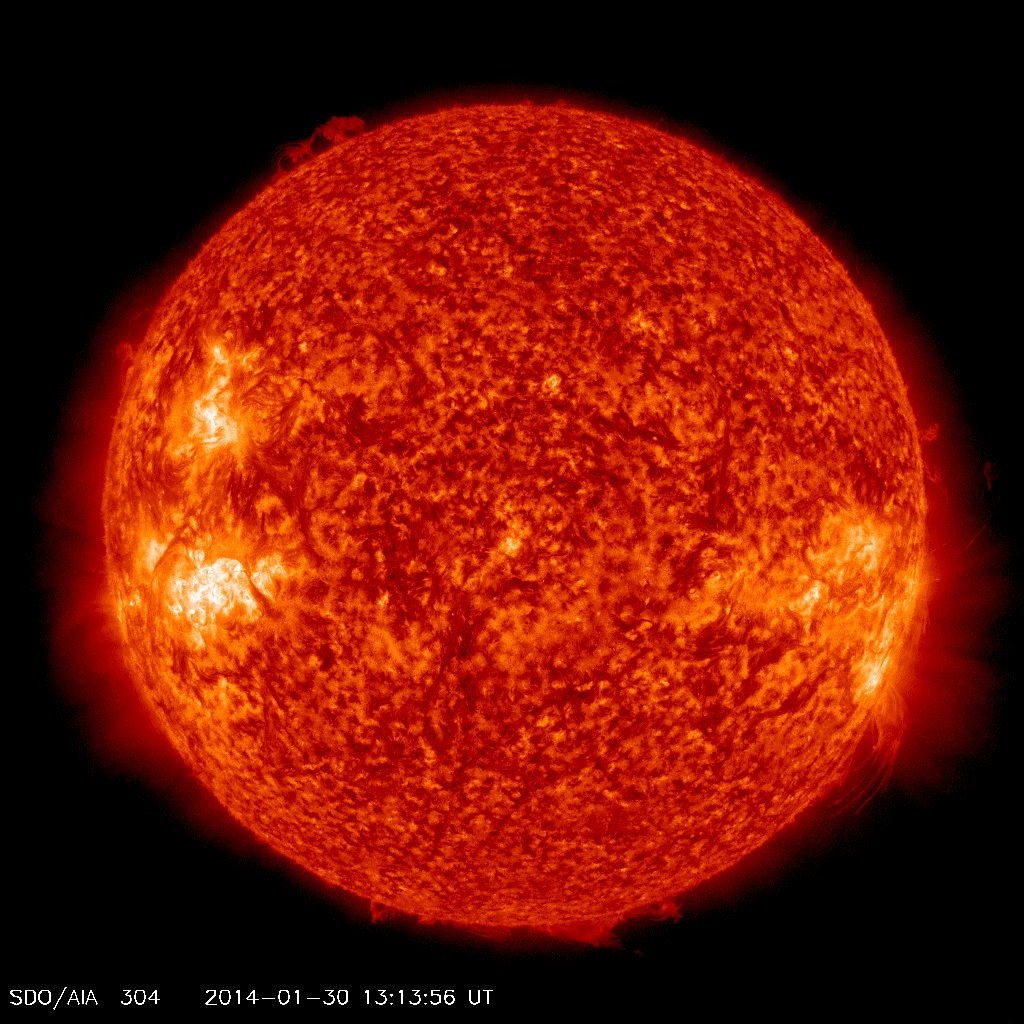 January 30, 2014 -On Thursday, Jan. 30th, the Moon will eclipse the sun for almost 2.5 hours. You have to be in space to see it. NASA's Solar Dynamics Observatory s set to record the "lunar transit," which begins at 1331 UTC or 8:31 EST. A simulation shows that approximately 90% of the sun will covered. SDO is solar powered, so mission controllers have charged-up the spacecraft's batteries to endure the blackout. Stay tuned for images during the eclipse! January 29, 2014 -Jupiter this month turns the Winter Triangle into a bigger, brighter Winter Diamond. Its bottom is Sirius, its two side corners are Betelgeuse and Procyon, and Jupiter forms its top. The diamond tilts leftward in early evening and stands vertically in the south around 10 p.m. (depending on your location). -Earth is entering a stream of solar wind blowing almost 500 km/s or 1.1 million mph. First contact on Jan. 28th sparked tall curtains of light around the Arctic Circle. Harald Albrigtsen captured this picture of the display from Skulsfjord, Tromsø, Norway. "At first there was little auroral activity, but being patient paid off," says Albrigtsen. He photographed the explosion of light using a Nikon D600 digital camera set at ISO 3200 iso for 3 seconds. Arctic photographers, take note of those settings because more auroras are on the way. NOAA forecasters estimate a 25% to 40% chance of polar geomagnetic storms on Jan. 29-30 as Earth moves deeper into the solar wind stream. -Big sunspot AR1967 near the sun's southeastern limb is crackling with solar flares. As Jan. 29th unfolds it is producing an average of one impulsive M-class explosion every two hours. So far, none of the explosions has been Earth-directed, but future flares will be as the sunspot continues its slow turn toward our planet. NOAA forecasters have doubled the odds of an X-class flare in the next 24 hours to 10%. Meanwhile, M-class flares seem almost certain as the crackling continues. The primary dark core of AR1967 is twice as wide as Earth. This makes it an easy target for small telescopes equipped with solar filters. This morning at the Langkawi National Observatory in Malaysia, astronomer Karzaman Ahmad photographed the sunspot using an 11-inch Celestron." I wanted to take a closer look at the monster numbered AR1967," says Ahmad. "It is impressive."  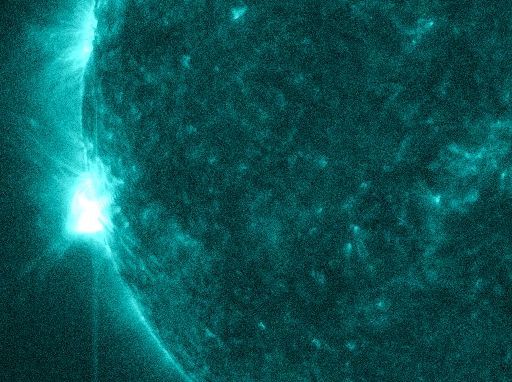  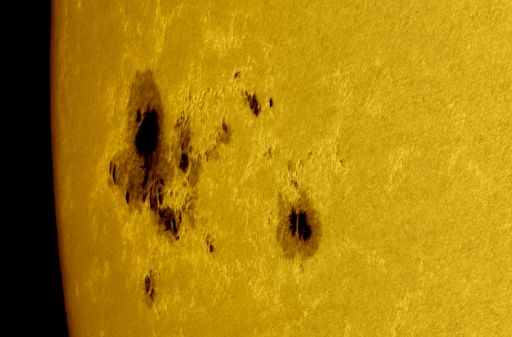 January 28, 2014 -Algol is at minimum brightness for a couple hours centered on 7:00 p.m. EST. In Wednesday's dawn, look for the eerily thin waning crescent Moon below Venus now. They're low in the southeast, as shown here. -China's moon rover, the Jade Rabbit, which made an historic landing in Sinus Iridum (the Bay of Rainbows) on Dec. 14th, is in trouble. Night is falling over the rover's landing site, and the rover should be going into hibernation to preserve power. China's space agency is reporting, however, that a "mechanical anomaly" may be interfering with the hibernation process. If so, the Jade Rabbit might not survive the extreme cold (-180 C) it is about to experience during two weeks of lunar night. Even if the rover fails, the mission is a success for China, which has joined the exclusive club of nations that have landed on the Moon. -Active sunspot AR1944, which produced many strong flares earlier this month, has returned from a two-week trip around the farside of the sun. It announced itself on Jan. 27th with an M4-class solar flare, shown here in an extreme UV image from the Solar Dynamics Observatory. According to tradition, sunspots that circle around the farside of the sun and re-appear are re-numbered. The new name of AR1944 is AR1967. That's how we shall refer to it from now on. Although AR1967 decayed during its absence, it is still potent. NOAA forecasters estimate a 5% chance of X-flares and a 50% chance of M-flares on Jan. 28th. Explosions probably won't be Earth-directed, however, because the active region is still near the sun's southeastern limb.   January 27, 2014 -In the dawn Tuesday morning the 28th, make a point to look low in the southeast to catch Venus with the waning crescent Moon to its right, as shown at lower right. A telescope shows that Venus too is a crescent! -The southeastern limb of the sun is crackling with C- and M-class solar flares. These explosions herald the return of old sunspot AR1944, which produced many strong flares earlier this month. For the past two weeks AR1944 has been transiting the farside of the sun. An uptick in solar activity is possible as it returns to the Earthside this week.  January 26, 2014 -This is the frigid time of year when the Little Dipper (mostly dim) hangs straight down from Polaris shortly after dark. Look due north. -Northern sunspot AR1957 has a 'beta-gamma' magnetic field that harbors energy for M-class solar flares. The region's persistant quiet, however, suggests the odds of an eruption are low. NOAA forecasters estimate a 15% chance of M-flares on Jan. 26th. -Yesterday, the students of Earth to Sky Calculus launched a suborbital helium balloon from Bishop, California, and recovered the payload hours later from a nearby canyon. The goal of the mission was to measure high-energy radiation levels in the stratosphere. Those data are being reduced now. The students also captured panoramic images of California's epic drought. So much for the Golden State. The landscape of California is remarkably brown as the driest winter in more than a century unfolds. The drought is so bad that the city of Bishop, where the students go to school, looks like a settlement on the planet Mars. Image is below. "Up and down California, from Oregon to Mexico, it's dry as a bone," comments JPL climatologst Bill Patzert. "To make matters worse, the snowpack in the water-storing Sierras is less than 20% of normal for this time of the year." Indeed, the towering Sierras, only sparsely covered by crusty month-old snow, lack their usual white reflectance in many of the group's edge of space photos. Not much water will be flowing from those peaks to urban areas when the snow melts in spring. Water rationing and wildfires are likely this summer.  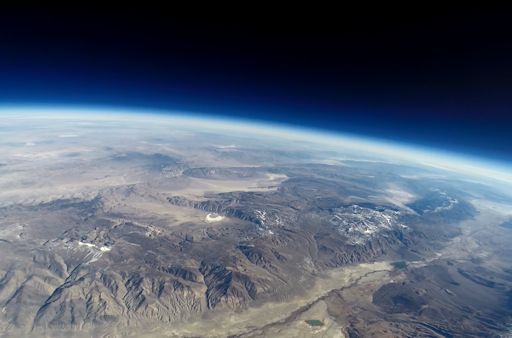  January 25, 2014 -Algol is at minimum brightness, magnitude 3.4 instead of its usual 2.3, for a couple hours centered on 10:09 p.m. EST. It takes several additional hours to fade and to rebrighten. -Jupiter's Great Red Spot transits Jupiter's central meridian around 11:01 p.m. EST. -With no sunspots actively flaring, the sun's x-ray output has flatlined. Solar activity is low and likely to remain so for the rest of the weekend. -The students of Earth to Sky Calculus are only hours away from launching another space weather balloon. The launch, slated for midday Pacific time on Jan. 25th, is the latest in a series of suborbital balloon missions designed to study the effects of solar activity on Earth's upper atmosphere. Today's flight samples a period of low solar activity, the opposite of their previous flight, which flew into the teeth of an S2-class solar radiation storm. The storm data they gathered on Jan. 8th is found below. The curve traces the amount of ionizing radiation encountered by the balloon during its 2 hour flight. During the ascent, an onboard x-ray/gamma-ray sensor measured doses 25 times greater than at ground level. The peak occured at the entrance to the stratosphere in a zone known as the "Pfotzer Maximum." Named after physicist George Pfotzer, who discovered the peak using balloons and Geiger tubes in the 1930s, the Pfotzer Maximum is produced by energetic particles hitting Earth's atmosphere, creating a spray of subatomic debris at high altitudes. The Earth to Sky campaign aims to find out, among other things, how the Pfotzer Maximum moves around in response to solar storms. This weekend's flight will repeat the Jan. 8th experiment using the same equipment while no solar radiation storm is in progress.  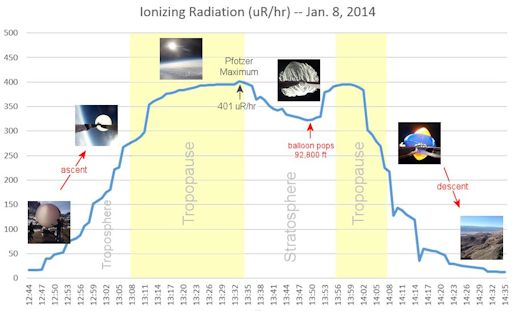 January 24, 2014 -Mercury has become easy to see; look for it low in the west-southwest as twilight fades. Don't confuse it with twinkly Fomalhaut off to its left in the southwest. Mercury is beginning its best evening apparition since last June for mid-northern skywatchers. -The Moon rises around 2 a.m. Saturday morning the 25th with Saturn glowing just 1° or 2° from it (as seen from the Americas). They're high in the south together by dawn, as shown here. January 23, 2014 -Last-quarter Moon tonight (exact at 12:19 a.m. Friday morning EST). The Moon rises around 1 a.m. local time. To its upper right is the Mars-Spica pair, and rising to its lower left more than an hour later is Saturn. By dawn on the 24th they're lined up horizontally in the south to southwest. -Jupiter's Great Red Spot transits around 9:23 p.m. EST. -On Tuesday January 21st astronomers first noticed an 11th-magnitude supernova in the galaxy M82 in Ursa Major. It's in the evening sky in reach of amateur telescopes, and it may not be done brightening yet. Leonard Ellul-Mercer photographed it from his observatory in Malta on Jan. 22nd. -Although it is 12 million light years away, M82 is considered to be a next-door neighbor of the Milky Way. Indeed, this is the nearest supernova to Earth since SN 1993J exploded 21 years ago. The relative proximity of the blast makes it an attractive target for astronomers to study. Light curves from previous supernovas of this type suggest that the fireball could continue to brighten for the next two weeks.  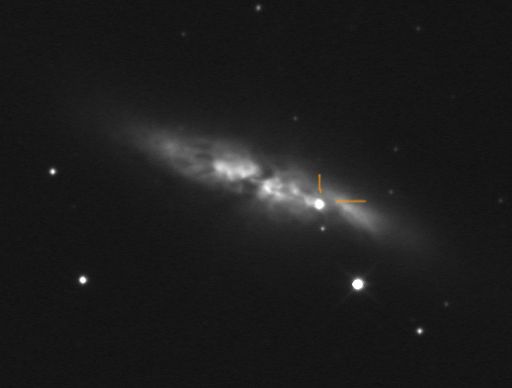 January 22, 2014 -The waning Moon rises around midnight tonight very close to Spica, with Mars shining to their upper left. By dawn on the 23rd they move over to the southwest, with Mars now to the Moon's upper right as shown above. -Algol is at minimum brightness, magnitude 3.4 instead of its usual 2.3, for a couple hours centered on 1:20 a.m. Thursday morning EST (10:20 p.m. Wednesday PST). Algol takes several additional hours to fade and to rebrighten. -For the past 24 hours, solar activity has been low. However, two sunspots facing Earth, AR1957 and AR1959, have 'beta-gamma' magnetic fields that harbor energy for M-class solar flares. NOAA forecasters estimate a 30% chance of M-flares on Jan. 22nd. -Earth is entering a stream of solar wind blowing almost 600 km/s (1.3 million mph), and this is sparking auroras around the Arctic Circle. Just after nightfall on Jan. 21st, Harald Albrigtsen photographed the display over Kvaløya, Tromsø, Norway. "I caught the auroras just before the clouds arrived," says Albrigtsen, "so it was a lucky shot." More lucky shots are possible on Jan. 23 when a CME is expected to deliver a glancing blow to Earth's magnetic field, adding to the effect of the solar wind stream already here.  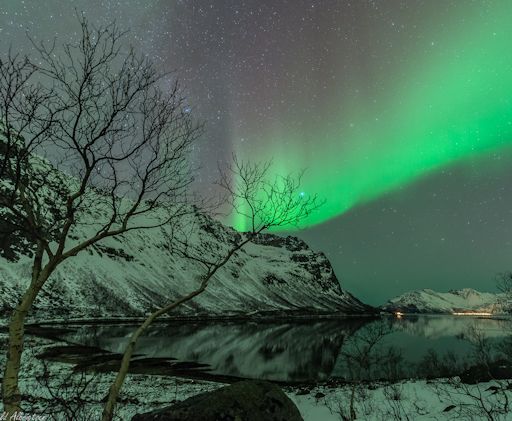 January 21, 2014 -The waning gibbous Moon rises around 11 tonight, then Mars and Spica follow up below it in the next hour and a quarter. By dawn Wednesday morning (the 22nd) the three are posing in the southwest, with Spica and Mars to the Moon's left and upper left as shown below. -Jupiter's Great Red Spot transits around 7:45 p.m. EST. -High-latitude auroras are possible on Jan. 21st when Earth crosses through a fold in the heliospheric current sheet. This is called a "solar sector boundary crossing," and NOAA forecasters estimate a 25% chance of polar geomagnetic storms when it occurs. -On Jan. 5th, Earth passed directly between the sun and Jupiter. Astronomers call this an "opposition" because the sun and Jupiter were on opposite sides of the sky. "Jupiter's opposition is always an opportunity for beautiful pictures of moons transiting Jupiter, sometimes directly in front of their own shadows," says John H. Rogers, Jupiter Section Director of the British Astronomical Association. "Observers have produced some fine examples from the opposition earlier this month." Some of the best are collected here.  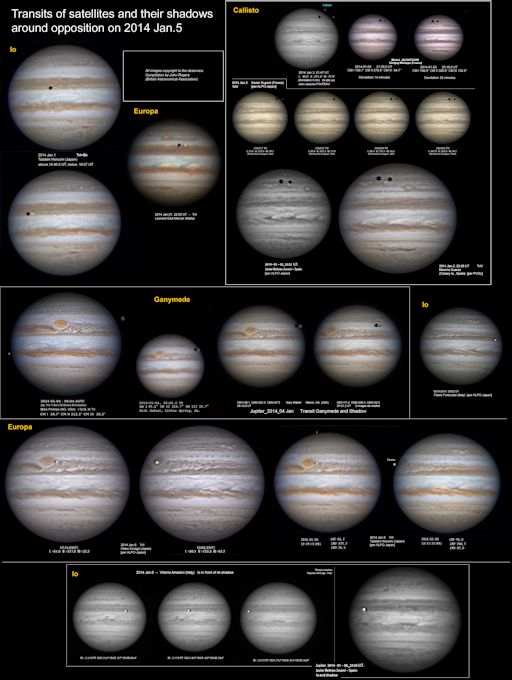 January 20, 2014 -Jupiter's moon Io crosses Jupiter's face from 8:07 to 10:22 p.m. EST, with its tiny black shadow (much more visible in a telescope) following 23 minutes behind. Later, Jupiter's Great Red Spot transits the planet's central meridian around 11:54 p.m. EST. -Venus (about magnitude –4.4) is now plain to see low in early dawn; look east-southeast. It too is becoming higher every day. -In a telescope Venus is a very thin, large crescent following its inferior conjunction on January 11th. January 19, 2014 -Sirius twinkles brightly after dinnertime below Orion in the southeast. Around 8 or 9 p.m., depending on your location, Sirius shines precisely below fiery Betelgeuse in Orion's shoulder. How accurately can you time this event for your location, perhaps using a plumb bob or the vertical edge of a building? Sirius leads early in the evening, Betelgeuse leads later. Welcome to pre-telescopic astronomy. -A phalanx of new sunspots rotating over the sun's southeastern limb was expected to boost solar activity this weekend. So far, however, the spots have not produced strong flares. Solar activity is low. January 18, 2014 -This the Big Dipper's time of year to swing up from the low north-northeast after dusk, to stand on its handle in the northeast by about 9 p.m. -Jupiter's Great Red Spot transits Jupiter's central meridian around 10:15 p.m. EST. -A minor CME expected to hit Earth's magnetic field on Jan. 17th is late, but NOAA forecasters still think it is coming. They estimate a 40% chance of polar geomagnetic storms on Jan. 18th in response to the tardy impact. High-latitude sky watchers should be alert for auroras. -Luminous halos around the Moon are nothing unusual, especially in wintertime Finland where the air is so often filled with ice. Crystals of frozen H2O catch the moonlight and bend it into a circular ring of light. A few nights ago, however, Sauli Koski of Muonio, Finland, witnessed a halo that was not circular, but elliptical. "On Jan. 15th, the weather changed. As the temperature dropped from -7C to -37C, there were all kinds of ice halos to photograph," says Koski. "The best and rarest were these elliptical forms that lasted more than 20 minutes." Although physicists have been studying ice halos for decades, not all are understood. "Elliptical halos are one of the puzzles," says atmospheric optics expert Les Cowley. " We can simulate them by invoking hexagonal plate-like crystals topped by almost flat pyramid faces. However, the simulations do not fit very well and such crystals are unphysical. Crystal facets like to form along planes where there are lots of atoms or molecules – almost flat pyramids do not fit the bill at all. Perhaps some peculiar distorted snowflake types instead?" "These mysteries all add to the spice of halo observing, the beautiful, the unexpected, the unexplained, something new!" -A sunspot approaching from just behind the sun's southeastern limb is crackling with solar flares. The explosions are registering C2 to C8 on the Richter Scale of Flares even though they are partially eclipsed by the edge of the sun. In Athens, Greece, amateur astronomer Peter Desypris photographed the flying debris from one of the explosions. "Indeed, something big appears to be on the way," says Desypris. The sun's rotation is slowly turning the active region toward Earth. During the weekend its core should emerge into plain view for a better evaluation of its flare-producing potential. Stay tuned for updates. 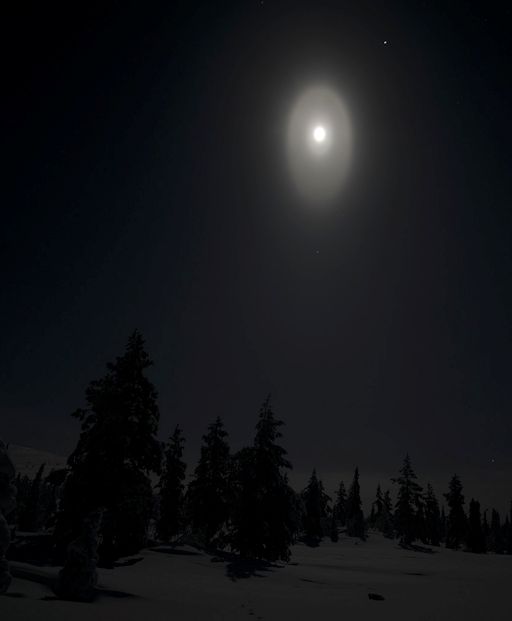 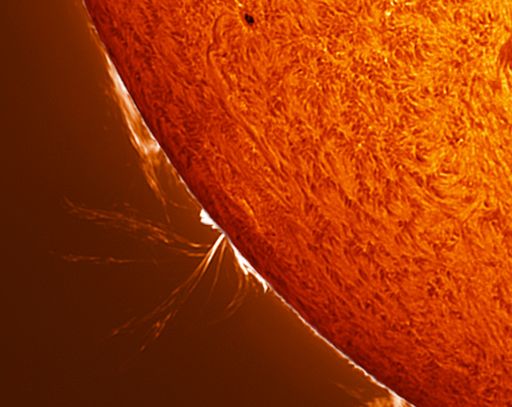 January 17, 2014 -As the stars come out, face north and look very high overhead for Cassiopeia, oriented now like a flattened letter M. As the night proceeds, the M swings down in the northwest and tilts sideways. -NOAA forecasters estimate a 35% chance of polar geomagnetic storms on Jan. 17th when a minor CME is expected to hit Earth's magnetic field. High-latitude sky watchers should be alert for moonlit auroras. -Winter is unfolding around the northern hemisphere. As temperatures drop, pillars of light are springing up from ground. Janis Satrovskis of Valmiera, Latvia, photographed this specimen on Jan. 14th. Light pillars are a common sight around northern cities in winter. Urban lights bounce off ice crystals in the air, producing tall luminous columns sometimes mistaken for auroras. Usually the ice crystals are natural, such as snow flakes, but in this case the atmospheric optics were artificial. "The amazing phenomenon was created by snow blowing machines," explains Satrovskis. "These are our first days with temperatures below zero and ski resorts are making snow. A slight breeze carried manmade snow over the city, creating a spectacular view." Light pillars are springing up in cold cities around the world. Is yours one of them? 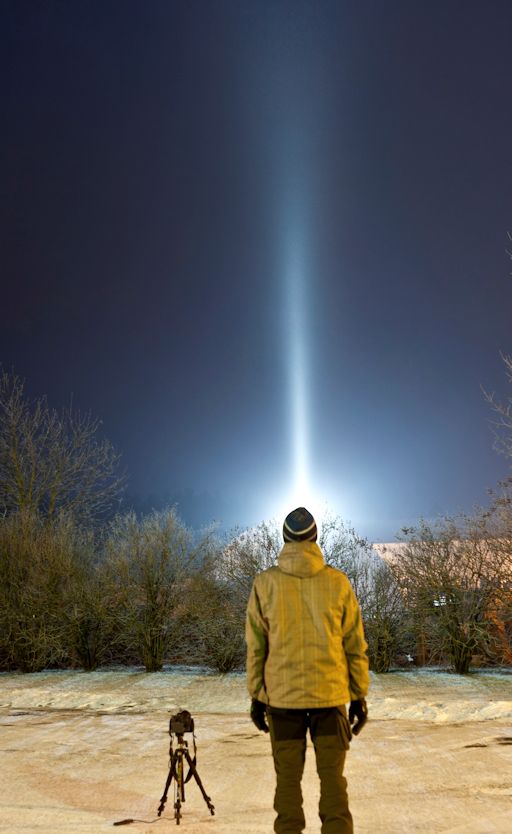 January 16, 2014 -As the Moon climbs up in the east, spot Procyon to its upper right, bright Jupiter higher above them, and Sirius far right of the Moon in the southeast, under Orion. -NOAA forecasters estimate a 35% chance of polar geomagnetic storms on Jan. 17th when a minor CME is expected to hit Earth. High-latitude sky watchers should be alert for auroras competing with bright moonlight. -Last night's full Moon was the smallest of the year, as much as 14% smaller and 30% dimmer than other full Moons of 2014. But could you tell the difference? When the Moon is high in the sky with no reference points nearby, a big Moon and a small Moon look much the same. To set the scale of the phenomenon, Karzaman Ahmad of the Langkawi National Observatory in Maylasia photographed last night's Moon and placed it alongside a photo of the largest Moon from 2013. "It really was smaller!" he says. -Full Moons vary in size and brightness because of the oval shape of the Moon's orbit. The Moon follows an elliptical path around Earth with one side ("perigee") about 50,000 km closer than the other ("apogee"). Last night's full Moon was a distant apogee Moon--less big and bright, but no less beautiful. 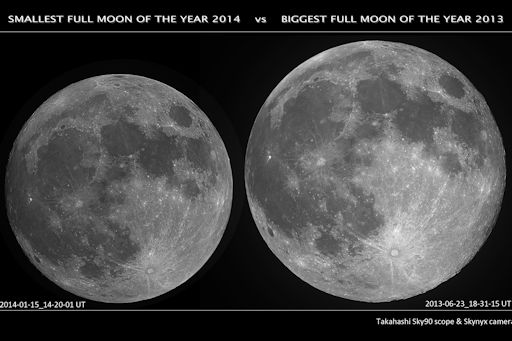 January 15, 2014 -Full Moon (exact at 11:52 p.m. EST). This is the smallest full Moon of 2014. Jupiter shines above it in early evening. As the evening grows late, Jupiter swings to the Moon's upper right. -Science teacher Tom Wagner of Waterloo, Iowa, is an avid photographer of snowflakes. Over the years he has discovered a great way to catch large flakes in mid-air: "I blow a soap bubble and allow the snowflake to land on it," he explains. Once the snowflake is properly corralled, the photography is relatively easy. Last week when the Polar Vortex descended over Iowa, Wagner went outdoors to capture some more snowflakes. Just one problem: It was so cold outside, the soap bubbles themselves froze. "I made a decision to photograph these frozen bubbles on the snow," says Wagner. "The sun was 20 minutes from setting so I had to act fast. Most of the bubbles popped when they landed but with some practice I discovered a technique that resulted in quite a few remaining intact." "After a few pictures at home I hurried over to a nearby cemetery where there was still several more minutes of direct sunlight. The men digging nearby must have wondered what I was doing blowing little bubbles onto the snow then lying next to them with my camera in hand. Having the sun in the immediate background illuminated the fern-like crystals growing within the curved bubble skin."  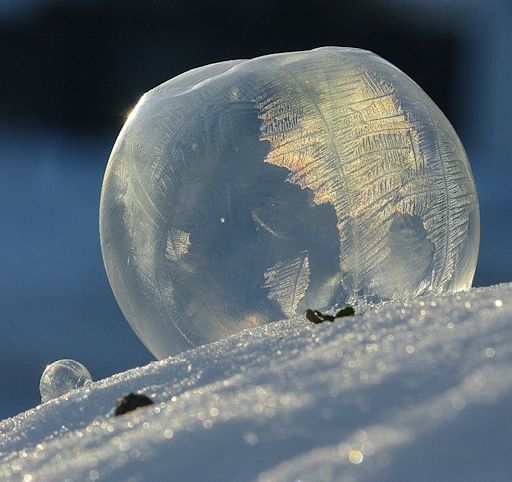 January 14, 2014 -Jupiter shines left of the nearly full Moon early this evening. Ganymede, the largest and brightest moon of Jupiter itself, slowly emerges out of eclipse from Jupiter's shadow around 10:21 p.m. EST. With a telescope, watch for this happening just off Jupiter's eastern limb. -NOAA forecasters have downgraded the chance of X-flares on Jan. 14th to 15% as giant sunspot AR1944 rotates off the solar disk. The odds on Jan. 15th are even lower: 1%. A spell of quiet appears to be in the offing. -When the sun goes down tonight, step outside and look east. The waxing full Moon is having a close encounter with Jupiter. Stojan Stojanovski sends this picture of the meeting from Velmej-Ohrid, Macedonia. -In Stojanovski's photo, the Moon has circumscribed Jupiter inside a luminous ring. It's a 22o halo, caused by ice crystals in high cirrus clouds. Lunar ice halos are most often seen when the Moon is high and bright. With Jupiter so close to the bulls-eye, tonight is a great time to look!  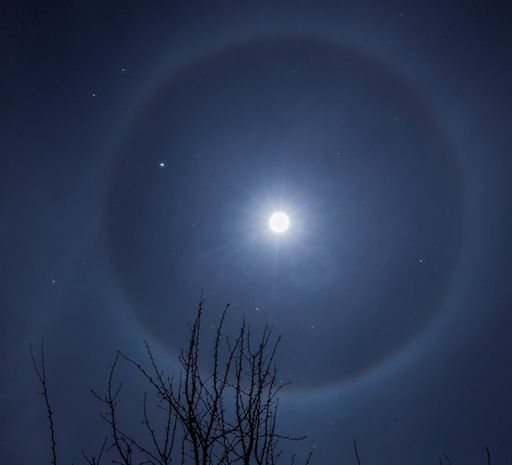 January 13, 2014 -Betelgeuse is lower right of the Moon this evening. Jupiter is to the Moon's lower left, with Pollux on beyond. Look far under the Moon for Procyon. -Blowing with gusts as fast as 800 km/s (1.8 million mph), a stream of solar wind is buffeting Earth's magnetic field. High-latitude sky watchers should be alert for auroras on Jan. 13th. -On Jan. 12th, a robotic arm on the ISS reached out and snagged another spaceship--Orbital Sciences Corporation's Cygnus cargo carrier. Cygnus reached the ISS on time despite a launch delay last Wednesday caused by stormy space weather. The docking on Sunday morning at 8:05 am EST marked the first successful contracted cargo delivery by Orbital Sciences. Only five hours before docking, the two spacecraft flew over the Netherlands where veteran satellite observer Marco Langbroek was waiting with his camera to take this picture. "The Cygnus cargoship was too faint to be seen by the naked eye for most of the pass, but around 5:57:05 UTC it briefly flared to mag +2 and the close duo ISS-Cygnus was suddenly and briefly well visible as a result," says Langbroek. "This picture shows the moment when the Cygnus flared." Cygnus delivered almost 2800 lbs of equipment and crew supplies to the space station. This includes dozens of new science experiments including 23 designed by students. One newly arrived investigation will study the behavior of ants in microgravity. Another will probe the decreased effectiveness of antibiotics during spaceflight--a possible problem for astronauts on long space journeys. Yet another will explore how different materials burn in microgravity to improve fire safety in future spacecraft. -Compare what Suspicious0bserver's mentioned about the fireball in his video today with the January 12 fireball orbital network, and see if there is any consistencies. On Jan. 12, 2014, the network reported 11 fireballs. (10 sporadics, 1 Canum Venaticid)  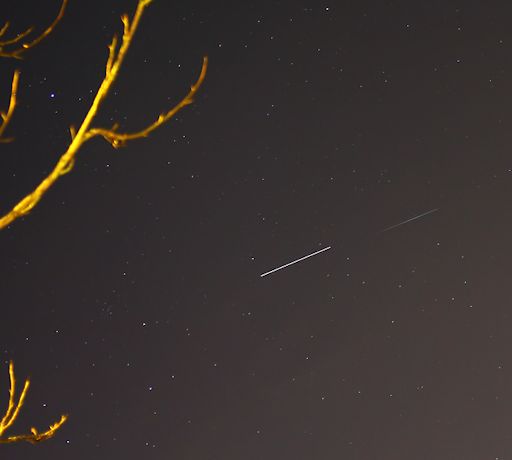  January 12, 2014 -Jupiter shines left of the nearly full Moon early this evening. Ganymede, the largest and brightest moon of Jupiter itself, slowly emerges out of eclipse from Jupiter's shadow around 10:21 p.m. EST. With a telescope, watch for this happening just off Jupiter's eastern limb. -NOAA forecasters estimate a 35% chance of X-class solar flares on Jan. 12th, most likely from AR1944. The brooding sunspot has been quiet for days, but still poses a threat for strong eruptions. -This weekend Venus is at inferior conjunction. That means it is passing almost directly between Earth and the sun. With its nightside facing Earth (almost perfectly), Venus looks like an incredibly slender crescent. On Jan. 11th in Targoviste, Romania, amateur astronomer Maximilian Teodorescu photographed Venus only 5 degrees from the sun. -"Taking extreme care not to point any unfiltered optics at the sun, I started to look for Venus through my 11-inch Celestron telescope," says Teodorescu. "The thin but very large crescent suddenly appeared into the field of view. It was surreal to watch the boiling atmospheric arc of the planet just above the sun in plain day. My wife immortalized the moment by taking a panoramic view from our clear-sky location." Observing Venus through a telescope can be dangerous. Even a quick inadvertent glimpse of magnified light from the nearby sun can cause serious eye damage. Anthony J. Cook of the Griffith Observatory has some advice for observers: "I have observed Venus at conjunction, but only from within the shadow of a building, or by adding a mask to the front end of the telescope to fully shadow the optics from direct sunlight. This is tricky with a refractor or a catadioptric, because the optics start at the front end of the tube. Here at Griffith Observatory, I rotate the telescope dome to make sure the lens of the telescope is shaded from direct sunlight, even through it means that the lens will be partially blocked when aimed at Venus. With our Newtonian telescope, I add a curved cardboard mask at the front end of the tube to shadow the primary mirror." Around the world, many people are applying these techniques to photograph Venus as it passes by the sun.  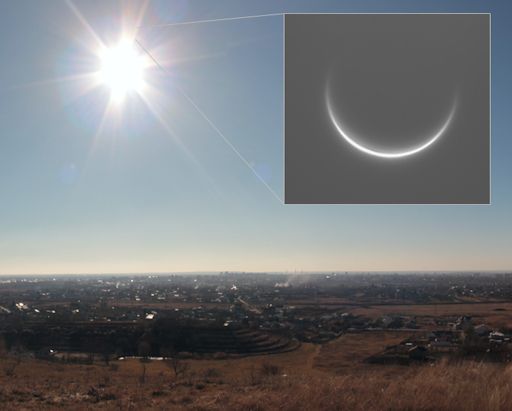 January 11, 2014 -Aldebaran shines below the Moon at dusk, as shown here. It swings around to the left of the Moon by about 11 p.m. -Jupiter’s Great Red Spot transits Jupiter’s central meridian around 9:30 p.m. EST. -Venus is at inferior conjunction, passing 5° north of the Sun today. -NOAA forecasters estimate a 35% chance of X-class solar flares on Jan. 11th. The likely source would be AR1944. The brooding sunspot has been quiet for days, but still poses a threat for strong eruptions. -The payload of a space weather balloon launched Jan. 8th by the students of Earth to Sky Calculus has been recovered from its landing site in Death Valley National Park. The purpose of the flight was to study a solar radiation storm in progress at the time of the launch. Analyzing the data may take a few days. These pictures were taken by a pair of Hero3+ cameras looking out of the payload capsule. The upper frame shows the Sierra Nevada mountain range, unusually brown for this time of year as California endures a historic drought. The lower frame captures the balloon popping at an altitude of approximately 100,000 feet. Click on each frame for a closer look. The landscape shot was made using the Hero3+'s new "superview mode"--a favorite of snowboarders and now, for the first time, balloonists! In addition to cameras, the payload contained an x-ray/gamma-ray dosimeter, a GPS altimeter, and a cryogenic thermometer. Together these instruments can form a complete thermal and radiation profile of the atmosphere throughout the flight. The students plan to pay special attention to data collected at aviation altitudes to learn how much radiation air travelers absorb during periods of high solar activity.  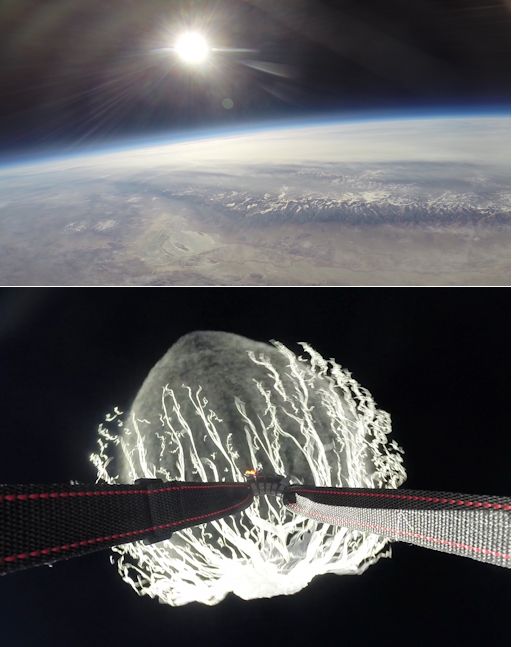 January 10, 2014 -Look left of the Moon at nightfall for the Pleiades, as shown here. The Pleiades are straight above the Moon by about 8 or 9. -Bright Capella high overhead and bright Rigel in Orion's foot, both magnitude 0, have almost the same right ascension — so they cross your sky’s north-south meridian at almost the same time. Capella passes closest to straight overhead around 10 p.m., depending on how far east or west you live in your time zone. (It goes exactly through the zenith if you're at latitude 46° north: Portland, Oregon; Montreal; central France.) So, when Capella is passing closest to the zenith, Rigel always marks true south over your landscape. -Giant sunspot AR1944 has not unleashed a significant flare in more than 48 hours. The growing quiet could be the calm between storms. AR1944 has an unstable 'beta-gamma-delta' magnetic field that harbors energy for X-class flares. -As predicted, a CME hit Earth's magnetic field on Jan. 9th (20:00 UT). The impact was weaker than expected, however, and it failed to produce widespread geomagnetic storms. Nevertheless, some beautiful auroras appeared around the Arctic Circle. Harald Albrigtsen sends this picture from Tromsø, Norway. It was dark in Norway when the CME arrived, so observers there witnessed a nice display. By the time night fell over North America, however, the lights had faded. US observers saw nothing remarkable. More auroras are possible on Jan. 10th as Earth passes through the magnetic wake of the CME. NOAA forecasters estimate a 85% chance of polar geomagnetic storms before the day is over.   January 9, 2014 -A large coronal mass ejection (CME) from the Sun should start hitting Earth's magnetosphere around 8:00 UT January 9th (3 a.m. EST, midnight PST). -The CME comes from a big sunspot region that's currently visible to the unaided eye through a safe solar filter or a #14 rectangular arc-welder's filter. -NOAA forecasters estimate a 90% chance of geomagnetic storms on Jan. 9th when a CME is expected to hit Earth's magnetic field. The speed of the solar wind around Earth could spike to 700 km/s (1.6 million mph) shortly after the impact, sharply compressing Earth's magnetosphere. High-latitude sky watchers should be alert for auroras. -Venus is turning its night side toward Earth as it approaches inferior solar conjunction on Jan. 11th. Less than 1% of Venus's sunlit hemisphere is now facing us, which means the planet looks like a razor-thin crescent. If you have a GOTO telescope, command it to slew to Venus. It's visible even in broad daylight. -Shahrin Ahmad of Sri Damansara, Malaysia, took these pictures on Jan. 2nd, 6th and 8th using a 4.5 inch telescope. "It us very interesting to see how fast Venus changes in only 6 days! Today the thinning crescent is only 0.7% illuminated at a distance of 7o from the sun." 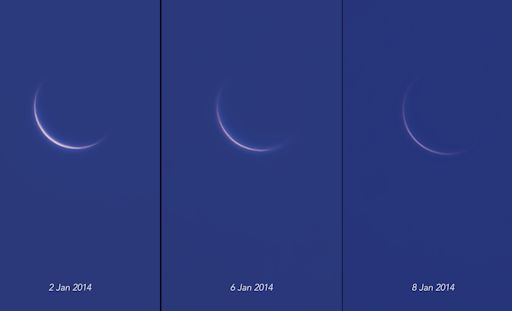 January 8, 2014 -Jupiter’s moon Europa crosses Jupiter’s face from 6:47 to 9:29 p.m. EST, with its shadow following just 10 minutes behind. -Giant sunspot AR1944 is directly facing Earth and crackling with solar flares. Yesterday, Jan. 7th, an X1-class explosion in the sunspot's magnetic canopy hurled a CME in our direction. High-latitude sky watchers shoud be alert for auroras on Jan. 9th when the cloud is expected to arrive. NOAA forecasters estimate a 60% chance of polar geomagnetic storms. -The X1-flare that hurled the CME toward Earth also accelerated a swarm of high-energy protons in our direction. Effects of the proton fusillade are visible in this Jan. 7th coronagraph movie from the Solar and Heliospheric Observatory (SOHO). -The "snow" in this movie is caused by solar protons striking the spacecraft's CCD camera. A veritable blizzard of speckles develops as the CME emerges into full view. Indeed, many of the protons are accelerated by shock waves at the forefront of the expanding cloud. This ongoing radiation storm ranks S2 on NOAA storm scales. It is rich in "hard" protons with more than 100 MeV of energy, which accounts for the snowiness of the SOHO coronagraph images. According to NOAA, "passengers and crew in high-flying aircraft at high latitudes may be exposed to elevated radiation risk" during such a storm. The source of all this activity is AR1944, one of the biggest sunspots of the past decade. The sprawling active region is more than 200,000 km wide and contains dozens of dark cores. Its primary core, all by itself, is large enough to swallow Earth three times over. To set the scale of the behemoth, Karzaman Ahmad inserted a picture of Earth in the corner of this picture he took on Jan. 7th from the Langkawi National Observatory in Malaysia. -More flares are in the offing. The sunspot has an unstable 'beta-gamma-delta' magnetic field that is likely to erupt again today. NOAA forecasters estimate an 80% chance of M-class flares and a 50% chance of X-flares on Jan. 8th. 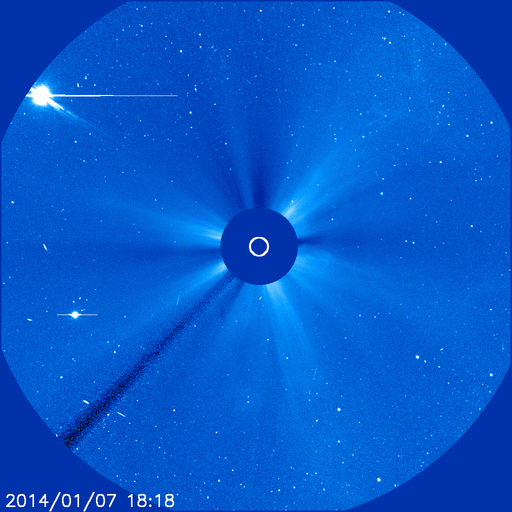 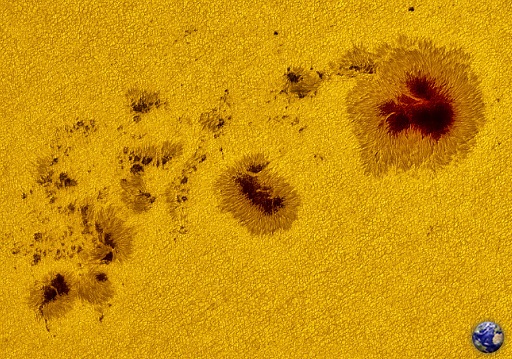 January 7, 2014 -First-quarter Moon (exact at 10:39 p.m. EST). Look to the right of the Moon this evening for the Great Square of Pegasus, tipped up onto one corner. The main line of Andromeda’s stars extends up from its top. -NOAA forecasters estimate a 70% chance of polar geomagnetic storms on Jan. 7th when a CME is expected to deliver a glancing blow to Earth's magnetic field. The CME was hurled in our direction by an M4-class explosion from giant sunspot AR1944 on Jan. 4th. High latitude sky watchers should be alert for auroras. -One of the biggest sunspots in years is crossing the center of the solar disk, putting Earth in the way of potential eruptions. Rocky Raybell photographed the active region named "AR1944" yesterday from his backyard in Keller, Washington. -The sprawling sunspot contains dozens of dark cores, the largest big enough to swallow Earth three times over. This makes it an easy target for amateur solar telescopes. Raybell used a backyard 'scope capped with a Baader solar filer to capture both the sunspot and trees in the foreground. 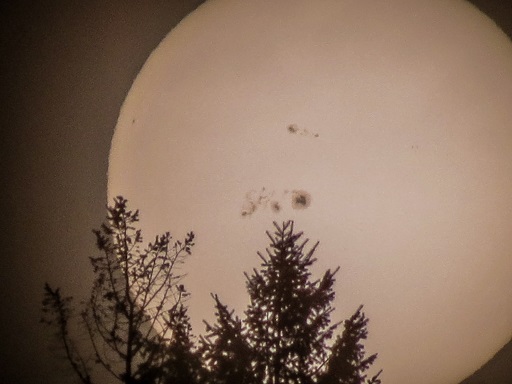 January 6, 2014 -Jupiter’s Great Red Spot crosses the planet’s central meridian around 9:53 p.m. EST. One of the largest sunspots in years, AR1944, is turning toward Earth. The active region contains dozens of dark cores, the largest of which is big enough to swallow three planet Earths. It's so big, sky watchers are noticing it as a blemish on the solar disk at sunset. "Sunspot AR1944 was visible without using a solar telescope," reports Eddie Irizarry of Rincon, Puerto Rico, who took this picture at the end of the day on Jan. 5th. "Proper filters and extreme care should be taken when photographing the sun," he adds. "Unfiltered sunlight magnified by optics can cause serious eye damage." Astronomers who have a safe solar telescope are encouraged to take a closer look. "AR1944 has to be the most awesome sunspot ever," says Sergio Castillo of Inglewood, CA. "I cannot stop photographing it." His latest image from Jan. 5th is shown below. Castillo used a telescope capped with a "Calcium K" filter. Calcium K filters, which are sensitive to the blue glow of calcium ions in the sun's lower atmosphere, highlight the bright magnetic froth that often forms around a sunspot's dark cores. AR1944 is very frothy indeed. Magnetic froth does not necessarily herald an explosion, but it does guarantee a photogenic sunspot. 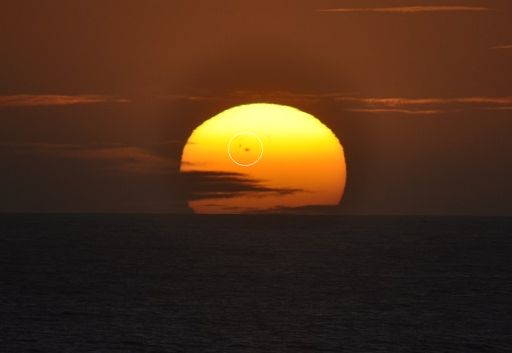  January 5, 2014 -Jupiter is at opposition. All week it’s at its biggest and brightest for 2014. -Algol in Perseus, the prototype eclipsing binary star, should be in one of its periodic dimmings, magnitude 3.4 instead of its usual 2.1, for a couple hours centered on 8:24 p.m. EST. Algol takes several additional hours to fade and to rebrighten. -Giant sunspot AR1944 has developed a 'beta-gamma-delta' magnetic field that harbors energy for potent Earth-directed eruptions. NOAA forecasters estimate a 75% chance of M-class flares and a 30% chance of X-flares on Jan. 5th. -I have also included my own photos of the sunspot simply by pointing a DSLR at the sun with a 300mm lens and a neutral density filter. -A coronal mass ejection (CME) might be heading for Earth. The cloud blasted away from the sun during the late hours of Jan 4th following a long-duration M4-class solar flare from big sunspot AR1944. SOHO (the Solar and Heliospheric Observatory) recorded the explosion. -The assymetric CME could deliver a glancing blow to Earth's magnetic field in two or three days, possibly sparking polar geomagnetic storms. NOAA analysts are still processing the CME imagery for a more precise forecast. -Venus is turning its night side toward Earth as it approaches inferior solar conjunction on Jan. 11th. Less than 2% of Venus's sunlit hemisphere is now facing us, which means the planet looks like a razor-thin crescent. If you have a GOTO telescope, command it to slew to Venus. It's visible even in broad daylight. -Amateur astronomer Steven Bellavia of New York took the picture at noon on Jan. 4th using a Celestron C5 telescope. "This is the finest crescent Venus I have ever been able to photograph," he says. Observers who wish to try this for themselves can find Bellavia's photo details here. Be careful, though, because Venus is only 11o from the blinding sun. 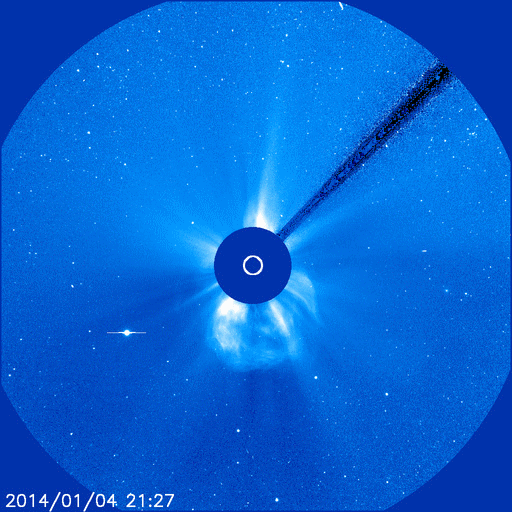   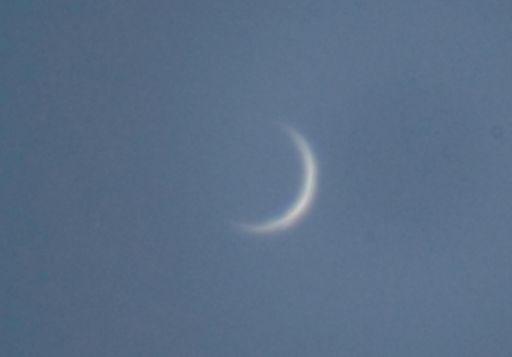 January 4, 2014 -Soon after dark, Sirius, the Dog Star, rises below Orion. And Procyon, the Little Dog Star, rises to the lower right of bright Jupiter. Which of them comes up first? It's Procyon if you're north of latitude 30° (Tijuana, New Orleans, Jacksonville), and Sirius if you're south of there. Hint: "Procyon" means "Before the Dog." That tells you something about where its namers lived. -Sunspot AR1944, which appeared on January 1st, is one of the largest sunspots of the current solar cycle. It's so big, people are noticing it as a naked-eye blemish on the solar disk. Daisuke Tomiyasu sends this picture from Higashinada-ku, Kobe, Hyogo, Japan. "Sunspot 1944 was visible at sunrise on January 4th," says Tomiyasu. "I combined three exposures of 1/15sec, 1/100sec, and 1/640sec to create this HDR (high dynamic range) image." Although the sunspot has been relatively quiet and stable since it first appeared on New Year's Day, a region of this size has the potential to produce significant activity. Indeed, NOAA forecasters, who say they are keeping a close eye on this behemoth, estimate a 75% chance of M-flares and a 30% chance of X-flares on Jan. 4th.  January 3, 2014 -Newly-discovered asteroid 2014 AA hit Earth's atmosphere on Jan. 2nd. The space rock, about the size of a small car, disintegrated over the Atlantic Ocean about 3,000 km east of Caracas, Venezuela. Infrasound records interpreted by Peter Brown of the University of Western Ontario suggest an impact energy between 500 and 1,000 tons of TNT. That's a lot of dynamite; nevertheless, in cosmic terms this was a relatively minor impact that did no damage to our planet. -After sunset, look far to the lower right of the waxing crescent Moon for Venus, dropping lower every day. How many more days can you keep Venus in view? It will reach inferior conjunction, 5° north of the Sun, on January 11th. -Venus (magnitude –4 or –3) is dropping to the southwest horizon after sunset. It passes through inferior conjunction, 5° north of the Sun, on January 11th. Seen with optical aid it's a hairline crescent a mere 2% sunlit or less. But it's big! About 60 arcseconds in diameter. -Sunspot AR1944, which emerged over the sun's eastern limb on Jan. 1st, is big and potentially dangerous. The complex region contains more than a dozen dark cores, and the leading spot is big enough to swallow two planet Earths all by itself. AR1944 is so large, sky watchers on Earth are beginning to notice it as a blemish on the solar disk at sunset. "This was my first sunset shot of the year," says photographer Raymund Sarmiento of Quezon City, the Philippines. "AR1944 is circled. That sunspot has the potential to disrupt transmission/reception of radio signals on the foreground antenna." Indeed, the sunspot has a 'beta-gamma' magnetic field that harbors energy for strong eruptions. NOAA forecasters estimate a 75% for M-flares and 30% for X-flares on Jan. 3rd. The effect of any flares today will be mitigated by the fact that the sunspot is not yet directly facing Earth. However, even an off-center blast from this behemoth could produce radio blackouts and geomagnetic activity. Stay tuned for developments. -For the second day in a row, a solar wind stream is buffeting Earth's magnetic field, sparking intermittant geomagnetic storms and auroras around the Arctic Circle. Last night, Northern Lights tour guide Chad Blakley photographed a luminous green vortex over Sweden's Abisko National Park. "Tonight was one of those nights that makes being an aurora photographer the best job in the world," says Blakley. "The lights started around 5:00 PM and continued well into the night. I had the pleasure of spending the evening with Peter Richards, a representative of National Geographic student photography expeditions. At one point during our night under the stars I heard him say that the display was the most amazing thing he had ever seen in his life - I couldn't agree more!" 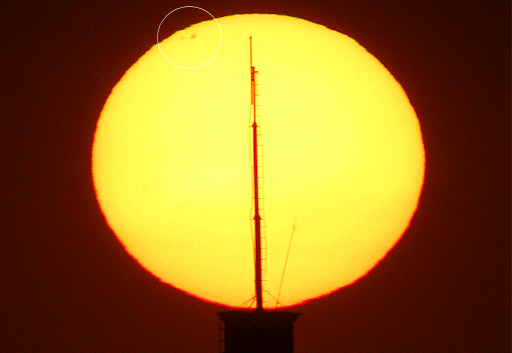 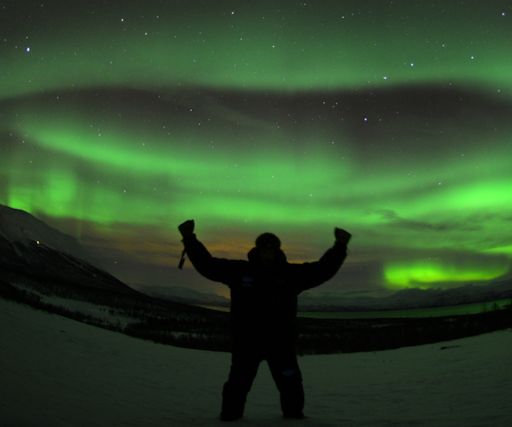 January 2, 2014 -As twilight starts to fade, look for the thin crescent Moon (24 hours older now, much easier than yesterday) above Venus low in the southwest, as shown at right. Venus too is a (tiny) crescent. The two crescents face almost the same way toward their light source, the Sun. (In parts of western North America a telescope may show the Moon's dark, Earthlit limb occulting Beta Capricorni, but the Moon will be very low and the observation difficult.) -The brief Quadrantid meteor shower is predicted to peak around 19h or 20h UT (11 a.m. or noon Pacific Standard Time). This is good timing for the eastern half of Asia but broad daylight in North America. By one prediction, however, the Quads may come a few hours early and be active before dawn for the West Coast. -Use the waxing Moon to find Venus very low now after sunset. (The Moon, shown three times life size, is positioned as seen from the middle of North America.) -2014 began with a bang. At 18:54 UT on January 1st, big sunspot AR1936 erupted, producing a strong M9-class solar flare. NASA's Solar Dynamics Observatory captured the explosion's extreme ultraviolet flash. -The movie shows a dark filament of plasma racing away from the blast site, but most of the material fell back to the stellar surface. Nevertheless, the explosion did produce a CME that could deliver a glancing blow to Earth's magnetic field later this week. NOAA analysts are still evaluating this possibility. -The M9-flare of New Year's Day followed close on the heels of an M6-flare on New Year's Eve. Sunspot AR1936 produced both explosions. The New Year's Eve event produced a minor, slow-moving CME that is not expected to disturb Earth's magnetic field if and when it does arrive. -Sunspot AR1936 is active, but new sunspot AR1944 looks even more potent. The behemoth active region emerged over the sun's southeastern limb on Jan 1st. -Because of foreshortening near the sun's limb, the complexity of AR1944's magnetic field is still unknown. The sheer size of the sunspot, however, suggests it is capable of strong flares. The emergence of AR1944 combined with the ongoing activity from AR1936 has prompted NOAA forecasters to raise the odds of eruptions on Jan. 2nd to 70% for M-flares and 30% for X-flares.  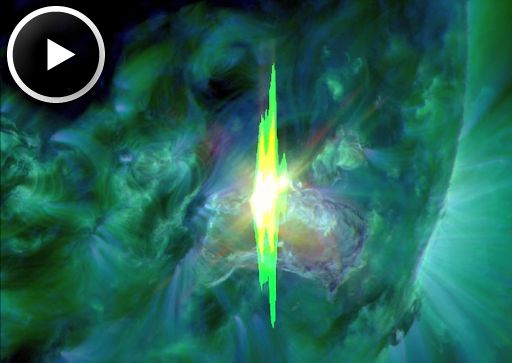 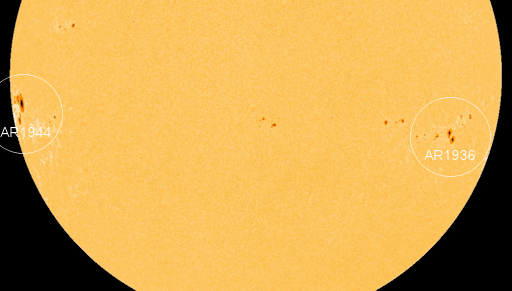 January 1, 2014 -New Moon (exact at 6:14 a.m. EST). -Shortly after the Sun sets, in central and western North America you can try to spot what will almost certainly be your personal record-young crescent Moon, perhaps for the rest of your life. An extremely thin trace of the Moon will be almost straight above the sunset point — and conveniently for locating it, 8° to 9° lower right of Venus. And the Moon is at perigee. -The sighting will probably be impossible from the East Coast, where the Moon will be just 11 hours old and only 7° from the Sun a half hour after sunset. But it might be possible through a telescope in the Central time zone if the air is very clear. It should be possible with binoculars on the West Coast, where the Moon will be approximately 14 hours old and 8.5° from the Sun. Figure its age from the time of new Moon: 11:14 UT (3:14 a.m. Pacific Standard Time). -Go out early to mark where the Sun sets, then set up your equipment and start watching no more than 15 minutes after sundown. Keep watching for another 25 minutes to catch your window of best visibility, which will depend on your location and atmospheric conditions. This article has some great information on how to spot the extremely thin crescent: http://www.skyandtelescope.com/obser...s/3308686.html -2013 ended with a bang. At 21:58 UT on Dec. 31st, sunspot AR1936 erupted, producing a strong M6-class solar flare. NASA's Solar Dynamics Observatory recorded the extreme ultraviolet flash. Amateur images of the explosion show a dark filament of plasma flying away from the blast site. Indeed, the explosion probably hurled a coronal mass ejection (CME) into space. The putative CME could deliver a glancing blow to Earth's magnetic field later this week. We'll find out more about this possibility when coronagraph data from SOHO and STEREO reach Earth. Stay tuned. Meanwhile, more flares are in the offing. Sunspot AR1936 has a 'beta-gamma-delta' magnetic field that harbors energy for strong eruptions. NOAA forecasters estimate a 40% chance of M-class flares and a 10% chance of X-flares on Jan. 1st. 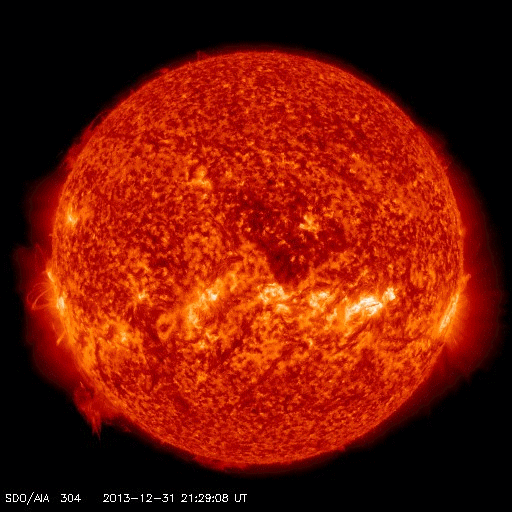 Astro Pic of the Day Archive January 1, 2014 - January 1, 2014 May 31, 2014  This clear night skyscape captures the colorful glow of aurora australis, the southern lights, just outside the port city of Hobart, Tasmania, Australia, planet Earth. As if staring into the dreamlike scene, the Tasmanian Earth Resources Satellite Station poses in the center, illuminated by nearby city lights. Used to receive data from spacebased Earth observing instruments, including NASA's MODIS and SeaWiFS, the station was decommissioned in 2011 and dismantled only recently, shortly after the picture was taken on April 30. Still shining in southern skies though, the central bulge of our Milky Way galaxy and two bright satellite galaxies the Large and Small Magellanic Clouds appear in the frame. The Small Magellanic Cloud shines through the fainter red auroral band. May 30, 2014  The gorgeous, gaseous shroud of a dying sunlike star, planetary nebula Abell 36 lies a mere 800 light-years away in the constellation of Virgo. At that distance it spans over 1.5 light-years in this sharp telescopic view. Shrugging off its outer layers, the nebula's central star is contracting and becoming hotter, evolving towards a final white dwarf phase. In fact, in Abell 36, the central star is estimated to have a surface temperature of over 73,000 K, compared to the Sun's present 6,000 K temperature. As a result, the intensely hot star is much brighter in ultraviolet light, compared to its visual appearance here. The invisible ultraviolet light ionizes hydrogen and oxygen atoms in the nebula and ultimately powers the beautiful visible light glow. May 29, 2014 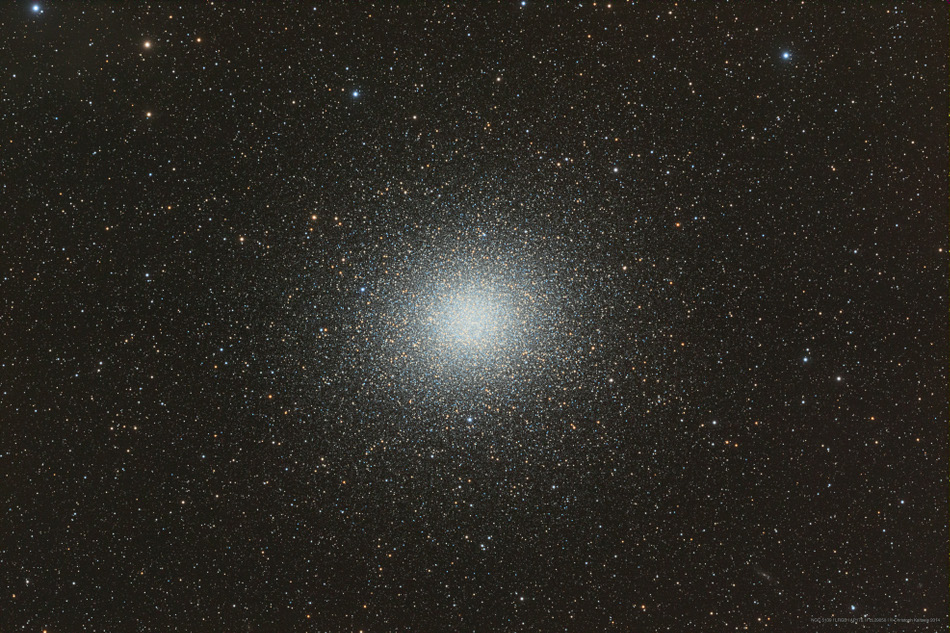 Globular star cluster Omega Centauri, also known as NGC 5139, is some 15,000 light-years away. The cluster is packed with about 10 million stars much older than the Sun within a volume about 150 light-years in diameter, the largest and brightest of 200 or so known globular clusters that roam the halo of our Milky Way galaxy. Though most star clusters consist of stars with the same age and composition, the enigmatic Omega Cen exhibits the presence of different stellar populations with a spread of ages and chemical abundances. In fact, Omega Cen may be the remnant core of a small galaxy merging with the Milky Way. This astronomically sharp color image of the classic globular cluster was recorded in March under Chilean skies from Hacienda Los Andes. May 28, 2014  Stars are forming in the gigantic dust pillar called the Cone Nebula. Cones, pillars, and majestic flowing shapes abound in stellar nurseries where natal clouds of gas and dust are buffeted by energetic winds from newborn stars. The Cone Nebula, a well-known example, lies within the bright galactic star-forming region NGC 2264. The Cone was captured in unprecedented detail in this close-up composite of several observations from the Earth-orbiting Hubble Space Telescope. While the Cone Nebula, about 2,500 light-years away in Monoceros, is around 7 light-years long, the region pictured here surrounding the cone's blunted head is a mere 2.5 light-years across. In our neck of the galaxy that distance is just over half way from the Sun to its nearest stellar neighbor, the Alpha Centauri star system. The massive star NGC 2264 IRS, seen by Hubble's infrared camera in 1997, is the likely source of the wind sculpting the Cone Nebula and lies off the top of the image. The Cone Nebula's reddish veil is produced by glowing hydrogen gas. May 27, 2014  What's happening at the center of this nebula? Sculpted by stellar winds and radiation, the star factory known as Messier 17 lies some 5,500 light-years away in the nebula-rich constellation Sagittarius. At that distance, this degree wide field of view spans almost 100 light-years. The sharp, composite, color image utilizing data from space and ground based telescopes, follows faint details of the region's gas and dust clouds against a backdrop of central Milky Way stars. Stellar winds and energetic light from hot, massive stars formed from M17's stock of cosmic gas and dust have slowly carved away at the remaining interstellar material producing the cavernous appearance and undulating shapes. M17 is also known as the Omega Nebula or the Swan Nebula. May 26, 2014 It is the most expensive and complex ground-based astronomy project ever -- what will it see tonight? The Atacama Large Millimeter Array (ALMA) project consists of 66 dishes, many the size of a small house, situated in the high altitude Atacama Desert in Northern Chile. Together, ALMA observes the skies in high-frequency radio light, a band usually used only for local communication due to considerable absorption by humid air. The thin atmosphere and low humidity above ALMA, however, enable it to see deep into our universe in new and unique ways that allow, for example, explorations of the early universe for chemicals involved in star formation, and observing local star systems for signs of disks that form planets. The above time-lapse video shows the course of four ALMA antennas over one night. The Moon sets early in the video, while three dishes repoint in unison. Background stars continually rotate up, the central band of our Milky Way Galaxy pivots around and eventually exits off to the right, while halfway through the Small and Large Magellanic Clouds -- satellite galaxies near our Milky Way -- rise up from below the horizon. Car headlights momentarily illuminate the dishes, while an occasional Earth-orbiting satellite crosses overhead. Daylight ends the video but not ALMA observations -- which typically run both all night and all day. May 25, 2014  From a camp on the northern shores of the Great Lake Erie, three short bright meteor streaks were captured in this composited night skyscape. Recorded over the early morning hours of May 24, the meteors are elusive Camelopardalids. Their trails point back to the meteor shower's radiant near Polaris, in the large but faint constellation Camelopardalis the camel leopard, or in modern terms the Giraffe. While a few meteors did appear, the shower was not an active one as the Earth crossed through the predicted debris trail of periodic comet 209P/LINEAR. Of course, the long bright streak in the image did appear as predicted. Early on May 24, the International Space Station made a bright passage through northern skies. May 24, 2014 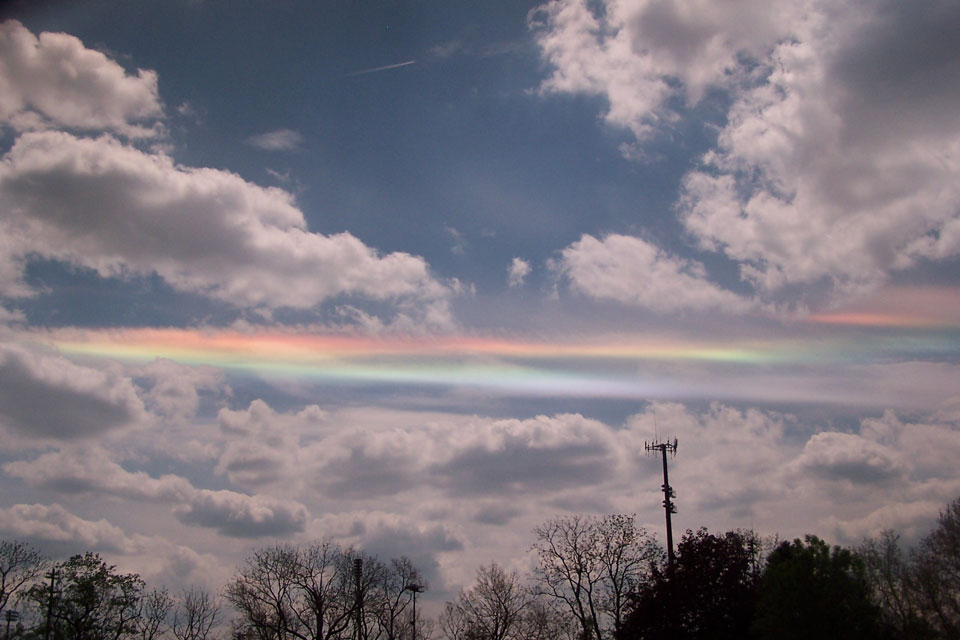 Why would clouds appear to be different colors? The reason here is that ice crystals in distant cirrus clouds are acting like little floating prisms. Sometimes known as a fire rainbow for its flame-like appearance, a circumhorizon arc lies parallel to the horizon. For a circumhorizontal arc to be visible, the Sun must be at least 58 degrees high in a sky where cirrus clouds are present. Furthermore, the numerous, flat, hexagonal ice-crystals that compose the cirrus cloud must be aligned horizontally to properly refract sunlight in a collectively similar manner. Therefore, circumhorizontal arcs are quite unusual to see. This circumhorizon display was photographed through a polarized lens above Dublin, Ohio in 2009. May 23, 2014 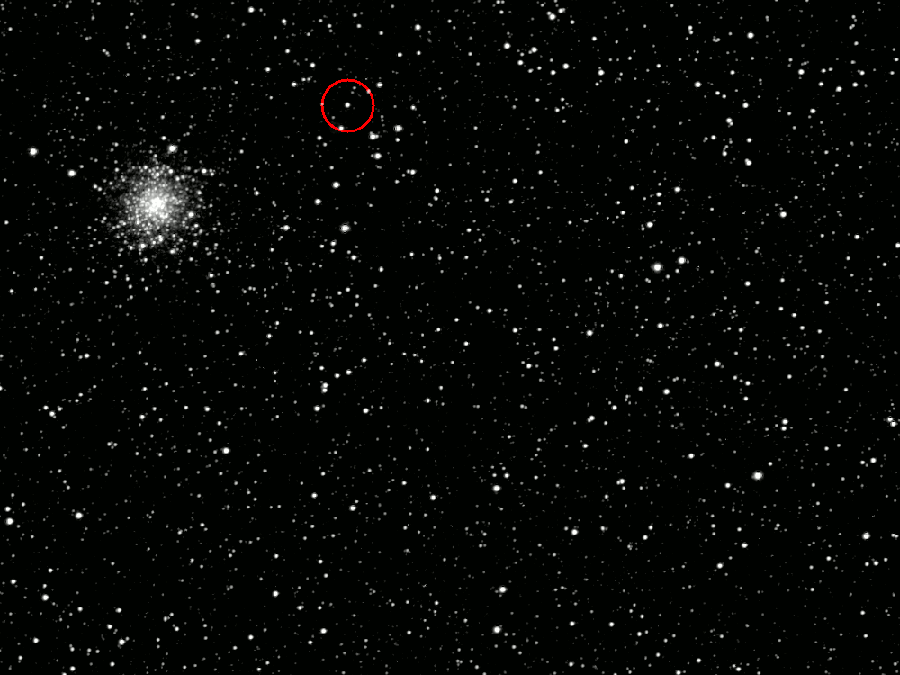 The Rosetta spacecraft captured this remarkable series of 9 frames between March 27 and May 4, as it closed from 5 million to 2 million kilometers of its target comet. Cruising along a 6.5 year orbit toward closest approach to the Sun next year, periodic comet 67P/Churyumov-Gerasimenko is seen moving past a distant background of stars in Sagittarius and gobular star cluster M104. The comet's developing coma is actually visible by the end of the sequence, extending for some 1300 km into space. Rosetta is scheduled for an early August rendezvous with the comet's nucleus. Now clearly active, the nucleus is about 4 kilometers in diameter, releasing the dusty coma as its dirty ices begin to sublimate in the sunlight. The Rosetta lander's contact with the surface of the nucleus is anticipated in November. May 22, 2014 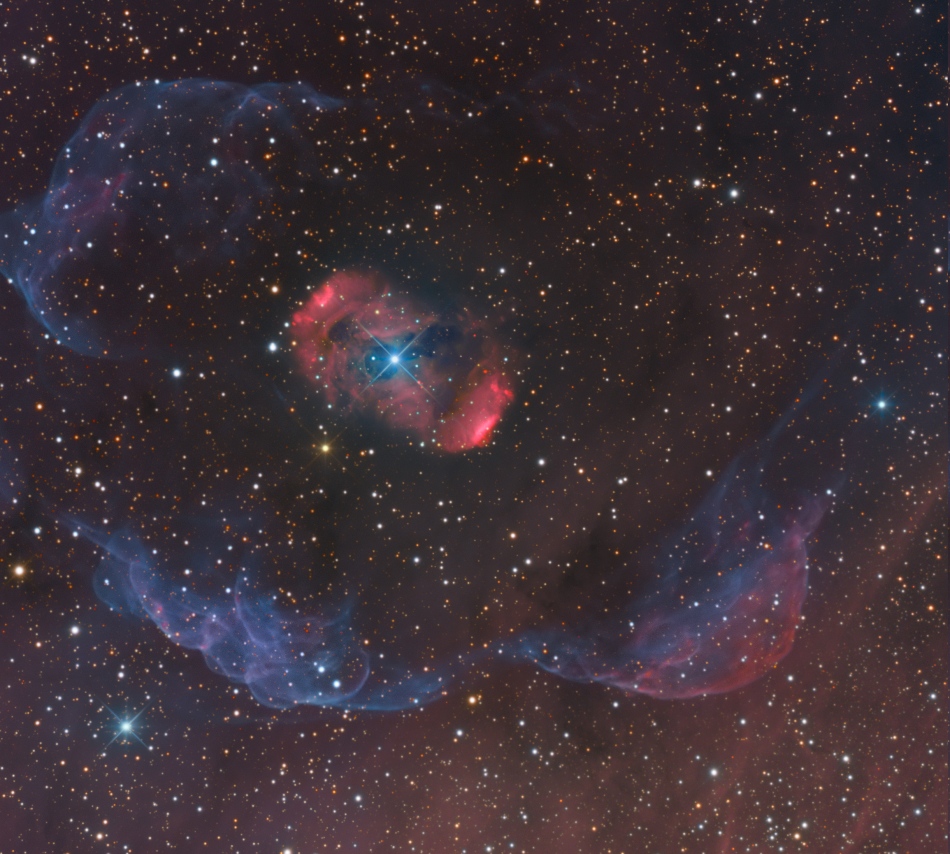 Beautiful emission nebula NGC 6164 was created by a rare, hot, luminous O-type star, some 40 times as massive as the Sun. Seen at the center of the cosmic cloud, the star is a mere 3 to 4 million years old. In another three to four million years the massive star will end its life in a supernova explosion. Spanning around 4 light-years, the nebula itself has a bipolar symmetry. That makes it similar in appearance to more common and familiar planetary nebulae - the gaseous shrouds surrounding dying sun-like stars. Also like many planetary nebulae, NGC 6164 has been found to have an extensive, faint halo, revealed in this deep telescopic image of the region. Expanding into the surrounding interstellar medium, the material in the halo is likely from an earlier active phase of the O star. The gorgeous skyscape is a composite of extensive narrow-band image data, highlighting glowing atomic hydrogen gas in red and oxygen in blue hues, with broad-band data for the surrounding starfield. NGC 6164 is 4,200 light-years away in the right-angled southern constellation of Norma. May 21, 2014 How do supercell storm clouds form? Pictured above is a time-lapse video taken last Sunday detailing the formation of one such violent supercell in eastern Wyoming, USA. Starting as part of a large and dark thunderstorm complex, the supercell comes together along with a large rotating updraft of air known as a mesocyclone. Mesocyclones form during rapid changes in wind speed and direction with height and can produce torrential rain, damaging hail, swirling winds, and sometimes tornadoes. Storm watchers are seen studying, imaging, and ultimately running from the developing storm cloud during the video. During the middle part of the video, the kilometer-wide supercell can be seen swirling ominously with a nearly flat bottom. Toward the end of the video, another swirling supercell cloud forms but then quickly dissipates. May 20, 2014  M61 is a barred spiral galaxy located in the nearby Virgo Cluster of Galaxies. Visible in M61 are a host of features common to spiral galaxies: bright spiral arms, a central bar, dust lanes, and bright knots of stars. M61, also known as NGC 4303, in similar to our own Milky Way Galaxy. M61 was discovered by telescope in 1779 twice on the same day, but one observer initially mistook the galaxy for a comet. Light from M61 takes about 55 million years to reach us. The above image of the central regions of M61 was taken with the Hubble Space Telescope and adapted for release as part of the Hubble's Hidden Treasures image processing competition. May 19, 2014 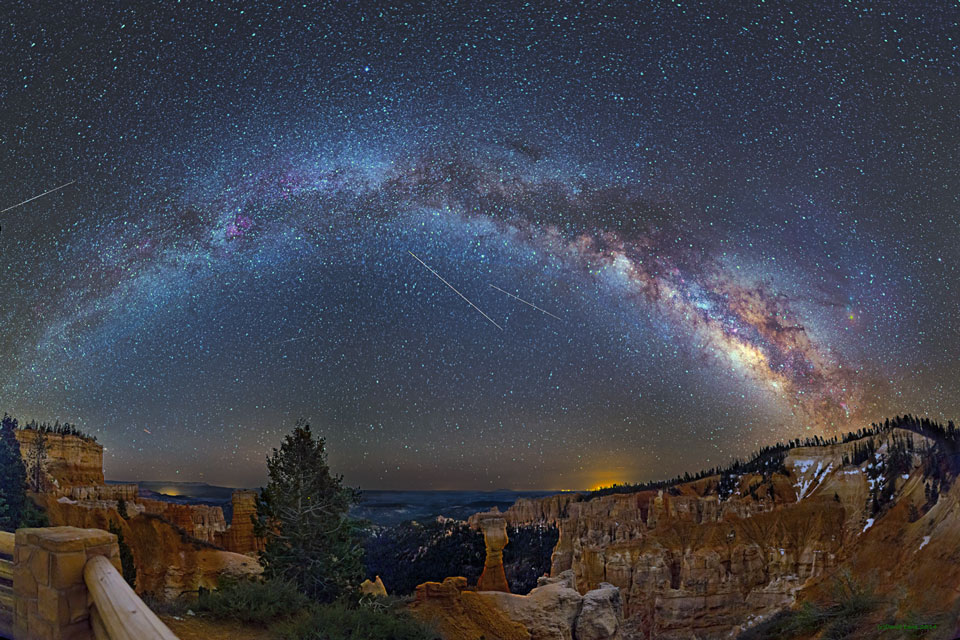 Sometimes land and sky are both busy and beautiful. The landscape pictured in the foreground encompasses Bryce Canyon in Utah, USA, famous for its many interesting rock structures eroded over millions of years. The skyscape above, photogenic in its own right, encompasses the arching central disk of our Milky Way Galaxy, streaks that include three passing airplanes and at least four Eta Aquariid meteors, and bright stars that include the Summer Triangle. The above image is a digital panorama created from 12 smaller images earlier this month on the night May 6. If you missed the recent Eta Aquariids meteor shower though, don't fret -- you may get an unexpected reprieve. Sky enthusiasts are waiting to see if a new meteor shower develops in the early morning hours of Saturday, May 24, when the Earth moves through a possibly dense cloud of dust and debris ejected by Comet 209P/LINEAR. May 18, 2014 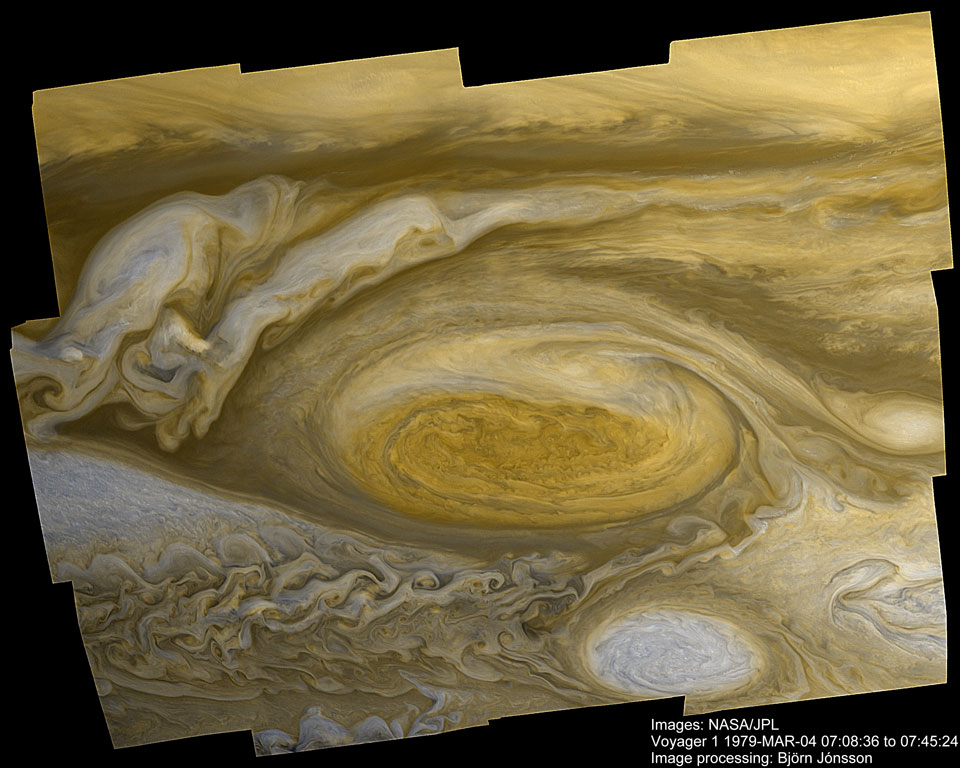 What will become of Jupiter's Great Red Spot? Recorded as shrinking since the 1930s, the rate of the Great Red Spot's size appears to have accelerated just in the past few years. A hurricane larger than Earth, the Great Red Spot has been raging at least as long as telescopes could see it. Like most astronomical phenomena, the Great Red Spot was neither predicted nor immediately understood after its discovery. Although small eddies that feed into the storm system seem to play a role, a more full understanding of the gigantic storm cloud remains a topic of continued research, and may result in a better understanding of weather here on Earth. The above image is a digital enhancement of an image of Jupiter taken in 1979 by the Voyager 1 spacecraft as it zoomed by the Solar System's largest planet. NASA's Juno spacecraft is currently heading toward Jupiter and will arrive in 2016. May 17, 2014  Gas giant Jupiter is the solar system's largest world with about 320 times the mass of planet Earth. It's also known for a giant swirling storm system, the Great Red Spot, featured in this sharp Hubble image from April 21. Nestled between Jupiter-girdling cloud bands, the Great Red Spot itself could still easily swallow Earth, but lately it has been shrinking. The most recent Hubble observations measure the spot to be about 10,250 miles (16,500 kilometers) across. That's the smallest ever measured by Hubble and particularly dramatic when compared to 14,500 miles measured by the Voyager 1 and 2 flybys in 1979, and historic telescopic observations from the 1800s indicating a width of about 25,500 miles on its long axis. Current indications are that the rate of shrinking is increasing for the long-lived Great Red Spot. May 16, 2014 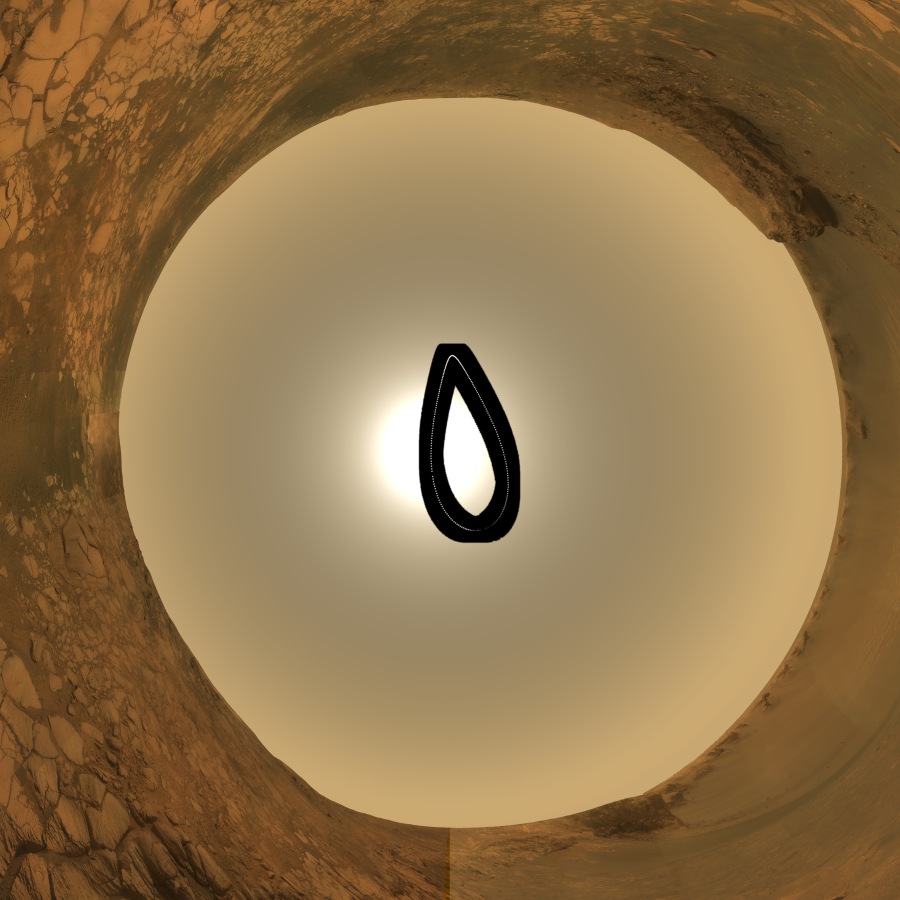 Staring up into the martian sky, the Opportunity rover captured an image at 11:02 AM local mean time nearly every 3rd sol, or martian day, for 1 martian year. Of course, the result is this martian analemma, a curve tracing the Sun's motion through the sky in the course of a year (668 sols) on the Red Planet. Spanning Earth dates from July, 16, 2006 to June 2, 2008 the images are shown composited in this zenith-centered, fisheye projection. North is at the top surrounded by a panoramic sky and landscape made in late 2007 from inside Victoria crater. The tinted martian sky is blacked out around the analemma images to clearly show the Sun's positions. Unlike Earth's figure-8-shaped analemma, Mars' analemma is pear-shaped, because of its similar axial tilt but more elliptical orbit. When Mars is farther from the Sun, the Sun progresses slowly in the martian sky creating the pointy top of the curve. When close to the Sun and moving quickly, the apparent solar motion is stretched into the rounded bottom. For several sols some of the frames are missing due to rover operations and dust storms. May 15, 2014  Cruising through the outer solar system, the Voyager 2 spacecraft made its closest approach to Neptune on August 25, 1989, the only spacecraft to visit the most distant gas giant. Based on the images recorded during its close encounter and in the following days, this inspired composited scene covers the dim outer planet, largest moon Triton, and faint system of rings. From just beyond Neptune's orbit, the interplanetary perspective looks back toward the Sun, capturing the planet and Triton as thin sunlit crescents. Cirrus clouds and a dark band circle Neptune's south polar region, with a cloudy vortex above the pole itself. Parts of the very faint ring system along with the three bright ring arcs were first imaged by Voyager during the fly-by, though the faintest segments are modeled in this composited picture. Spanning 7.5 degrees, the background starfield is composed from sky survey data centered on the constellation Camelopardalis, corresponding to the outbound Voyager's view of the magnificent Neptunian system. May 14, 2014 Source: If you were floating above the Earth right now, this is what you might see. Two weeks ago, the robotic SpaceX Dragon capsule that delivered supplies to the Earth-orbiting International Space Station (ISS) also delivered High Definition Earth Viewing (HDEV) cameras that take and transmit live views of Earth. Pictured above, when working, is the live video feed that switches between four cameras, each pointed differently. Watch white clouds, tan land, and blue oceans drift by. The above video will appear black when it is nighttime on the Earth below, but the space station's rapid 90-minute orbit compresses this dark time into only 45 minutes. The present location of the ISS above the Earth can be found on the web. If the video appears gray, this indicates that the view is either being switched between cameras, or communications with the ISS is temporarily unavailable. As the HDEV project continues, video quality will be monitored to assess the effects of high energy radiation, which types of cameras work best, and which Earth views are the most popular. Although this feed will eventually be terminated, lessons learned will enable better cameras to be deployed to the ISS in the future, likely returning even more interesting live feeds. May 13, 2014  Can a gas cloud grab a galaxy? It's not even close. The "claw" of this odd looking "creature" in the above photo is a gas cloud known as a cometary globule. This globule, however, has ruptured. Cometary globules are typically characterized by dusty heads and elongated tails. These features cause cometary globules to have visual similarities to comets, but in reality they are very much different. Globules are frequently the birthplaces of stars, and many show very young stars in their heads. The reason for the rupture in the head of this object is not completely known. The galaxy to the left of the globule is huge, very far in the distance, and only placed near CG4 by chance superposition. May 12, 2014 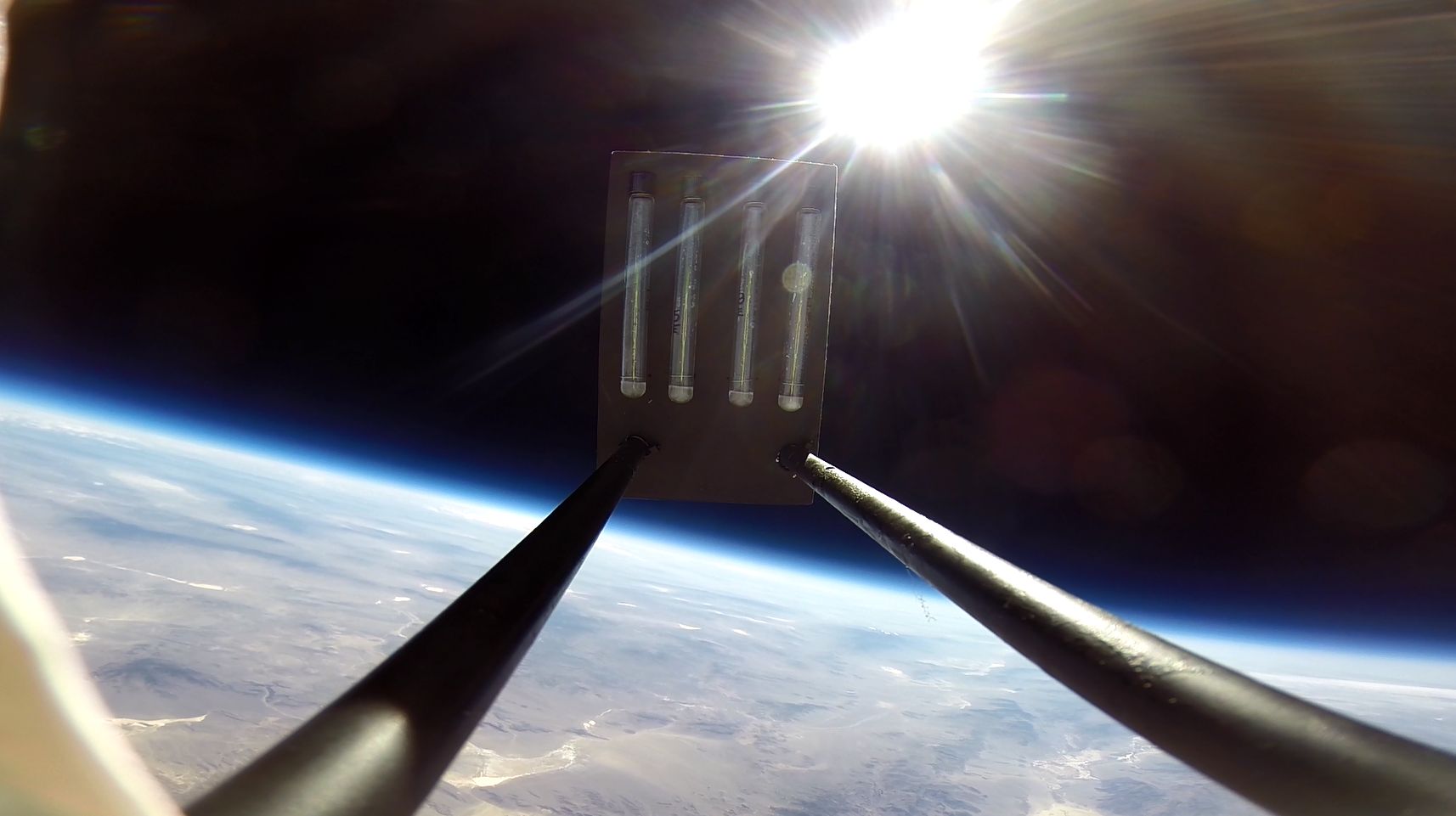 Over the weekend, the students of Earth to Sky Calculus launched a space weather balloon to the stratosphere carrying four colonies of halobacteria. During the flight, the microbes set a high-altitude ballooning record for their species. Here they are floating 112,000 feet above Earth's surface. In the image, the sky is black not because it is night, but rather because the balloon is floating above 99% of Earth's atmosphere. The payload was on the doorstep of space itself. During the 90 minute ascent, the microbes were exposed to temperatures as low as -58 C and cosmic radiation levels more than 25 times Earth-normal. These conditions are akin to the planet Mars. The students are exposing halobacteria to the Mars-like environment above 100,000 feet in a continuing series of experiments to find out if terrestrial extremophiles could live on other planets. Incubation begins tomorrow in the high school AP Biology Lab. May 11, 2014 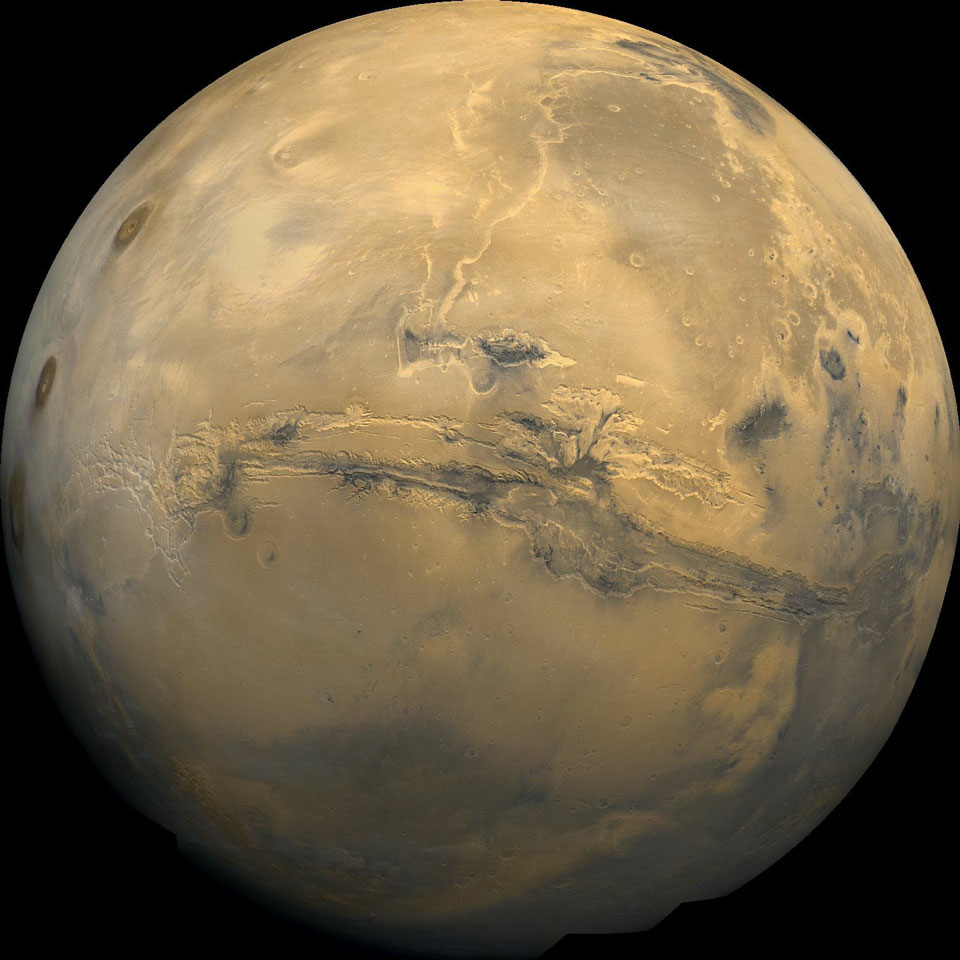 The largest canyon in the Solar System cuts a wide swath across the face of Mars. Named Valles Marineris, the grand valley extends over 3,000 kilometers long, spans as much as 600 kilometers across, and delves as much as 8 kilometers deep. By comparison, the Earth's Grand Canyon in Arizona, USA is 800 kilometers long, 30 kilometers across, and 1.8 kilometers deep. The origin of the Valles Marineris remains unknown, although a leading hypothesis holds that it started as a crack billions of years ago as the planet cooled. Several geologic processes have been identified in the canyon. The above mosaic was created from over 100 images of Mars taken by Viking Orbiters in the 1970s. May 10, 2014 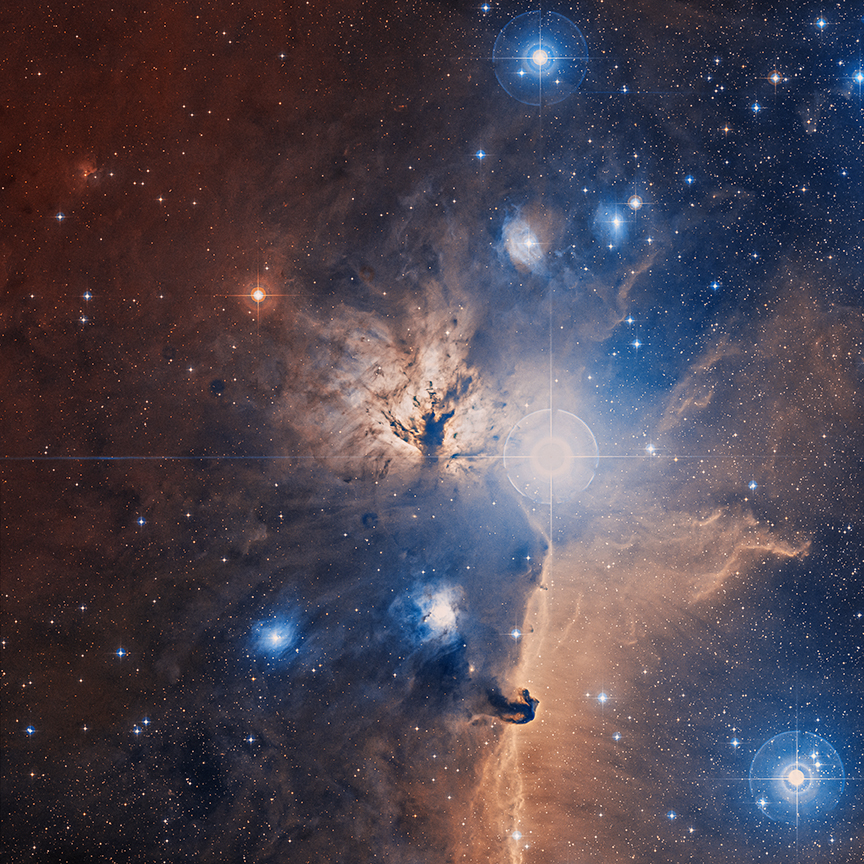 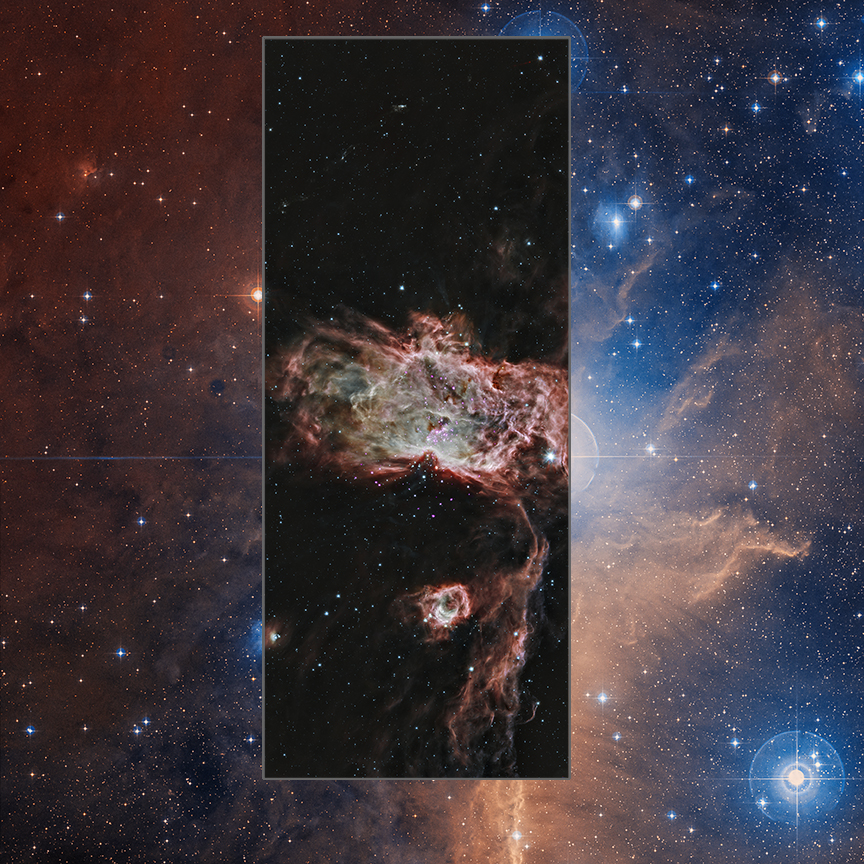 The Flame Nebula stands out in this optical image of the dusty, crowded star forming regions toward Orion's belt, a mere 1,400 light-years away. X-ray data from the Chandra Observatory and infrared images from the Spitzer Space Telescope can take you inside the glowing gas and obscuring dust clouds though. The second image will reveal many stars of the recently formed, embedded cluster NGC 2024, ranging in age from 200,000 years to 1.5 million years young. The X-ray/infrared composite image overlay spans about 15 light-years across the Flame's center. The X-ray/infrared data also indicate that the youngest stars are concentrated near the middle of the cluster. That's the opposite of the simplest models of star formation for the stellar nursery. They predict star formation to begin first in the denser center and progressively move outward toward the edges leaving the older stars, not the younger ones, in the center of the Flame Nebula. May 9, 2014 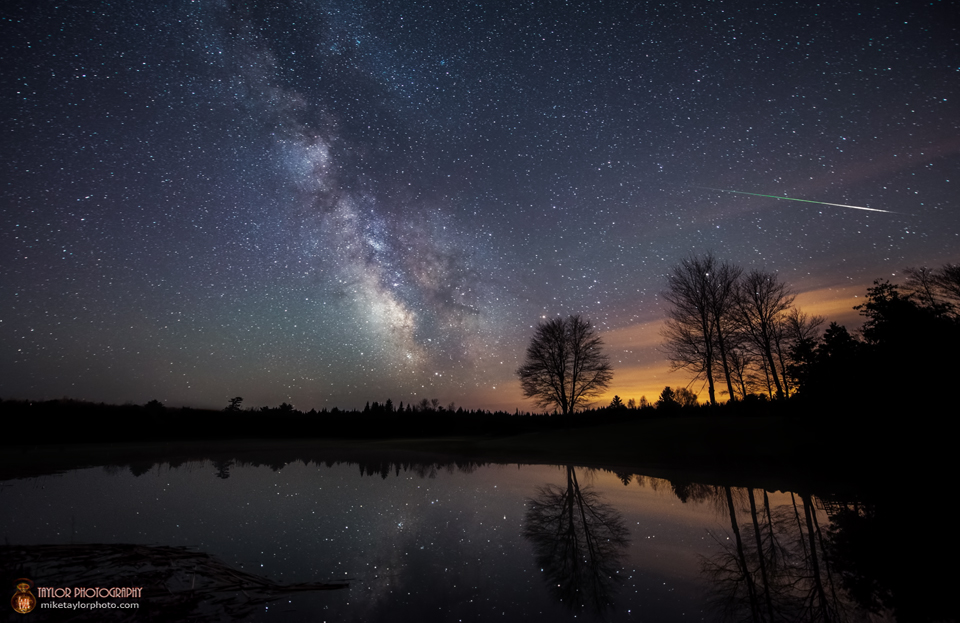 The early morning hours of May 6 were moonless when grains of cosmic dust streaked through dark skies. Swept up as planet Earth plows through dusty debris streams left behind periodic Comet Halley, the annual meteor shower is known as the Eta Aquarids. This inspired exposure captures a meteor streak moving left right through the frame. Its trail points back across the arc of the Milky Way to the shower's radiant above the local horizon in the constellation Aquarius. Known for speed Eta Aquarid meteors move fast, entering the atmosphere at about 66 kilometers per second. Still waters of the small pond near Albion, Maine, USA reflect the starry scene and the orange glow of nearby artificial lights scattered by a low cloud bank. Of course, northern hemisphere skygazers are expecting a new meteor shower on May 24, the Camelopardalids, caused by dust from periodic comet 209P/LINEAR. May 8, 2014 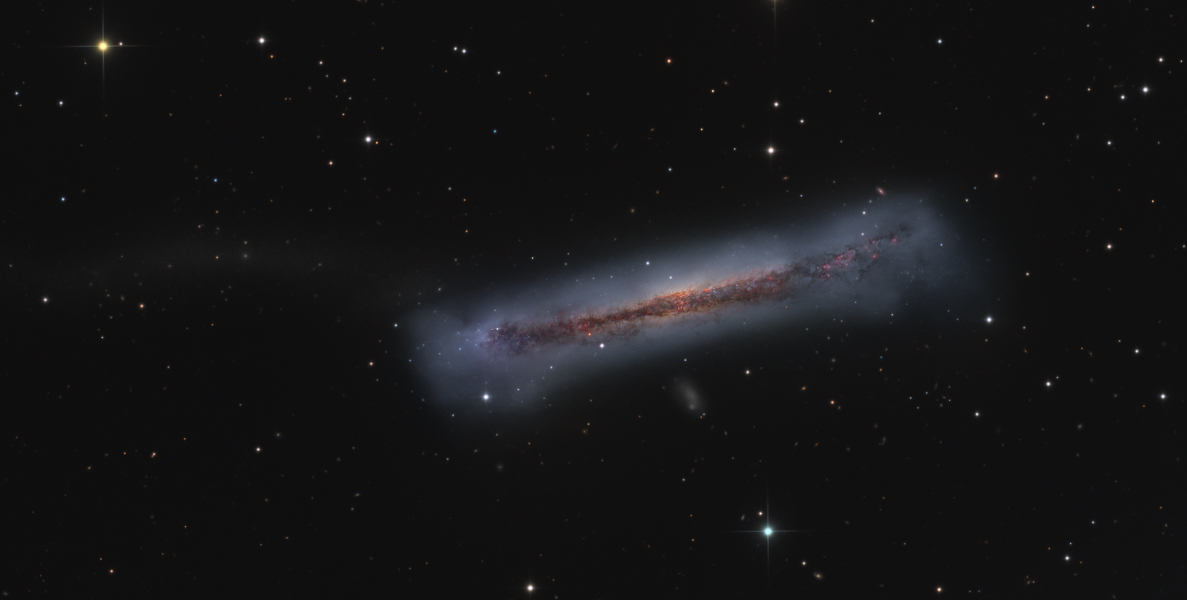 Sharp telescopic views of NGC 3628 show a puffy galactic disk divided by dark dust lanes. Of course, this deep portrait of the magnificent, edge-on spiral galaxy puts some astronomers in mind of its popular moniker, the Hamburger Galaxy. It also reveals a small galaxy nearby, likely a satellite of NGC 3628, and a faint but extensive tidal tail. The tantalizing island universe itself is about 100,000 light-years across and 35 million light-years away in the northern springtime constellation Leo. Its drawn out tail stretches for about 300,000 light-years, even beyond the left edge of the wide frame. NGC 3628 shares its neighborhood in the local Universe with two other large spirals M65 and M66 in a grouping otherwise known as the Leo Triplet. Gravitational interactions with its cosmic neighbors are likely responsible for creating the tidal tail, as well as the extended flare and warp of this spiral's disk. May 7, 2014 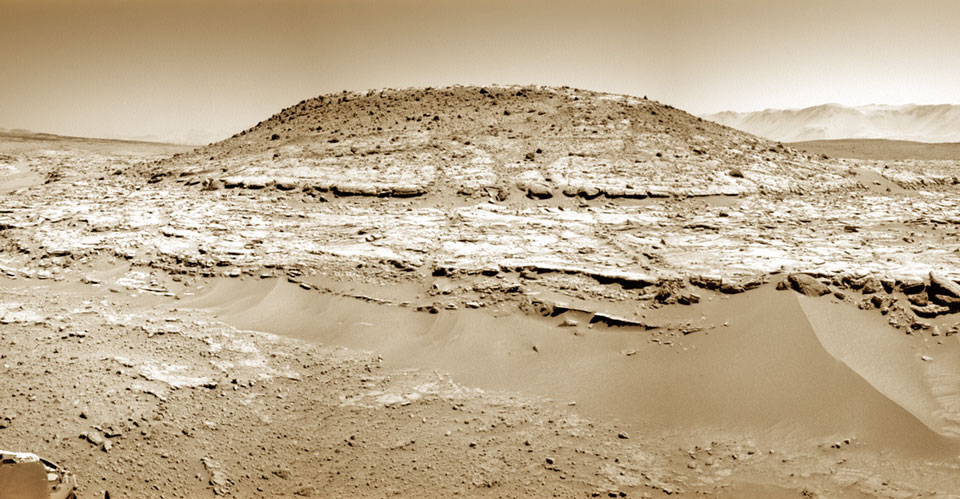 What has the Curiosity rover come across on Mars? Dubbed Mount Remarkable, the rolling robot has chanced upon this notable 5-meter tall mound during its continuing journey around and, eventually, up 5.5-kilometer high Mt. Sharp. Unsure of the density of the surrounding layered sandstone, the human team on Earth has instructed the car-sized rover on Mars to drill into a rock on the side of Mt. Remarkable to investigate. Quite possibly, water involved in creating the dense sandstone could have helped to support ancient life on the red planet. Mt. Sharp, the unusual central peak of Gale Crater, has a similar base-to-peak height as Earth's Mt. Everest. May 6, 2014  Our Sun has become quite a busy place. Taken only two weeks ago, the Sun was captured sporting numerous tumultuous regions including active sunspot regions AR 2036 near the image top and AR 2036 near the center. Only four years ago the Sun was emerging from an unusually quiet Solar Minimum that had lasted for years. The above image was recorded in a single color of light called Hydrogen Alpha, inverted, and false colored. Spicules cover much of the Sun's face like a carpet. The gradual brightening towards the Sun's edges is caused by increased absorption of relatively cool solar gas and called limb darkening. Just over the Sun's edges, several filamentary prominences protrude, while prominences on the Sun's face are seen as light streaks. Possibly the most visually interesting of all are the magnetically tangled active regions containing relatively cool sunspots, seen as white dots. Currently at Solar Maximum -- the most active phase in its 11-year magnetic cycle, the Sun's twisted magnetic field is creating numerous solar "sparks" which include eruptive solar prominences, coronal mass ejections, and flares which emit clouds of particles that may impact the Earth and cause auroras. One flare two years ago released such a torrent of charged particles into the Solar System that it might have disrupted satellites and compromised power grids had it struck planet Earth. May 5, 2014  How do you calibrate a huge gravitational lens? In this case the lens is the galaxy cluster Abell 383, a massive conglomeration of galaxies, hot gas, and dark matter that lies about 2.5 billion light years away (redshift z=0.187). What needs calibrating is the mass of the cluster, in particular the amount and distribution of dark matter. A new calibration technique has been tested recently that consists of waiting for supernovas of a very specific type to occur behind a galaxy cluster, and then figuring out how much the cluster must have magnified these supernovas through gravitational lensing. This technique complements other measures including computing the dark matter needed to contain internal galaxy motions, to confine cluster hot gas, and to create the gravitational lens image distortions. Pictured above from the Hubble Space Telescope, galaxy cluster A383 shows its gravitational lens capabilities on the right by highly distorting background galaxies behind the cluster center. On the left is a distant galaxy shown both before and after a recent revealing supernova. To date, calibration-quality supernovas of Type Ia have been found behind two other galaxy clusters by the Cluster Lensing And Supernova survey with Hubble (CLASH) project. May 4, 2014 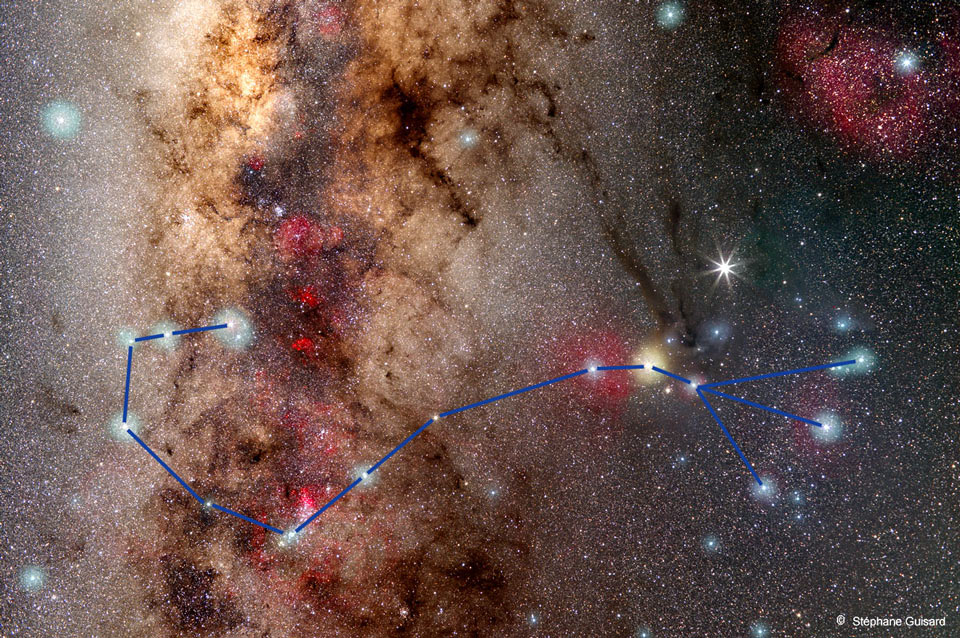  If Scorpius looked this good to the unaided eye, humans might remember it better. Scorpius more typically appears as a few bright stars in a well-known but rarely pointed out zodiacal constellation. To get a spectacular image like this, though, one needs a good camera, color filters, and a digital image processor. To bring out detail, the above image not only involved long duration exposures taken in several colors, but one exposure in a very specific red color emitted by hydrogen. The resulting image shows many breathtaking features. Vertically across the image left is part of the plane of our Milky Way Galaxy. Visible there are vast clouds of bright stars and long filaments of dark dust. Jutting out diagonally from the Milky Way in the image center are dark dust bands known as the Dark River. This river connects to several bright stars on the right that are part of Scorpius' head and claws, and include the bright star Antares. Above and right of Antares is an even brighter planet Jupiter. Numerous red emission nebulas and blue reflection nebulas are visible throughout the image. Scorpius appears prominently in southern skies after sunset during the middle of the year. May 3, 2014  The yellowish star near center in this dusty telescopic skyview is T Tauri, prototype of the class of T Tauri variable stars. Just next door is the yellow cosmic cloud historically known as Hind's Variable Nebula (NGC 1555). Over 400 light-years away, at the edge of an otherwise invisible molecular cloud, both star and nebula are seen to vary significantly in brightness but not necessarily at the same time, adding to the mystery of the intriguing region. T Tauri stars are now generally recognized as young (less than a few million years old), sun-like stars still in the early stages of formation. To further complicate the picture, infrared observations indicate that T Tauri itself is part of a multiple system and suggest that the associated Hind's Nebula may also contain a very young stellar object. The naturally colored image spans about 7 light-years at the estimated distance of T Tauri. May 2, 2014 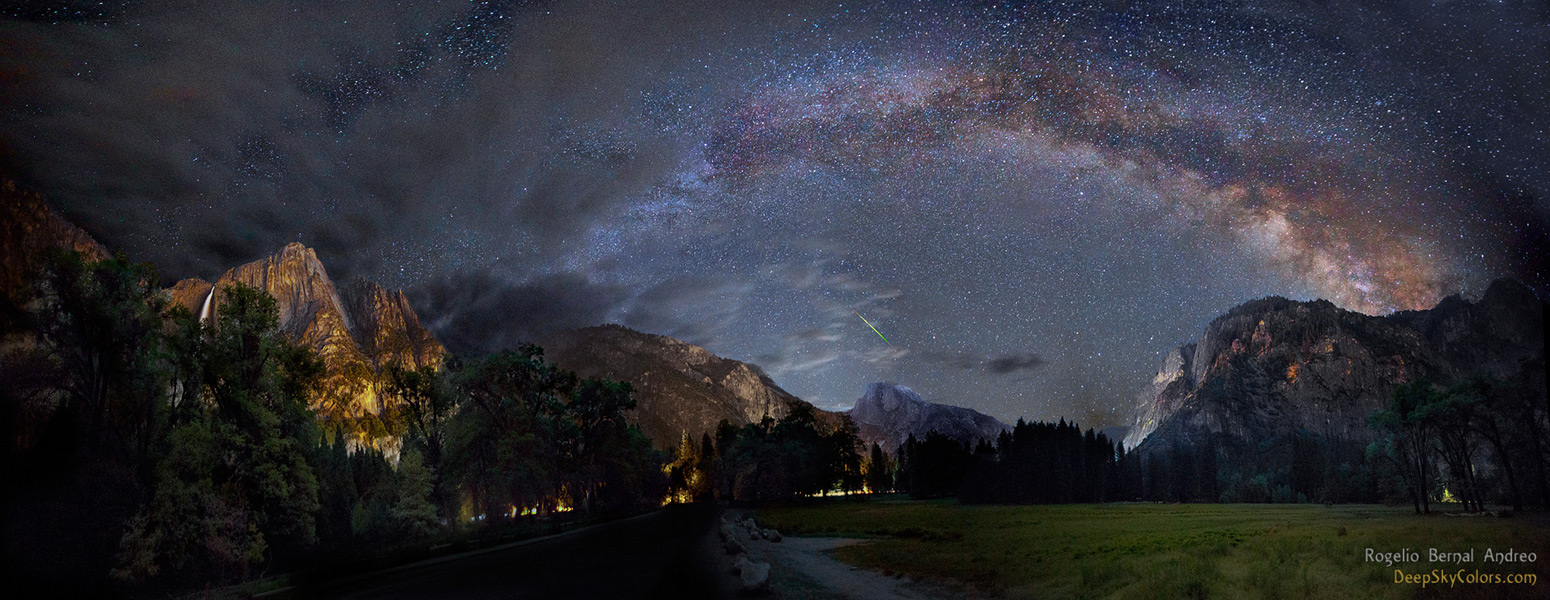 Captured one night last May this eight frame mosaic starts on the left, down Northside Drive through Yosemite National Park. It ends thousands of light-years away though, as the arc of the Milky Way tracks toward the center of our galaxy on the right, far beyond the park's rugged skyline. That night was still moonless when the storm clouds retreated, so the rocky faces of the surrounding mountains are lit by campfires and artifical lights. Yosemite Falls is at the left. The granite face of Half Dome juts above the far horizon, near the center of the view. The remarkable flash above it is a bright meteor. Part of the annual Eta Aquarid meteor shower the colorful streak is moving up, its trail pointing directly back to the shower's radiant, low in Aquarius. This year's Eta Aquarids should peak in the moonless early morning hours of May 6 as the Earth sweeps through dust from the tail of Comet Halley. May 1, 2014 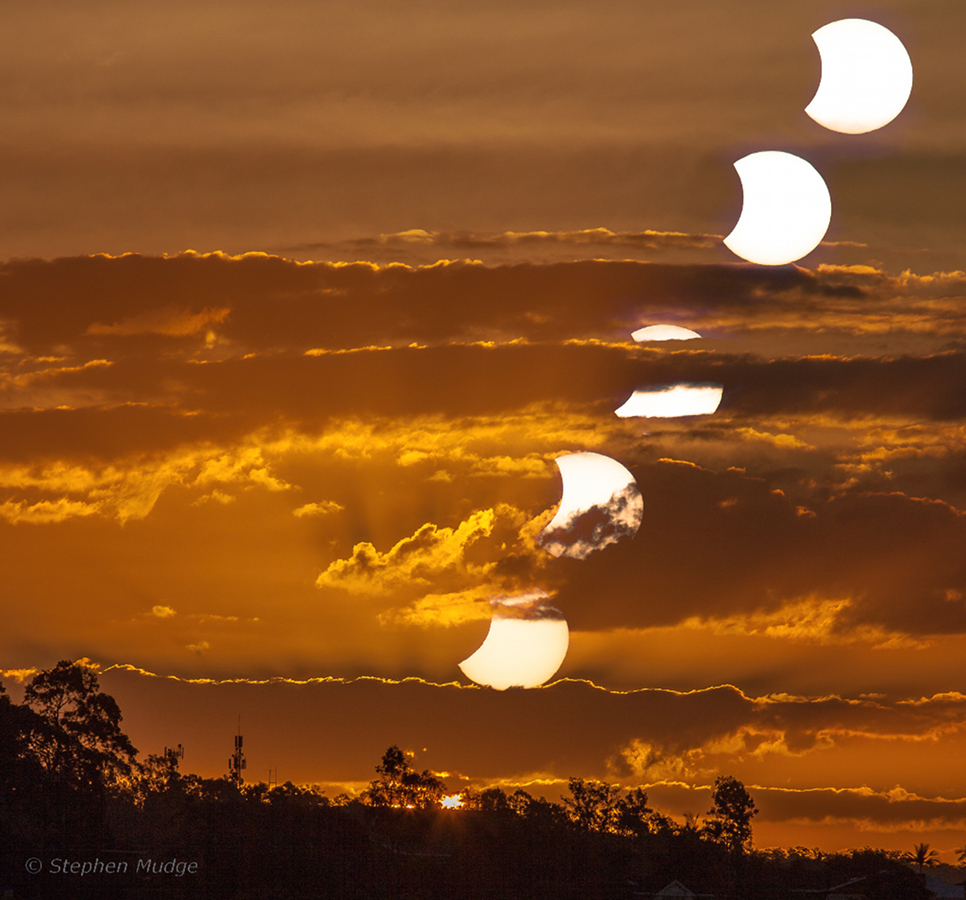 In skies over Brisbane at the southeastern corner of Queensland, Australia, Planet Earth, the Sun and New Moon set together on April 29. There the celestial line-up, the first solar eclipse of 2014, was seen as a partial solar eclipse. This dramatic composite is a digital stack of images taken about 5 minutes apart with telephoto lens and solar filter. It follows the eclipse in progress, approaching a western horizon where crepuscular rays from cloud banks in silhouette joined the silhouetted Moon. From Brisbane, the maximum eclipse phase with the Moon covering about 25% of the Sun occurred just after sunset. Only from a remote spot on the continent of Antarctica was it even possible to see the eclipse in its brief annular phase, the entire dark lunar disk surrounded by a thin, bright ring of fire. April 30, 2014 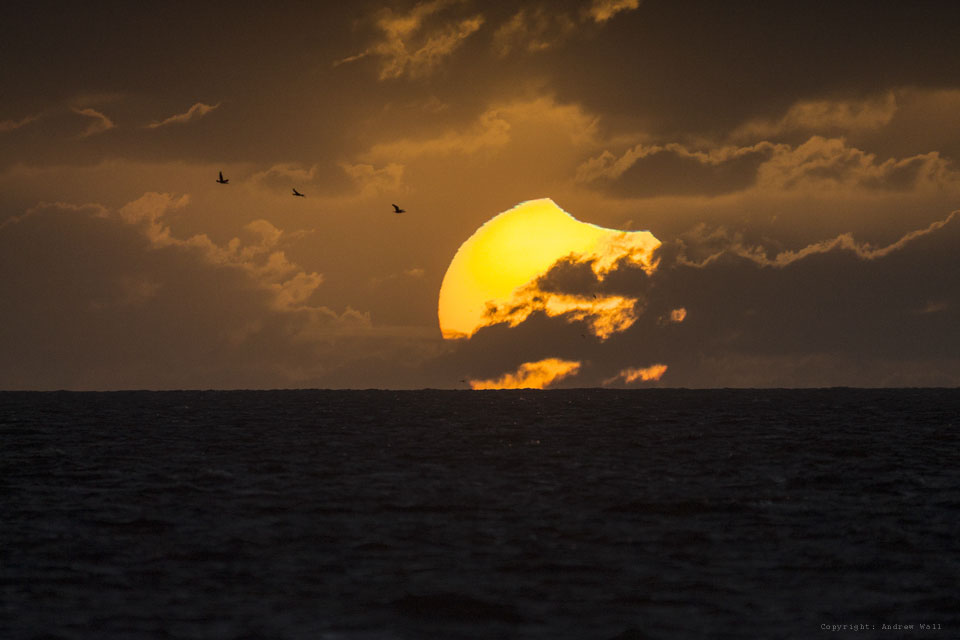 If you look closely, you will see something quite unusual about this setting Sun. There are birds flying to the Sun's left, but that's not so unusual. A dark sea covers the Sun's bottom, and dark clouds cover parts of the middle, but they are also not very unusual. More unusual is the occulted piece at the top right. And that's no occulting cloud -- that's the Moon. Yesterday the Moon moved in front of part of the Sun as visible from Australia, and although many locations reported annoying clouds, a partially eclipsed Sun would occasionally peak through as it set. The above image was captured yesterday on the western horizon of Adelaide, South Australia. The maximum eclipse was visible only from a small part of Antarctica where the entire Moon could be seen covering the entire center of the Sun in what is known as an annular eclipse, leaving only a ring of fire from the Sun peaking out around the edges. The next solar eclipse will be another partial eclipse, will occur on 2014 October 23, and will be visible from most of North America near sunset. April 29, 2014 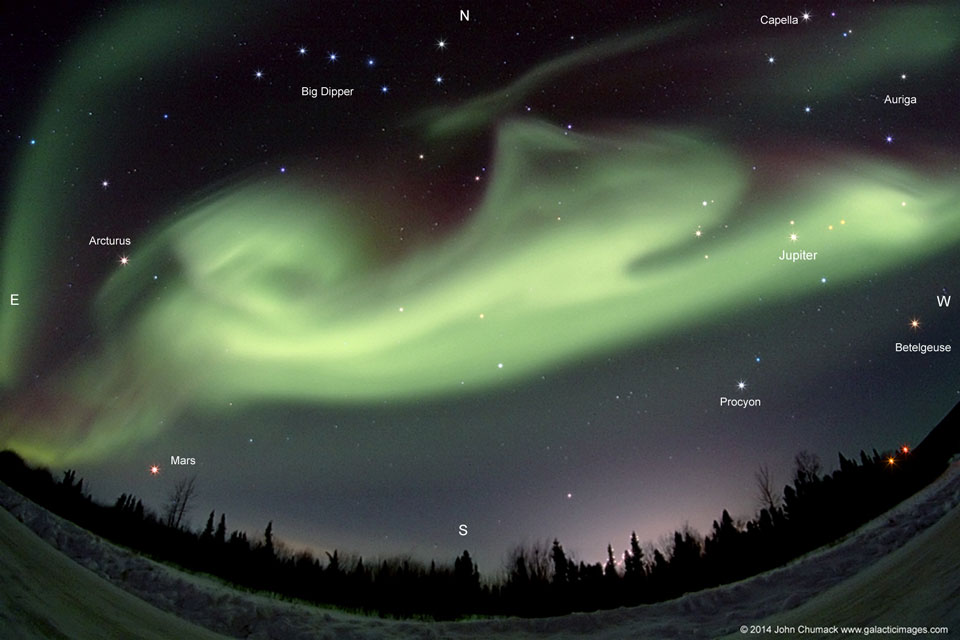 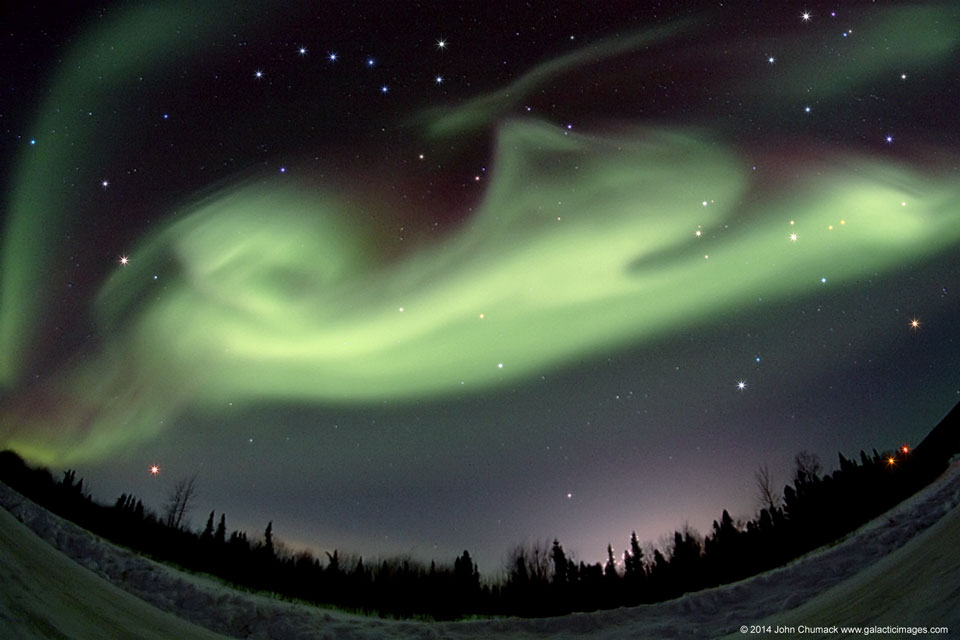 Sometimes it is hard to believe what you see in the sky. While leading his annual aurora tour last month near Fairbanks in central Alaska, astrophotographer John Chumack and his company saw a most unusual aurora. This bright aurora appeared to change into the shape of a jumping dog, complete with a curly tail. He was able to capture the fleeting natural apparition in the above image with a 15-second exposure through a wide-angle lens. By coincidence, he also captured a background sky filled with familiar highlights. Planets visible include bright Jupiter through the dog's front legs and reddish Mars below the dog's hind legs. Stars visible include the Big Dipper stars above the dog's midsection and reddish Betelgeuse shining on the far right. This dog would not be following him home, however, and within a few minutes morphed into other shapes before the geomagnetic storm particles that created it shifted to strike the Earth elsewhere. April 28, 2014 Why would a bright full Moon suddenly become dark? Because it entered the shadow of the Earth. Almost two weeks ago this exact event happened as the Moon underwent a total lunar eclipse. That eclipse, visible from the half of the Earth then facing the Moon, was captured in numerous spectacular photographs and is depicted in the above time lapse video covering about an hour. The above video, recorded from Mt. Lemmon Sky Center in Arizona, USA, keeps the Earth shadow centered and shows the Moon moving through it from west to east. The temporarily good alignment between Earth, Moon, and Sun will show itself again tomorrow -- precisely half a moon-th (month) later -- when part of the Earth will pass through part of the new Moon's shadow. April 27, 2014 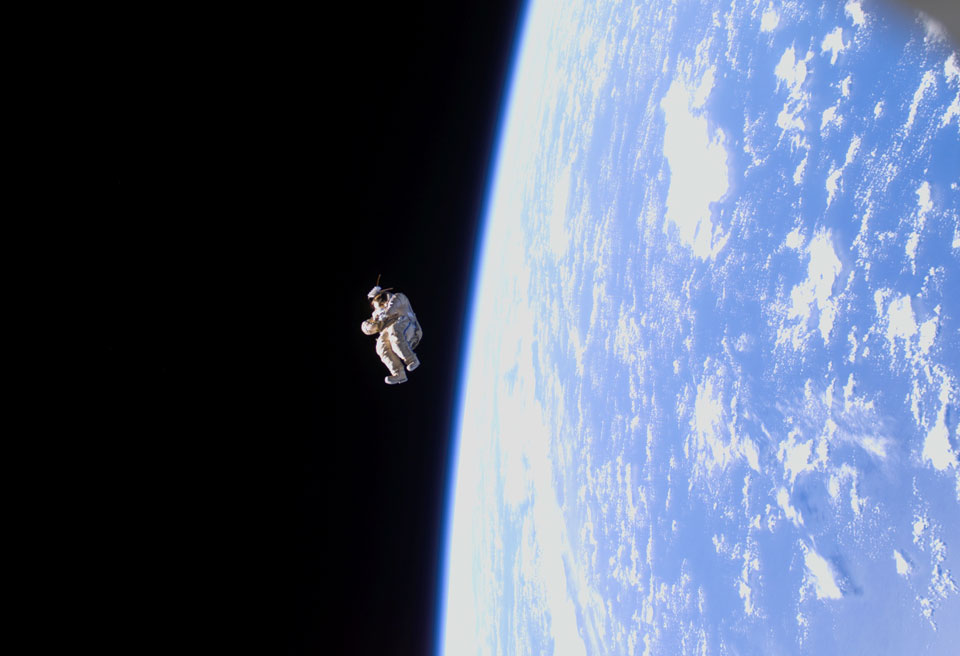 A spacesuit floated away from the International Space Station eight years ago, but no investigation was conducted. Everyone knew that it pushed by the space station crew. Dubbed Suitsat-1, the unneeded Russian Orlan spacesuit filled mostly with old clothes was fitted with a faint radio transmitter and released to orbit the Earth. The suit circled the Earth twice before its radio signal became unexpectedly weak. Suitsat-1 continued to orbit every 90 minutes until it burned up in the Earth's atmosphere after a few weeks. Pictured above, the lifeless spacesuit was photographed in 2006 just as it drifted away from space station. April 26, 2014 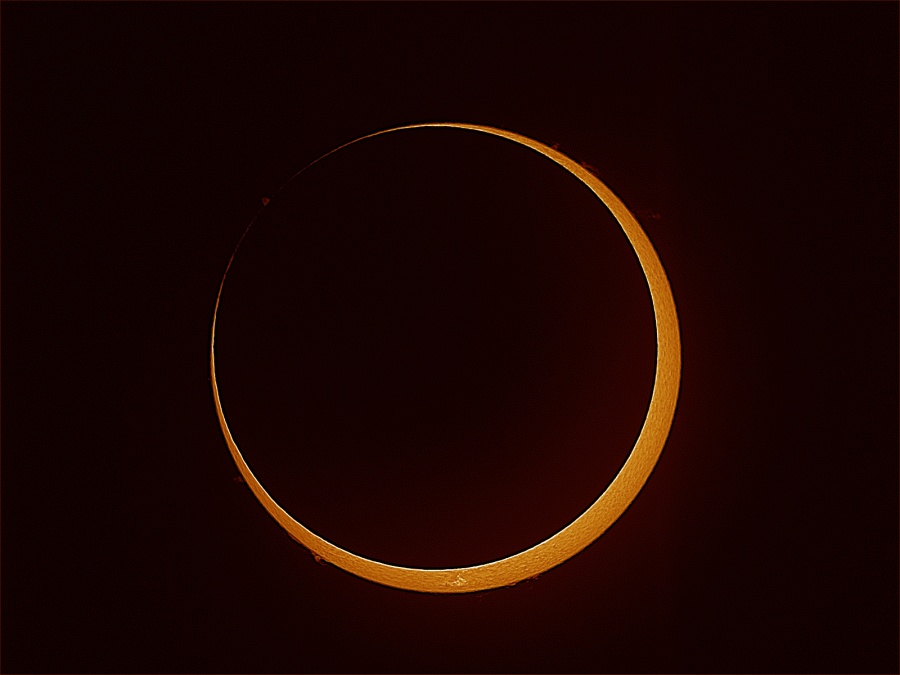 It's eclipse season, and on April 29 around 06:00 UT the shadow of the new Moon will reach out and touch planet Earth, though only just. Still, if you're standing on the continent of Antarctica within a few hundred kilometers of 79 degrees 38.7 minutes South latitude and 131 degrees 15.6 minutes East longitude you could see an annular solar eclipse with the Sun just above the horizon. Because the Moon will be approaching apogee, the most distant point in the elliptical lunar orbit, its apparent size will be too small to completely cover the solar disk. A rare, off-center eclipse, the annular phase will last at most 49 seconds. At its maximum it could look something like this "ring of fire" image from last May's annular solar eclipse, captured by a webcast team operating near Coen, Australia. Otherwise, a partial eclipse with the Moon covering at least some part of the Sun will be seen across a much broader region in the southern hemipshere, including Australia in the afternoon. April 25, 2014  "Beautiful Nebula discovered between the Balance [Libra] & the Serpent [Serpens] ..." begins the description of the 5th entry in 18th century astronomer Charles Messier's famous catalog of nebulae and star clusters. Though it appeared to Messier to be fuzzy and round and without stars, Messier 5 (M5) is now known to be a globular star cluster, 100,000 stars or more, bound by gravity and packed into a region around 165 light-years in diameter. It lies some 25,000 light-years away. Roaming the halo of our galaxy, globular star clusters are ancient members of the Milky Way. M5 is one of the oldest globulars, its stars estimated to be nearly 13 billion years old. The beautiful star cluster is a popular target for Earthbound telescopes. Of course, deployed in low Earth orbit on April 25, 1990, the Hubble Space Telescope has also captured its own stunning close-up view that spans about 20 light-years near the central region of M5. Even close to its dense core at the left, the cluster's aging red and blue giant stars and rejuvenated blue stragglers stand out in yellow and blue hues in the sharp color image. April 24, 2014 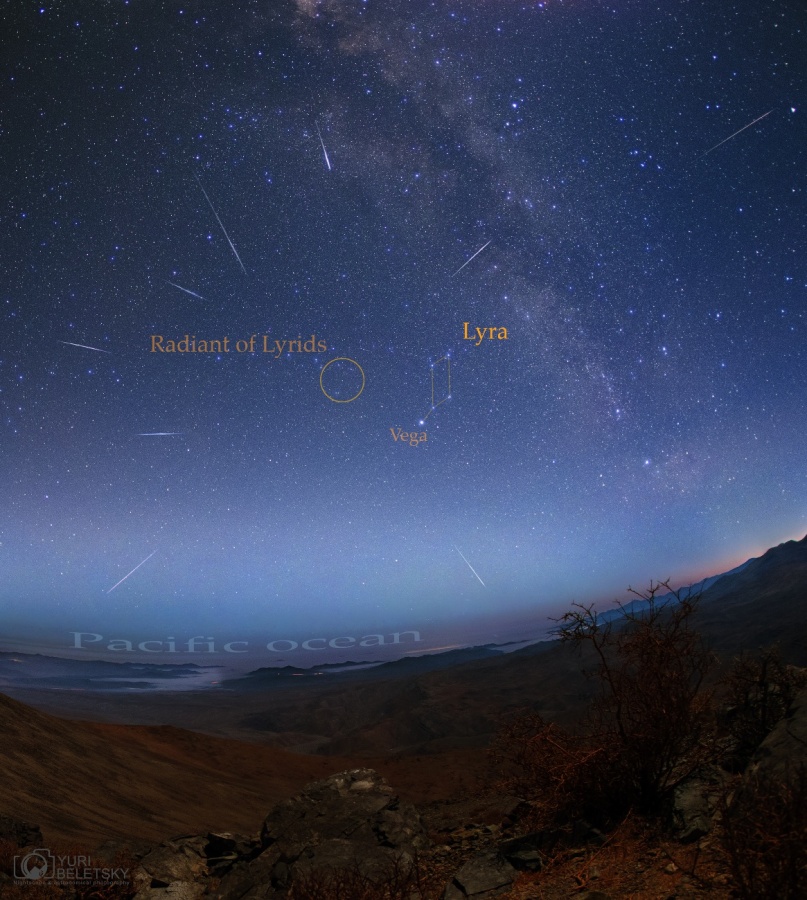 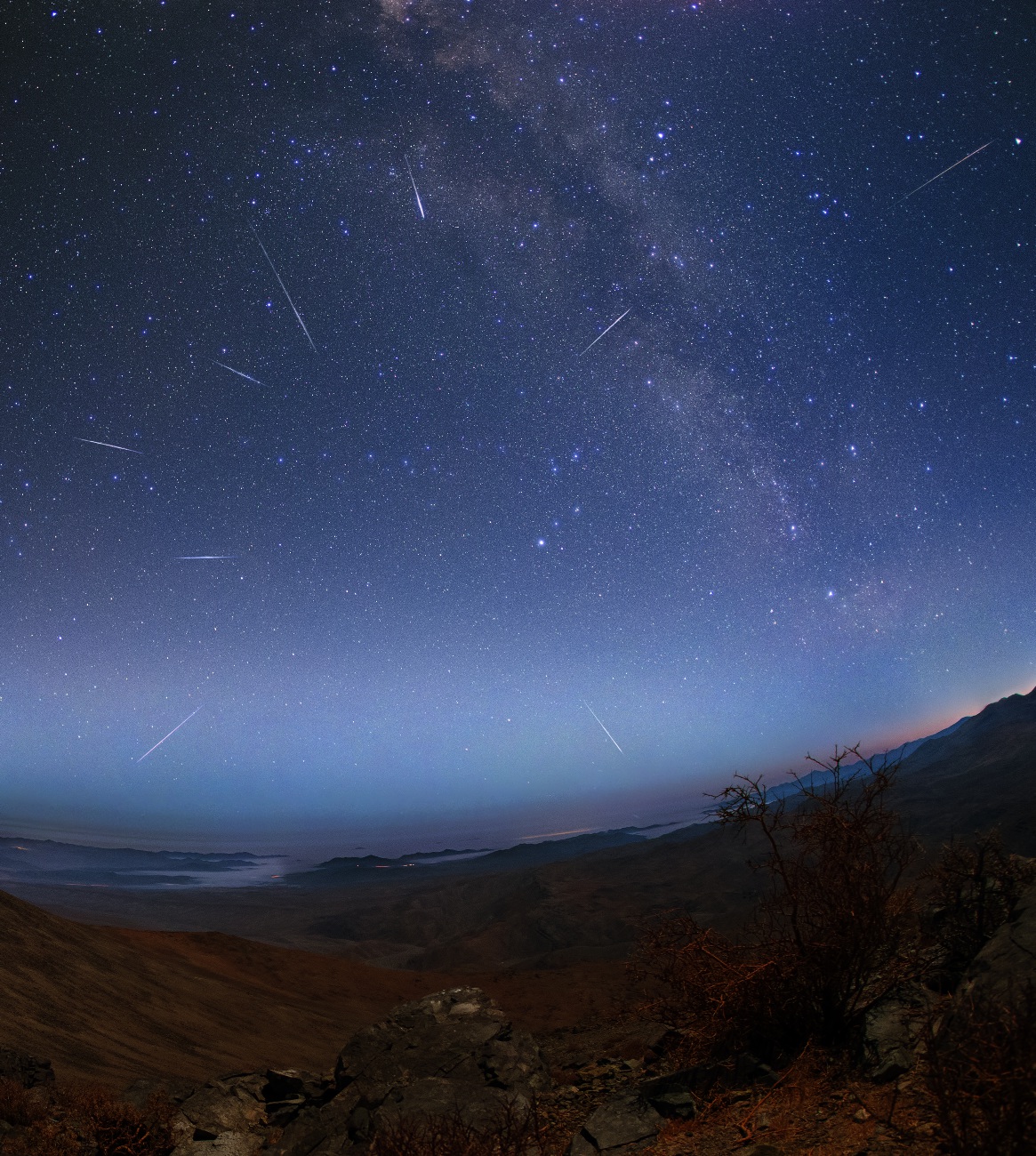 Earth's annual Lyrid meteor shower peaked before dawn on April 22nd, as our fair planet plowed through dust from the tail of long-period comet Thatcher. Even in the dry and dark Atacama desert along Chile's Pacific coast, light from a last quarter Moon made the night sky bright, washing out fainter meteor streaks. But brighter Lyrid meteors still put on a show. Captured in this composited earth-and-sky view recorded during early morning hours, the meteors stream away from the shower's radiant near Vega, alpha star of the constellation Lyra. The radiant effect is due to perspective as the parallel meteor tracks appear to converge in the distance. Rich starfields and dust clouds of our own Milky Way galaxy stretch across the background. April 23, 2014  From planet Earth, we see this strongly distorted pair of galaxies, cataloged as Arp 81, as they were only about 100 million years after their close encounter. The havoc wreaked by their mutual gravitational interaction during the encounter is detailed in this color composite image showing twisted streams of gas and dust, a chaos of massive star formation, and a tidal tail stretching for 200 thousand light-years or so as it sweeps behind the cosmic wreckage. Also known as NGC 6622 (left) and NGC 6621, the galaxies are roughly equal in size but are destined to merge into one large galaxy in the distant future, making repeated approaches until they finally coalesce. Located in the constellation Draco, the galaxies are 280 million light-years away. Even more distant background galaxies can be spotted in this sharp, reprocessed, image from Hubble Legacy Archive data. April 22, 2014  It is bigger than a bread box. In fact, it is much bigger than all bread boxes put together. Galaxy cluster ACT-CL J0102-4915 is one of the largest and most massive objects known. Dubbed "El Gordo", the seven billion light years (z = 0.87) distant galaxy cluster spans about seven million light years and holds the mass of a million billion Suns. The above image of El Gordo is a composite of a visible light image from the Hubble Space Telescope, an X-ray image from the Chandra Observatory showing the hot gas in pink, and a computer generated map showing the most probable distribution of dark matter in blue, computed from gravitational lens distortions of background galaxies. Almost all of the bright spots are galaxies. The blue dark matter distribution indicates that the cluster is in the middle stages of a collision between two large galaxy clusters. A careful inspection of the image will reveal a nearly vertical galaxy that appears unusually long. That galaxy is actually far in the background and has its image stretched by the gravitational lens action of the massive cluster. April 21, 2014 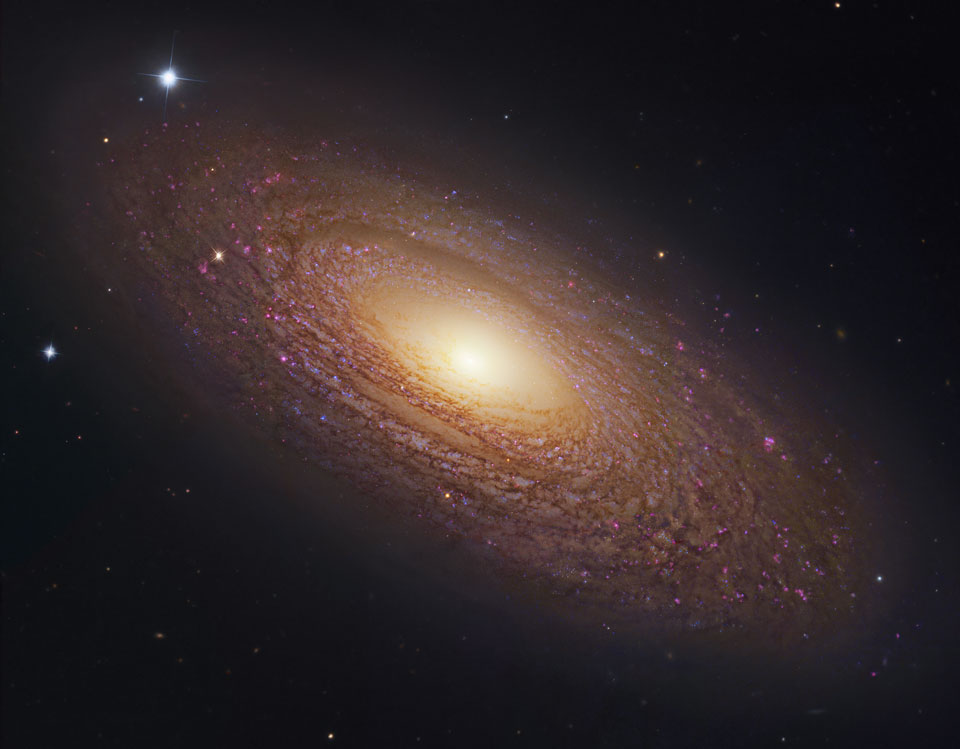 It is one of the more massive galaxies known. A mere 46 million light-years distant, spiral galaxy NGC 2841 can be found in the northern constellation of Ursa Major. This sharp view of the gorgeous island universe shows off a striking yellow nucleus and galactic disk. Dust lanes, small, pink star-forming regions, and young blue star clusters are embedded in the patchy, tightly wound spiral arms. In contrast, many other spirals exhibit grand, sweeping arms with large star-forming regions. NGC 2841 has a diameter of over 150,000 light-years, even larger than our own Milky Way and captured by this composite image merging exposures from the orbiting 2.4-meter Hubble Space Telescope and the ground-based 8.2-meter Subaru Telescope. X-ray images suggest that resulting winds and stellar explosions create plumes of hot gas extending into a halo around NGC 2841. April 20, 2014 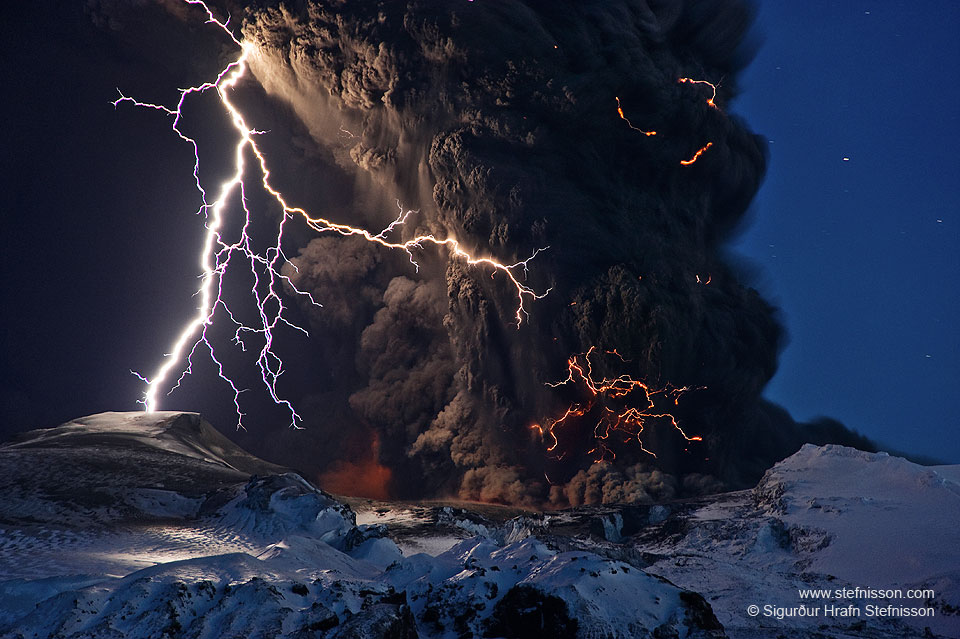 Why did a picturesque 2010 volcanic eruption in Iceland create so much ash? Although the large ash plume was not unparalleled in its abundance, its location was particularly noticeable because it drifted across such well-populated areas. The Eyjafjallajökull volcano in southern Iceland began erupting on 2010 March 20, with a second eruption starting under the center of a small glacier on 2010 April 14. Neither eruption was unusually powerful. The second eruption, however, melted a large amount of glacial ice which then cooled and fragmented lava into gritty glass particles that were carried up with the rising volcanic plume. Pictured above during the second eruption, lightning bolts illuminate ash pouring out of the Eyjafjallajökull volcano. April 19, 2014 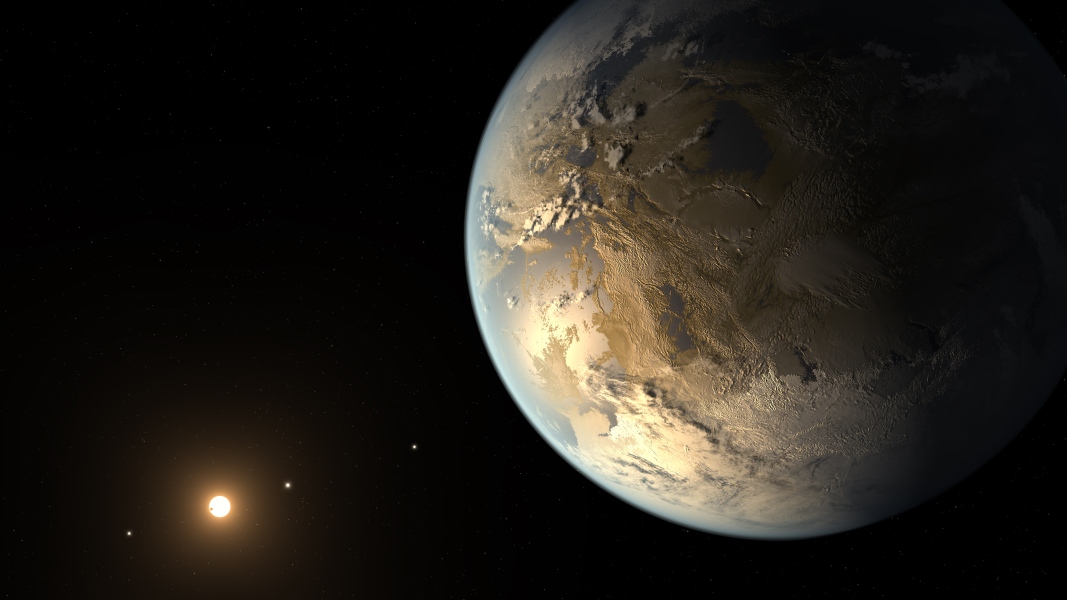 Planet Kepler-186f is the first known Earth-size planet to lie within the habitable zone of a star beyond the Sun. Discovered using data from the prolific planet-hunting Kepler spacecraft, the distant world orbits its parent star, a cool, dim, M dwarf star about half the size and mass of the Sun, some 500 light-years away in the constellation Cygnus. M dwarfs are common, making up about 70 percent of the stars in our Milky Way galaxy. To be within the habitable zone, where surface temperatures allowing liquid water are possible, Kepler-186f orbits close, within 53 million kilometers (about the Mercury-Sun distance) of the M dwarf star, once every 130 days. Four other planets are known in the distant system. All four are only a little larger than Earth and in much closer orbits, also illustrated in the tantalizing artist's vision. While the size and orbit of Kepler-186f are known, its mass and composition are not, and can't be determined by Kepler's transit technique. Still, models suggest that it could be rocky and have an atmosphere, making it potentially the most Earth-like exoplanet discovered so far ... April 18, 2014 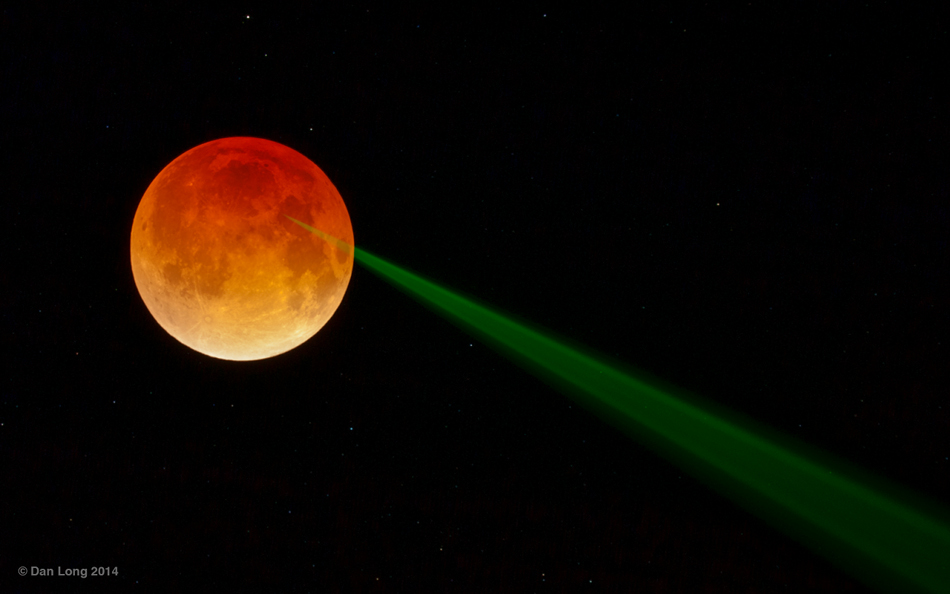 This is not a scene from a sci-fi special effects movie. The green beam of light and red lunar disk are real enough, captured in the early morning hours of April 15. Of course, the reddened lunar disk is easy to explain as the image was taken during this week's total lunar eclipse. Immersed in shadow, the eclipsed Moon reflects the dimmed reddened light of all the sunsets and sunrises filtering around the edges of planet Earth, seen in silhouette from a lunar perspective. But the green beam of light really is a laser. Shot from the 3.5-meter telescope at Apache Point Observatory in southern New Mexico, the beam's path is revealed as Earth's atmosphere scatters some of the intense laser light. The laser's target is the Apollo 15 retroreflector, left on the Moon by the astronauts in 1971. By determining the light travel time delay of the returning laser pulse, the experimental team from UC San Diego is able to measure the Earth-Moon distance to millimeter precision and provide a test of General Relativity, Einstein's theory of gravity. Conducting the lunar laser ranging experiment during a total eclipse uses the Earth like a cosmic light switch. With direct sunlight blocked, the reflector's performance is improved over performance when illuminated by sunlight during a normal Full Moon, an effect fondly known as The Full Moon Curse. April 17, 2014  Recorded on April 15th, this total lunar eclipse sequence looks south down icy Waterton Lake from the Waterton Lakes National Park in Alberta, Canada, planet Earth. The most distant horizon includes peaks in Glacier National Park, USA. An exposure every 10 minutes captured the Moon's position and eclipse phase, as it arced, left to right, above the rugged skyline and Waterton town lights. In fact, the sequence effectively measures the roughly 80 minute duration of the total phase of the eclipse. Around 270 BC, the Greek astronomer Aristarchus also measured the duration of lunar eclipses - though probably without the benefit of digital clocks and cameras. Still, using geometry, he devised a simple and impressively accurate way to calculate the Moon's distance, in terms of the radius of planet Earth, from the eclipse duration. This modern eclipse sequence also tracks the successive positions of Mars, above and right of the Moon, bright star Spica next to the reddened lunar disk, and Saturn to the left and below. April 16, 2014  A beautiful, reddened Moon slid through dark skies on April 15, completely immersed in Earth's shadow for well over an hour. It was the year's first total lunar eclipse and was widely enjoyed over the planet's Western Hemisphere. Seen from the Caribbean island of Barbados, the dimmed lunar disk is captured during totality in this colorful skyview. The dark Moon's red color contrasts nicely with bright bluish star Spica, alpha star of the constellation Virgo, posing only about two degrees away. Brighter than Spica and about 10 degrees from the Moon on the right, Mars is near opposition and closest approach to Earth. The Red Planet's own ruddy hue seems to echo the color of the eclipsed Moon. April 15, 2014  NASA's Cassini spacecraft has documented the formation of a small icy object within the rings of Saturn that may be a new moon, and may also provide clues to the formation of the planet's known moons. Images taken with Cassini's narrow angle camera on April 15, 2013, show disturbances at the very edge of Saturn's A ring -- the outermost of the planet's large, bright rings. One of these disturbances is an arc about 20 percent brighter than its surroundings, 750 miles (1,200 kilometers) long and 6 miles (10 kilometers) wide. Scientists also found unusual protuberances in the usually smooth profile at the ring's edge. Scientists believe the arc and protuberances are caused by the gravitational effects of a nearby object. Details of the observations were published online today (April 14, 2014) by the journal Icarus. The object is not expected to grow any larger, and may even be falling apart. But the process of its formation and outward movement aids in our understanding of how Saturn's icy moons, including the cloud-wrapped Titan and ocean-holding Enceladus, may have formed in more massive rings long ago. It also provides insight into how Earth and other planets in our solar system may have formed and migrated away from our star, the sun. "We have not seen anything like this before," said Carl Murray of Queen Mary University of London, the report's lead author. "We may be looking at the act of birth, where this object is just leaving the rings and heading off to be a moon in its own right." The object, informally named Peggy, is too small to be seen in images so far. Scientists estimate it is probably no more than about a half mile (about a kilometer) in diameter. Saturn's icy moons range in size depending on their proximity to the planet -- the farther from the planet, the larger. And many of Saturn's moons are composed primarily of ice, as are the particles that form Saturn's rings. Based on these facts, and other indicators, researchers recently proposed that the icy moons formed from ring particles and then moved outward, away from the planet, merging with other moons on the way. April 14, 2014  Is there a monster in IC 1396? Known to some as the Elephant's Trunk Nebula, parts of gas and dust clouds of this star formation region may appear to take on foreboding forms, some nearly human. The only real monster here, however, is a bright young star too far from Earth to hurt us. Energetic light from this star is eating away the dust of the dark cometary globule near the top of the above image. Jets and winds of particles emitted from this star are also pushing away ambient gas and dust. Nearly 3,000 light-years distant, the relatively faint IC 1396 complex covers a much larger region on the sky than shown here, with an apparent width of more than 10 full moons. April 13, 2014 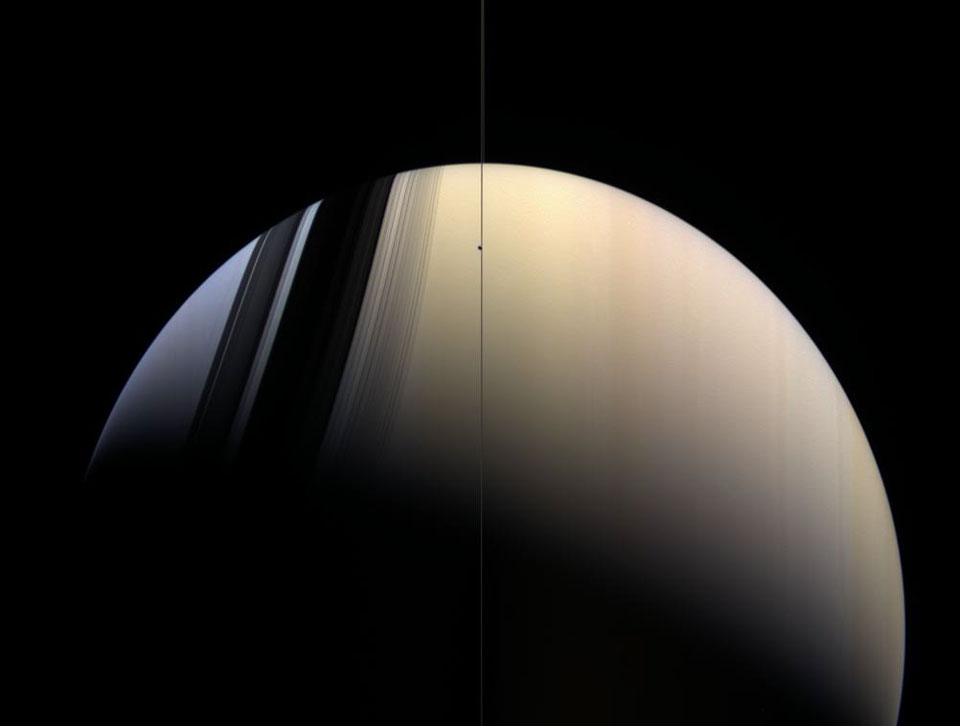 Why is Saturn partly blue? The above picture of Saturn approximates what a human would see if hovering close to the giant ringed world. The above picture was taken in 2006 March by the robot Cassini spacecraft now orbiting Saturn. Here Saturn's majestic rings appear directly only as a thin vertical line. The rings show their complex structure in the dark shadows they create on the image left. Saturn's fountain moon Enceladus, only about 500 kilometers across, is seen as the bump in the plane of the rings. The northern hemisphere of Saturn can appear partly blue for the same reason that Earth's skies can appear blue -- molecules in the cloudless portions of both planet's atmospheres are better at scattering blue light than red. When looking deep into Saturn's clouds, however, the natural gold hue of Saturn's clouds becomes dominant. It is not known why southern Saturn does not show the same blue hue -- one hypothesis holds that clouds are higher there. It is also not known why Saturn's clouds are colored gold. April 12, 2014  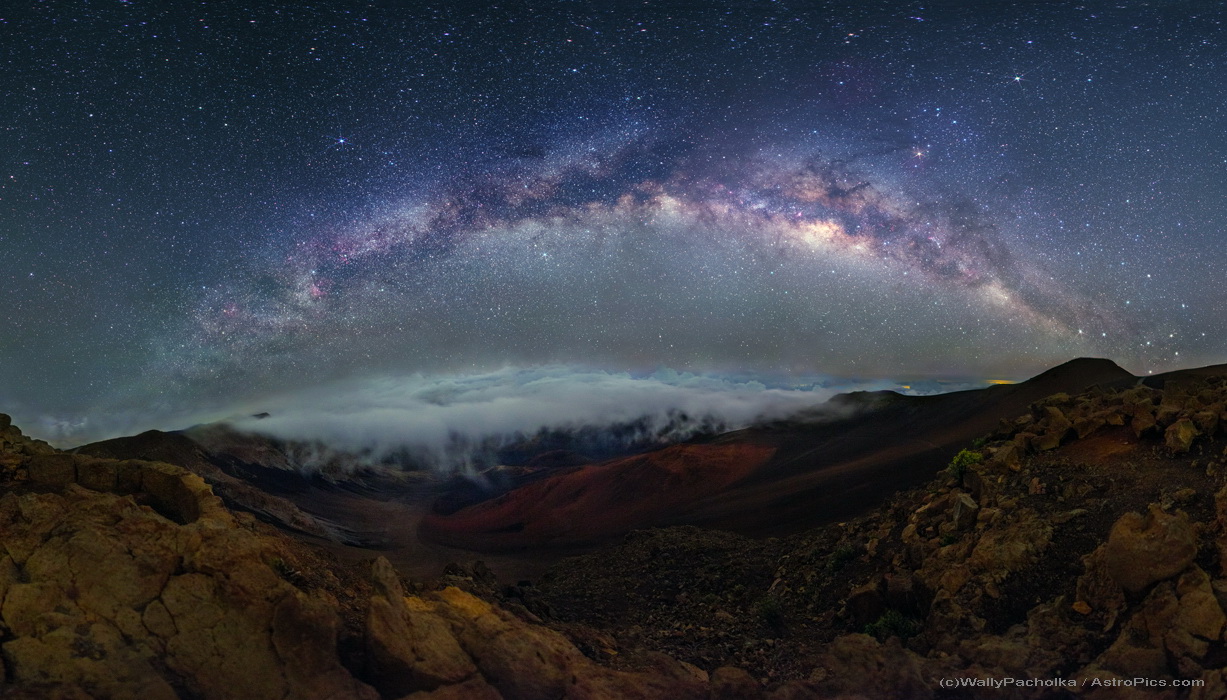 Aloha and welcome to a breathtaking skyscape. The dreamlike panoramic view from March 27 looks out over the 10,000 foot summit of Haleakala on Maui, Hawai'i. A cloud layer seeps over the volcanic caldera's edge with the Milky Way and starry night sky above. Head of the Northern Cross asterism, supergiant star Deneb lurks within the Milky Way's dust clouds and nebulae at the left. From there you can follow the arc of the Milky Way all the way to the stars of the more compact Southern Cross, just above the horizon at the far right. A yellowish Mars is right of center, near the top of the frame, with rival red giant Antares below it, closer to the Milky Way's central bulge. April 11, 2014 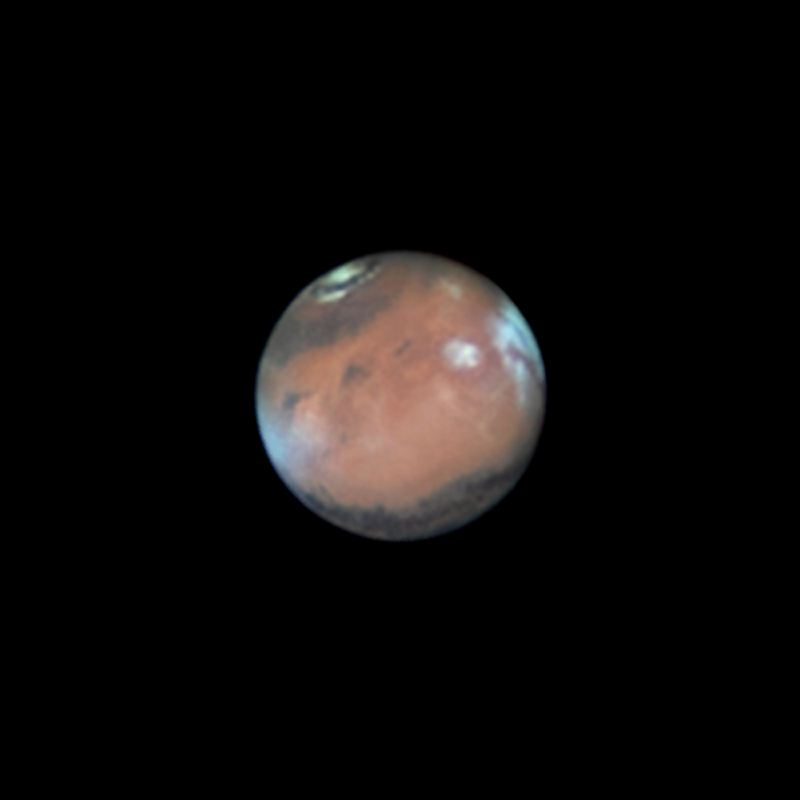 Tonight Mars is between opposition (April 8) and closest approach (April 14) looping through the constellation Virgo opposite the Sun in the night sky. That makes it prime season for telescopic views of the the Red Planet, like this one from April 3rd. The clear, sharp image was captured with a high-speed digital camera and 16-inch diameter telescope from Assis, Brazil, Planet Earth. Mars' north polar cap is at the top left. Also visible are whitish orographic clouds - water vapor clouds condensing in the cold atmosphere above the peaks of Mars' towering volcanos. The exact dates of closest approach and opposition are slightly different because of the planet's elliptical orbit. Still, get your telescope out on the night of closest approach (April 14/15) and you can view both Mars and a total eclipse of the Moon. Mars will be about 1/100th the angular size of the Moon. April 10, 2014 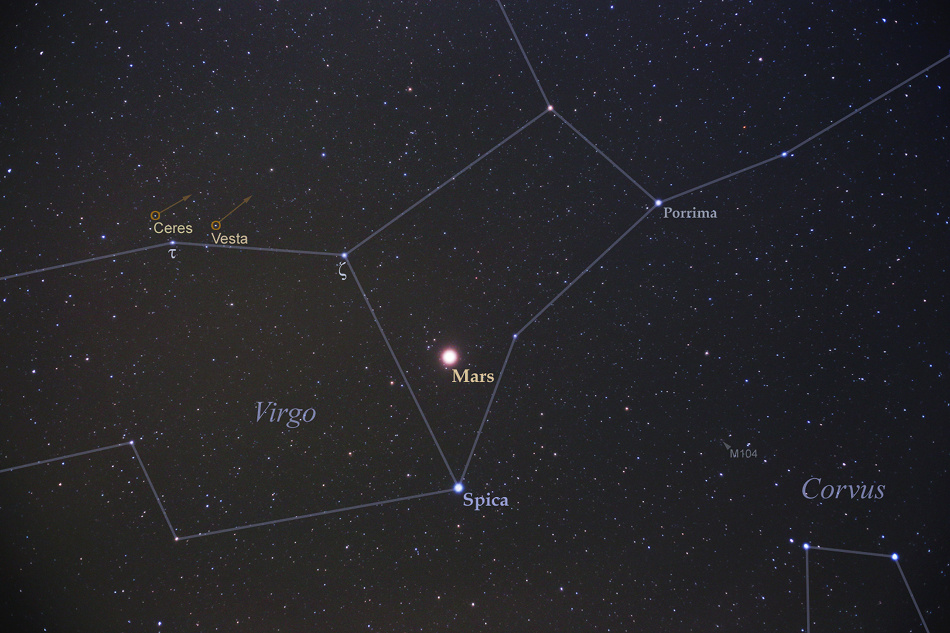 That bright, ruddy star you've recently noticed rising just after sunset isn't a star at all. That's Mars, the Red Planet. Mars is now near its 2014 opposition (April 8) and closest approach (April 14), looping through the constellation Virgo opposite the Sun in planet Earth's sky. Clearly outshining bluish Spica, alpha star of Virgo, Mars is centered in this labeled skyview from early April, that includes two other solar system worlds approaching their opposition. On the left, small and faint asteroid Vesta and dwarf planet Ceres are seen near star Tau Virginis. But you'll just have to imagine NASA's Dawn spacecraft cruising between the small worlds. Having left Vesta in September of 2012, Dawn's ion engine has been steadily driving it to match orbits with Ceres, scheduled to arrive there in February 2015. Of course, you can also look near Mars for the Moon opposite the Sun in Earth's sky on the night of April 14/15 ... and see a total lunar eclipse. April 9, 2014 Source: Asteroids can have rings. In a surprising discovery announced two weeks ago, the distant asteroid 10199 Chariklo was found to have at least two orbiting rings. Chariklo's diameter of about 250 kilometers makes it the largest of the measured centaur asteroids, but now the smallest known object to have rings. The centaur-class minor planet orbits the Sun between Saturn and Uranus. The above video gives an artist's illustration of how the rings were discovered. As Chariklo passed in 2013 in front of a faint star, unexpected but symmetric dips in the brightness of the star revealed the rings. Planetary astronomers are now running computer simulations designed to investigate how Chariklo's unexpected ring system might have formed, how it survives, and given the asteroid's low mass and close passes of other small asteroids and the planet Uranus, how long it may last. April 8, 2014 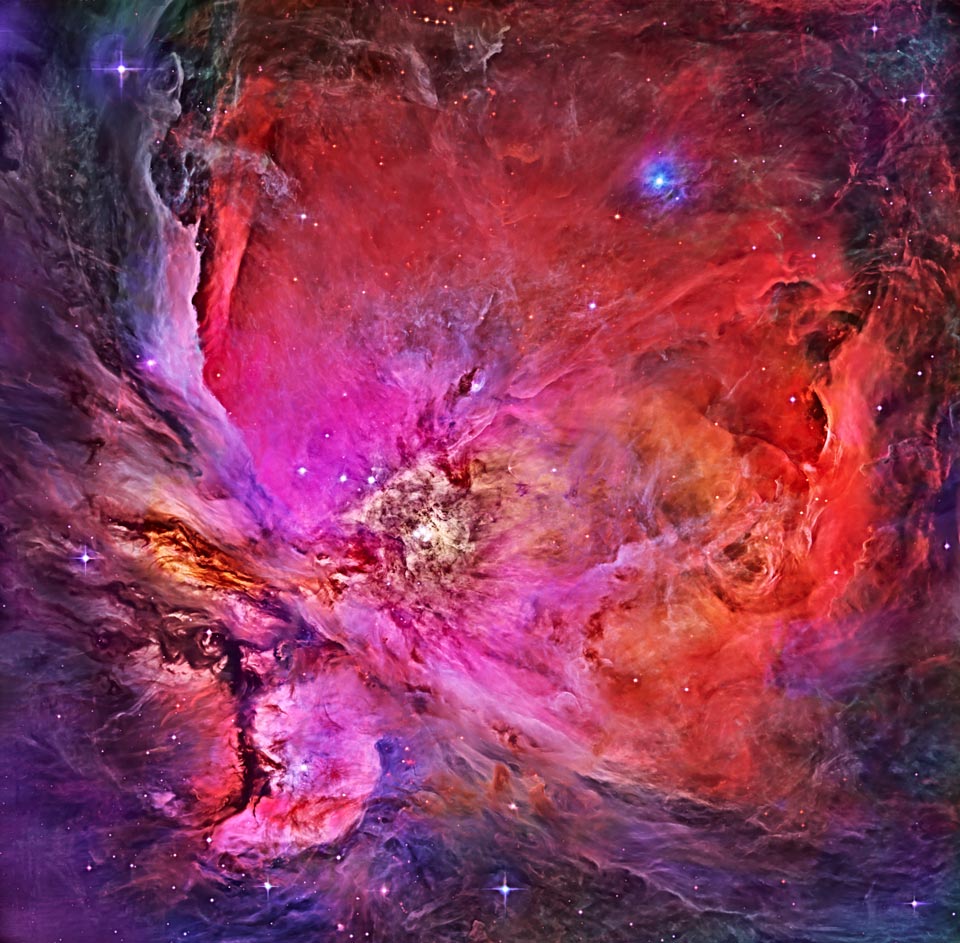 The Great Nebula in Orion, an immense, nearby starbirth region, is probably the most famous of all astronomical nebulas. Here, glowing gas surrounds hot young stars at the edge of an immense interstellar molecular cloud only 1500 light-years away. In the above deep image composite in assigned colors taken by the Hubble Space Telescope wisps and sheets of dust and gas are particularly evident. The Great Nebula in Orion can be found with the unaided eye near the easily identifiable belt of three stars in the popular constellation Orion. In addition to housing a bright open cluster of stars known as the Trapezium, the Orion Nebula contains many stellar nurseries. These nurseries contain much hydrogen gas, hot young stars, proplyds, and stellar jets spewing material at high speeds. Also known as M42, the Orion Nebula spans about 40 light years and is located in the same spiral arm of our Galaxy as the Sun. April 7, 2014  Has a solar eclipse ever been seen from the Moon? Yes, first in 1967 -- but it may happen again next week. The robotic Surveyor 3 mission took thousands of wide angle television images of the Earth in 1967, a few of which captured the Earth moving in front of the Sun. Several of these images have been retrieved from the NASA archives and compiled into the above time-lapse video. Although the images are grainy, the Earth's atmosphere clearly refracted sunlight around it and showed a beading effect when some paths were blocked by clouds. Two years later, in 1969, the Apollo 12 crew saw firsthand a different eclipse of the Sun by the Earth on the way back from the Moon. In 2009, Japan's robotic Kaguya spacecraft took higher resolution images of a similar eclipse while orbiting the Moon. Next week, however, China's Chang'e 3 mission, including its Yutu rover, might witness a new total eclipse of the Sun by the Earth from surface of the Moon. Simultaneously, from lunar orbit, NASA's LADEE mission might also capture the unusual April 15 event. Another angle of this same event will surely be visible to people on Earth -- a total lunar eclipse. April 6, 2014 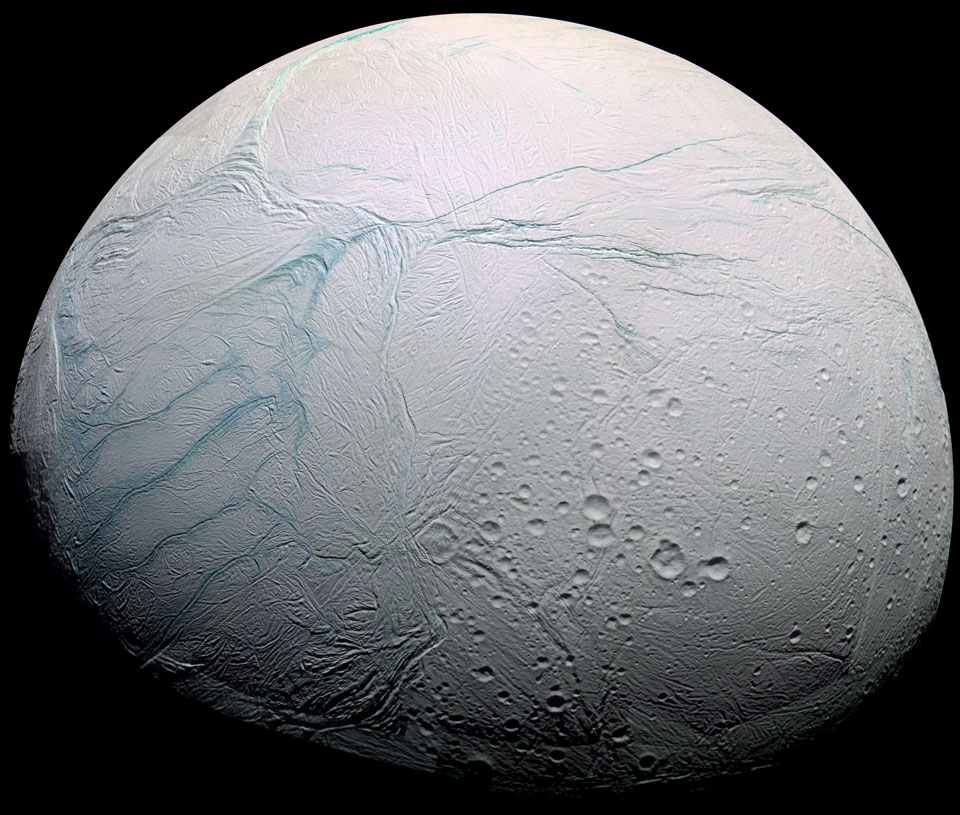 Do underground oceans vent through the tiger stripes on Saturn's moon Enceladus? Long features dubbed tiger stripes are known to be spewing ice from the moon's icy interior into space, creating a cloud of fine ice particles over the moon's South Pole and creating Saturn's mysterious E-ring. Evidence for this has come from the robot Cassini spacecraft now orbiting Saturn. Pictured above, a high resolution image of Enceladus is shown from a close flyby. The unusual surface features dubbed tiger stripes are visible in false-color blue. Why Enceladus is active remains a mystery, as the neighboring moon Mimas, approximately the same size, appears quite dead. Most recently, an analysis of slight gravity deviations has given an independent indication of underground oceans. Such research is particularly interesting since such oceans would be candidates to contain life. April 5, 2014  Tidally locked in synchronous rotation, the Moon always presents its familiar nearside to denizens of planet Earth. From lunar orbit, the Moon's farside can become familiar, though. In fact this sharp picture, a mosaic from the Lunar Reconnaissance Orbiter's wide angle camera, is centered on the lunar farside. Part of a global mosaic of over 15,000 images acquired between November 2009 and February 2011, the highest resolution version shows features at a scale of 100 meters per pixel. Surprisingly, the rough and battered surface of the farside looks very different from the nearside covered with smooth dark lunar maria. The likely explanation is that the farside crust is thicker, making it harder for molten material from the interior to flow to the surface and form the smooth maria. The link below is a direct link to the full resolution image which clocks in at 1.12GB in size and a massive 34748 x 34748 pixel frame. http://lroc.sese.asu.edu/data/pr/tiff/WAC_GL180.tif April 4, 2014  Delicate in appearance, these filaments of shocked, glowing gas, draped in planet Earth's sky toward the constellation of Cygnus, make up the western part of the Veil Nebula. The Veil Nebula itself is a large supernova remnant, an expanding cloud born of the death explosion of a massive star. Light from the original supernova explosion likely reached Earth over 5,000 years ago. Blasted out in the cataclysmic event, the interstellar shock wave plows through space sweeping up and exciting interstellar material. The glowing filaments are really more like long ripples in a sheet seen almost edge on, remarkably well separated into atomic hydrogen (red) and oxygen (blue-green) gas. Also known as the Cygnus Loop, the Veil Nebula now spans nearly 3 degrees or about 6 times the diameter of the full Moon. While that translates to over 70 light-years at its estimated distance of 1,500 light-years, this wide image of the western portion spans about half that distance. Brighter parts of the western Veil are recognized as separate nebulae, including The Witch's Broom (NGC 6960) along the top of this view and Pickering's Triangle (NGC 6979) below and right of center. April 3, 2014 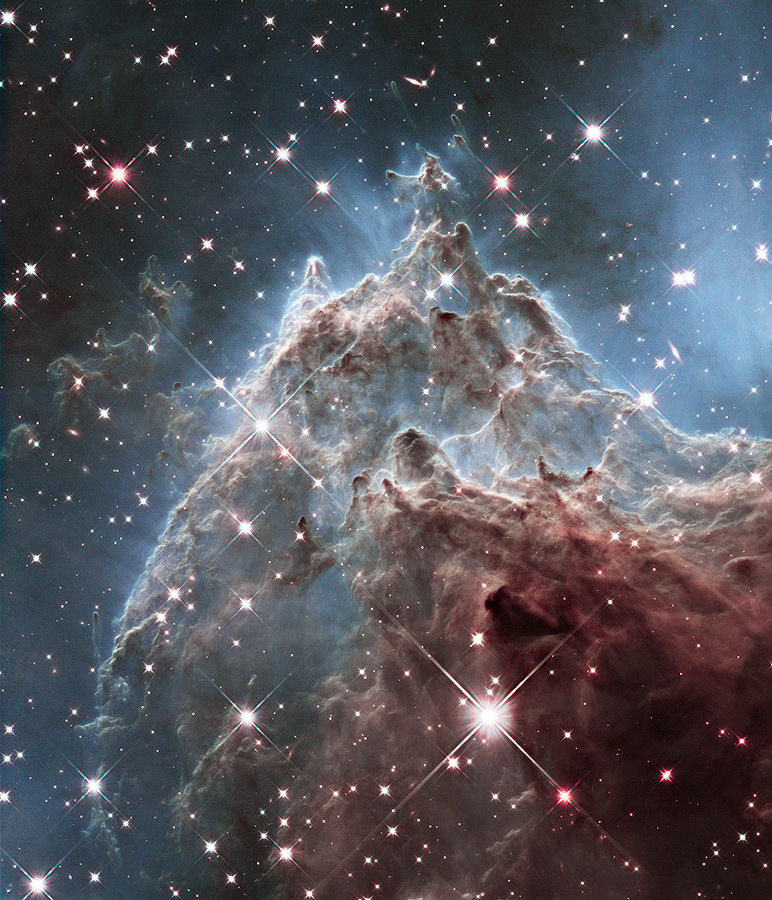 This fantastic skyscape lies near the edge of NGC 2174 a star forming region about 6,400 light-years away in the nebula-rich constellation of Orion. It follows mountainous clouds of gas and dust carved by winds and radiation from the region's newborn stars, now found scattered in open star clusters embedded around the center of NGC 2174, off the top of the frame. Though star formation continues within these dusty cosmic clouds they will likely be dispersed by the energetic newborn stars within a few million years. Recorded at infrared wavelengths by the Hubble Space Telescope, the interstellar scene spans about 6 light-years. The image celebrates the upcoming 24th anniversary of Hubble's launch onboard the space shuttle orbiter Discovery on April 24, 1990. April 2, 2014 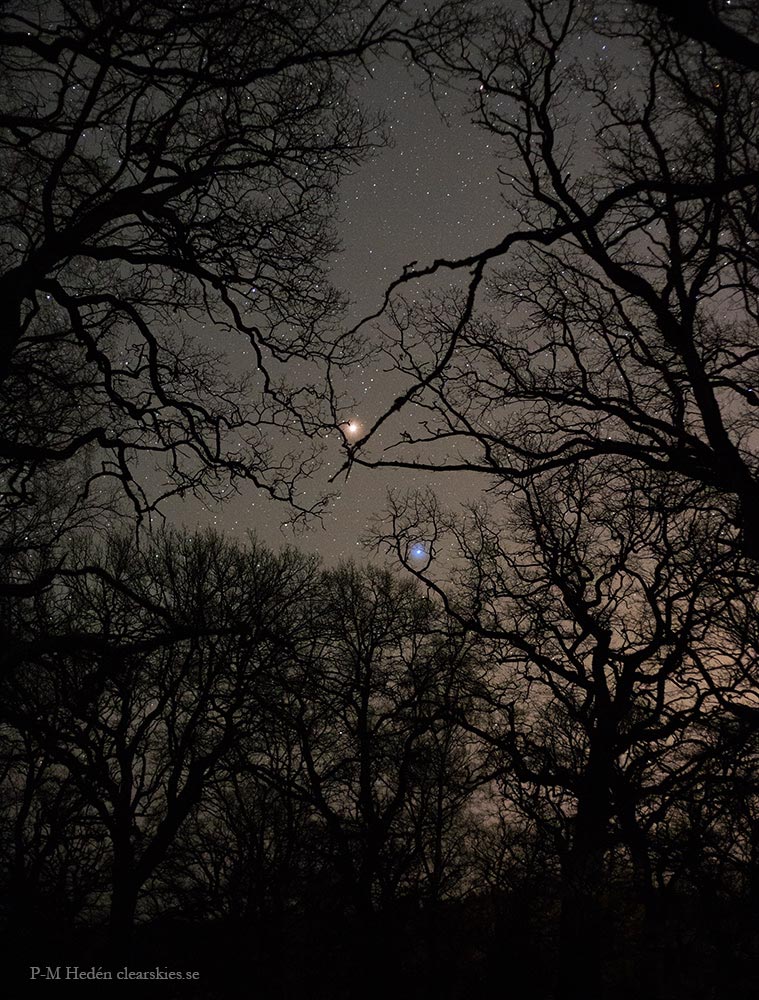 A bright pair of sky objects will be visible together during the next few months. Mars will shine brightly in its familiar rusty hue as it reaches its brightest of 2014 next week. The reason that Mars appears so bright is that Earth and Mars are close to each other in their long orbits around the Sun. Spica, on the other hand, shines constantly as one of the brightest blue stars in the night sky. Pronounced "spy-kah", the blue-hued star has been visible throughout human history and the sounds that identify it today date back to ancient times. Pictured above, the planet and the star were photographed rising together toward the southeast after sunset last week through old oak trees in Sweden. April 1, 2014 In the next 60 seconds you will be 300 km closer to the planet Mars. As April begins, Earth and Mars are converging at 5 km/s or 300 km/min for a close approach two weeks from now. This matrix of images, taken by Puerto Rican photographer Efrain Morales Rivera, shows how the Red Planet has grown in the eyepiece of his 12-inch telescope over the past month. Even the smallest of Rivera's images shows the martian North Polar Cap, orographic clouds over volcanoes near the equator, and a bright blue cloud filling Hellas Basin in the south. Only an experienced astrophotographer can produce this kind of Hubblesque detail using backyard optics. Novice observers looking through the eyepiece of a small telescope can still see a lot, however, including the rusty-red disk of Mars and bright smudges corresponding to the polar cap and Hellas Basin. Closest approach, Earth to Mars, occurs on April 14th at a distance of 92 million kilometers. Mark your calendar and get ready to see Mars at its best. March 31, 2014 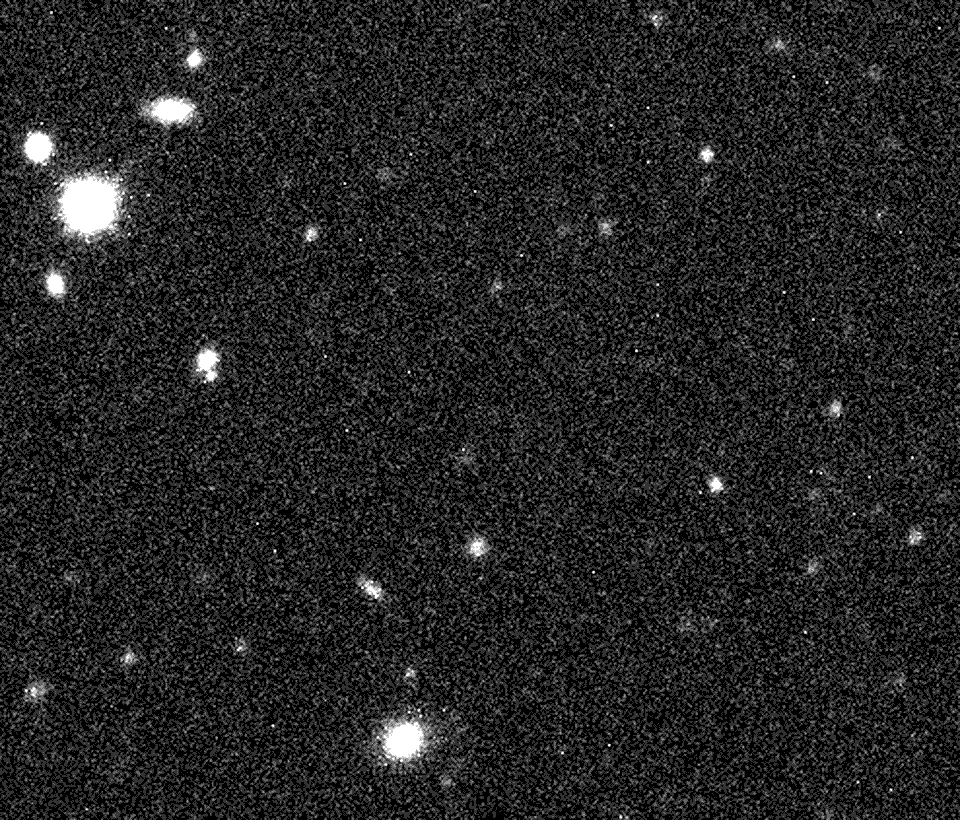 What is the furthest known object in our Solar System? The new answer is 2012 VP113, an object currently over twice the distance of Pluto from the Sun. Pictured above is a series of discovery images taken with the Dark Energy Camera attached to the NOAO's Blanco 4-meter Telescope in Chile in 2012 and released last week. The distant object, seen moving on the lower right, is thought to be a dwarf planet like Pluto. Previously, the furthest known dwarf planet was Sedna, discovered in 2003. Given how little of the sky was searched, it is likely that as many as 1,000 more objects like 2012 VP113 exist in the outer Solar System. 2012 VP113 is currently near its closest approach to the Sun, in about 2,000 years it will be over five times further. Some scientists hypothesize that the reason why objects like Sedna and 2012 VP113 have their present orbits is because they were gravitationally scattered there by a much larger object -- possibly a very distant undiscovered planet. March 30, 2014  The strangest moon in the Solar System is bright yellow. This picture, an attempt to show how Io would appear in the "true colors" perceptible to the average human eye, was taken in 1999 July by the Galileo spacecraft that orbited Jupiter from 1995 to 2003. Io's colors derive from sulfur and molten silicate rock. The unusual surface of Io is kept very young by its system of active volcanoes. The intense tidal gravity of Jupiter stretches Io and damps wobbles caused by Jupiter's other Galilean moons. The resulting friction greatly heats Io's interior, causing molten rock to explode through the surface. Io's volcanoes are so active that they are effectively turning the whole moon inside out. Some of Io's volcanic lava is so hot it glows in the dark. March 29, 2014  As dawn broke on March 27, the center of the Milky Way Galaxy stood almost directly above the European Southern Observatory's Paranal Observatory. In the dry, clear sky of Chile's Atacama desert, our galaxy's dusty central bulge is flanked by Paranal's four 8 meter Very Large Telescope units in this astronomical fisheye view. Along the top, Venus is close to the eastern horizon. The brilliant morning star shines very near a waning crescent Moon just at the edge of one of the telescope structures. Despite the bright pairing in the east, the Milky Way dominates the scene though. Cut by dust lanes and charged with clouds of stars and glowing nebulae, the center of our galaxy sprawls across the darker zenith even as the deep blue sky grows brighter and buildings still glint in moonlight. March 28, 2014 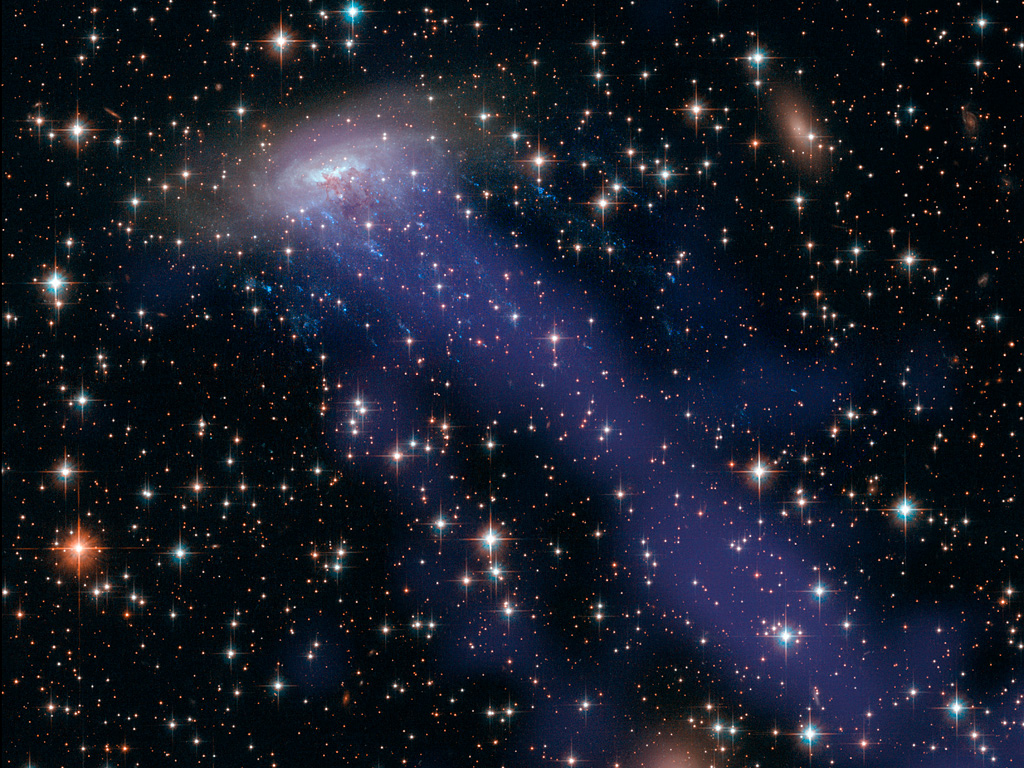 Spiral galaxy ESO 137-001 hurtles through massive galaxy cluster Abell 3627 some 220 million light years away. The distant galaxy is seen in this colorful Hubble/Chandra composite image through a foreground of the Milky Way's stars toward the southern constellation Triangulum Australe. As the spiral speeds along at nearly 7 million kilometers per hour, its gas and dust are stripped away when ram pressure with the cluster's own hot, tenuous intracluster medium overcomes the galaxy's gravity. Evident in Hubble's near visible light data, bright star clusters have formed in the stripped material along the short, trailing blue streaks. Chandra's X-ray data shows off the enormous extent of the heated, stripped gas as diffuse, darker blue trails stretching over 400,000 light-years toward the bottom right. The significant loss of dust and gas will make new star formation difficult for this galaxy. A yellowish elliptical galaxy, lacking in star forming dust and gas, is just to the right of ESO 137-001 in the frame. March 27, 2014  The first identified compact galaxy group, Stephan's Quintet is featured in this remarkable image constructed with data drawn from Hubble Legacy Archive and the Subaru Telescope on the summit of Mauna Kea. The galaxies of the quintet are gathered near the center of the field, but really only four of the five are locked in a cosmic dance of repeated close encounters taking place some 300 million light-years away. The odd man out is easy to spot, though. The interacting galaxies, NGC 7319, 7318A, 7318B, and 7317 have a more dominant yellowish cast. They also tend to have distorted loops and tails, grown under the influence of disruptive gravitational tides. The mostly bluish galaxy, NGC 7320, is in the foreground about 40 million light-years distant, and isn't part of the interacting group. Still, captured in this field above and to the left of Stephan's Quintet is another galaxy, NGC 7320C, that is also 300 million light-years distant. Of course, including it would bring the four interacting galaxies back up to quintet status. Stephan's Quintet lies within the boundaries of the high flying constellation Pegasus. At the estimated distance of the quintet's interacting galaxies, this field of view spans over 500,000 light-years. March 26, 2014 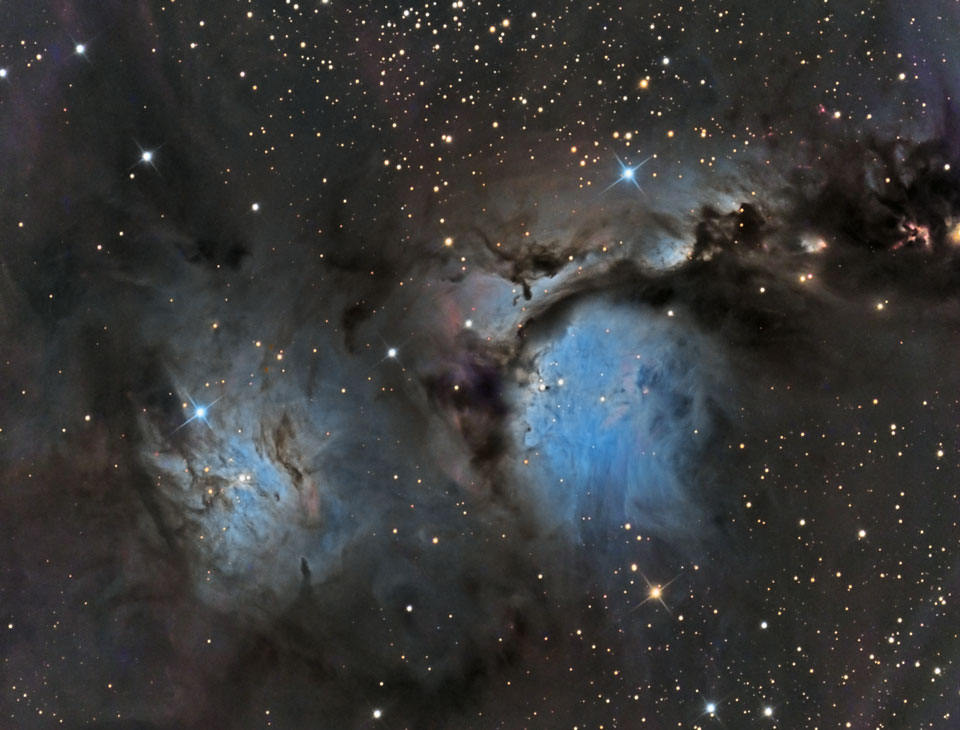 An eerie blue glow and ominous columns of dark dust highlight M78 and other bright reflection nebula in the constellation of Orion. The dark filamentary dust not only absorbs light, but also reflects the light of several bright blue stars that formed recently in the nebula. Of the two reflection nebulas pictured above, the more famous nebula is M78, in the image center, while NGC 2071 can be seen to its lower left. The same type of scattering that colors the daytime sky further enhances the blue color. M78 is about five light-years across and visible through a small telescope. M78 appears above only as it was 1600 years ago, however, because that is how long it takes light to go from there to here. M78 belongs to the larger Orion Molecular Cloud Complex that contains the Great Nebula in Orion and the Horsehead Nebula. March 25, 2014 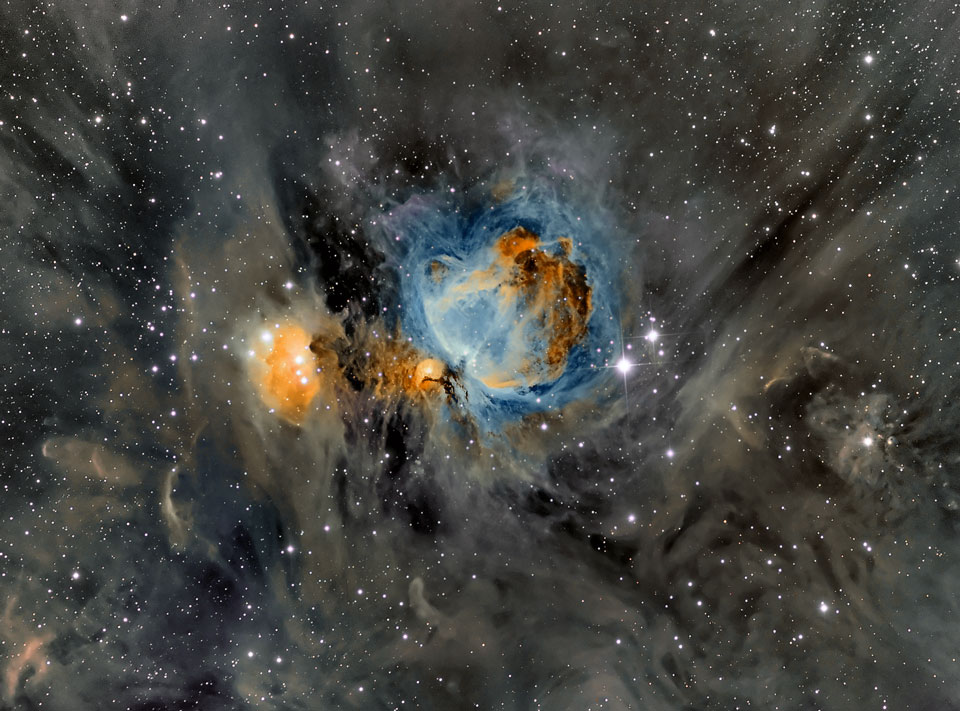 What surrounds a hotbed of star formation? In the case of the Orion Nebula -- dust. The entire Orion field, located about 1600 light years away, is inundated with intricate and picturesque filaments of dust. Opaque to visible light, dust is created in the outer atmosphere of massive cool stars and expelled by a strong outer wind of particles. The Trapezium and other forming star clusters are embedded in the nebula. The intricate filaments of dust surrounding M42 and M43 appear gray in the above image, while central glowing gas is highlighted in brown and blue. Over the next few million years much of Orion's dust will be slowly destroyed by the very stars now being formed, or dispersed into the Galaxy. March 24, 2014  If you see a sky like this -- photograph it. A month ago in Iceland, an adventurous photographer (pictured) chanced across a sky full of aurora and did just that. In the foreground lies the stratovolcano Öræfajökull. In the background, among other sky delights, lies the constellation of Orion, visible to the aurora's left. Auroras are sparked by energetic particles from the Sun impacting the magnetic environment around the Earth. Resultant energetic particles such as electrons and protons rain down near the Earth's poles and impact the air. The impacted air molecules obtain excited electrons, and when electrons in oxygen molecules fall back to their ground state, they emit green light. Auroras are known to have many shapes and colors. March 23, 2014  In the center of a swirling whirlpool of hot gas is likely a beast that has never been seen directly: a black hole. Studies of the bright light emitted by the swirling gas frequently indicate not only that a black hole is present, but also likely attributes. The gas surrounding GRO J1655-40, for example, has been found to display an unusual flickering at a rate of 450 times a second. Given a previous mass estimate for the central object of seven times the mass of our Sun, the rate of the fast flickering can be explained by a black hole that is rotating very rapidly. What physical mechanisms actually cause the flickering -- and a slower quasi-periodic oscillation (QPO) -- in accretion disks surrounding black holes and neutron stars remains a topic of much research. March 22, 2014  Deep shadows create dramatic contrasts between light and dark in this high-resolution close-up of the martian surface. Recorded on January 24 by the HiRISE camera onboard the Mars Reconnaissance Orbiter, the scene spans about 1.5 kilometers across a sand dune field in a southern highlands crater. Captured when the Sun was just 5 degrees above the local horizon, only the dune crests are caught in full sunlight. With the long, cold winter approaching the red planet's southern hemisphere, bright ridges of seasonal frost line the martian dunes. March 21, 2014 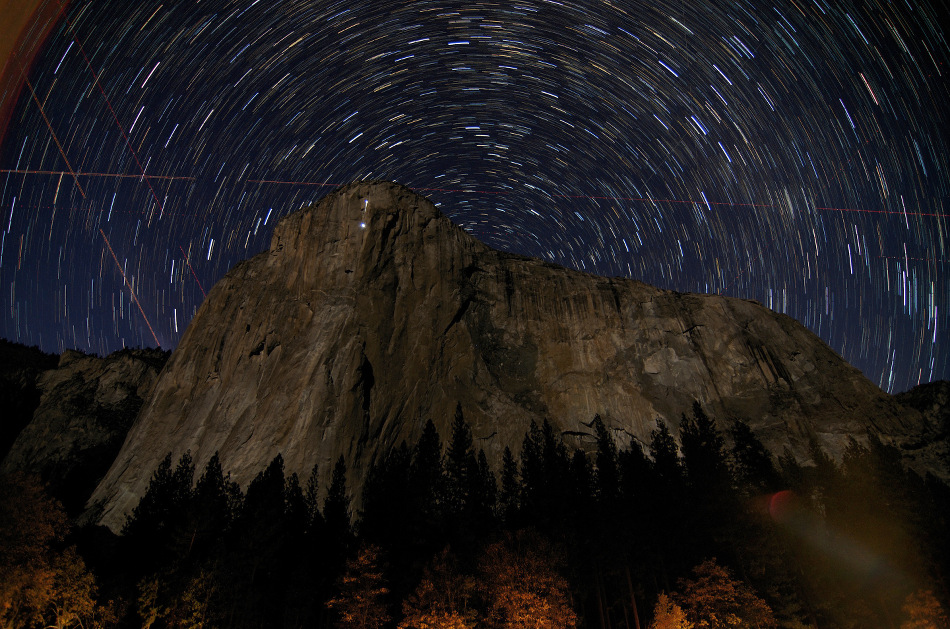 Towering 3,000 feet from base to summit, the famous granite face of El Capitan in Earth's Yosemite National Park just hides the planet's north celestial pole in this skyscape. Of course, the north celestial pole is at the center of all the star trails. Their short arcs reflecting the planet's daily rotation on its axis are traced in a digital stack of 36 sequential exposures. Linear trails of passing airplane navigation lights and a flare from car lights along the road below are also captured in the sequential stack. But the punctuated trail of light seen against the sheer El Capitan itself follows a climbing team on the night of November 8, 2013. The team is ascending toward the summit along The Nose, a historic rock climbing route. March 20, 2014 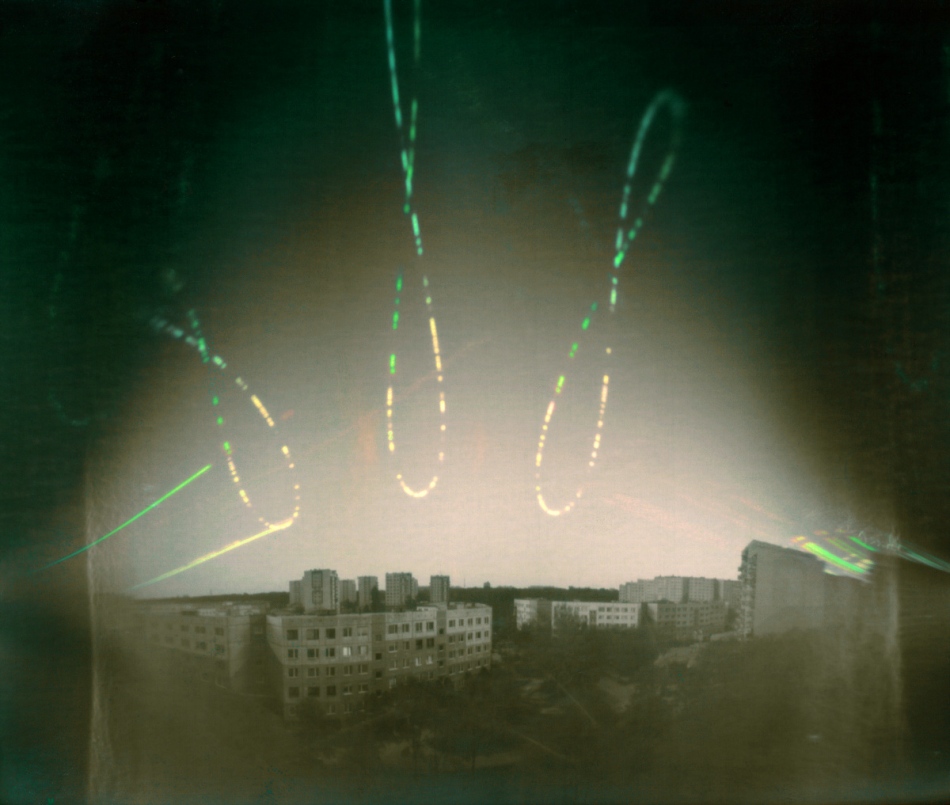 Today is the equinox. The Sun crosses the celestial equator heading north at 16:57 UT, marking the northern hemisphere's first day of spring. To celebrate, consider this remarkable image following the Sun's yearly trek through planet Earth's sky, the first analemmas exposed every day through the technique of solargraphy. In fact, three analemma curves were captured using a cylindrical pinhole camera by daily making three, separate, one minute long exposures for a year, from March 1, 2013 to March 1, 2014, on a single piece of black and white photographic paper. The well-planned daily exposures began at 10:30, 12:00, and 13:30, CET from a balcony looking south from the Kozanów district in Wrocław, Poland. That year's two equinoxes on March 20 and September 22 correspond to the mid-points, not the cross-over points, along the figure-8 shaped curves. Apparent gaps in the curves are due to cloudy days. Two solid lines at the lower left were both caused by a timer switch failure that left the pinhole shutter open. March 19, 2014 When does the line between day and night become vertical? Tomorrow. Tomorrow is an equinox on planet Earth, a time of year when day and night are most nearly equal. At an equinox, the Earth's terminator -- the dividing line between day and night -- becomes vertical and connects the north and south poles. The above time-lapse video demonstrates this by displaying an entire year on planet Earth in twelve seconds. From geosynchronous orbit, the Meteosat satellite recorded these infrared images of the Earth every day at the same local time. The video started at the September 2010 equinox with the terminator line being vertical. As the Earth revolved around the Sun, the terminator was seen to tilt in a way that provides less daily sunlight to the northern hemisphere, causing winter in the north. As the year progressed, the March 2011 equinox arrived halfway through the video, followed by the terminator tilting the other way, causing winter in the southern hemisphere -- and summer in the north. The captured year ends again with the September equinox, concluding another of billions of trips the Earth has taken -- and will take -- around the Sun. March 18, 2014  Did the universe undergo an early epoch of extremely rapid expansion? Such an inflationary epoch has been postulated to explain several puzzling cosmic attributes such as why our universe looks similar in opposite directions. Yesterday, results were released showing an expected signal of unexpected strength, bolstering a prediction of inflation that specific patterns of polarization should exist in cosmic microwave background radiation -- light emitted 13.8 billion years ago as the universe first became transparent. Called B-mode polarizations, these early swirling patterns can be directly attributed to squeeze and stretch effects that gravitational radiation has on photon-emitting electrons. The surprising results were discovered in data from the Background Imaging of Cosmic Extragalactic Polarization 2 (BICEP2) microwave observatory near the South Pole. BICEP2 is the building-mounted dish pictured above on the left. Note how the black polarization vectors appear to swirl around the colored temperature peaks on the inset microwave sky map. Although statistically compelling, the conclusions will likely remain controversial while confirmation attempts are made with independent observations. March 17, 2014 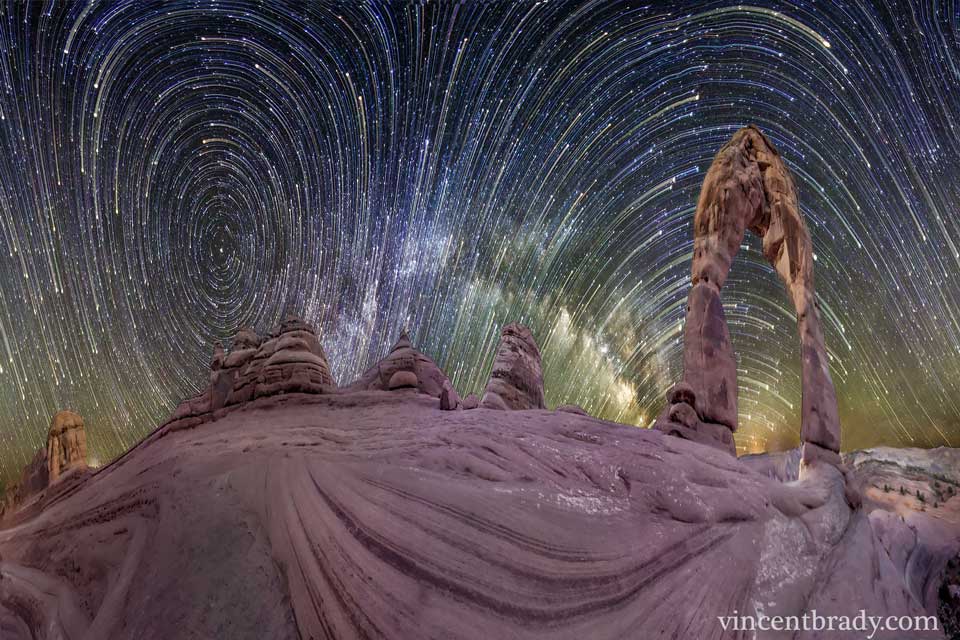 What's happened to the sky? A time warp, of sorts, and a digital space warp too. The time warp occurs because this image captured in a single frame a two and a half hour exposure of the night sky. As a result, prominent star trails are visible. The space warp occurs because the picture is actually a full 360 degree panorama, horizontally compressed to fit your browser. As the Earth rotated, stars appeared to circle both the North Celestial Pole, on the left, and the South Celestial Pole, just below the horizon on the right. The above panorama over Arches National Park in Utah, USA, was captured two weeks ago during early morning hours. While the eye-catching texture of ancient layered sandstone covers the image foreground, twenty-meter tall Delicate Arch is visible on the far right, and the distant arch of our Milky Way Galaxy is visible near the image center. March 16, 2014 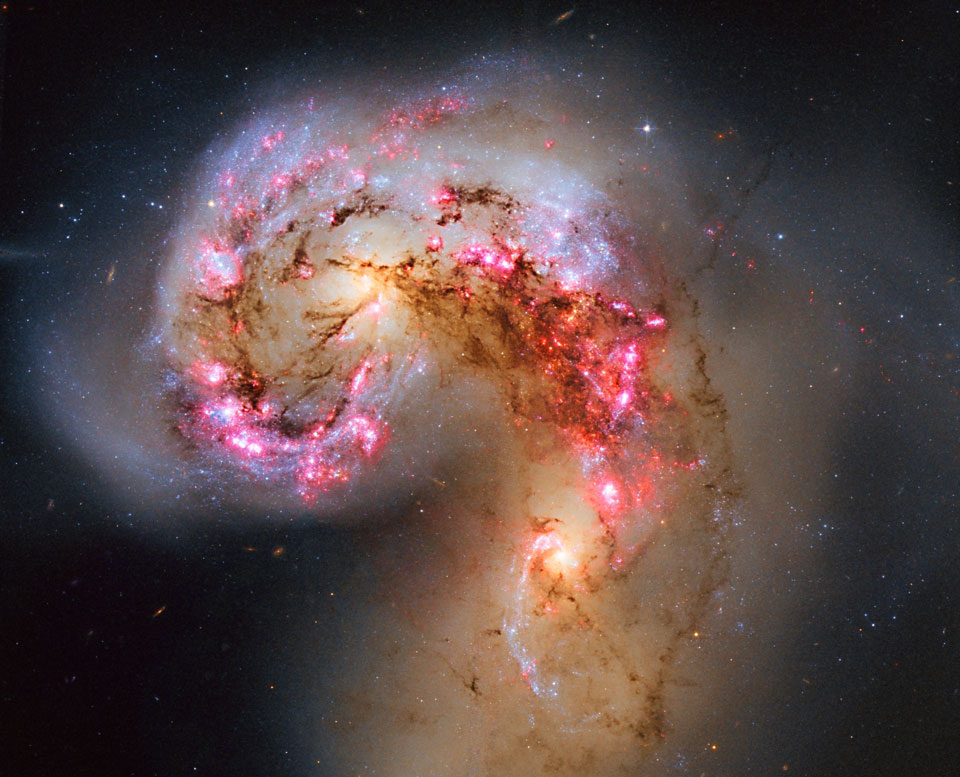 Two galaxies are squaring off in Corvus and here are the latest pictures. When two galaxies collide, the stars that compose them usually do not. That's because galaxies are mostly empty space and, however bright, stars only take up only a small amount of that space. During the slow, hundred million year collision, one galaxy can still rip the other apart gravitationally, and dust and gas common to both galaxies does collide. In this clash of the titans, dark dust pillars mark massive molecular clouds are being compressed during the galactic encounter, causing the rapid birth of millions of stars, some of which are gravitationally bound together in massive star clusters. March 15, 2014  Get out your red/blue glasses and check out this stereo scene from Taurus-Littrow valley on the Moon! The color anaglyph features a detailed 3D view of Apollo 17's Lunar Rover in the foreground -- behind it lies the Lunar Module and distant lunar hills. Because the world was going to be able to watch the Lunar Module's ascent stage liftoff via the rover's TV camera, this parking place was also known as the VIP Site. In December of 1972, Apollo 17 astronauts Eugene Cernan and Harrison Schmitt spent about 75 hours on the Moon, while colleague Ronald Evans orbited overhead. The crew returned with 110 kilograms of rock and soil samples, more than from any of the other lunar landing sites. Cernan and Schmitt are still the last to walk (or drive) on the Moon. March 14, 2014  NGC 2685 is a confirmed polar ring galaxy - a rare type of galaxy with stars, gas and dust orbiting in rings perpendicular to the plane of a flat galactic disk. The bizarre configuration could be caused by the chance capture of material from another galaxy by a disk galaxy, with the captured debris strung out in a rotating ring. Still, observed properties of NGC 2685 suggest that the rotating ring structure is remarkably old and stable. In this sharp view of the peculiar system also known as Arp 336 or the Helix galaxy, the strange, perpendicular rings are easy to trace as they pass in front of the galactic disk, along with other disturbed outer structures. NGC 2685 is about 50,000 light-years across and 40 million light-years away in the constellation Ursa Major. March 13, 2014 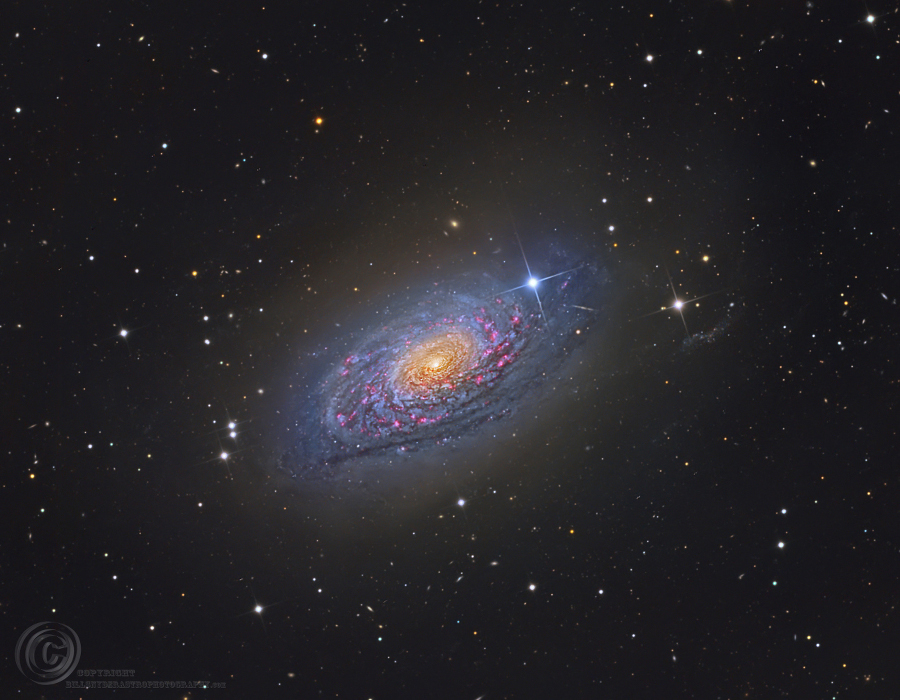 A bright spiral galaxy of the northern sky, Messier 63 is about 25 million light-years distant in the loyal constellation Canes Venatici. Also cataloged as NGC 5055, the majestic island universe is nearly 100,000 light-years across. That's about the size of our own Milky Way Galaxy. Known by the popular moniker, The Sunflower Galaxy, M63 sports a bright yellowish core in this sharp, colorful galaxy portrait. Its sweeping blue spiral arms are streaked with cosmic dust lanes and dotted with pink star forming regions. A dominant member of a known galaxy group, M63 has faint, extended features that could be the result of gravitational interactions with nearby galaxies. In fact, M63 shines across the electromagnetic spectrum and is thought to have undergone bursts of intense star formation. March 12, 2014 Does the Sun change as it rotates? Yes, and the changes can vary from subtle to dramatic. In the above time-lapse sequences, our Sun -- as imaged by NASA's Solar Dynamics Observatory -- is shown rotating though the entire month of January. In the large image on the left, the solar chromosphere is depicted in ultraviolet light, while the smaller and lighter image to its upper right simultaneously shows the more familiar solar photosphere in visible light. The rest of the inset six Sun images highlight X-ray emission by relatively rare iron atoms located at different heights of the corona, all false-colored to accentuate differences. The Sun takes just under a month to rotate completely -- rotating fastest at the equator. A large and active sunspot region rotates into view soon after the video starts. Subtle effects include changes in surface texture and the shapes of active regions. Dramatic effects include numerous flashes in active regions, and fluttering and erupting prominences visible all around the Sun's edge. This year our Sun is near its Solar maximum activity of its 11-year magnetic cycle. As the video ends, the same large and active sunspot region previously mentioned rotates back into view, this time looking differently. March 11, 2014  In the heart of the Rosette Nebula lies a bright open cluster of stars that lights up the nebula. The stars of NGC 2244 formed from the surrounding gas only a few million years ago. The above image taken in January using multiple exposures and very specific colors of Sulfur (shaded red), Hydrogen (green), and Oxygen (blue), captures the central region in tremendous detail. A hot wind of particles streams away from the cluster stars and contributes to an already complex menagerie of gas and dust filaments while slowly evacuating the cluster center. The Rosette Nebula's center measures about 50 light-years across, lies about 4,500 light-years away, and is visible with binoculars towards the constellation of the Unicorn (Monoceros). March 10, 2014 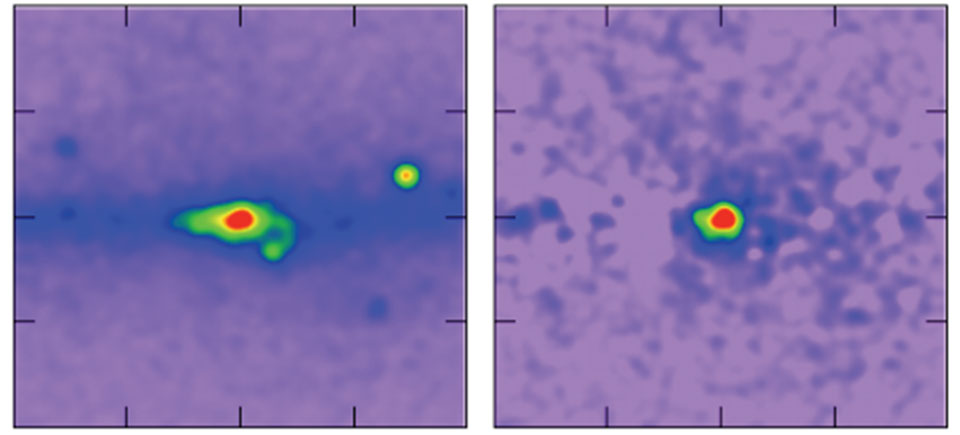 What is creating the gamma rays at the center of our Galaxy? Excitement is building that one answer is elusive dark matter. Over the past few years the orbiting Fermi Gamma-ray Space Telescope has been imaging our Galaxy's center in gamma-rays. Repeated detailed analyses indicate that the region surrounding the Galactic center seems too bright to be accounted by known gamma-ray sources. A raw image of the Galactic Center region in gamma-rays is shown above on the left, while the image on the right has all known sources subtracted -- leaving an unexpected excess. An exciting hypothetical model that seems to fit the excess involves a type of dark matter known as WIMPs, which may be colliding with themselves to create the detected gamma-rays. This hypothesis is controversial, however, and debate and more detailed investigations are ongoing. Finding the nature of dark matter is one of the great quests of modern science, as previously this unusual type of cosmologically pervasive matter has shown itself only through gravitation. The hypothesis can be found here: https://www.simonsfoundation.org/qua...l-strengthens/ March 9, 2014 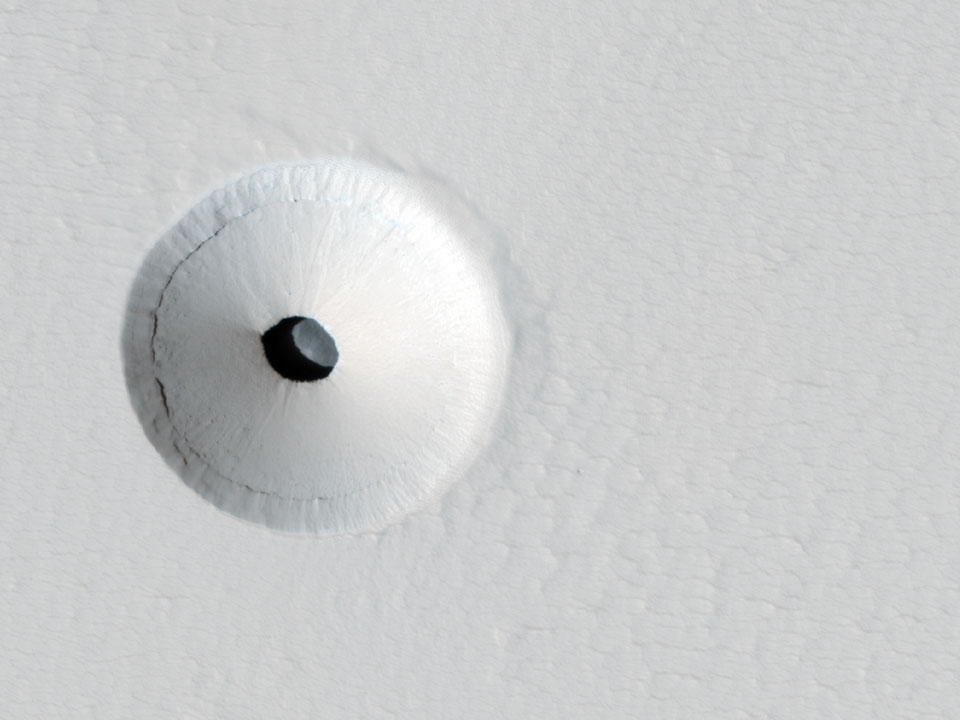 What created this unusual hole in Mars? The hole was discovered by chance in 2011 on images of the dusty slopes of Mars' Pavonis Mons volcano taken by the HiRISE instrument aboard the robotic Mars Reconnaissance Orbiter currently circling Mars. The hole appears to be an opening to an underground cavern, partly illuminated on the image right. Analysis of this and follow-up images revealed the opening to be about 35 meters across, while the interior shadow angle indicates that the underlying cavern is roughly 20 meters deep. Why there is a circular crater surrounding this hole remains a topic of speculation, as is the full extent of the underlying cavern. Holes such as this are of particular interest because their interior caves are relatively protected from the harsh surface of Mars, making them relatively good candidates to contain Martian life. These pits are therefore prime targets for possible future spacecraft, robots, and even human interplanetary explorers. March 8, 2014  Get out your red/blue glasses (red for the left eye) and look out over this expansive martian landscape. The panoramic stereo view is composed of images from the roving Curiosity's Navcam taken at a rest stop during a 100 meter drive on Sol 548 (February 19). The 5.5 kilometer high peak of Mount Sharp, also known as Aeolis Mons, is on the horizon, its base a destination for Curiosity. In the foreground are rows of striated rocks along the Junda outcrop. Centered toward the south-southeast the scene spans 160 degrees. March 7, 2014  Brilliant Venus and the central Milky Way rise in the early morning hours of March 1 in this sea and skyscape. The scene looks out from a beach at Sea Isle City, New Jersey, USA, planet Earth. Of course, Earth orbits well within the solar system's habitable zone, that Goldilocks region not too close and not too far from the Sun where surface temperatures can support liquid water. Similar in size to Earth, Venus lies just beyond the inner boundary of the habitable zone. The watery reflection of light from our inhospitable sister planet is seen along a calm, cold ocean and low cloud bank. March 6, 2014  NGC 1333 is seen in visible light as a reflection nebula, dominated by bluish hues characteristic of starlight reflected by dust. A mere 1,000 light-years distant toward the heroic constellation Perseus, it lies at the edge of a large, star-forming molecular cloud. This striking close-up view spans about two full moons on the sky or just over 15 light-years at the estimated distance of NGC 1333. It shows details of the dusty region along with hints of contrasting red emission from Herbig-Haro objects, jets and shocked glowing gas emanating from recently formed stars. In fact, NGC 1333 contains hundreds of stars less than a million years old, most still hidden from optical telescopes by the pervasive stardust. The chaotic environment may be similar to one in which our own Sun formed over 4.5 billion years ago. March 5, 2014 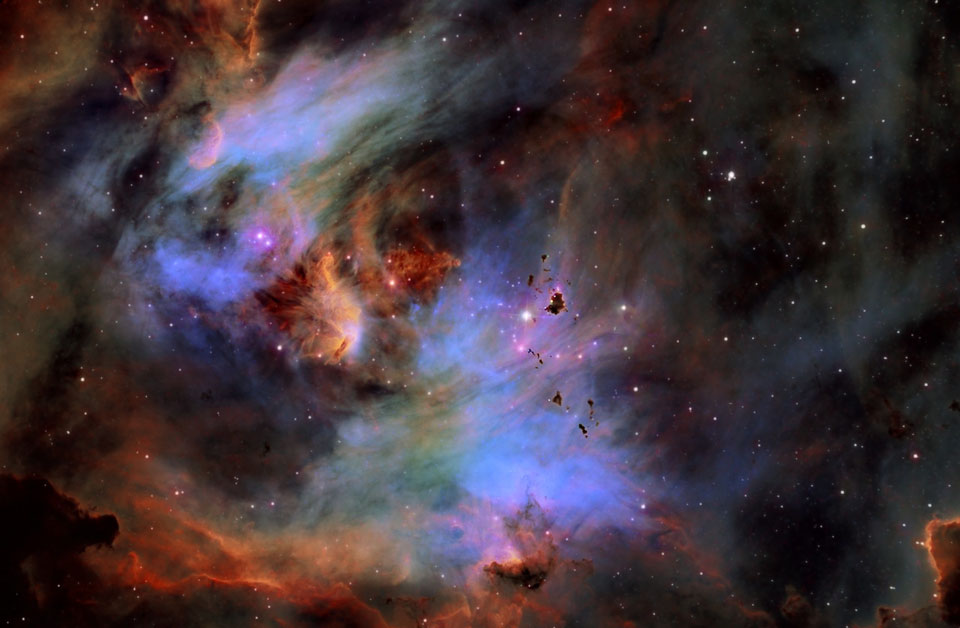 The eggs from this chicken may form into stars. The above pictured emission nebula, cataloged as IC 2944, is called the Running Chicken Nebula for the shape of its greater appearance. The image was taken recently from Siding Spring Observatory in Australia and presented in scientifically assigned colors. Seen near the center of the image are small, dark molecular clouds rich in obscuring cosmic dust. Called Thackeray's Globules for their discoverer, these "eggs" are potential sites for the gravitational condensation of new stars, although their fates are uncertain as they are also being rapidly eroded away by the intense radiation from nearby young stars. Together with patchy glowing gas and complex regions of reflecting dust, these massive and energetic stars form the open cluster Collinder 249. This gorgeous skyscape spans about 70 light-years at the nebula's estimated 6,000 light-year distance. March 4, 2014 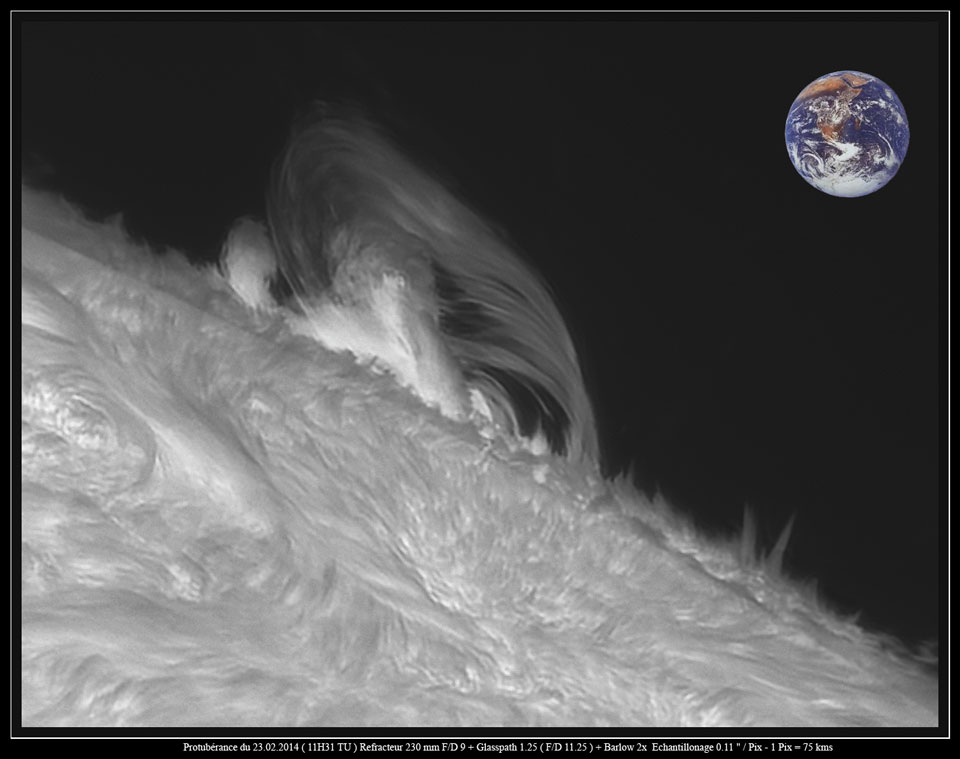 Dramatic prominences can sometimes be seen looming just beyond the edge of the sun. Such was the case last week as a large prominence, visible above, highlighted a highly active recent Sun. A waving sea of hot gas is visible in the foreground chromosphere in great detail as it was imaged in one specific color of light emitted by hydrogen. A solar prominence is a cloud of solar gas held just above the surface by the Sun's magnetic field. The Earth, illustrated in the inset, is smaller than the prominence. Although very hot, prominences typically appear dark when viewed against the Sun, since they are slightly cooler than the photosphere below them. A quiescent prominence typically lasts about a month, and may erupt in a Coronal Mass Ejection (CME) expelling hot gas into the Solar System, some of which may strike the Earth and trigger auroras. March 3, 2014 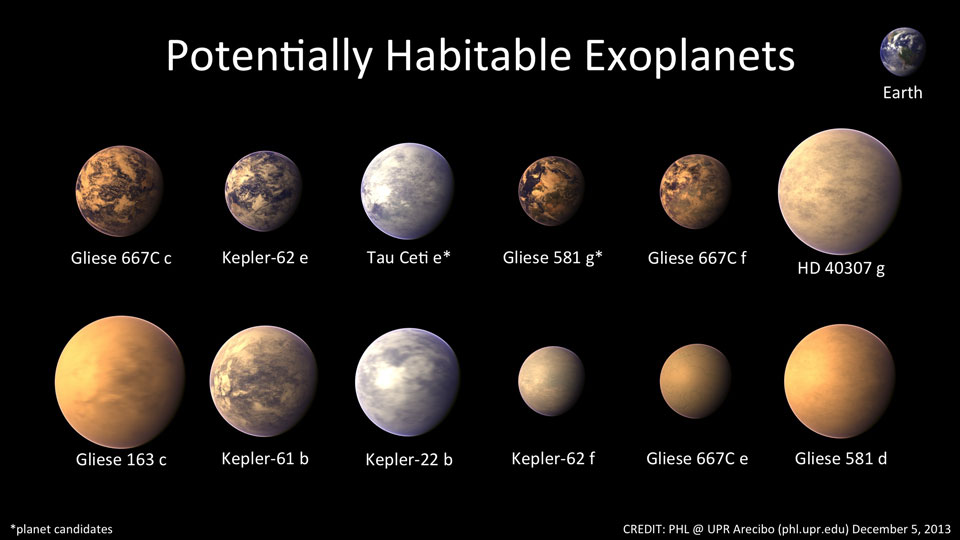 Is Earth the only known world that can support life? In an effort to find life-habitable worlds outside our Solar System, stars similar to our Sun are being monitored for slight light decreases that indicate eclipsing planets. Many previously-unknown planets are being found, including over 700 worlds recently uncovered by NASA's Kepler satellite. Depicted above in artist's illustrations are twelve extrasolar planets that orbit in the habitable zones of their parent stars. These exoplanets have the right temperature for water to be a liquid on their surfaces, and so water-based life on Earth might be able to survive on them. Although technology cannot yet detect resident life, finding habitable exoplanets is a step that helps humanity to better understand its place in the cosmos. March 2, 2014  What would it be like to see a sunset on Mars? To help find out, the robotic rover Spirit was deployed in 2005 to park and watch the Sun dip serenely below the distant lip of Gusev crater. Colors in the above image have been slightly exaggerated but would likely be apparent to a human explorer's eye. Fine martian dust particles suspended in the thin atmosphere lend the sky a reddish color, but the dust also scatters blue light in the forward direction, creating a bluish sky glow near the setting Sun. Because Mars is farther away, the Sun is less bright and only about two thirds the diameter it appears from Earth. Images like this help atmospheric scientists understand not only the atmosphere of Mars, but atmospheres across the Solar System, including our home Earth. March 1, 2014 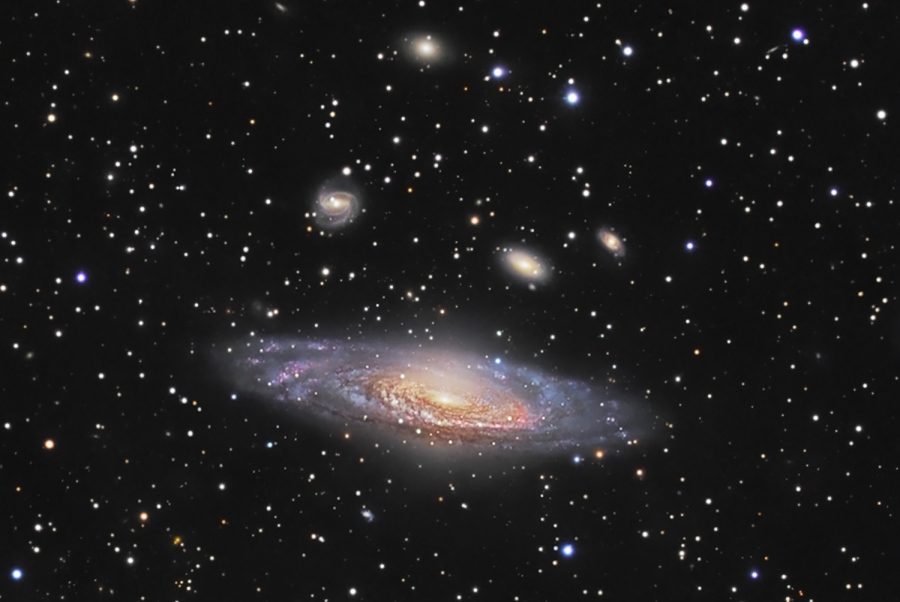 Big, beautiful spiral galaxy NGC 7331 is often touted as an analog to our own Milky Way. About 50 million light-years distant in the northern constellation Pegasus, NGC 7331 was recognized early on as a spiral nebula and is actually one of the brighter galaxies not included in Charles Messier's famous 18th century catalog. Since the galaxy's disk is inclined to our line-of-sight, long telescopic exposures often result in an image that evokes a strong sense of depth. The effect is further enhanced in this sharp image by galaxies that lie beyond the gorgeous island universe. The background galaxies are about one tenth the apparent size of NGC 7331 and so lie roughly ten times farther away. Their close alignment on the sky with NGC 7331 occurs just by chance. Seen here through faint foreground dust clouds lingering above the plane of Milky Way, this visual grouping of galaxies is also known as the Deer Lick Group. February 28, 2014  Only two days past full, February's moon shines through thin clouds, rising on the left in this fisheye night skyscape. The moonlight illuminates a weathered, rounded foreground in the Alabama Hills, conveniently located east of Mt. Whitney along the Sierra Nevada range in California, USA, planet Earth. Orion the Hunter stands at the right, a familiar northern winter constellation. Bright Jupiter, the solar system's ruling gas giant, is near center at the top of the frame. Below Jupiter, Sirius, alpha star of the Big Dog, poses above a bowed and twisted landform known as Möbius Arch, its curve reminiscent of the mathematically famous surface with only one side. Of course, instead of using rock, wind, and weather, a Möbius strip is easier to make with paper, scissors, and tape. February 27, 2014 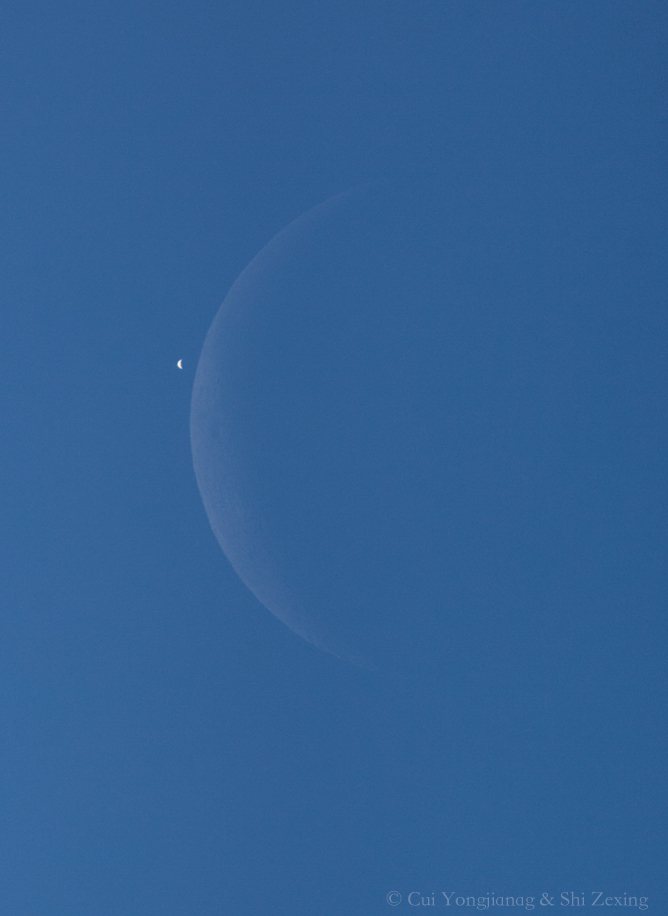 Venus now appears as planet Earth's brilliant morning star standing above the eastern horizon before dawn. For most, the silvery celestial beacon rose in a close pairing with an old crescent Moon on February 26. But seen from locations in western Africa before sunrise, the lunar crescent actually occulted or passed in front of Venus, also in a crescent phase. Farther to the east, the occultation occurred during daylight hours. In fact, this telescopic snapshot of the dueling crescents was captured just before the occultation began under an afternoon's crystal clear skies from Yunnan Province, China. The unforgettable scene was easily visible to the naked eye in broad daylight. February 26, 2014 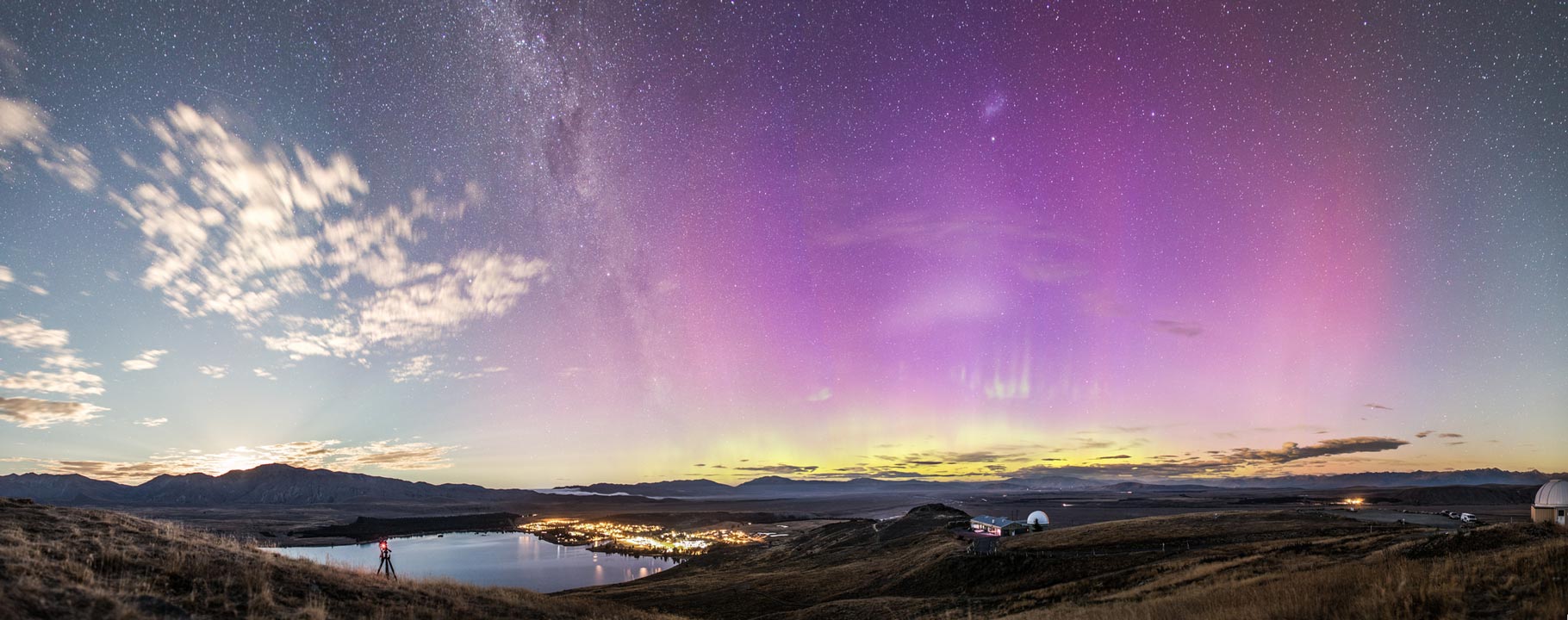 Sometimes the more you look at an image, the more you see. Such may be the case for this beautiful nighttime panorama taken last week in New Zealand. Visible right off, on the far left, are common clouds, slightly altered by the digital fusion of combining 11 separate 20-second exposures. More striking, perhaps, is the broad pink aurora that dominates the right part of the image, a less common auroral color that is likely tinted by excited oxygen atoms high in Earth's atmosphere. Keep looking and you might notice a bright light just beyond the mountain on the left. That is the rising Moon -- and an even closer look will reveal faint crepuscular rays emanating from it. Musing over the image center may cause you to notice the central band of the Milky Way Galaxy which here appears to divide, almost vertically, the left clouds from the right aurora. Inspecting the upper right of the image reveals a fuzzy patch, high in the sky, that is the Small Magellanic Cloud. Numerous stars discretely populate the distant background. Back on Earth, the image foreground features two domes of the Mt. John University Observatory and a camera tripod looking to capture much of this scene over a serene Lake Tekapo. February 25, 2014 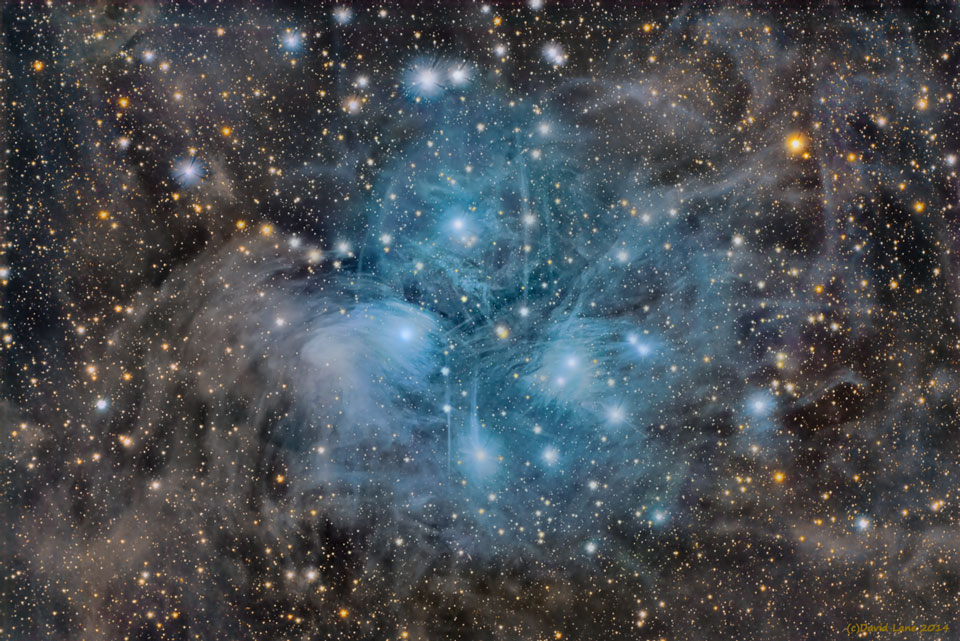 The well known Pleiades star cluster is slowly destroying part of a passing cloud of gas and dust. The Pleiades is the brightest open cluster of stars on Earth's sky and can be seen from almost any northerly location with the unaided eye. The passing young dust cloud is thought to be part of Gould's belt, an unusual ring of young star formation surrounding the Sun in the local Milky Way Galaxy. Over the past 100,000 years, part Gould's belt is by chance moving right through the older Pleiades and is causing a strong reaction between stars and dust. Pressure from the star's light significantly repels the dust in the surrounding blue reflection nebula, with smaller dust particles being repelled more strongly. A short-term result is that parts of the dust cloud have become filamentary and stratified, as seen in the above deep-exposure image. February 24, 2014  One of the Expedition 38 crew members aboard the International Space Station downlinked this vertical 600mm night view of Sochi, Russia, which clearly shows the site of the 2014 Winter Olympics while they are just a few days under way. Fisht Stadium where the Opening Ceremonies were held on Feb. 7 is easily recognizable as the bright circular structure. Sochi is a city in Krasnodar Krai, Russia, located on the Black Sea coast near the border between Georgia/Abkhazia and Russia. It has an area of 1,353 square miles or 3,505 square kilometers. Hockey fans aboard the International Space Station could glance at the roof of the Bolshoy Ice Arena just to the south west of Fisht Stadium in this image and see the score of the two teams playing hockey at that particular moment. February 23, 2014  If this is Saturn, where are the rings? When Saturn's "appendages" disappeared in 1612, Galileo did not understand why. Later that century, it became understood that Saturn's unusual protrusions were rings and that when the Earth crosses the ring plane, the edge-on rings will appear to disappear. This is because Saturn's rings are confined to a plane many times thinner, in proportion, than a razor blade. In modern times, the robot Cassini spacecraft orbiting Saturn now also crosses Saturn's ring plane. A series of plane crossing images from 2005 February was dug out of the vast online Cassini raw image archive by interested Spanish amateur Fernando Garcia Navarro. Pictured above, digitally cropped and set in representative colors, is the striking result. Saturn's thin ring plane appears in blue, bands and clouds in Saturn's upper atmosphere appear in gold. Details of Saturn's rings can be seen in the high dark shadows across the top of this image, taken back in 2005. Moons appear as bumps in the rings. February 22, 2014 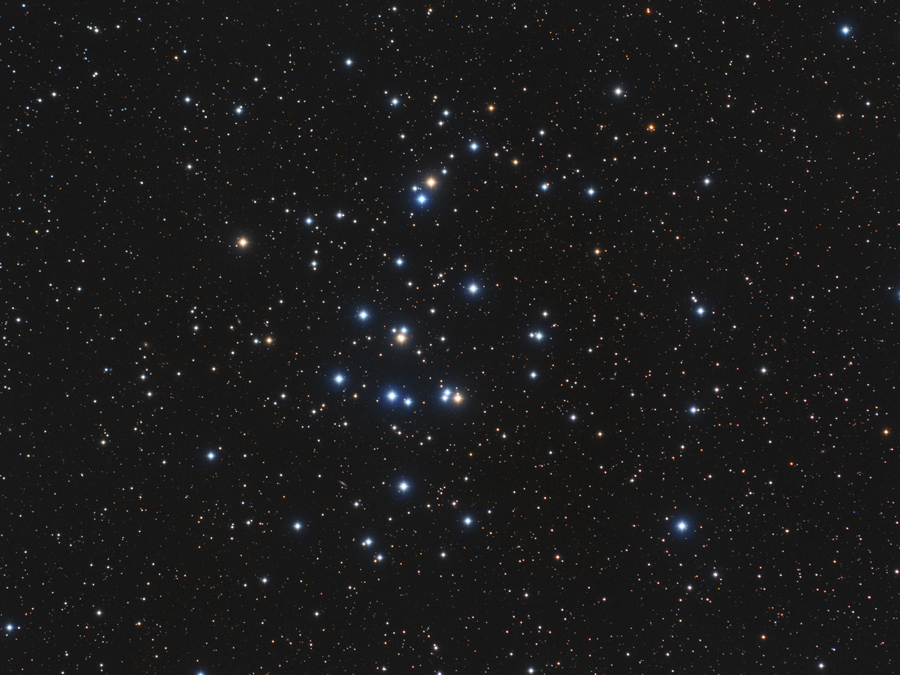 A mere 600 light-years away, M44 is one of the closest star clusters to our solar system. Also known as the Praesepe or the Beehive cluster its stars are young though, about 600 million years old compared to our Sun's 4.5 billion years. Based on similar ages and motion through space, M44 and the even closer Hyades star cluster in Taurus are thought to have been born together in the same large molecular cloud. An open cluster spanning some 15 light-years, M44 holds 1,000 stars or so and covers about 3 full moons (1.5 degrees) on the sky in the constellation Cancer. Visible to the unaided eye, M44 has been recognized since antiquity. Described as a faint cloud or celestial mist long before being included as the 44th entry in Charles Messier's 18th century catalog, the cluster was not resolved into its individual stars until telescopes were available. A popular target for modern, binocular-equiped sky gazers, the cluster's few yellowish tinted, cool, red giants are scattered through the field of its brighter hot blue main sequence stars in this colorful stellar group snapshot. February 21, 2014 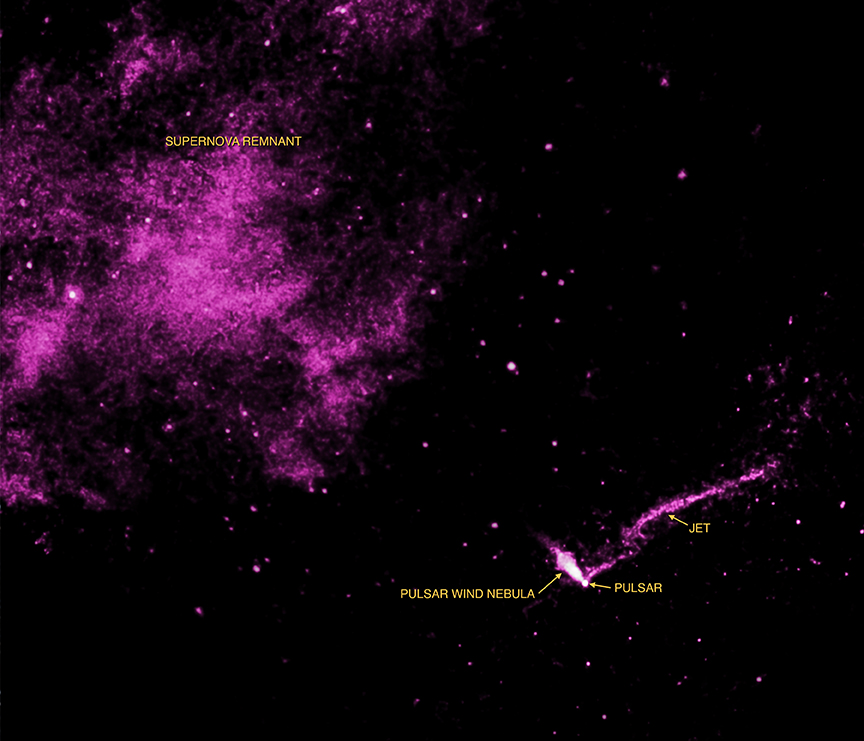 The Lighthouse nebula was formed by the wind of a pulsar, a rapidly rotating, magnetized neutron star, as it speeds through the interstellar medium at over 1,000 kilometers per second. Some 23,000 light-years distant toward the southern constellation Carina, pulsar and wind nebula (cataloged as IGR J1104-6103) are indicated at the lower right in this remarkable image from the Chandra X-ray Observatory. Energetic particles generated by the pulsar are swept back into the wind's comet-like tail trailing up and to the left, along the direction of the pulsar's motion away from its parent supernova remnant. Both runaway pulsar and expanding remnant debris field are the aftermath of the core-collapse-explosion of a massive star, with the pulsar kicked out by the supernova explosion. Adding to the scene of exotic cosmic extremes is a long, spiraling jet extending for almost 37 light-years, but nearly at a right angle to the pulsar's motion. The high-energy particle jet is the longest known for any object in our Milky Way galaxy. February 20, 2014 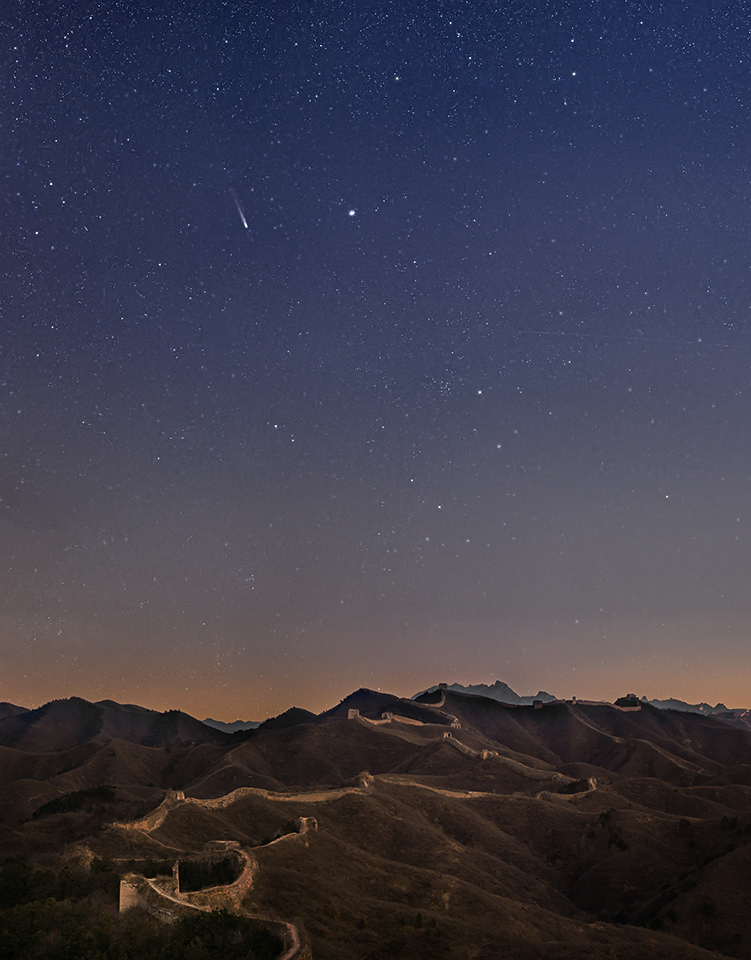 Fading now as it returns to the outer solar system Comet Lovejoy (C/2013 R1) still graces planet Earth's sky, a delicate apparition in binoculars or small telescopes. The comet, a relic of the solar system's formative years, is seen here rising in the morning twilight on January 12 among the stars of Ophiuchus, the Serpent Bearer. Posing near the comet is bright star Alpha Ophiuchi, also known as Rasalhague, from Arabic "the head of the serpent collector". Of course, the serpentine shape below is the ancient Great Wall of China, along the Panlongshan section northeast of Beijing. Panlongshan is translated as "a coiled dragon". A moving and fortuitous scene, it was captured with a digital camera and telephoto lens in two consecutive exposures. The exposures were merged to show a natural looking foreground and twilight sky. February 19, 2014 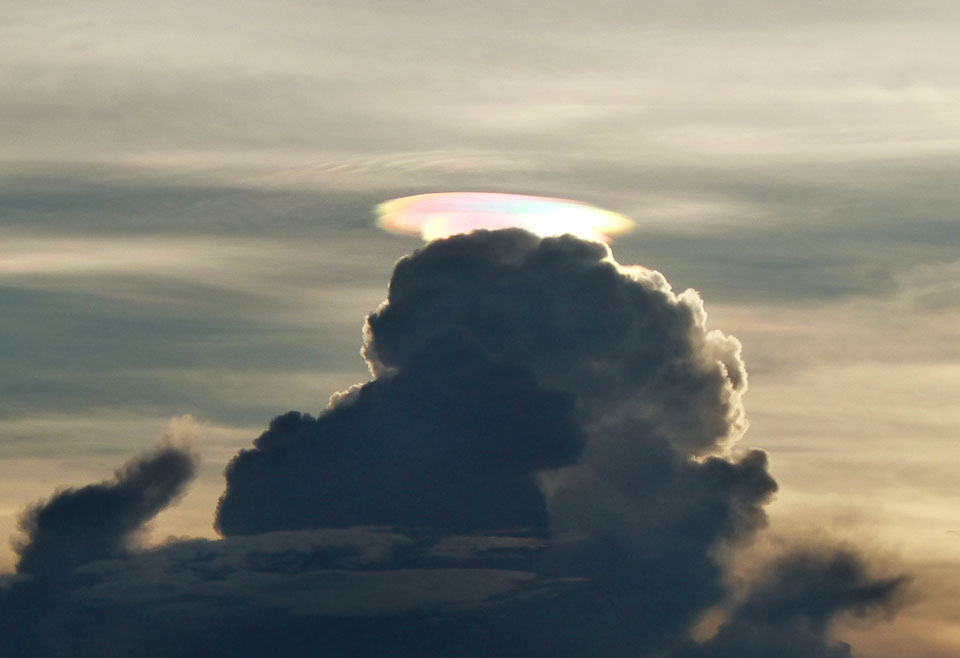 How many dark clouds have a multicolored lining? Pictured, behind this darker cloud, is a pileus iridescent cloud, a group of water droplets that have a uniformly similar size and so together diffract different colors of sunlight by different amounts. The above image was taken just before sunset when it was noticed by chance by a photographer in Murambi East, near Odzi Valley and the Mtanda Range of Zimbabwe. Also captured were unusual cloud ripples above the pileus cloud. The formation of a rare pileus cloud capping a common cumulus cloud is an indication that the lower cloud is expanding upward and might well develop into a storm. In this case, however, only a few minutes after the colorful cloud was noticed, it disappeared. February 18, 2014 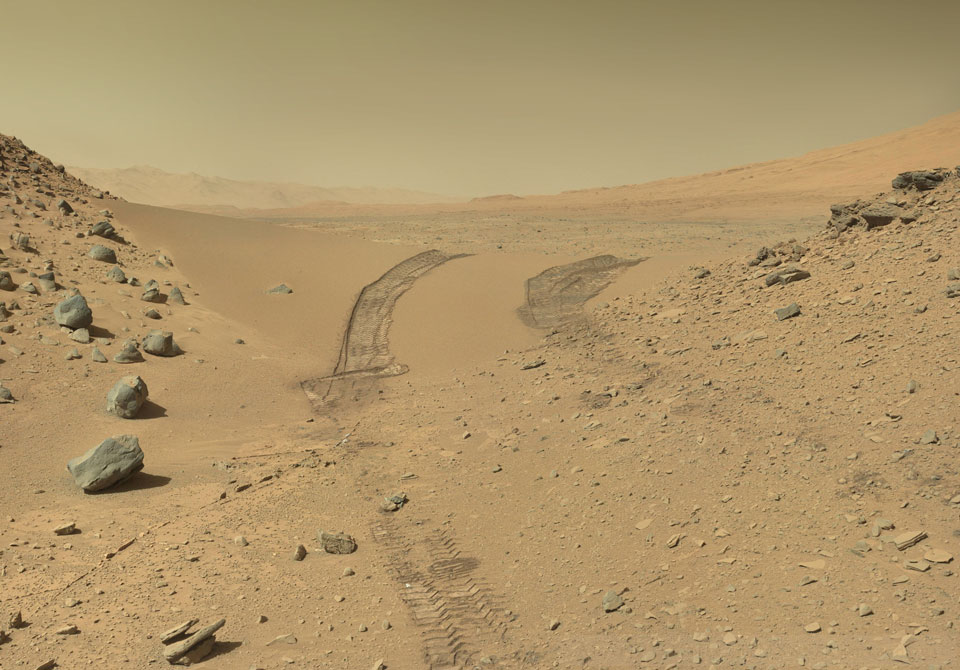 An important threshold on Mars has now been crossed. Landing in mid-2012, the Curiosity rover is searching for clues of whether life could ever have existed on the red planet. Recent findings of Curiosity include evidence for an ancient (but now dried) freshwater lake, and the non-detection of the biomarker methane in the Martian atmosphere. To continue its investigation, the car-sized rover is on an expedition to roll up Mt. Sharp, the central peak of the large crater in which it landed. Life might have shown preference for water that once ran down the Martian mountain. Two weeks ago, to avoid more dangerous and rocky terrain, Curiosity was directed to roll across a one-meter high sand dune that blocked a useful entrance to Mt. Sharp. Just after the short trip over Dingo Gap was successful, the robotic rover took the above image showing the now-traversed sand mound covered with its wheel tracks. February 17, 2014 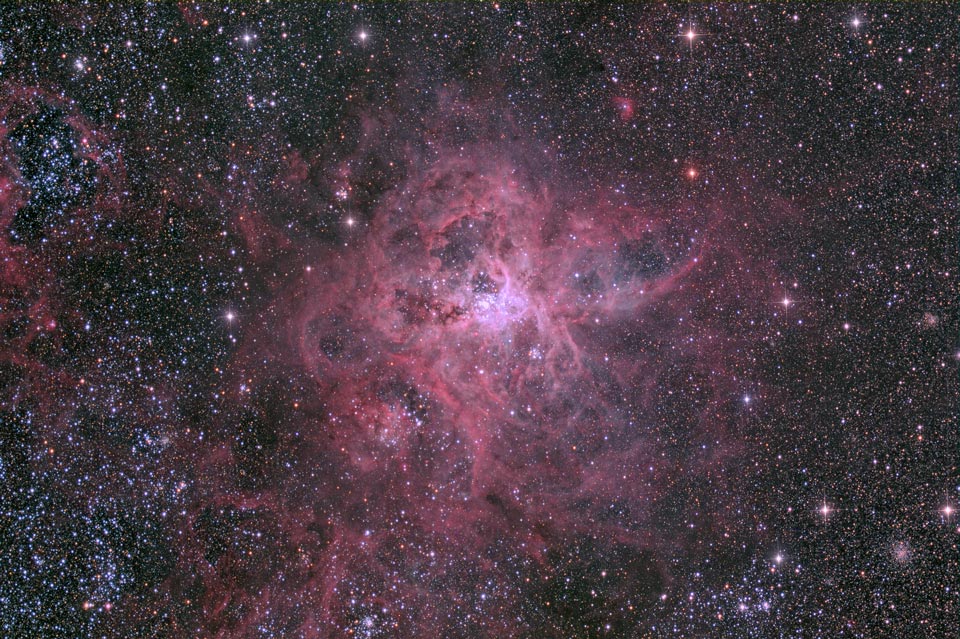 It is the largest and most complex star forming region in the entire galactic neighborhood. Located in the Large Magellanic Cloud, a small satellite galaxy orbiting our Milky Way galaxy, the region's spidery appearance is responsible for its popular name, the Tarantula nebula. This tarantula, however, is about 1,000 light-years across. Were it placed at the distance of Milky Way's Orion Nebula, only 1,500 light-years distant and the nearest stellar nursery to Earth, it would appear to cover about 30 degrees (60 full moons) on the sky. Intriguing details of the nebula are visible in the above image shown in near true colors. The spindly arms of the Tarantula nebula surround NGC 2070, a star cluster that contains some of the brightest, most massive stars known, visible in blue on the right. Since massive stars live fast and die young, it is not so surprising that the cosmic Tarantula also lies near the site of a close recent supernova. February 16, 2014  From afar, the whole thing looks like an Eagle. A closer look at the Eagle Nebula, however, shows the bright region is actually a window into the center of a larger dark shell of dust. Through this window, a brightly-lit workshop appears where a whole open cluster of stars is being formed. In this cavity tall pillars and round globules of dark dust and cold molecular gas remain where stars are still forming. Already visible are several young bright blue stars whose light and winds are burning away and pushing back the remaining filaments and walls of gas and dust. The Eagle emission nebula, tagged M16, lies about 6500 light years away, spans about 20 light-years, and is visible with binoculars toward the constellation of the Serpent (Serpens). This picture combines three specific emitted colors and was taken with the 0.9-meter telescope on Kitt Peak, Arizona, USA. February 15, 2014  This helmet-shaped cosmic cloud with wing-like appendages is popularly called Thor's Helmet. Heroically sized even for a Norse god, Thor's Helmet is about 30 light-years across. In fact, the helmet is more like an interstellar bubble, blown as a fast wind from the bright, massive star near the bubble's center sweeps through a surrounding molecular cloud. Known as a Wolf-Rayet star, the central star is an extremely hot giant thought to be in a brief, pre-supernova stage of evolution. Cataloged as NGC 2359, the nebula is located about 15,000 light-years away in the constellation Canis Major. The sharp image, made using broadband and narrowband filters, captures striking details of the nebula's filamentary structures. It shows off a blue-green color from strong emission due to oxygen atoms in the glowing gas. February 14, 2014  Sprawling across almost 200 light-years, emission nebula IC 1805 is a mix of glowing interstellar gas and dark dust clouds about 7,500 light-years away in the Perseus spiral arm of our galaxy. Stars were born in this region whose nickname, the Heart Nebula, derives from its Valentine's-Day-appropriate shape. The clouds themselves are shaped by stellar winds and radiation from massive hot stars in the nebula's newborn star cluster Melotte 15 about 1.5 million years young. This deep telescopic image maps the pervasive light of narrow emission lines from atoms in the nebula to a color palette made popular in Hubble images of star forming regions. The field of view spans about two degrees on the sky or four times the diameter of a full moon. The cosmic heart is found in the constellation of Cassiopeia, the boastful mythical Queen of Aethiopia. February 13, 2014  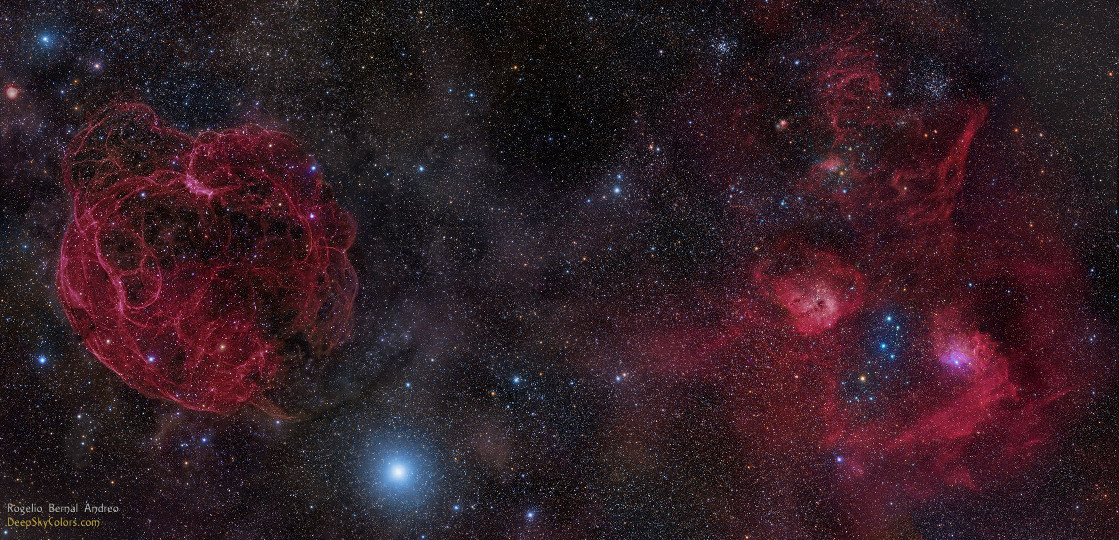 Rich in star clusters and nebulae, the ancient constellation of Auriga, the Charioteer, rides high in northern winter night skies. Spanning nearly 24 full moons (12 degrees) on the sky, this deep telescopic mosaic view recorded in January shows off some of Auriga's most popular sights for cosmic tourists. The crowded field sweeps along the plane of our Milky Way galaxy in the direction opposite the galactic center. Need directions? Near the bottom of the frame, at the Charioteer's boundary with Taurus the Bull, the bright bluish star Elnath is known as both Beta Tauri and Gamma Aurigae. On the far left and almost 300 light-years away, the busy, looping filaments of supernova remnant Simeis 147 cover about 150 light-years. Look toward the right to find emission nebula IC 410, significantly more distant, some 12,000 light-years away. Star forming IC 410 is famous for its embedded young star cluster, NGC 1893, and tadpole-shaped clouds of dust and gas. The Flaming Star Nebula, IC 405, is just a little farther along. Its red, convoluted clouds of glowing hydrogen gas are energized by hot O-type star AE Aurigae. Two of our galaxy's open star clusters, Charles Messier's M36 and M38 line up in the starfield above, familiar to many binocular-equipped skygazers. February 12, 2014  Can the night sky appear both serene and surreal? Perhaps classifiable as serene in the above panoramic image taken last Friday are the faint lights of small towns glowing across a dark foreground landscape of Doi Inthanon National Park in Thailand, as well as the numerous stars glowing across a dark background starscape. Also visible are the planet Venus and a band of zodiacal light on the image left. Unusual events are also captured, however. First, the central band of our Milky Way Galaxy, while usually a common site, appears here to hover surreally above the ground. Next, a fortuitous streak of a meteor was captured on the image right. Perhaps the most unusual component is the bright spot just to the left of the meteor. That spot is the plume of a rising Ariane 5 rocket, launched a few minutes before from Kourou, French Guiana. How lucky was the astrophotographer to capture the rocket launch in his image? Not lucky at all - the image was timed to capture the rocket. What was lucky was how photogenic - and perhaps surreal - the rest of the sky turned out to be. February 11, 2014  Is the heart and soul of our Galaxy located in Cassiopeia? Possibly not, but that is where two bright emission nebulas nicknamed Heart and Soul can be found. The Heart Nebula, officially dubbed IC 1805 and visible in the above zoomable view on the right, has a shape reminiscent of a classical heart symbol. Both nebulas shine brightly in the red light of energized hydrogen. Several young open clusters of stars populate the image and are visible above in blue, including the nebula centers. Light takes about 6,000 years to reach us from these nebulas, which together span roughly 300 light years. Studies of stars and clusters like those found in the Heart and Soul Nebulas have focussed on how massive stars form and how they affect their environment. February 10, 2014 What would it be like to fall to Earth from really high up? A new record for the highest jump was accomplished in 2012 by Felix Baumgartner. Surpassing the previous record of 31.3 kilometer plummet, Baumgartner, in a commercial venture, jumped off a floating balloon platform 39.0 kilometers above New Mexico, USA and had his entire fall recorded on video. Baumgartner wore a pressurized suit able to provide breathable air and warmth while up in the balloon, but then cooling from the heat generated by the friction if his fall. Free falling 36.4 km before deploying his parachute, Baumgartner surpassed 1,000 km per hour and the sound barrier during the descent. The above video records his four minutes and 19 seconds of free fall in real time. The stunt included a somewhat unexpected but potentially dangerous spin that occurred during the second minute which could have knocked out or disoriented Baumgartner. After an enthralling plummet, Baumgartner's parachutes deployed and he landed safely. February 9, 2014 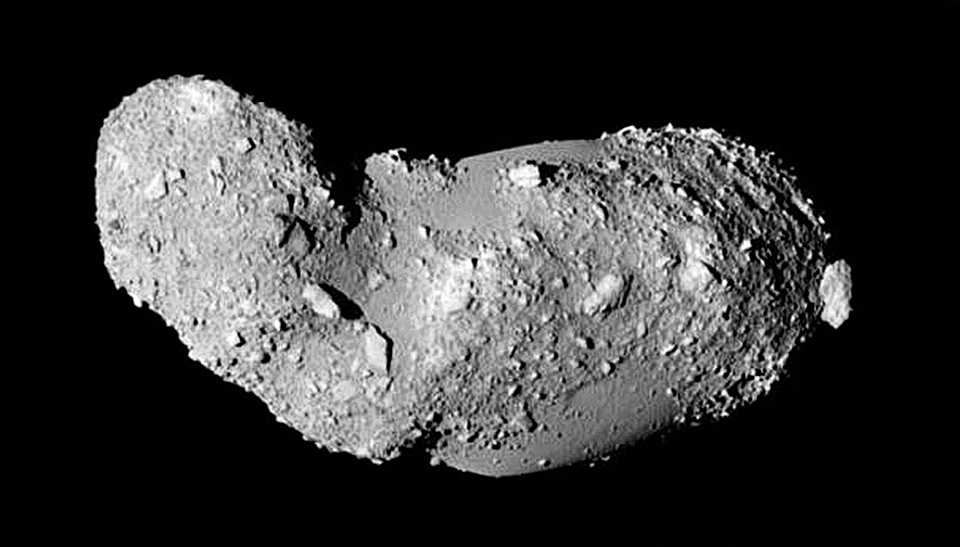 Where are the craters on asteroid Itokawa? Missing - unexpectedly. The Japanese robot probe Hayabusa approached the Earth-crossing asteroid in 2005 and returned pictures showing a surface unlike any other Solar System body yet photographed - a surface possibly devoid of craters. The leading hypothesis for the lack of common circular indentations is that asteroid Itokawa is a rubble pile - a bunch of rocks and ice chunks only loosely held together by a small amount of gravity. If so, craters might not form so easily - or be filled in whenever the asteroid gets jiggled by a passing planet or struck by a massive meteor. Recent Earth-based observations of asteroid Itokawa have shown that one part of the interior even has a higher average interior density than the other part, another unexpected discovery. The Hayabusa mission returned soil samples from Itokawa which are also giving clues the ancient history of the unusual asteroid and our entire Solar System. February 8, 2014  This sharp telescopic field of view holds two bright galaxies. Barred spiral NGC 5101 (top right) and nearly edge-on system NGC 5078 are separated on the sky by about 0.5 degrees or about the apparent width of a full moon. Found within the boundaries of the serpentine constellation Hydra, both are estimated to be around 90 million light-years away and similar in size to our own large Milky Way galaxy. In fact, if they both lie at the same distance their projected separation would be only 800,000 light-years or so. That's easily less than half the distance between the Milky Way and the Andromeda Galaxy. NGC 5078 is interacting with a smaller companion galaxy, cataloged as IC 879, seen just below and left of the larger galaxy's bright core. Even more distant background galaxies are scattered around the colorful field. Some are even visible right through the face-on disk of NGC 5101. But the prominent spiky stars are in the foreground, well within our own Milky Way. February 7, 2014 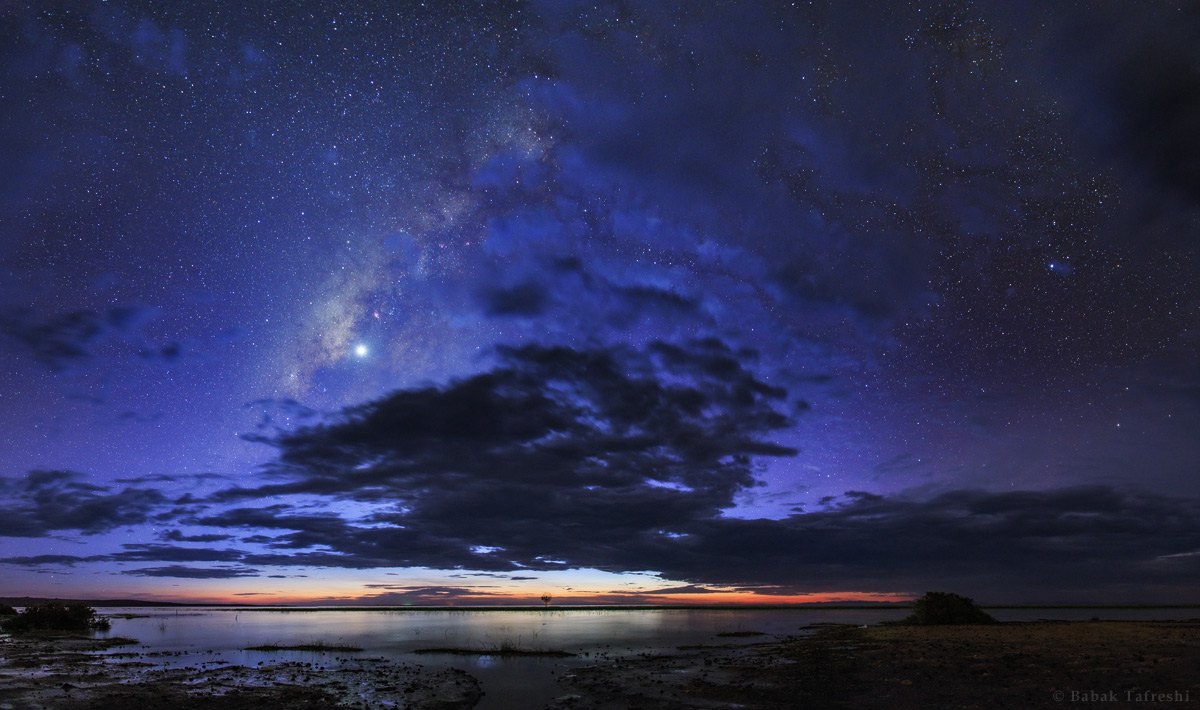 Stars come out as evening twilight fades in this serene skyscape following the Persian proverb "Night hides the world, but reveals a universe." In the scene from last November, the Sun is setting over northern Kenya and the night will soon hide the shores of Lake Turkana, home to many Nile crocodiles. That region is also known as the cradle of humankind for its abundance of hominid fossils. A brilliant Venus, then the world's evening star, dominates the starry night above. But also revealed are faint stars, cosmic dust clouds, and glowing nebulae along the graceful arc of our own Milky Way galaxy. February 6, 2014 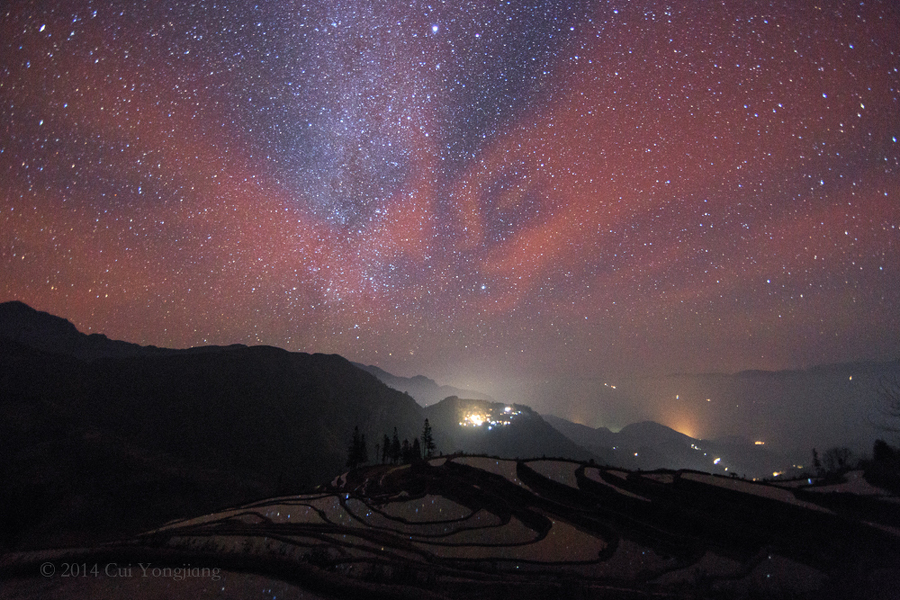 Long after sunset on January 25 an unusually intense red airglow floods this south-looking skyscape. The scene was recorded with a long exposure using a digital camera over Yunnan Province in southwest China. At best faintly visible to the eye, the lingering airglow is due to chemiluminescence, the production of light through chemical excitation. Originating at an altitude similar to aurora, it can found around the globe. The chemical energy is initially provided by the Sun's extreme ultraviolet radiation On this night, despite the luminous atmosphere, the band of the Milky Way clearly stretches above the horizon with bright star Sirius near the top of the frame. Both airglow and starry sky are beautifully reflected in region's watery Yuanyang rice terraces below. February 5, 2014 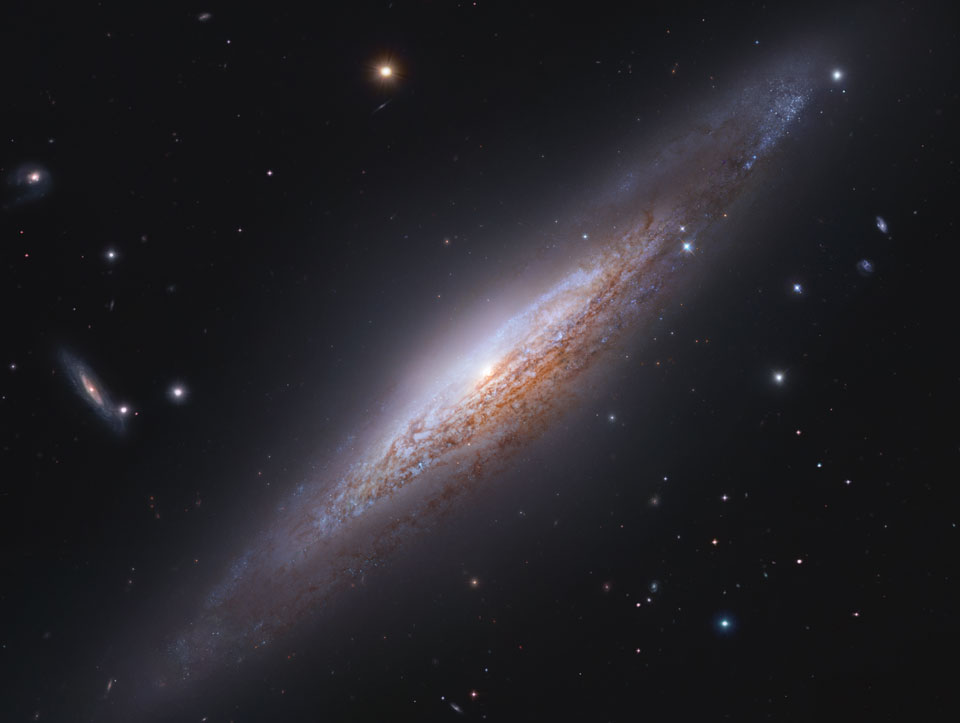 Does spiral galaxy NGC 2683 have a bar across its center? Being so nearly like our own barred Milky Way Galaxy, one might guess it has. Being so nearly edge-on, however, it is hard to tell. Either way, this gorgeous island universe, cataloged as NGC 2683, lies a mere 20 million light-years distant in the northern constellation of the Cat (Lynx). NGC 2683 is seen nearly edge-on in this cosmic vista combining data and images from the ground-based Subaru telescope and the space-based Hubble Space Telescope. More distant galaxies are seen scattered in the background. Blended light from a large population of old yellowish stars forms the remarkably bright galactic core. Starlight silhouettes the dust lanes along winding spiral arms, dotted with the telltale blue glow of young star clusters in this galaxy's star forming regions. February 4, 2014 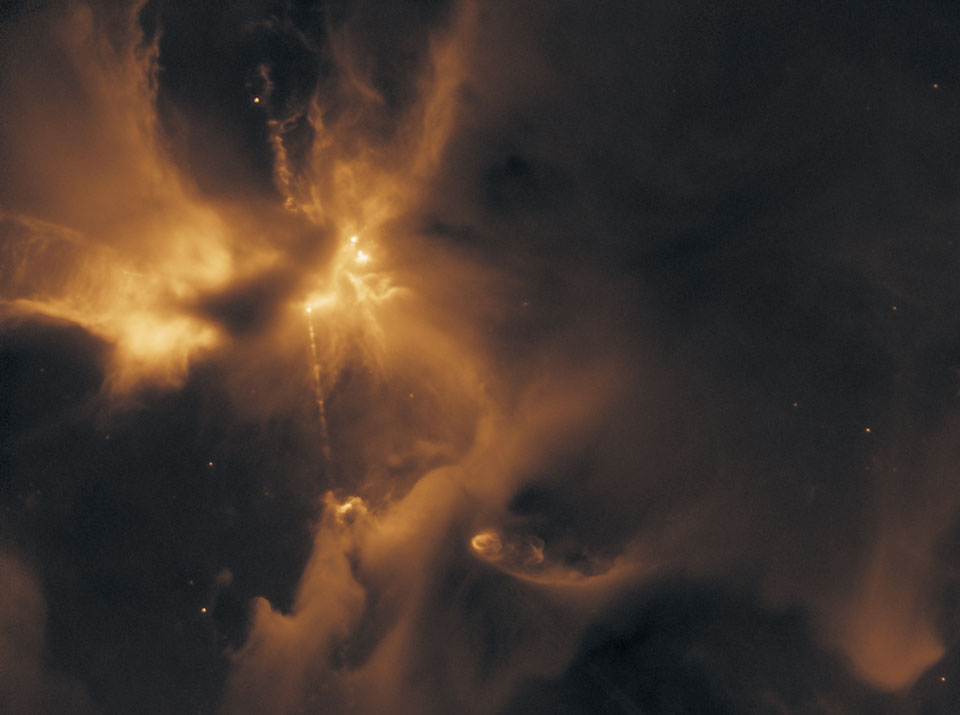 If you visit HH 24, don't go near the particle beam jet. This potential future travel advisory might be issued because the powerful jet likely contains electrons and protons moving hundreds of kilometers per second. The above image was taken by the Hubble Space Telescope in infrared light in order to better understand turbulent star forming regions known as Young Stellar Objects (YSOs). Frequently when a star forms, a disk of dust and gas circles the YSO causing a powerful central jets to appear. In this case, the energetic jets are creating, at each end, Herbig-Haro object 24 (HH 24), as they slam into the surrounding interstellar gas. The entire star forming region lies about 1,500 light years distant in the Orion B molecular cloud complex. Due to their rarity, jets like that forming HH 24 are estimated to last only a few thousand years. February 3, 2014  Where has the Yutu rover been on the Moon? Arriving in 2013 mid-December, the Chinese Yutu robotic rover has spent some of the past month and a half exploring Mare Imbrium on Earth's Moon. Because it uses solar power, the mechanical Jade Rabbit goes into sleep mode to endure the two-week long lunar night. Pictured above is a digitally created time-lapse composite panorama showing the region surrounding the Chang'e 3 lander, capturing the desk-sized rover in three positions. On the far right, Yutu is seen heading south to investigate greener pastures, likely never to return to its lander again. February 2, 2014 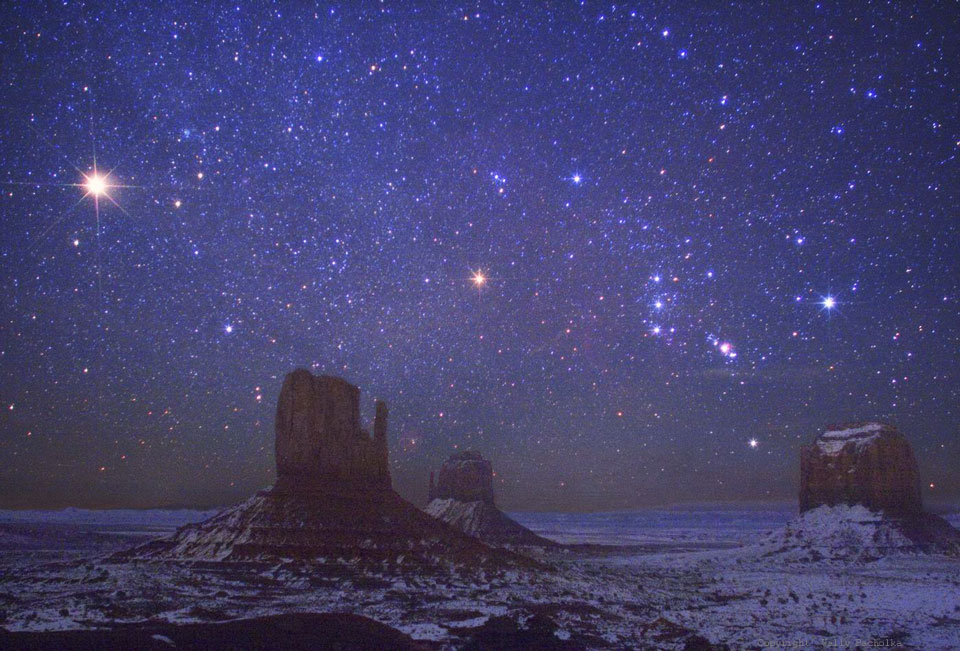 Welcome to The World At Night. Sharing the night sky seen around the world, this view from Monument Valley, USA includes a picturesque foreground of famous buttes. Buttes are composed of hard rock left behind after water eroded away the surrounding soft rock. The two buttes on the image left are known as the Mittens, while Merrick Butte is on the right. Recorded in 2007 December, planet Mars is at the left of the skyscape, a glowing beacon of orange that is the brightest object in the frame. To the right of Mars lies the constellation of Orion. Betelgeuse is the reddish star near the center and the Belt of Orion and the Orion Nebula are farther right. Finally, the bright blue star Rigel appears above Merrick Butte in this stunning view of The World At Night. February 1, 2014 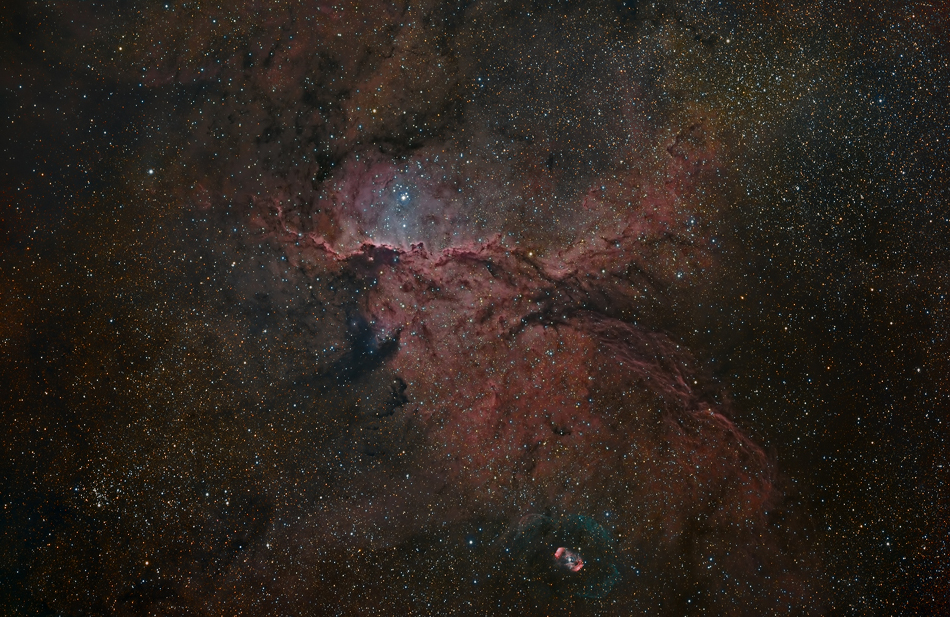 Fantastic shapes lurk in clouds of glowing gas in NGC 6188, about 4,000 light-years away. The emission nebula is found near the edge of a large molecular cloud unseen at visible wavelengths, in the southern constellation Ara. Massive, young stars of the embedded Ara OB1 association were formed in that region only a few million years ago, sculpting the dark shapes and powering the nebular glow with stellar winds and intense ultraviolet radiation. The recent star formation itself was likely triggered by winds and supernova explosions, from previous generations of massive stars, that swept up and compressed the molecular gas. Joining NGC 6188 on this cosmic canvas is rare emission nebula NGC 6164, also created by one of the region's massive O-type stars. Similar in appearance to many planetary nebulae, NGC 6164's striking, symmetric gaseous shroud and faint halo surround its bright central star near the bottom edge. The impressively wide field of view spans over 3 degrees (six full Moons), corresponding to over 200 light years at the estimated distance of NGC 6188. Narrowband image data has been included in the natural looking color composite, adding to deep red emission from hydrogen and sulfur atoms and the blue-green light of oxygen atoms. January 31, 2014 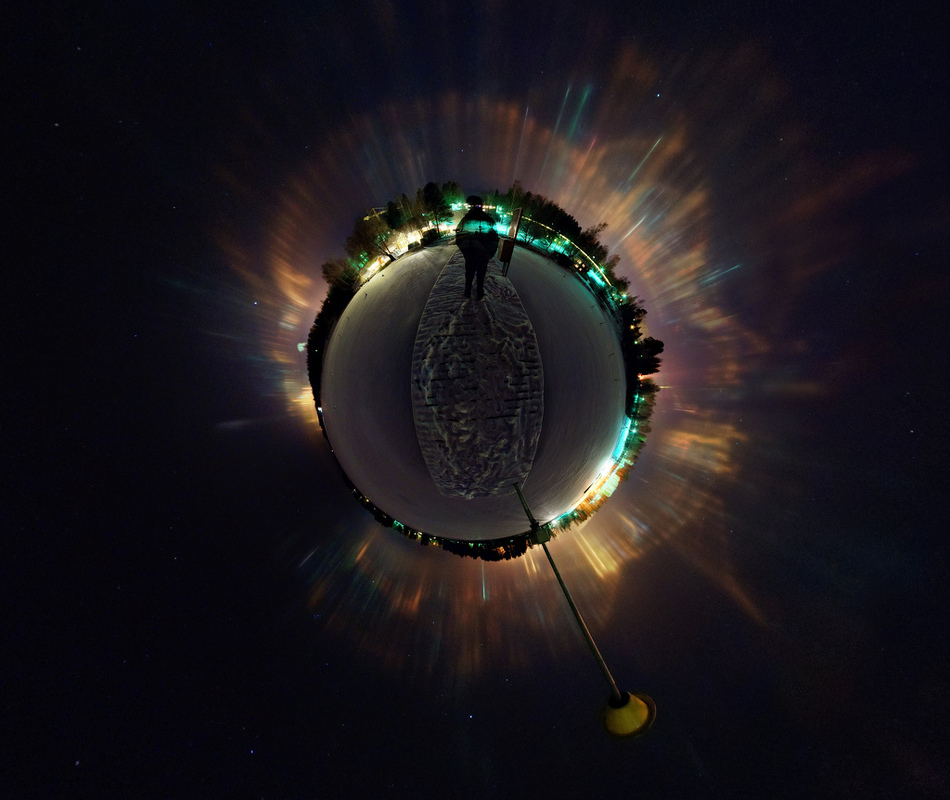 Eerie pillars of light ring the edges of this snowy little planet. Of course the little planet is planet Earth, shown in a nadir-to-zenith, around-the-horizon, little planet projection. The spherical panoramic image mosaic maps a view from Siilinjärvi in eastern Finland. Flat ice crystals, like those more often found in high, thin clouds, are gently fluttering in very cold air near the surface. The pillars of light appear as their briefly horizontal facets reflect upward directed light from ground sources downward, toward the observer. In fact, the fluttering crystals produce an effect analogous to the shimmering columns of moonlight or sunlight reflected by surface waves across water. January 30, 2014  Fixed to a tripod and looking east across the Kennedy Space Center's Turn Basin, a camera captured these star trails as a series of short exposures over a three hour period on the evening of January 23rd. Positioned just a few miles from Space Launch Complex 41 at Cape Canaveral Air Force Station, it also captured a spectacular night launch of an Atlas V rocket carrying NASA's Tracking and Data Relay Satellite TDRS-L. Creating the trails, the apparent motion of the stars through the sky is just a reflection of the daily rotation of planet Earth on its axis. But that rotation is also the reason the rocket streak follows a path arcing east across the Atlantic. Launching toward the east, in the direction of Earth's rotation, adds the rotation velocity to the rocket and reduces the fuel needed to reach orbit. A little ironically, TDRS-L is destined for a geostationary orbit. From there, 36,000 kilometers or so above the equator, it's orbital period will match Earth's rotation and the satellite will hang motionless in planet Earth's sky. January 29, 2014 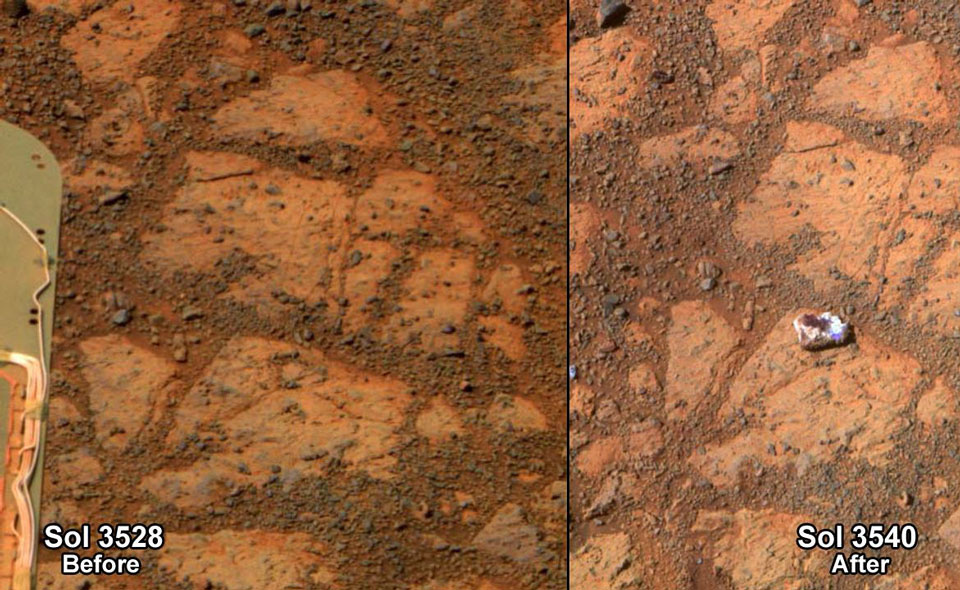 What if a rock that looked like a jelly donut suddenly appeared on Mars? That's just what happened in front of the robotic Opportunity rover currently exploring the red planet. The unexpectedly placed rock, pictured above, was imaged recently by Opportunity after not appearing in other images taken as recently as twelve Martian days (sols) before. Given the intriguing mystery, the leading explanation is somewhat tame -- the rock was recently scattered by one of the rover's tires. Even so, the rock's unusual light tones surrounding a red interior created interest in its composition -- as well as causing it to be nicknamed Jelly Donut. A subsequent chemical analysis showed the rock has twice the abundance of manganese than any other rock yet examined -- an unexpected clue that doesn't yet fit into humanity's understanding of the Martian geologic history. Opportunity, just passing its 10-year anniversary on Mars, continues to explore the Murray Ridge section of the rim of 22-kilometer wide Endeavor Crater. January 28, 2014 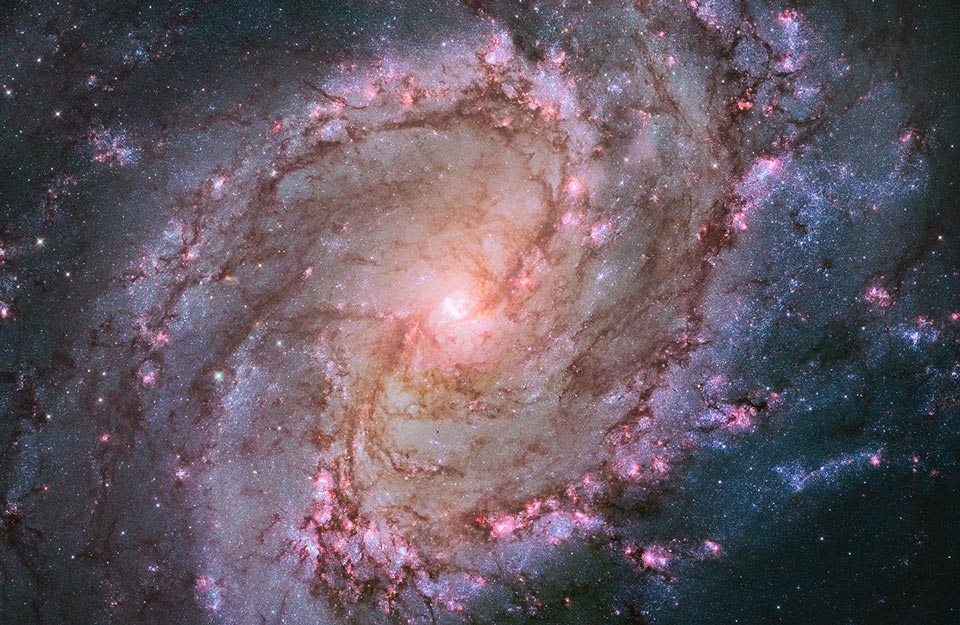 M83 is one of the closest and brightest spiral galaxies on the sky. Visible with binoculars in the constellation of Hydra, majestic spiral arms have prompted its nickname as the Southern Pinwheel. Although discovered 250 years ago, only much later was it appreciated that M83 was not a nearby gas cloud, but a barred spiral galaxy much like our own Milky Way Galaxy. M83, pictured above by the Hubble Space Telescope in a recently released image, is a prominent member of a group of galaxies that includes Centaurus A and NGC 5253, all of which lie about 15 million light years distant. Several bright supernova explosions have been recorded in M83. An intriguing double circumnuclear ring has been discovered at the center of of M83. January 27, 2014  There is a road that connects the Northern to the Southern Cross but you have to be at the right place and time to see it. The road, as pictured above, is actually the central band of our Milky Way Galaxy; the right place, in this case, is dark Laguna Cejar in Salar de Atacama of Northern Chile; and the right time was in early October, just after sunset. Many sky wonders were captured then, including the bright Moon, inside the Milky Way arch; Venus, just above the Moon; Saturn and Mercury, just below the Moon; the Large and Small Magellanic Clouds satellite galaxies, on the far left; red airglow near the horizon on the image left; and the lights of small towns at several locations across the horizon. January 26, 2014  It was a quiet day on the Sun. The above image shows, however, that even during off days the Sun's surface is a busy place. Shown in ultraviolet light, the relatively cool dark regions have temperatures of thousands of degrees Celsius. Large sunspot group AR 9169 from the last solar cycle is visible as the bright area near the horizon. The bright glowing gas flowing around the sunspots has a temperature of over one million degrees Celsius. The reason for the high temperatures is unknown but thought to be related to the rapidly changing magnetic field loops that channel solar plasma. Large sunspot group AR 9169 moved across the Sun during 2000 September and decayed in a few weeks. January 25, 2014 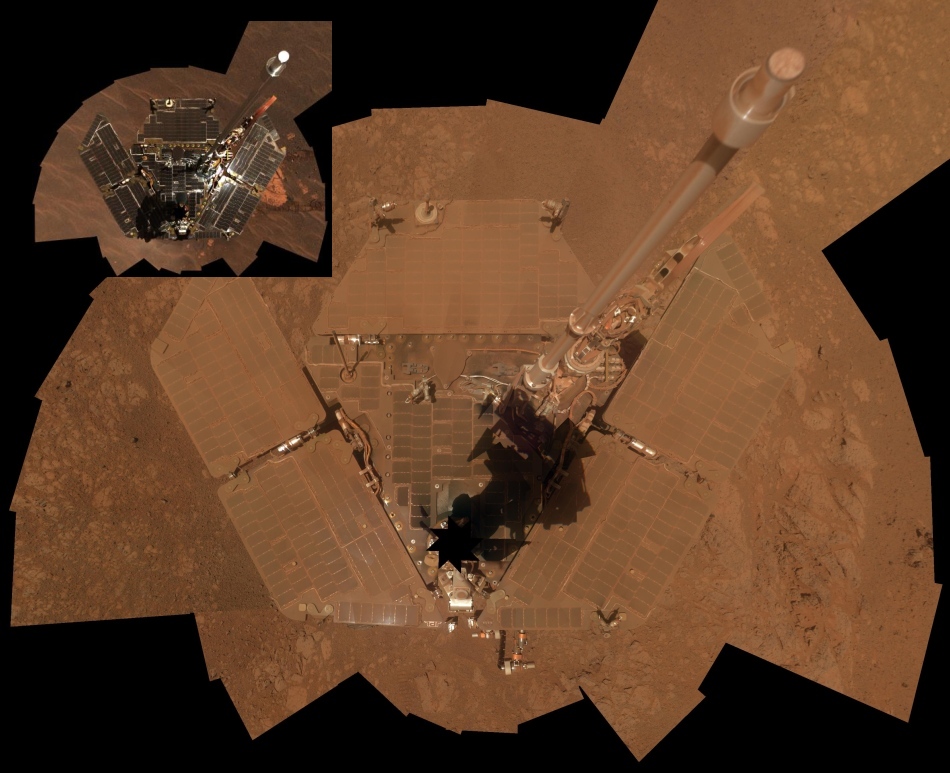 On January 25 (UT) 2004, the Opportunity rover fell to Mars, making today the 10th anniversary of its landing. After more than 3,500 sols (Mars solar days) the golf cart-sized robot from Earth is still actively exploring the Red Planet, though its original mission plan was for three months. This self-portrait was made with Opportunity's panoramic camera earlier this month. The camera's supporting mast has been edited out of the image mosaic but its shadow is visible on the dusty solar panels arrayed across the rover's deck. For comparison, a similar self-portrait from late 2004 is shown in the inset. Having driven some 39 kilometers (24 miles) from its landing site, Opportunity now rests at Solander Point at the rim of Endeavour Crater. January 24, 2014 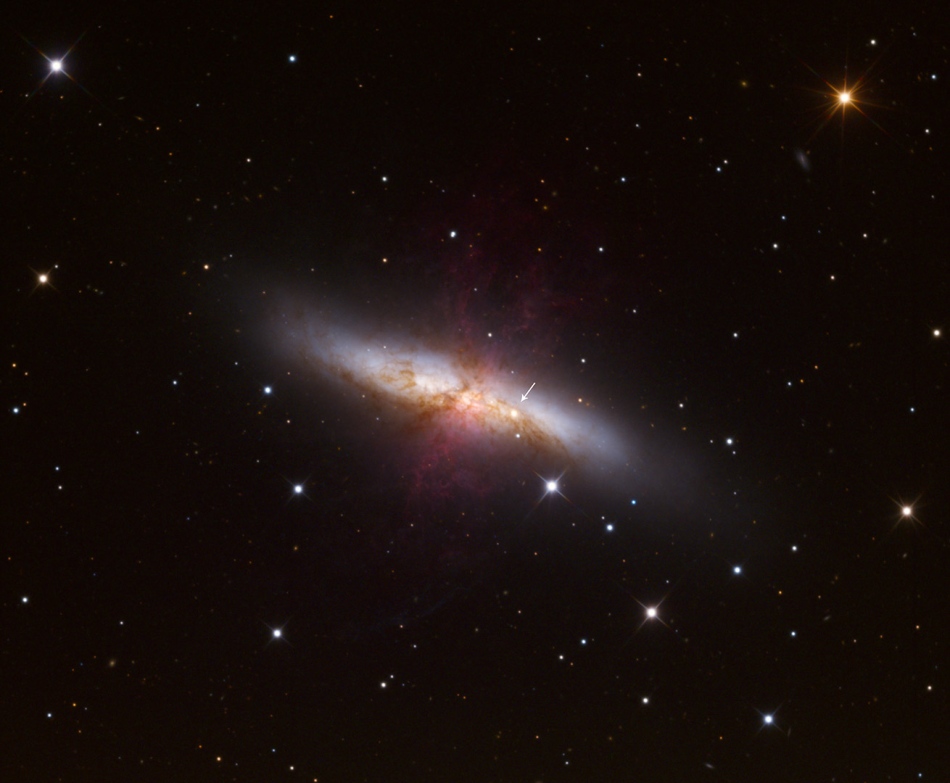 Astronomers really don't find supernovae by looking for the arrows. But in this image taken January 23rd, an arrow does point to an exciting, new supernova, now cataloged as SN 2014J, in nearby bright galaxy M82. Located near the Big Dipper in planet Earth's sky, M82 is also known as the Cigar Galaxy, a popular target for telescopes in the northern hemisphere. In fact, SN 2014J was first spotted as an unfamiliar source in the otherwise familiar galaxy by teaching fellow Steve Fossey and astronomy workshop students Ben Cooke, Tom Wright, Matthew Wilde and Guy Pollack at the University College London Observatory on the evening of January 21. M82 is a mere 12 million light-years away (so the supernova explosion did happen 12 million years ago, that light just now reaching Earth), making supernova SN 2014J one of the closest to be seen in recent decades. Spectra indicate it is a Type Ia supernova caused by the explosion of a white dwarf accreting matter from a companion star. By some estimates two weeks away from its maximum brightness, SN 2014J is already the brightest part of M82 and visible in small telescopes in the evening sky. January 23, 2014 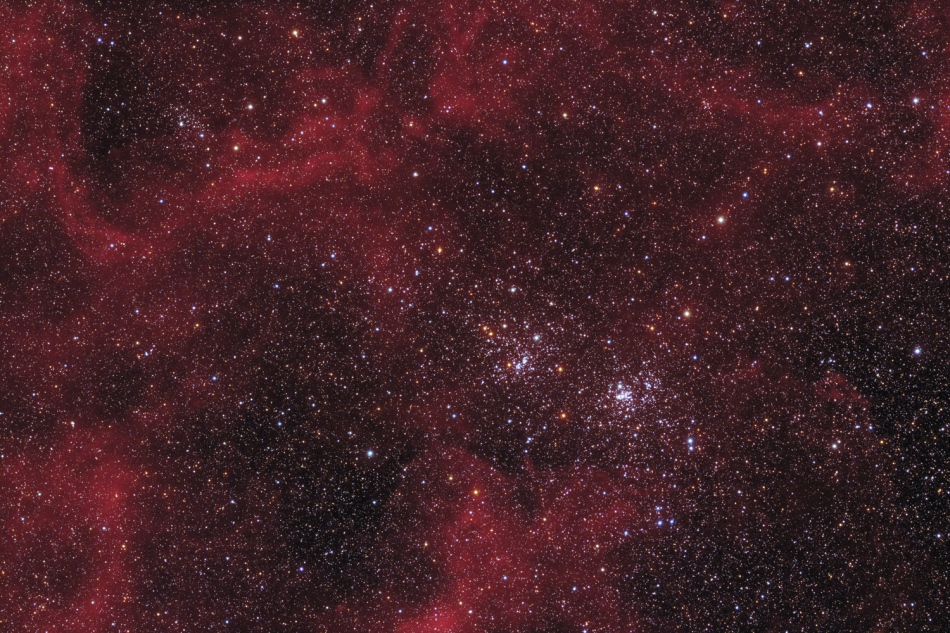 This lovely starfield spans some seven full moons (about 3.5 degrees) across the heroic northern constellation of Perseus. Just right of center it holds the famous pair of open or galactic star clusters, h and Chi Perseii. Also cataloged as NGC 869 (right) and NGC 884, both clusters are about 7,000 light-years away and contain stars much younger and hotter than the Sun. Separated by only a few hundred light-years, the clusters are both 13 million years young based on the ages of their individual stars, evidence that they were likely a product of the same star-forming region. Always a rewarding sight in binoculars, the Double Cluster is even visible to the unaided eye from dark locations. Not seen in binoculars though, and not often depicted in telescopic images of the region are faint clouds of reddish ionized hydrogen gas found throughout this remarkable cosmic skyscape. A color composite, the image includes narrowband data to enhance emission from the hydrogen clouds. Visible toward the upper left of the wide field of view is another, smaller open star cluster, NGC 957, also of similar age, distance, and possibly related to the more famous Double Cluster in Perseus. January 22, 2014  Yes, but can your blizzard do this? In Upper Michigan's Storm of the Century in 1938, some snow drifts reached the level of utility poles. Nearly a meter of new and unexpected snow fell over two days in a storm that started 76 years ago tomorrow. As snow fell and gale-force winds piled snow to surreal heights; many roads became not only impassable but unplowable; people became stranded; cars, school buses and a train became mired; and even a dangerous fire raged. Fortunately only two people were killed, although some students were forced to spend several consecutive days at school. The above image was taken by a local resident soon after the storm. Although all of this snow eventually melted, repeated snow storms like this help build lasting glaciers in snowy regions of our planet Earth. January 21, 2014  Did you see the big, bright, beautiful Full Moon last Wednesday night? That was actually a Micro Moon! On that night, the smallest Full Moon of 2014 reached its full phase only a few hours from lunar apogee, the time of its the most distant point from Earth in the Moon's elliptical orbit. Of course, last year on the night of June 22, a Full Super Moon was near perigee, the closest point in its orbit. The relative apparent size of January 15's Micro Moon is compared to the June 22 Super Moon in the above composite image digitally superimposing telescopic images from Perugia, Italy. The difference in apparent size represents a difference in distance of just under 50,000 kilometers between apogee and perigee, given the Moon's average distance of about 385,000 kilometers. How long do you have to wait to see another Full Micro Moon? Until March 5, 2015, when the lunar full phase will again occur within a few hours of lunar apogee. January 20, 2014 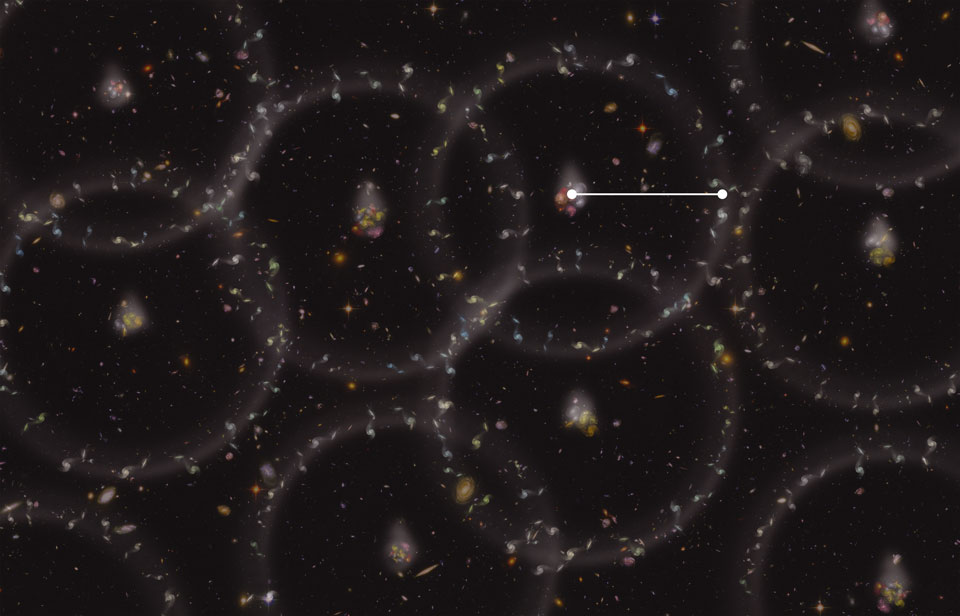 How large do things appear when far away? When peering across the universe, the answer can actually tell us about its average gravitational history and hence its composition. Toward this goal, the Baryon Oscillation Spectroscopic Survey (BOSS) of the Sloan Digital Sky Survey-III (SDSS-III) has measured slight recurring density enhancements in galaxy densities up to six billion light years away (redshift 0.7), when the universe was about half its current age. These density ripples are known as baryon acoustic oscillations (BAOs) and are expected to emerge from the early universe at a known size scale. BOSS's measurements of this size scale indicate a strong universe component of dark energy, and so bolsters previous indications of this unusual composition. Pictured above is an artist's illustration depicting exaggerated BAOs in the distant universe. January 19, 2014 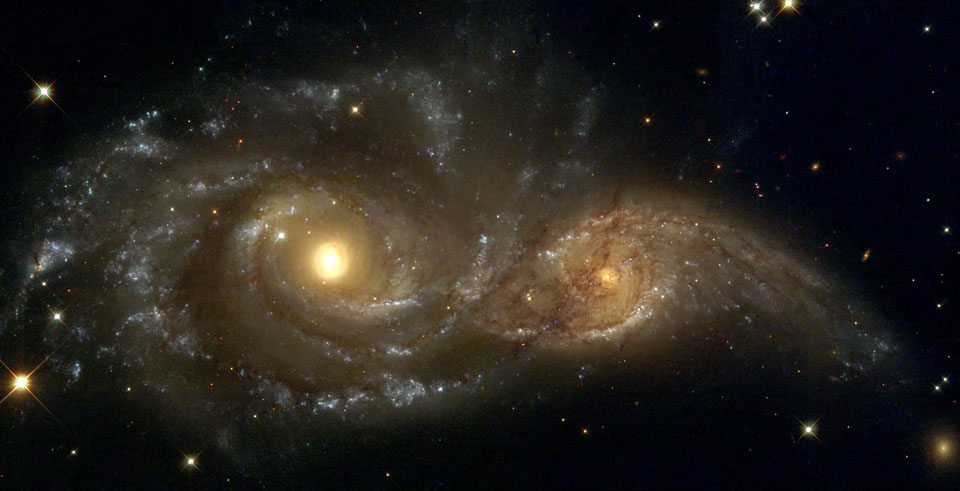 Billions of years from now, only one of these two galaxies will remain. Until then, spiral galaxies NGC 2207 and IC 2163 will slowly pull each other apart, creating tides of matter, sheets of shocked gas, lanes of dark dust, bursts of star formation, and streams of cast-away stars. Astronomers predict that NGC 2207, the larger galaxy on the left, will eventually incorporate IC 2163, the smaller galaxy on the right. In the most recent encounter that about peaked 40 million years ago, the smaller galaxy is swinging around counter-clockwise, and is now slightly behind the larger galaxy. The space between stars is so vast that when galaxies collide, the stars in them usually do not collide. January 18, 2014 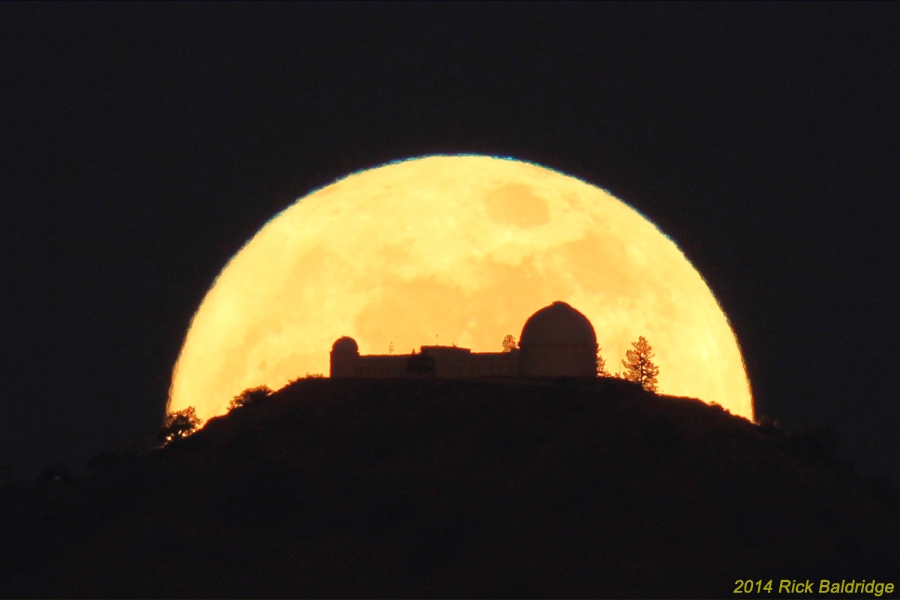 This big, bright, beautiful Full Moon rose over Lick Observatory Wednesday night. Traditionally a full moon in January might be called the Wolf Moon. But this moon reached its full phase on January 16, 4:54 UT, within about 2 hours of apogee, the most distant point in its elliptical orbit around planet Earth. That also makes it the smallest full moon of 2014. Of course the difference in apparent size between the largest and smallest full moons is hard to see, because the difference in distance between lunar apogee and perigee, or closest point in the Moon's orbit, is only about 50,000 kilometers, while the Moon's average distance is around 385,000 kilometers. Though not by much, this apogee's full moon was also the smallest full moon of the last 1,000 years. It will keep that distinction until a slightly smaller full moon occurs close to apogee in 2154. January 17, 2014  Big, bright, and beautiful, spiral galaxy M83 lies a mere twelve million light-years away, near the southeastern tip of the very long constellation Hydra. This deep view of the gorgeous island universe includes observations from Hubble, along with ground based data from the European Southern Observatory's very large telescope units, National Astronomical Observatory of Japan's Subaru telescope, and Australian Astronomical Observatory photographic data by D. Malin. About 40,000 light-years across, M83 is popularly known as the Southern Pinwheel for its pronounced spiral arms. But the wealth of reddish star forming regions found near the edges of the arms' thick dust lanes, also suggest another popular moniker for M83, the Thousand-Ruby Galaxy. Arcing near the top of the novel cosmic portrait lies M83's northern stellar tidal stream, debris from the gravitational disruption of a smaller, merging satellite galaxy. The faint, elusive star stream was found in the mid 1990s by enhancing photographic plates. January 16, 2014 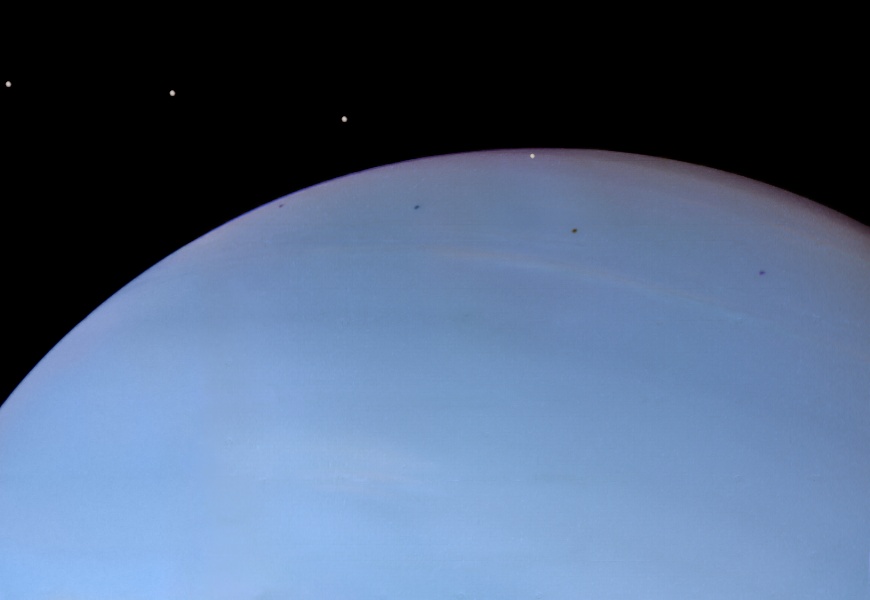 Despina is a tiny moon of Neptune. A mere 148 kilometers across, diminutive Despina was discovered in 1989, in images from the Voyager 2 spacecraft taken during its encounter with the solar system's most distant gas giant planet. But looking through the Voyager 2 data 20 years later, amateur image processor and philosophy professor Ted Stryk discovered something no one had recognized before -- images that show the shadow of Despina in transit across Neptune's blue cloud tops. His composite view of Despina and its shadow is composed of four archival frames taken on August 24, 1989, separated by nine minutes. Despina itself has been artificially brightened to make it easier to see. In ancient Greek mythology, Despina is a daughter of Poseidon, the Roman god Neptune. January 15, 2014  Few cosmic vistas excite the imagination like the Orion Nebula, an immense stellar nursery some 1,500 light-years away. This stunning false-color view spans about 40 light-years across the region, constructed using infrared data from the Spitzer Space Telescope. Compared to its visual wavelength appearance, the brightest portion of the nebula is likewise centered on Orion's young, massive, hot stars, known as the Trapezium Cluster. But the infrared image also detects the nebula's many protostars, still in the process of formation, seen here in red hues. In fact, red spots along the dark dusty filament to the left of the bright cluster include the protostar cataloged as HOPS 68, recently found to have crystals of the silicate mineral olivine within its protostellar envelope. Crystal pictures: http://www.spitzer.caltech.edu/image...f-Crystal-Rain Crystal supporting papers: http://arxiv.org/pdf/1104.4498v1.pdf January 14, 2014 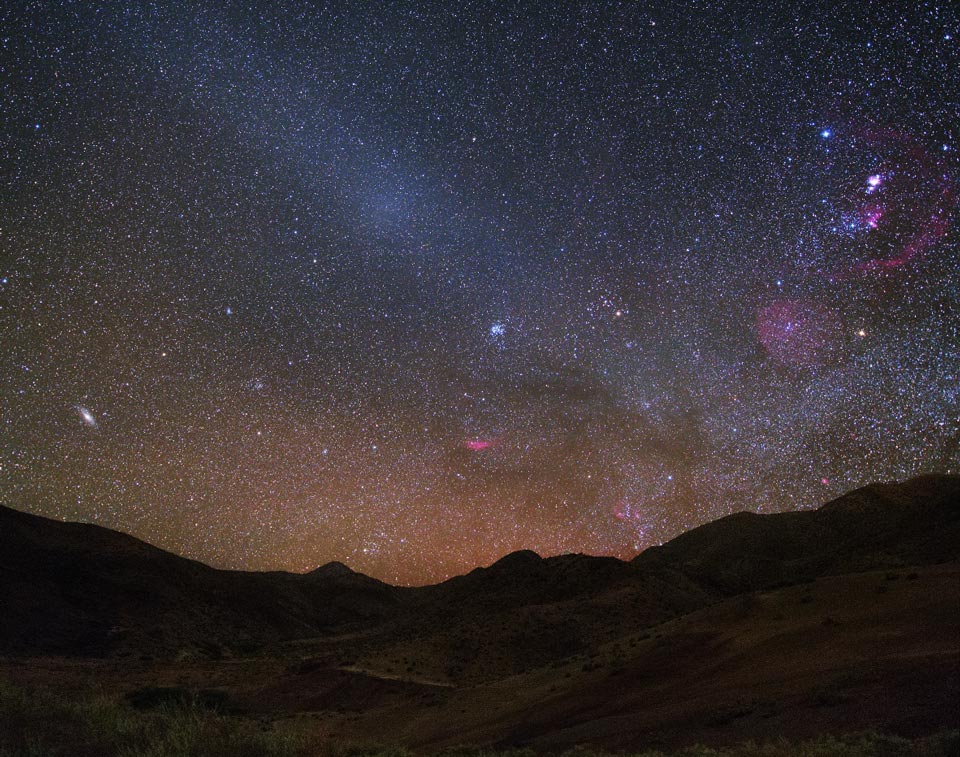 Is the night sky darkest in the direction opposite the Sun? No. In fact, a rarely discernable faint glow known as the gegenschein (German for "counter glow") can be seen 180 degrees around from the Sun in an extremely dark sky. The gegenschein is sunlight back-scattered off small interplanetary dust particles. These dust particles are millimeter sized splinters from asteroids and orbit in the ecliptic plane of the planets. Pictured above from last year is one of the more spectacular pictures of the gegenschein yet taken. Here a deep exposure of an extremely dark sky over Las Campanas Observatory in Chile shows the gegenschein so clearly that even a surrounding glow is visible. Notable background objects include the Andromeda galaxy, the Pleiades star cluster, the California Nebula, the belt of Orion just below the Orion Nebula and inside Barnard's Loop, and bright stars Sirius and Betelgeuse. The gegenschein is distinguished from zodiacal light near the Sun by the high angle of reflection. During the day, a phenomenon similar to the gegenschein called the glory can be seen in reflecting air or clouds opposite the Sun from an airplane. January 13, 2014  What would it be like to visit the Moon? The first major fictional cinematic film exploring this enduring transcultural fantasy was titled Le voyage dans la lune (A Trip to the Moon) and made in 1902, becoming one of the most popular movies of the early years of the twentieth century. The silent film starred the filmmaker Georges Melies himself and portrayed a club of astronomers voyaging to the Moon and back. Pictured above is a frame from the movie that has become an enduring icon for both film and space. Alluding to a bullseye trajectory, the Man in the Moon is caricatured as being struck by the human-built spaceship. The entire 14-minute film is now freely available. Visiting the Moon remained a very popular topic even 67 years later in 1969 when humans first made an actual voyage. The movie: http://www.youtube.com/watch?v=_FrdVdKlxUk The movie rescored: http://www.youtube.com/watch?v=vNVmYxc6iZ4 January 12, 2014 Source: What does the universe look like on small scales? On large scales? Humanity is discovering that the universe is a very different place on every proportion that has been explored. For example, so far as we know, every tiny proton is exactly the same, but every huge galaxy is different. On more familiar scales, a small glass table top to a human is a vast plane of strange smoothness to a dust mite -- possibly speckled with cell boulders. Not all scale lengths are well explored -- what happens to the smallest mist droplets you sneeze, for example, is a topic of active research -- and possibly useful to know to help stop the spread of disease. The above interactive flash animation, a modern version of the classic video Powers of Ten, is a new window to many of the known scales of our universe. By moving the scroll bar across the bottom, you can explore a diversity of sizes, while clicking on different items will bring up descriptive information. January 11, 2014 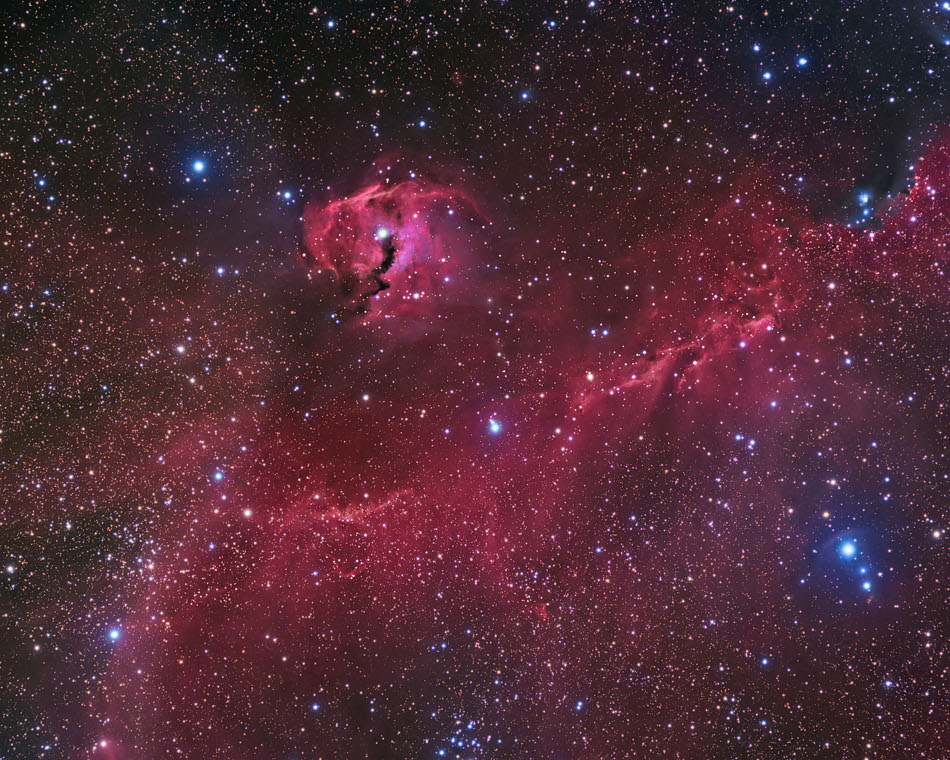 A broad expanse of glowing gas and dust presents a bird-like visage to astronomers from planet Earth, suggesting its popular moniker - The Seagull Nebula. This portrait of the cosmic bird covers a 1.6 degree wide swath across the plane of the Milky Way, near the direction of Sirius, alpha star of the constellation Canis Major. Of course, the region includes objects with other catalog designations: notably NGC 2327, a compact, dusty emission region with an embedded massive star that forms the bird's head (aka the Parrot Nebula, above center). Dominated by the reddish glow of atomic hydrogen, the complex of gas and dust clouds with bright young stars spans over 100 light-years at an estimated 3,800 light-year distance. January 10, 2014 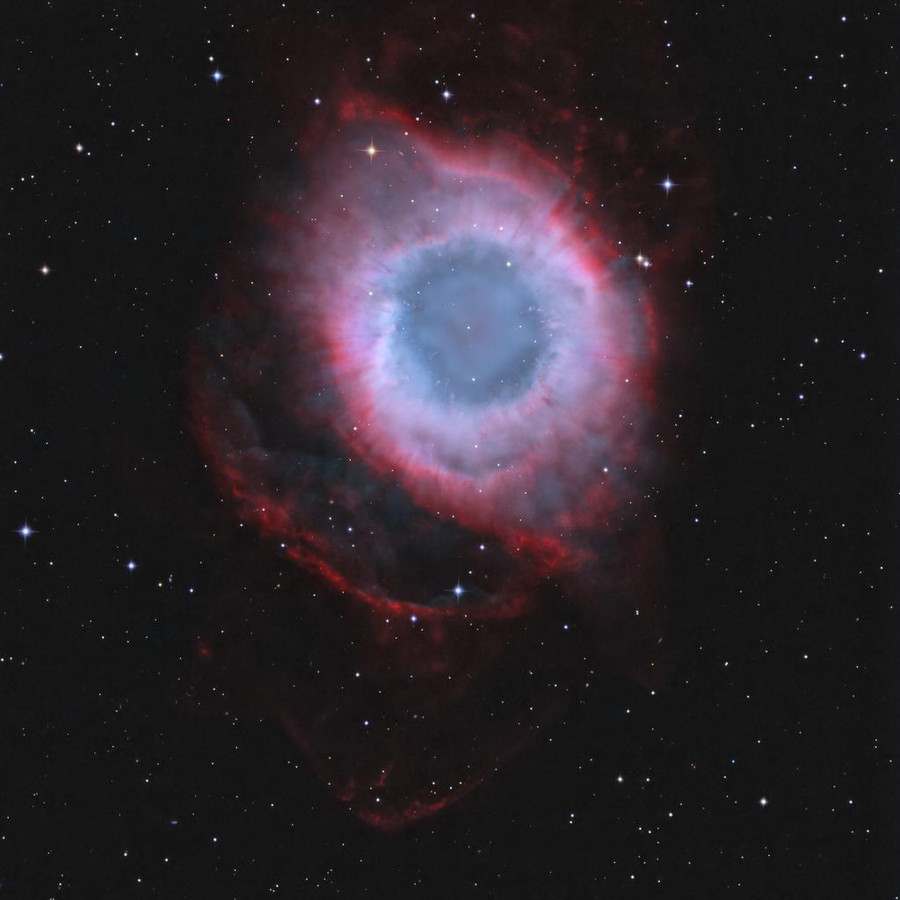 A mere seven hundred light years from Earth, in the constellation Aquarius, a sun-like star is dying. Its last few thousand years have produced the Helix Nebula (NGC 7293), a well studied and nearby example of a Planetary Nebula, typical of this final phase of stellar evolution. A total of 28.5 hours of exposure time have gone in to creating this deep view of the nebula. Combining narrow band image data from emission lines of hydrogen atoms in red and oxygen atoms in blue-green hues, it shows remarkable details of the Helix's brighter inner region, about 3 light-years across, but also follows fainter outer halo features that give the nebula a span of well over six light-years. The white dot at the Helix's center is this Planetary Nebula's hot, central star. A simple looking nebula at first glance, the Helix is now understood to have a surprisingly complex geometry. January 9, 2014 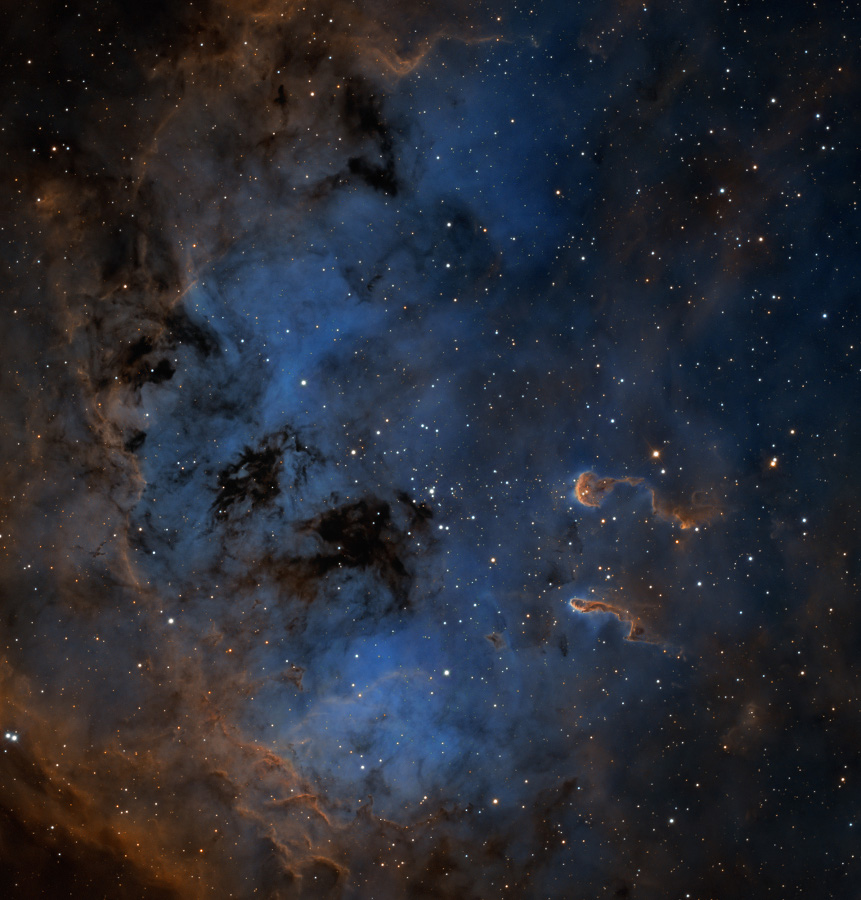 This telescopic close-up shows off the otherwise faint emission nebula IC 410 in striking false-colors. It also features two remarkable inhabitants of the cosmic pond of gas and dust below and right of center, the tadpoles of IC 410. The picture is a composite of images taken through narrow band filters. The narrow band image data traces atoms in the nebula, with emission from sulfur atoms in red, hydrogen atoms in green, and oxygen in blue. Partly obscured by foreground dust, the nebula itself surrounds NGC 1893, a young galactic cluster of stars that energizes the glowing gas. Composed of denser cooler gas and dust the tadpoles are around 10 light-years long, potentially sites of ongoing star formation. Sculpted by wind and radiation from the cluster stars, their tails trail away from the cluster's central region. IC 410 lies some 12,000 light-years away, toward the constellation Auriga. January 8, 2014  Sunsets may be the most watched celestial event, but lately sunsets have even offered something extra. A sunspot so large it was visible to the naked eye is captured in Swiss skies in this sunset scene from January 5, crossing left to right near the center of a solar disk dimmed and distorted by Earth's dense atmosphere. Detailed views reveal a large solar active region composed of sunspots, some larger than planet Earth itself. Cataloged as active region AR 1944, on January 7 it produced a substantial solar flare and a coronal mass ejection (CME) forecast to reach Earth. The CME could trigger geomagnetic storms and aurora on January 9. January 7, 2014  M7 is one of the most prominent open clusters of stars on the sky. The cluster, dominated by bright blue stars, can be seen with the naked eye in a dark sky in the tail of the constellation of the Scorpion (Scorpius). M7 contains about 100 stars in total, is about 200 million years old, spans 25 light-years across, and lies about 1000 light-years away. The above deep image, taken last June from Hungary through a small telescope, combines over 60 two-minute exposures. The M7 star cluster has been known since ancient times, being noted by Ptolemy in the year 130 AD. Also visible are a dark dust cloud and literally millions of unrelated stars towards the Galactic center. January 6, 2014 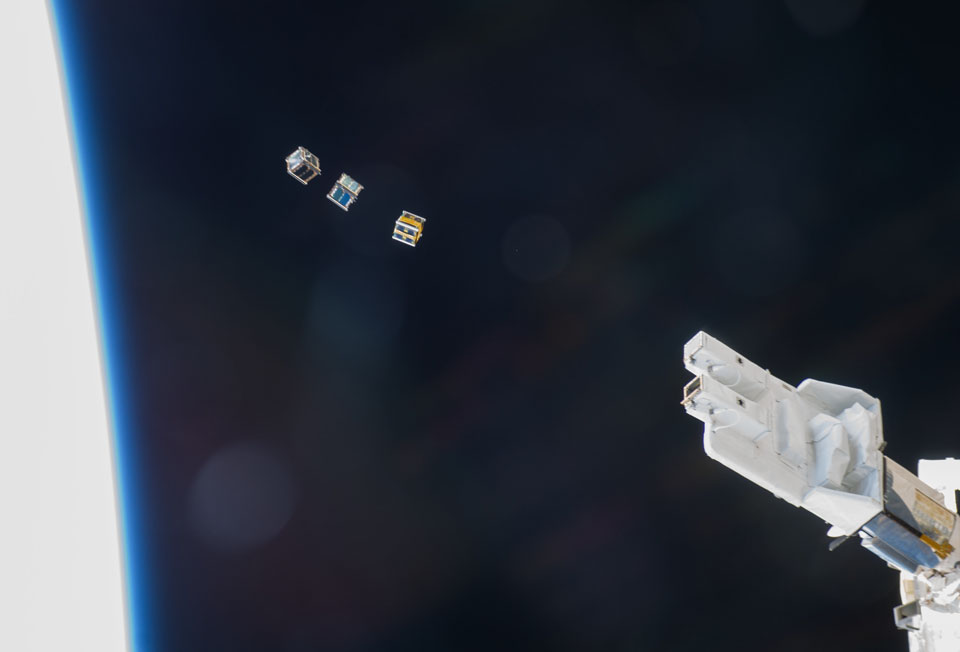 Cubes are orbiting the Earth. Measuring ten-centimeters on a side, CubeSats - each roughly the size of a large coffee mug -- are designed to be inexpensive both to build and to launch. Pictured above, three CubeSats were released from the International Space Station (ISS) last November by the arm of the Japanese Kibo Laboratory module. CubeSats are frequently created by students as part of university science or engineering projects and include missions such as collecting wide angle imagery of the Earth, testing orbital radio communications, monitoring the Earth's magnetic field, and exploring the Earth's surrounding radiations. Depending on the exact height of their release, CubeSats will re-enter the Earth's atmosphere on the time scale of months to years. January 5, 2014 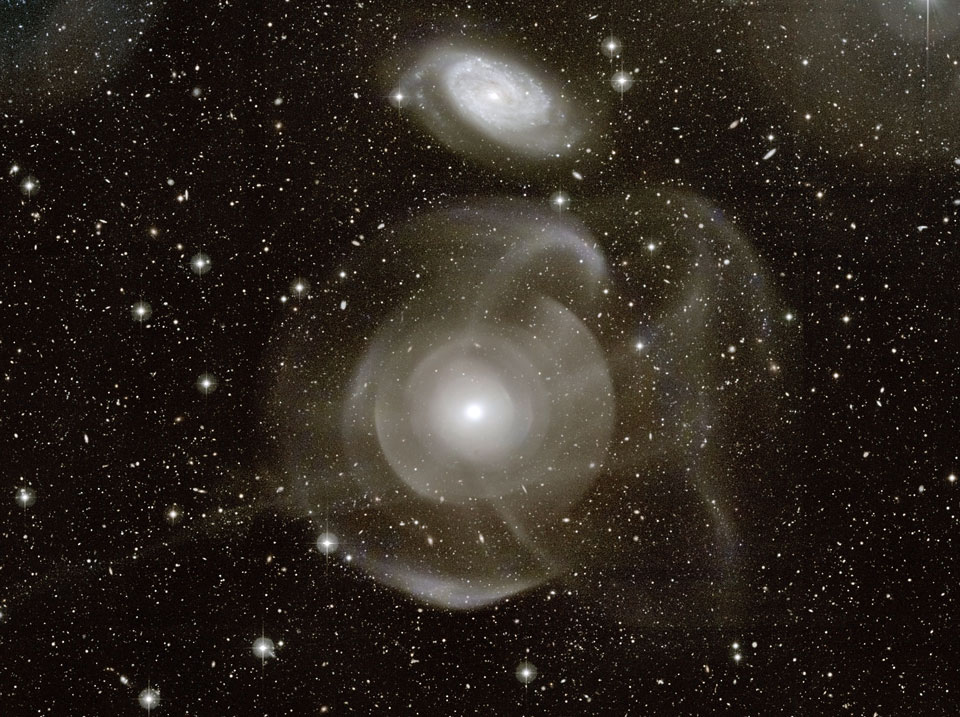 A crescent Venus shines along the western horizon at dusk in this clearing sky. The Earth's sister planet is smiling between the low clouds near the bottom of the frame during its January 2nd conjunction with the slender, young crescent Moon above. Of course the lovely pairing of Moon and Venus crescents could be enjoyed in the new year's skies around the the world. But the twin contrails in this scene belong to an aircraft above Appenzell, Switzerland. Soon to disappear from evening skies, Venus is heading toward its January 11th inferior conjunction and an appearance in predawn skies as planet Earth's morning star by late January. And the Moon will be young again, too. January 4, 2014 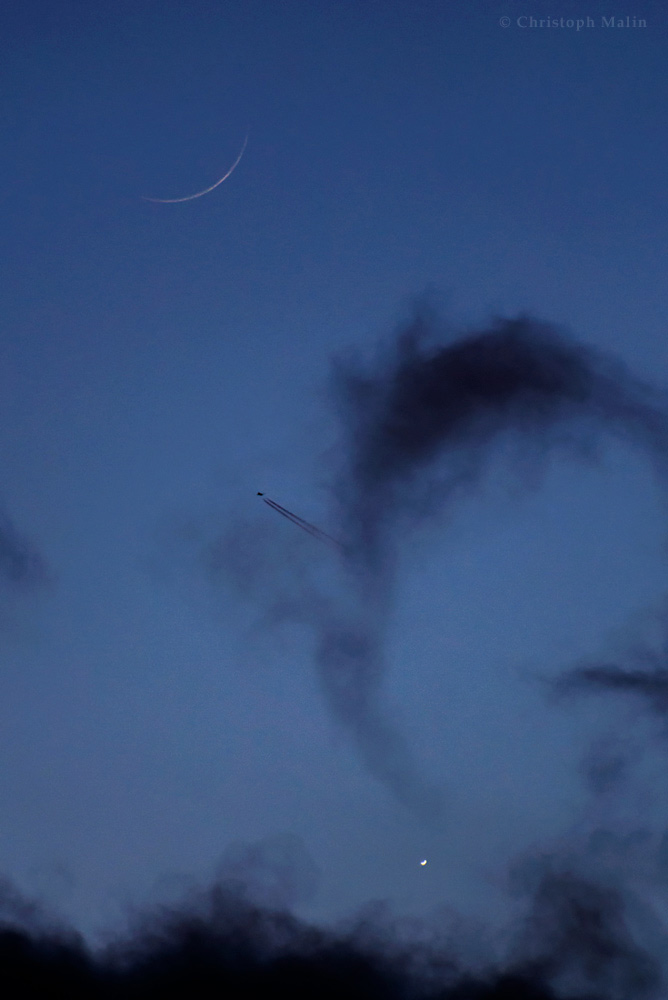 A crescent Venus shines along the western horizon at dusk in this clearing sky. The Earth's sister planet is smiling between the low clouds near the bottom of the frame during its January 2nd conjunction with the slender, young crescent Moon above. Of course the lovely pairing of Moon and Venus crescents could be enjoyed in the new year's skies around the the world. But the twin contrails in this scene belong to an aircraft above Appenzell, Switzerland. Soon to disappear from evening skies, Venus is heading toward its January 11th inferior conjunction and an appearance in predawn skies as planet Earth's morning star by late January. And the Moon will be young again, too. January 3, 2014 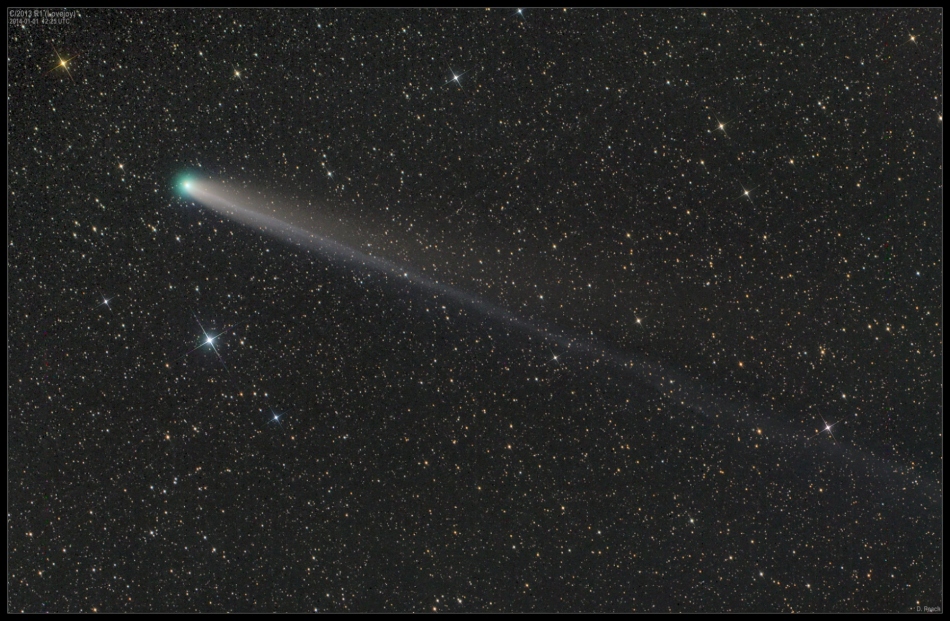 A rival to vanquished Comet ISON in 2013, Comet Lovejoy (C/2013 R1) still sweeps through early morning skies, captured in this starry scene on New Year's day. The frame stretches some 3.5 degrees across a background of faint stars in the constellation Hercules. Only just visible to the naked eye from dark sites before dawn, Lovejoy remains a good target for the northern hemisphere's binocular equipped skygazers. But this deep exposure shows off Lovejoy's beautiful tails and tantalizing greenish coma better than binocular views. Not a sungrazer, this Comet Lovejoy made its closest approach to the Sun around December 22, looping high above the ecliptic plane. Now headed for the outer Solar System, Lovejoy began the new year about 6.7 light-minutes from planet Earth. January 2, 2014  That's not the young crescent Moon poised above the western horizon at sunset. Instead it's Venus in a crescent phase, captured with a long telephoto lens from Quebec City, Canada, planet Earth on a chilly December 30th evening. The very bright celestial beacon is droping lower into the evening twilight every day. But it also grows larger in apparent size and becomes a steadily thinner crescent in binocular views as it heads toward an inferior conjunction, positioned between the Earth and the Sun on January 11. The next few evenings will see a young crescent Moon join the crescent Venus in the western twilight, though. Historically, the first observations of the phases of Venus were made by Galileo with his telescope in 1610, evidence consistent with the Copernican model of the Solar System, but not the Ptolemaic system. January 1, 2014  That's not the young crescent Moon poised above the western horizon at sunset. Instead it's Venus in a crescent phase, captured with a long telephoto lens from Quebec City, Canada, planet Earth on a chilly December 30th evening. The very bright celestial beacon is droping lower into the evening twilight every day. But it also grows larger in apparent size and becomes a steadily thinner crescent in binocular views as it heads toward an inferior conjunction, positioned between the Earth and the Sun on January 11. The next few evenings will see a young crescent Moon join the crescent Venus in the western twilight, though. Historically, the first observations of the phases of Venus were made by Galileo with his telescope in 1610, evidence consistent with the Copernican model of the Solar System, but not the Ptolemaic system.
__________________
1st in Kommisar's 2009 SM Tournament 1st in I Love You`s 2009 New Year`s Tournament 3rd in EnR's Mashfest '08 tournament 5th in Phynx's Unofficial FFR Tournament 9th in D3 of the 2008-2009 4th Official FFR Tournament 10th in D5 of the 2010 5th Official FFR Tournament 10th in D6 of the 2011-2012 6th Official FFR Tournament FMO AAA Count: 71 FGO AAA Count: 10 Bluearrowll = The Canadian player who can not detect awkward patterns. If it's awkward for most people, it's normal for Terry. If the file is difficult but super straight forward, he has issues. If he's AAAing a FGO but then heard that his favorite Hockey team was losing by a point, Hockey > FFR PS: Cool AAA's Terry - I Love You An Alarm Clock's Haiku beep beep beep beep beep beep beep beep beep beep beep beep beep beep beep beep beep - ieatyourlvllol Last edited by Bluearrowll; 06-8-2014 at 11:23 AM.. |
|
|

|
|
|
#102 |
|
⊙▃⊙
|
What's in the sky tonight?
April 18, 2012 May 5, 2012 -Full Moon (exact at 11:35 p.m. EDT), in Libra. This is the closest and largest full Moon of 2012, though not remarkably so. The Moon is 8% closer and larger than average, and only 0.16 magnitude brighter than average, so you'd need measuring tools to really tell. Take a look. What do you think?  The moon will rise at 8:16PM in Toronto. It will vary depending where you live. Use this to calculate when it will rise in your location. Astro Picture of the Day: April 18, 2012 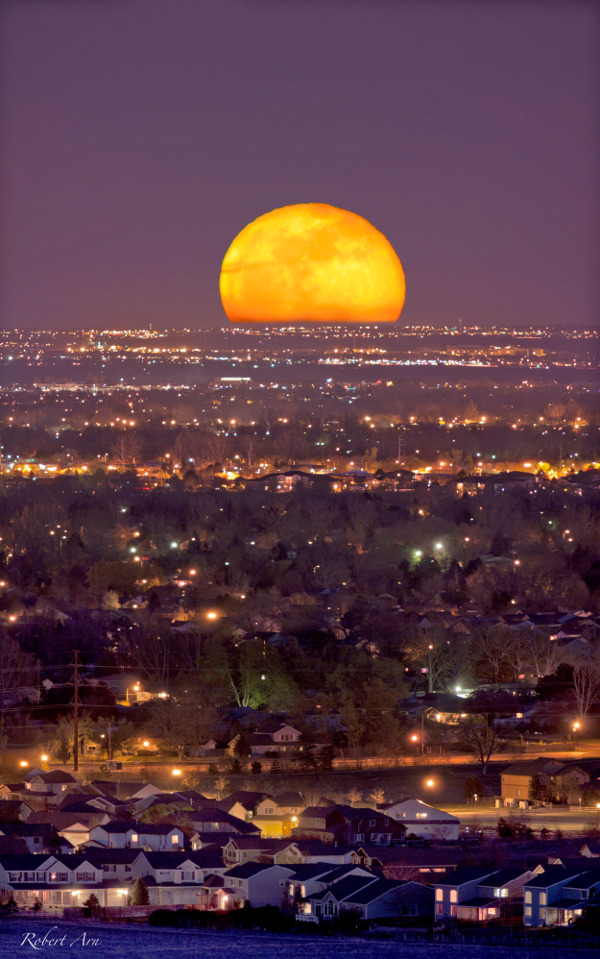 Rising as the Sun sets, tonight's Full Moon could be hard to miss. Remarkably, its exact full phase (May 6 03:36 UT) will occur less than two minutes after it reaches perigee, the closest point to Earth in the Moon's orbit, making it the largest Full Moon of 2012. The Full Perigee Moon will appear to be some 14 percent larger and 30 percent brighter than a Full Moon near apogee, the most distant point in the elliptical lunar orbit. In comparison, though, it will appear less than 1 percent larger and almost as bright as April's Full Moon, captured in this telephoto image rising over suburban Fort Collins, Colorado, USA. For that lunation, Full Moon and perigee were about 21 hours apart. Of course, if you manage to miss May's Full Perigee Moon, make a note on your calendar. Your next chance to see a Full Moon close to perigee, will be next year on June 23.
__________________
1st in Kommisar's 2009 SM Tournament 1st in I Love You`s 2009 New Year`s Tournament 3rd in EnR's Mashfest '08 tournament 5th in Phynx's Unofficial FFR Tournament 9th in D3 of the 2008-2009 4th Official FFR Tournament 10th in D5 of the 2010 5th Official FFR Tournament 10th in D6 of the 2011-2012 6th Official FFR Tournament FMO AAA Count: 71 FGO AAA Count: 10 Bluearrowll = The Canadian player who can not detect awkward patterns. If it's awkward for most people, it's normal for Terry. If the file is difficult but super straight forward, he has issues. If he's AAAing a FGO but then heard that his favorite Hockey team was losing by a point, Hockey > FFR PS: Cool AAA's Terry - I Love You An Alarm Clock's Haiku beep beep beep beep beep beep beep beep beep beep beep beep beep beep beep beep beep - ieatyourlvllol Last edited by Bluearrowll; 05-5-2012 at 12:01 PM.. |
|
|

|
|
|
#103 |
|
⊙▃⊙
|
What's in the sky tonight?
May 6, 2012 -Venus, the brilliant "Evening Star" in the west, is passing its closest to the star Beta Tauri, which is only 1/300 as bright at magnitude 1.6. During and after late twilight, look for the star 0.8° to Venus's upper right. That's about a pencil-width at arm's length. Although they look close together, they're not. Venus is 3 light-minutes from us; Beta Tauri is 130 light-years in the background. Here is a personal photo of mine of the pair from last night. May 6, 2012 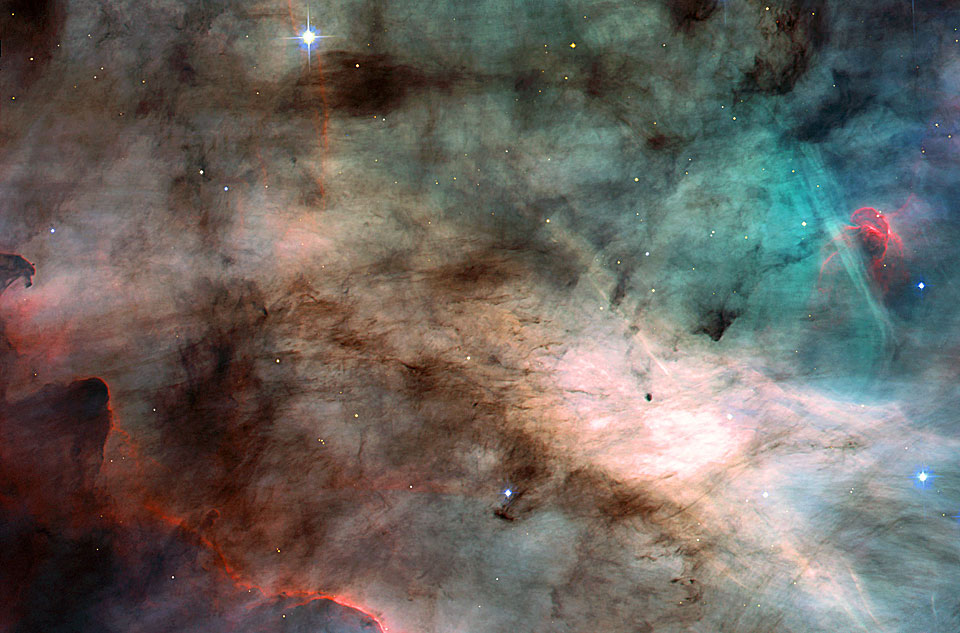 In the depths of the dark clouds of dust and molecular gas known as the Omega Nebula, stars continue to form. The above image from the Hubble Space Telescope's Advanced Camera for Surveys shows exquisite detail in the famous star-forming region. The dark dust filaments that lace the center of Omega Nebula were created in the atmospheres of cool giant stars and in the debris from supernova explosions. The red and blue hues arise from glowing gas heated by the radiation of massive nearby stars. The points of light are the young stars themselves, some brighter than 100 Suns. Dark globules mark even younger systems, clouds of gas and dust just now condensing to form stars and planets. The Omega Nebula lies about 5000 light years away toward the constellation of Sagittarius. The region shown spans about 3000 times the diameter of our Solar System.
__________________
1st in Kommisar's 2009 SM Tournament 1st in I Love You`s 2009 New Year`s Tournament 3rd in EnR's Mashfest '08 tournament 5th in Phynx's Unofficial FFR Tournament 9th in D3 of the 2008-2009 4th Official FFR Tournament 10th in D5 of the 2010 5th Official FFR Tournament 10th in D6 of the 2011-2012 6th Official FFR Tournament FMO AAA Count: 71 FGO AAA Count: 10 Bluearrowll = The Canadian player who can not detect awkward patterns. If it's awkward for most people, it's normal for Terry. If the file is difficult but super straight forward, he has issues. If he's AAAing a FGO but then heard that his favorite Hockey team was losing by a point, Hockey > FFR PS: Cool AAA's Terry - I Love You An Alarm Clock's Haiku beep beep beep beep beep beep beep beep beep beep beep beep beep beep beep beep beep - ieatyourlvllol Last edited by Bluearrowll; 05-6-2012 at 12:18 PM.. |
|
|

|
|
|
#104 |
|
⊙▃⊙
|
Also, did you miss the ~supermoon~? Don't worry if you did, I was attentive to capturing this (once a year) event that the media hypes up.
Open the spoiler to see a chronological order of what all the hype was about! Here, I have captured Saturn (left) Spica (right) above the moon and a bit to the right. This is essentially my viewing point from the whole show.
__________________
1st in Kommisar's 2009 SM Tournament 1st in I Love You`s 2009 New Year`s Tournament 3rd in EnR's Mashfest '08 tournament 5th in Phynx's Unofficial FFR Tournament 9th in D3 of the 2008-2009 4th Official FFR Tournament 10th in D5 of the 2010 5th Official FFR Tournament 10th in D6 of the 2011-2012 6th Official FFR Tournament FMO AAA Count: 71 FGO AAA Count: 10 Bluearrowll = The Canadian player who can not detect awkward patterns. If it's awkward for most people, it's normal for Terry. If the file is difficult but super straight forward, he has issues. If he's AAAing a FGO but then heard that his favorite Hockey team was losing by a point, Hockey > FFR PS: Cool AAA's Terry - I Love You An Alarm Clock's Haiku beep beep beep beep beep beep beep beep beep beep beep beep beep beep beep beep beep - ieatyourlvllol |
|
|

|
|
|
#105 |
|
⊙▃⊙
|
What's in the sky tonight?
May 7, 2012 -The waning gibbous Moon is up in the southeast by around 11 p.m., depending on where you live. Look about a fist-width to the Moon's right for fiery Antares. Around and upper right of Antares are other stars of Scorpius. -Jupiter is lost in the glare of the Sun. Astro Picture of the Day: May 7, 2012 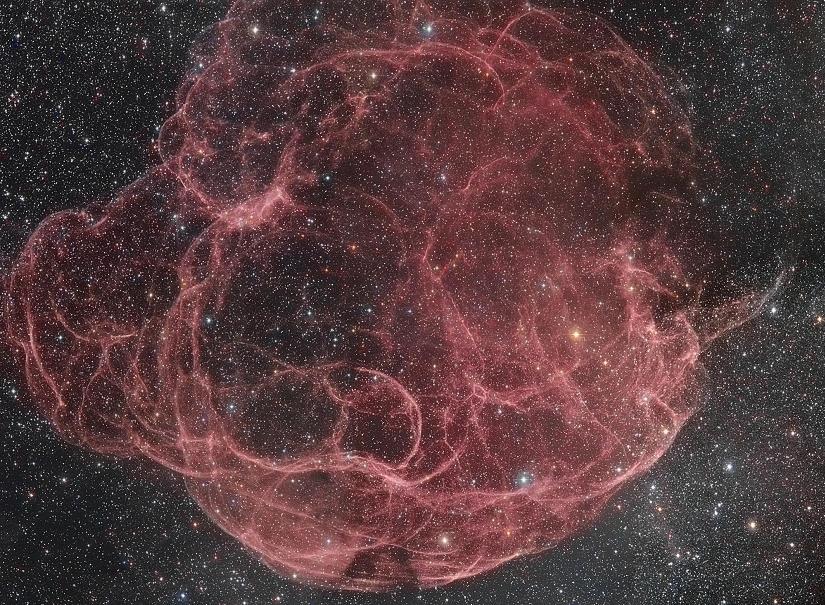 It's easy to get lost following the intricate filaments in this detailed mosaic image of faint supernova remnant Simeis 147. Also cataloged as Sh2-240 and seen towards the constellation Taurus, it covers nearly 3 degrees (6 full moons) on the sky. That corresponds to a width of 150 light-years at the stellar debris cloud's estimated distance of 3,000 light-years. The remarkable composite includes image data taken through narrow-band filters to highlight emission from hydrogen and oxygen atoms tracing regions of shocked, glowing gas. This supernova remnant has an estimated age of about 40,000 years - meaning light from the massive stellar explosion first reached Earth 40,000 years ago. But this expanding remnant is not the only aftermath. The cosmic catastrophe also left behind a spinning neutron star or pulsar, all that remains of the original star's core.
__________________
1st in Kommisar's 2009 SM Tournament 1st in I Love You`s 2009 New Year`s Tournament 3rd in EnR's Mashfest '08 tournament 5th in Phynx's Unofficial FFR Tournament 9th in D3 of the 2008-2009 4th Official FFR Tournament 10th in D5 of the 2010 5th Official FFR Tournament 10th in D6 of the 2011-2012 6th Official FFR Tournament FMO AAA Count: 71 FGO AAA Count: 10 Bluearrowll = The Canadian player who can not detect awkward patterns. If it's awkward for most people, it's normal for Terry. If the file is difficult but super straight forward, he has issues. If he's AAAing a FGO but then heard that his favorite Hockey team was losing by a point, Hockey > FFR PS: Cool AAA's Terry - I Love You An Alarm Clock's Haiku beep beep beep beep beep beep beep beep beep beep beep beep beep beep beep beep beep - ieatyourlvllol |
|
|

|
|
|
#106 |
|
⊙▃⊙
|
What's in the sky tonight?
May 8, 2012 -The brightest star very high in the east these evenings is Arcturus. Look three fist-widths to its lower right for Saturn and, a little farther on, Spica. -Mars in a telescope is gibbous and small, about 9.5 arcseconds wide, fading and shrinking each week. Regulus is about 7° Mars's right or lower right and moving farther from it daily. Fainter Gamma Leonis is 8° above Regulus. Astro Picture of the Day: May 8, 2012 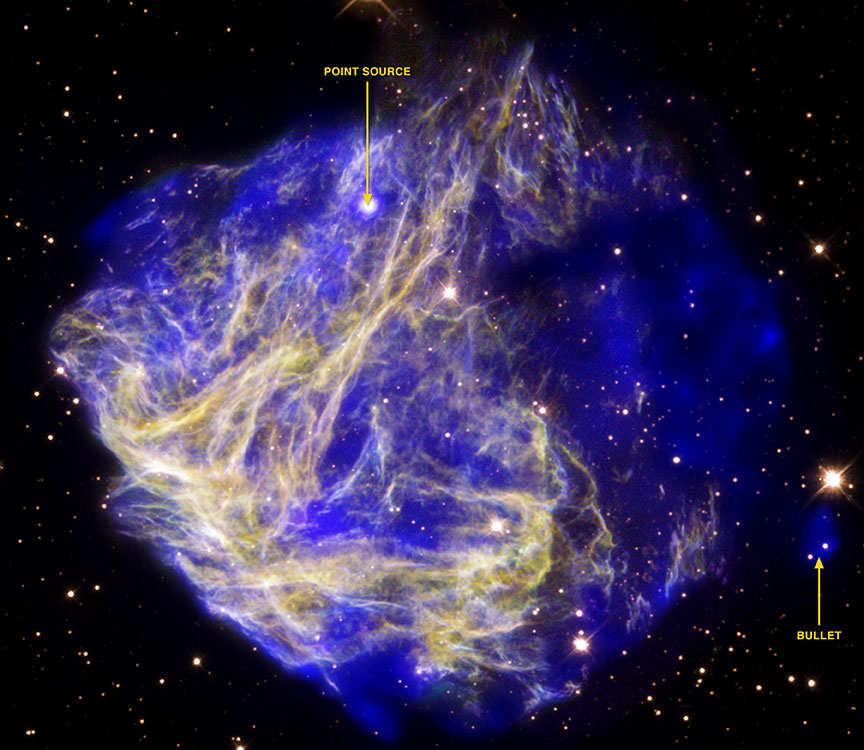 What is that strange blue blob on the far right? No one is sure, but it might be a speeding remnant of a powerful supernova that was unexpectedly lopsided. Scattered debris from supernova explosion N49 lights up the sky in this gorgeous composited image based on data from the Chandra and Hubble Space Telescopes. Glowing visible filaments, shown in yellow, and X-ray hot gas, shown in blue, span about 30 light-years in our neighboring galaxy, the Large Magellanic Cloud. Light from the original exploding star reached Earth thousands of years ago, but N49 also marks the location of another energetic outburst -- an extremely intense blast of gamma-rays detected by satellites about 30 years ago on 1979 March 5. The source of the March 5th Event is now attributed to a magnetar - a highly magnetized, spinning neutron star also born in the ancient stellar explosion which created supernova remnant N49. The magnetar, visible near the top of the image, hurtles through the supernova debris cloud at over 70 thousand kilometers per hour. The blue blob on the far right, however, might have been expelled asymmetrically just as a massive star was exploding. If so, it now appears to be moving over 7 million kilometers per hour.
__________________
1st in Kommisar's 2009 SM Tournament 1st in I Love You`s 2009 New Year`s Tournament 3rd in EnR's Mashfest '08 tournament 5th in Phynx's Unofficial FFR Tournament 9th in D3 of the 2008-2009 4th Official FFR Tournament 10th in D5 of the 2010 5th Official FFR Tournament 10th in D6 of the 2011-2012 6th Official FFR Tournament FMO AAA Count: 71 FGO AAA Count: 10 Bluearrowll = The Canadian player who can not detect awkward patterns. If it's awkward for most people, it's normal for Terry. If the file is difficult but super straight forward, he has issues. If he's AAAing a FGO but then heard that his favorite Hockey team was losing by a point, Hockey > FFR PS: Cool AAA's Terry - I Love You An Alarm Clock's Haiku beep beep beep beep beep beep beep beep beep beep beep beep beep beep beep beep beep - ieatyourlvllol |
|
|

|
|
|
#107 |
|
⊙▃⊙
|
What's in the sky tonight?
May 9, 2012 -Look for bright Vega moderately low in the northeast after darkness falls, and higher later. To Vega's lower right dangle fainter stars of the little constellation Lyra. -Venus is now a crescent about 42 arcseconds tall and 20% sunlit, waning and enlarging daily. Venus will transit the face of the Sun on June 5–6 (on the afternoon of the 5th for North America). This is the last transit of Venus until 2117. Astro Picture of the Day: May 9, 2012 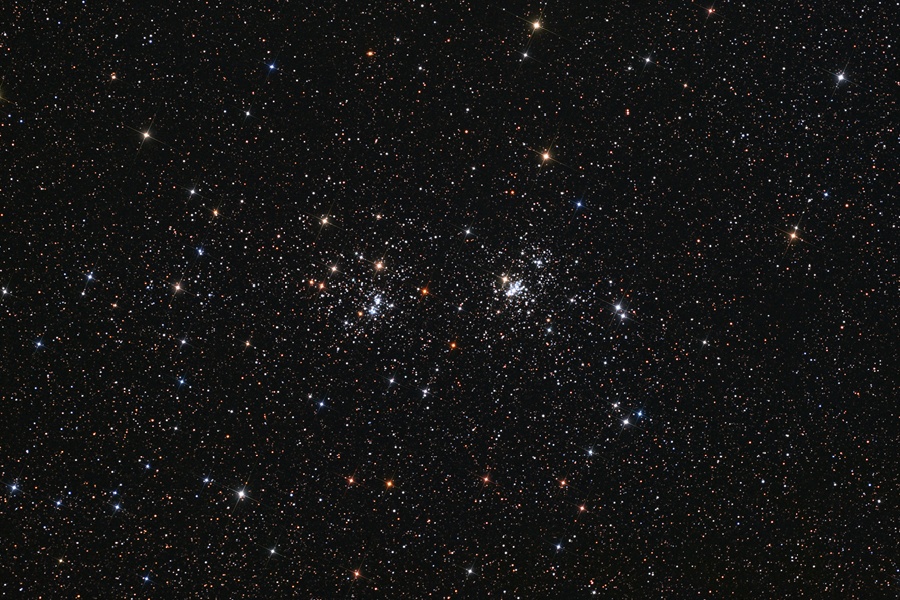 A lovely starfield in the heroic northern constellation Perseus holds this famous pair of open or galactic star clusters, h and Chi Perseii. Also cataloged as NGC 869 (right) and NGC 884, both clusters are about 7,000 light-years away and contain stars much younger and hotter than the Sun. Separated by only a few hundred light-years, the clusters' ages based on their individual stars are similar - evidence that they were likely a product of the same star-forming region. Always a rewarding sight in binoculars, the Double Cluster is even visible to the unaided eye from dark locations. Star colors (and spikes) are enhanced in this beautiful, wide field, telescopic image.
__________________
1st in Kommisar's 2009 SM Tournament 1st in I Love You`s 2009 New Year`s Tournament 3rd in EnR's Mashfest '08 tournament 5th in Phynx's Unofficial FFR Tournament 9th in D3 of the 2008-2009 4th Official FFR Tournament 10th in D5 of the 2010 5th Official FFR Tournament 10th in D6 of the 2011-2012 6th Official FFR Tournament FMO AAA Count: 71 FGO AAA Count: 10 Bluearrowll = The Canadian player who can not detect awkward patterns. If it's awkward for most people, it's normal for Terry. If the file is difficult but super straight forward, he has issues. If he's AAAing a FGO but then heard that his favorite Hockey team was losing by a point, Hockey > FFR PS: Cool AAA's Terry - I Love You An Alarm Clock's Haiku beep beep beep beep beep beep beep beep beep beep beep beep beep beep beep beep beep - ieatyourlvllol |
|
|

|
|
|
#108 |
|
⊙▃⊙
|
What's in the sky tonight?
May 10, 2012 -For deep-sky observers, a favorite springtime telescopic star-hop runs from the end of the Big Dipper's handle to the Whirlpool Galaxy, M51, and on to the Sunflower Galaxy, M63. -Venus is now a crescent about 42 arcseconds tall and 20% sunlit, waning and enlarging daily. Venus will transit the face of the Sun on June 5–6 (on the afternoon of the 5th for North America). This is the last transit of Venus until 2117. This will be talked about in great detail as this date approaches. Astro Picture of the Day: May 10, 2012 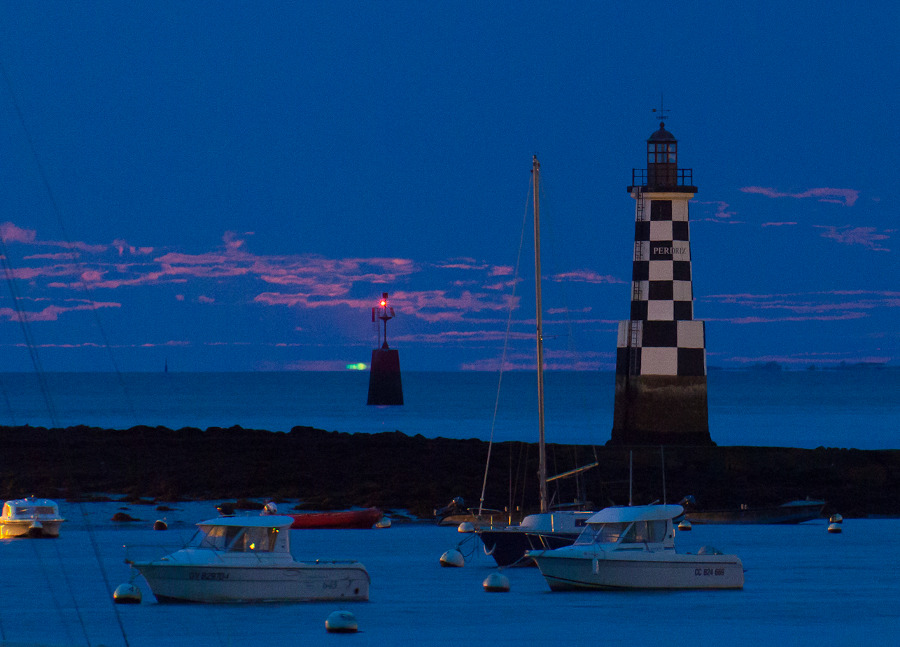 The rise of the Super Moon was preceded by a Green Flash, captured in the first frame of this timelapse video recorded that night in Brittany, France. The cropped image of the frame, a two second long exposure, shows the strongly colored flash left of the lighted buoy near picture center. While the Super Moon was enjoyed at locations all around the world, the circumstances that produced the Green Flash were more restrictive. Green flashes for both Sun and Moon are caused by atmospheric refraction enhanced by long, low, sight lines and strong atmospheric temperature gradients often favored by a sea horizon. The matching video can be found here, which really gives an impression on how long the green flash lasts.: http://vimeo.com/41670884
__________________
1st in Kommisar's 2009 SM Tournament 1st in I Love You`s 2009 New Year`s Tournament 3rd in EnR's Mashfest '08 tournament 5th in Phynx's Unofficial FFR Tournament 9th in D3 of the 2008-2009 4th Official FFR Tournament 10th in D5 of the 2010 5th Official FFR Tournament 10th in D6 of the 2011-2012 6th Official FFR Tournament FMO AAA Count: 71 FGO AAA Count: 10 Bluearrowll = The Canadian player who can not detect awkward patterns. If it's awkward for most people, it's normal for Terry. If the file is difficult but super straight forward, he has issues. If he's AAAing a FGO but then heard that his favorite Hockey team was losing by a point, Hockey > FFR PS: Cool AAA's Terry - I Love You An Alarm Clock's Haiku beep beep beep beep beep beep beep beep beep beep beep beep beep beep beep beep beep - ieatyourlvllol |
|
|

|
|
|
#109 |
|
⊙▃⊙
|
What's in the sky tonight?
May 11, 2012 -Brilliant Venus is dropping lower in the west-northwest every evening this month. A telescope shows it enlarging and waning in phase, as shown here; it's swinging ever closer to the line between us and the Sun. Look a little to its right for the much fainter star Beta Tauri. As of tonight the planet and star are 1½° apart. Astro Picture of the Day: May 11, 2012 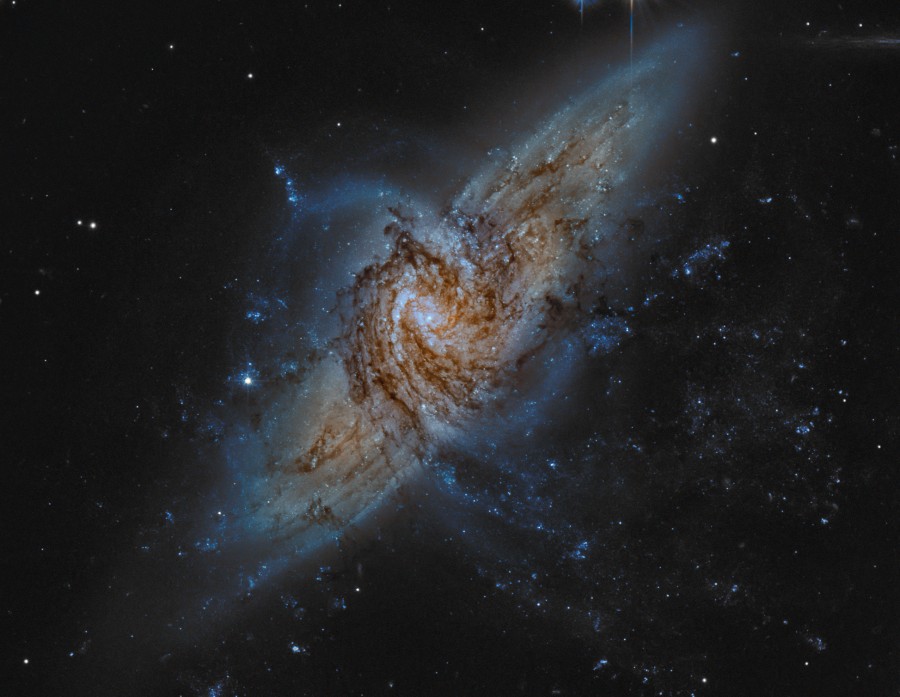 NGC 3314 is actually two large spiral galaxies which just happen to almost exactly line up. The foreground spiral is viewed nearly face-on, its pinwheel shape defined by young bright star clusters. But against the glow of the background galaxy, dark swirling lanes of interstellar dust appear to dominate the face-on spiral's structure. The dust lanes are surprisingly pervasive, and this remarkable pair of overlapping galaxies is one of a small number of systems in which absorption of light from beyond a galaxy's own stars can be used to directly explore its distribution of dust. NGC 3314 is about 140 million light-years (background galaxy) and 117 million light-years (foreground galaxy) away in the multi-headed constellation Hydra. The background galaxy would span nearly 70,000 light-years at its estimated distance. A synthetic third channel was created to construct this dramatic new composite of the overlapping galaxies from two color image data in the Hubble Legacy Archive.
__________________
1st in Kommisar's 2009 SM Tournament 1st in I Love You`s 2009 New Year`s Tournament 3rd in EnR's Mashfest '08 tournament 5th in Phynx's Unofficial FFR Tournament 9th in D3 of the 2008-2009 4th Official FFR Tournament 10th in D5 of the 2010 5th Official FFR Tournament 10th in D6 of the 2011-2012 6th Official FFR Tournament FMO AAA Count: 71 FGO AAA Count: 10 Bluearrowll = The Canadian player who can not detect awkward patterns. If it's awkward for most people, it's normal for Terry. If the file is difficult but super straight forward, he has issues. If he's AAAing a FGO but then heard that his favorite Hockey team was losing by a point, Hockey > FFR PS: Cool AAA's Terry - I Love You An Alarm Clock's Haiku beep beep beep beep beep beep beep beep beep beep beep beep beep beep beep beep beep - ieatyourlvllol |
|
|

|
|
|
#110 |
|
⊙▃⊙
|
What's in the sky tonight?
May 12, 2012 -Last-quarter Moon (exact at 5:47 p.m. Eastern Daylight Time). The Moon rises in the middle of the night, looking lopsided and awkward in dim Aquarius. -Keep an eye out for 2 very exciting events coming up. On May 20, we are featured to an annular solar eclipse, and June 5th brings us the Transit of Venus. The annular solar eclipse occurs when the moon is too far away from the Earth to successfully block the whole body of the sun, forming a "ring" of Sun. Hence the name, annular solar eclipse. See here for an example: Astro Picture of the Day: May 12, 2012 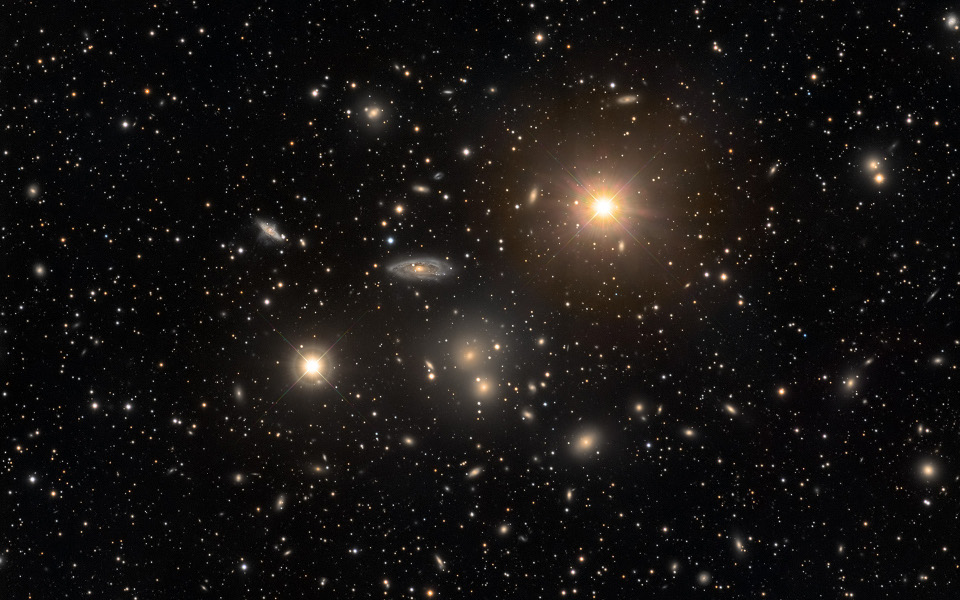 Two stars within our own Milky Way galaxy anchor the foreground of this cosmic snapshot. Beyond them lie the galaxies of the Hydra Cluster. In fact, while the spiky foreground stars are hundreds of light-years distant, the Hydra Cluster galaxies are over 100 million light-years away. Three large galaxies near the cluster center, two yellow ellipticals (NGC 3311, NGC 3309) and one prominent blue spiral (NGC 3312), are the dominant galaxies, each about 150,000 light-years in diameter. An intriguing overlapping galaxy pair cataloged as NGC 3314 is just above and left of NGC 3312. This was yesterday's Picture of the Day. Can you spot it? Also known as Abell 1060, the Hydra galaxy cluster is one of three large galaxy clusters within 200 million light-years of the Milky Way. In the nearby universe, galaxies are gravitationally bound into clusters which themselves are loosely bound into superclusters that in turn are seen to align over even larger scales. At a distance of 100 million light-years this picture would be about 1.3 million light-years across.
__________________
1st in Kommisar's 2009 SM Tournament 1st in I Love You`s 2009 New Year`s Tournament 3rd in EnR's Mashfest '08 tournament 5th in Phynx's Unofficial FFR Tournament 9th in D3 of the 2008-2009 4th Official FFR Tournament 10th in D5 of the 2010 5th Official FFR Tournament 10th in D6 of the 2011-2012 6th Official FFR Tournament FMO AAA Count: 71 FGO AAA Count: 10 Bluearrowll = The Canadian player who can not detect awkward patterns. If it's awkward for most people, it's normal for Terry. If the file is difficult but super straight forward, he has issues. If he's AAAing a FGO but then heard that his favorite Hockey team was losing by a point, Hockey > FFR PS: Cool AAA's Terry - I Love You An Alarm Clock's Haiku beep beep beep beep beep beep beep beep beep beep beep beep beep beep beep beep beep - ieatyourlvllol |
|
|

|
|
|
#111 |
|
lol happy
Join Date: Oct 2005
Location: DESTINY
Age: 33
Posts: 12,193
|
I really respect the amount of effort you put to update this constantly.
Really enjoy reading it every day, thanks for the posts man  |
|
|

|
|
|
#112 |
|
⊙▃⊙
|
I do my best to update the thread daily in a timely manner, I had a stretch of 5 days where I had posted within 1 minute of each other. lmfao
Next week I am cruising up to Tobermory, where I will be camping from Saturday to Monday. I will not have internet access, so this thread will likely be passed off to Sky Kitten during those days and I'll be relying on her to keep the thread alive. Having said that, NEW FEATURE ADDED The upcoming events tab shows important or special events that are more rare than what you'd expect to find in the "What's in the Sky Tonight?" Tab. They'll show up there when it's almost the day of the event, but the upcoming events will give you no more than a months notice of something to look forward to. While I'm in Tobermory, there will be an annular solar eclipse. It will be setting when the moon begins passing the sun at this location, so it should make for an interesting photo (bearing clear skies!) What's in the sky tonight? May 13, 2012 -Use Venus, the bright landmark point in the west-northwest at dusk, to identify stars in the May twilight. Capella is to Venus's upper right. Pollux and Castor are farther to Venus's upper left, and Procyon is lower left of Pollux. These four stars form the enormous Twilight Arch of Spring. -In a telescope, Venus is a crescent becoming more interesting all the time. It has enlarged to about 46 arcseconds tall while waning to about 15% sunlit; watch it changing daily. You may even see Venus's crescent shape with good, firmly braced binoculars. An arcminute is 1/360th of a degree. An arcsecond is 1/360th of an arcminute. Astro Picture of the Day: May 13, 2012 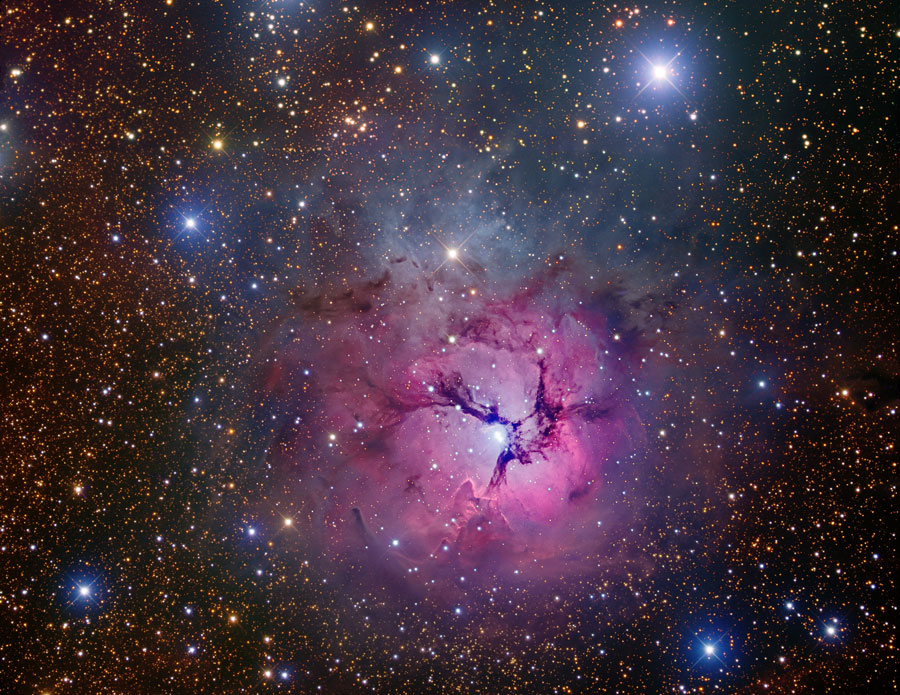 Unspeakable beauty and unimaginable bedlam can be found together in the Trifid Nebula. Also known as M20, this photogenic nebula is visible with good binoculars towards the constellation of Sagittarius. The energetic processes of star formation create not only the colors but the chaos. The red-glowing gas results from high-energy starlight striking interstellar hydrogen gas. The dark dust filaments that lace M20 were created in the atmospheres of cool giant stars and in the debris from supernovae explosions. Which bright young stars light up the blue reflection nebula is still being investigated. The light from M20 we see today left perhaps 3,000 years ago, although the exact distance remains unknown. Light takes about 50 years to cross M20.
__________________
1st in Kommisar's 2009 SM Tournament 1st in I Love You`s 2009 New Year`s Tournament 3rd in EnR's Mashfest '08 tournament 5th in Phynx's Unofficial FFR Tournament 9th in D3 of the 2008-2009 4th Official FFR Tournament 10th in D5 of the 2010 5th Official FFR Tournament 10th in D6 of the 2011-2012 6th Official FFR Tournament FMO AAA Count: 71 FGO AAA Count: 10 Bluearrowll = The Canadian player who can not detect awkward patterns. If it's awkward for most people, it's normal for Terry. If the file is difficult but super straight forward, he has issues. If he's AAAing a FGO but then heard that his favorite Hockey team was losing by a point, Hockey > FFR PS: Cool AAA's Terry - I Love You An Alarm Clock's Haiku beep beep beep beep beep beep beep beep beep beep beep beep beep beep beep beep beep - ieatyourlvllol |
|
|

|
|
|
#113 |
|
⊙▃⊙
|
What's in the sky tonight?
May 14, 2012 -The pair of points you'll find shining fairly high in the southeast at nightfall are Saturn and (to its lower right) Spica. Look to their lower right for the four-star pattern of Corvus, the Crow. Look farther to their upper left for brighter Arcturus, the "Spring Star." -Jupiter is in conjunction behind the Sun. Astro Picture of the Day: May 14, 2012  In the shadow of Saturn, unexpected wonders appear. The robotic Cassini spacecraft now orbiting Saturn recently drifted in giant planet's shadow for about 12 hours and looked back toward the eclipsed Sun. Cassini saw a view unlike any other. First, the night side of Saturn is seen to be partly lit by light reflected from its own majestic ring system. Next, the rings themselves appear dark when silhouetted against Saturn, but quite bright when viewed away from Saturn, slightly scattering sunlight, in this exaggerated color image. Saturn's rings light up so much that new rings were discovered, although they are hard to see in the image. Seen in spectacular detail, however, is Saturn's E ring, the ring created by the newly discovered ice-fountains of the moon Enceladus and the outermost ring visible above. Far in the distance, at the left, just above the bright main rings, is the almost ignorable pale blue dot of Earth.
__________________
1st in Kommisar's 2009 SM Tournament 1st in I Love You`s 2009 New Year`s Tournament 3rd in EnR's Mashfest '08 tournament 5th in Phynx's Unofficial FFR Tournament 9th in D3 of the 2008-2009 4th Official FFR Tournament 10th in D5 of the 2010 5th Official FFR Tournament 10th in D6 of the 2011-2012 6th Official FFR Tournament FMO AAA Count: 71 FGO AAA Count: 10 Bluearrowll = The Canadian player who can not detect awkward patterns. If it's awkward for most people, it's normal for Terry. If the file is difficult but super straight forward, he has issues. If he's AAAing a FGO but then heard that his favorite Hockey team was losing by a point, Hockey > FFR PS: Cool AAA's Terry - I Love You An Alarm Clock's Haiku beep beep beep beep beep beep beep beep beep beep beep beep beep beep beep beep beep - ieatyourlvllol |
|
|

|
|
|
#114 |
|
⊙▃⊙
|
What's in the sky tonight?
May 15, 2012 -Arcturus shines high in the southeast after dark. Vega, equally bright, shines lower in the northeast. A third of the way from Arcturus to Vega look for dim Corona Borealis, the Northern Crown, with its one modestly bright star, Alphecca. -Two thirds of the way from Arcturus to Vega is the dim Keystone of Hercules. Astro Picture of the Day: May 15, 2012  Earth Observatory - Total Solar Eclipse of March 29, 2006: The International Space Station (ISS) was in position to view the umbral (ground) shadow cast by the Moon as it moved between the Sun and the Earth during the solar eclipse on March 29, 2006. This astronaut image captures the umbral shadow across southern Turkey, northern Cyprus, and the Mediterranean Sea. To the casual observer who is outside the world, they would see a black blotch such as the one shown here cutting through the bright daylight sphere; a black void in a world of blues and greens. The photo also helps illustrate why on the ground, the sky gets very dark during a total solar eclipse.
__________________
1st in Kommisar's 2009 SM Tournament 1st in I Love You`s 2009 New Year`s Tournament 3rd in EnR's Mashfest '08 tournament 5th in Phynx's Unofficial FFR Tournament 9th in D3 of the 2008-2009 4th Official FFR Tournament 10th in D5 of the 2010 5th Official FFR Tournament 10th in D6 of the 2011-2012 6th Official FFR Tournament FMO AAA Count: 71 FGO AAA Count: 10 Bluearrowll = The Canadian player who can not detect awkward patterns. If it's awkward for most people, it's normal for Terry. If the file is difficult but super straight forward, he has issues. If he's AAAing a FGO but then heard that his favorite Hockey team was losing by a point, Hockey > FFR PS: Cool AAA's Terry - I Love You An Alarm Clock's Haiku beep beep beep beep beep beep beep beep beep beep beep beep beep beep beep beep beep - ieatyourlvllol |
|
|

|
|
|
#115 | |
|
FFR Player
|
Holy shit.
Instant 5 star thread. I love you <3  "PSR B1509-58 is a pulsar approximately 17,000 light-years away in the constellation of Circinus discovered by the Einstein X-Ray Observatory in 1982. It is approximately 1700 years old and sits in a nebula that spans about 150 light years. NASA described the star as "a rapidly spinning neutron star which is spewing energy out into the space around it to create complex and intriguing structures, including one that resembles a large cosmic hand"
__________________
Quote:
Last edited by darklordsarumon9; 05-15-2012 at 06:27 AM.. |
|
|
|

|
| darklordsarumon9 |
| View Public Profile |
| Find More Posts by darklordsarumon9 |
|
|
#116 |
|
⊙▃⊙
|
Pulsars are awesome. "Every pulsar is a neutron star, but not ever neutron star is a pulsar." Thanks for sharing the photo!
I have added a detailed map of the Annular Solar Eclipse under the "Upcoming Events" tab. If you are NOT shaded region at the edges of the map as indicated, you will be able to see some or all of the eclipse.
__________________
1st in Kommisar's 2009 SM Tournament 1st in I Love You`s 2009 New Year`s Tournament 3rd in EnR's Mashfest '08 tournament 5th in Phynx's Unofficial FFR Tournament 9th in D3 of the 2008-2009 4th Official FFR Tournament 10th in D5 of the 2010 5th Official FFR Tournament 10th in D6 of the 2011-2012 6th Official FFR Tournament FMO AAA Count: 71 FGO AAA Count: 10 Bluearrowll = The Canadian player who can not detect awkward patterns. If it's awkward for most people, it's normal for Terry. If the file is difficult but super straight forward, he has issues. If he's AAAing a FGO but then heard that his favorite Hockey team was losing by a point, Hockey > FFR PS: Cool AAA's Terry - I Love You An Alarm Clock's Haiku beep beep beep beep beep beep beep beep beep beep beep beep beep beep beep beep beep - ieatyourlvllol |
|
|

|
|
|
#117 |
|
⊙▃⊙
|
What's in the sky tonight?
May 16, 2012 -This is the time of year when the Big Dipper floats upside down at its highest due north when the stars come out. Far below it is Polaris. Far below Polaris, near or even below the horizon depending on your latitude, is W-shaped Cassiopeia. Astro Picture of the Day: May 16, 2012 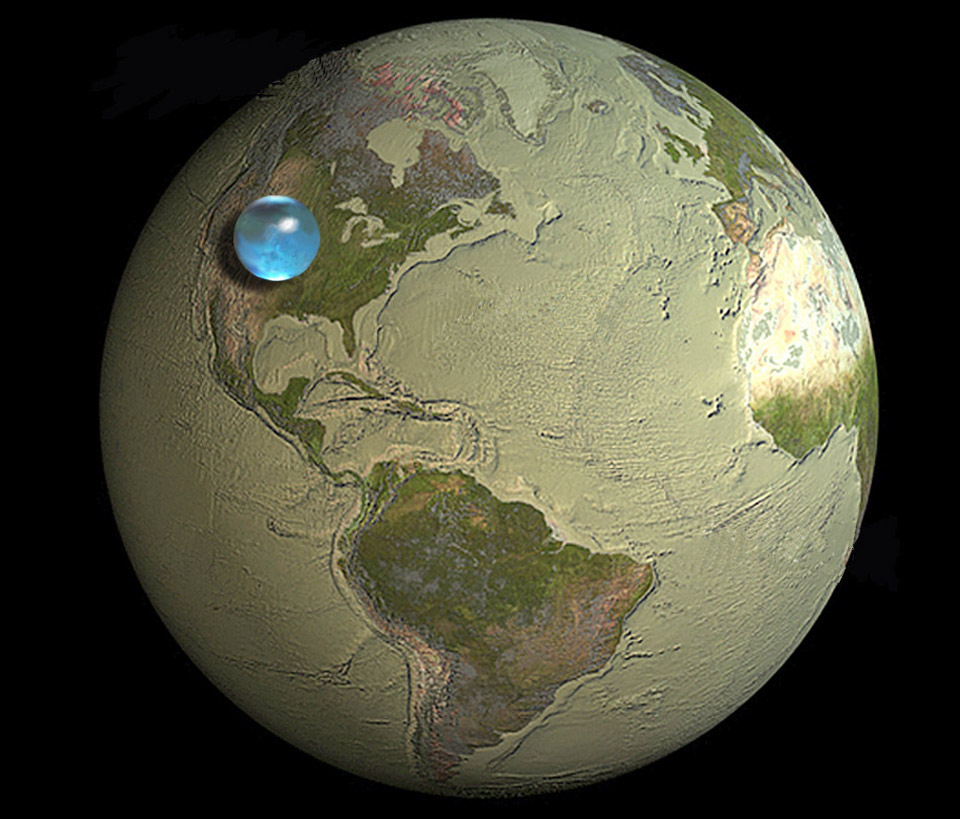 How much of planet Earth is made of water? Very little, actually. Although oceans of water cover about 70 percent of Earth's surface, these oceans are shallow compared to the Earth's radius. The above illustration shows what would happen if all of the water on or near the surface of the Earth were bunched up into a ball. The radius of this ball would be only about 700 kilometers, less than half the radius of the Earth's Moon, but slightly larger than Saturn's moon Rhea which, like many moons in our outer Solar System, is mostly water ice. How even this much water came to be on the Earth and whether any significant amount is trapped far beneath Earth's surface remain topics of research.
__________________
1st in Kommisar's 2009 SM Tournament 1st in I Love You`s 2009 New Year`s Tournament 3rd in EnR's Mashfest '08 tournament 5th in Phynx's Unofficial FFR Tournament 9th in D3 of the 2008-2009 4th Official FFR Tournament 10th in D5 of the 2010 5th Official FFR Tournament 10th in D6 of the 2011-2012 6th Official FFR Tournament FMO AAA Count: 71 FGO AAA Count: 10 Bluearrowll = The Canadian player who can not detect awkward patterns. If it's awkward for most people, it's normal for Terry. If the file is difficult but super straight forward, he has issues. If he's AAAing a FGO but then heard that his favorite Hockey team was losing by a point, Hockey > FFR PS: Cool AAA's Terry - I Love You An Alarm Clock's Haiku beep beep beep beep beep beep beep beep beep beep beep beep beep beep beep beep beep - ieatyourlvllol |
|
|

|
|
|
#118 |
|
⊙▃⊙
|
What's in the sky tonight?
May 17, 2012 -The Summer Triangle is fully up in the east by about 11 p.m. Its top star is Vega, the brightest in the eastern sky. About two fist-widths to Vega's lower left is Deneb. Farther to Vega's lower right is Altair. If you have a dark sky, you'll see that the Milky Way runs through it. Astro Picture of the Day: May 17, 2012 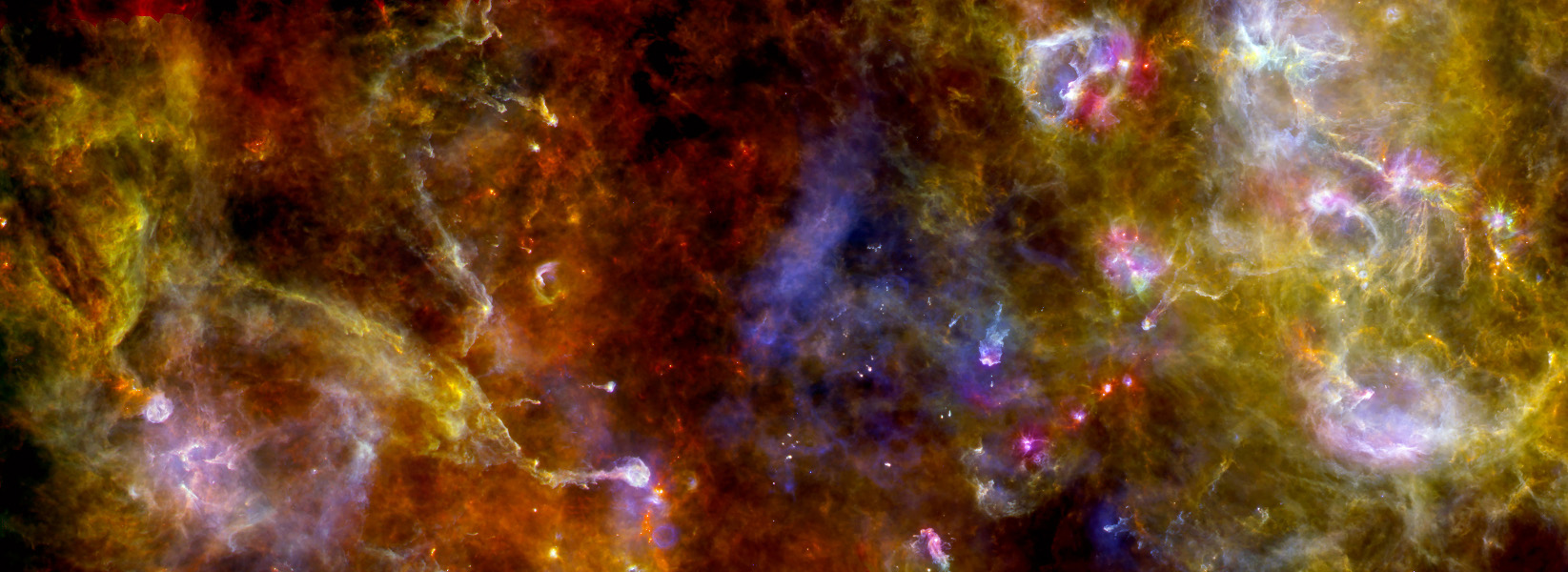 The Herschel Space Observatory's infrared view of Cygnus X spans some 6x2 degrees across one of the closest, massive star forming regions in the plane of our Milky Way galaxy. In fact, the rich stellar nursery already holds the massive star cluster known as the Cygnus OB2 association. But those stars are more evident by the region cleared by their energetic winds and radiation near the bottom center of this field, and are not detected by Herschel instruments operating at long infrared wavelengths. Herschel does reveal the region's complex filaments of cool gas and dust that lead to dense locations where new massive stars are forming. Cygnus X lies some 4500 light-years away toward the heart of the northern constellation of the Swan. At that distance this picture would be almost 500 light-years wide.
__________________
1st in Kommisar's 2009 SM Tournament 1st in I Love You`s 2009 New Year`s Tournament 3rd in EnR's Mashfest '08 tournament 5th in Phynx's Unofficial FFR Tournament 9th in D3 of the 2008-2009 4th Official FFR Tournament 10th in D5 of the 2010 5th Official FFR Tournament 10th in D6 of the 2011-2012 6th Official FFR Tournament FMO AAA Count: 71 FGO AAA Count: 10 Bluearrowll = The Canadian player who can not detect awkward patterns. If it's awkward for most people, it's normal for Terry. If the file is difficult but super straight forward, he has issues. If he's AAAing a FGO but then heard that his favorite Hockey team was losing by a point, Hockey > FFR PS: Cool AAA's Terry - I Love You An Alarm Clock's Haiku beep beep beep beep beep beep beep beep beep beep beep beep beep beep beep beep beep - ieatyourlvllol |
|
|

|
|
|
#119 |
|
⊙▃⊙
|
Attention: This is the last time I will personally be updating this thread until the 22nd of May. Sky Kitten will be taking over for me while I embark on a camping trip over 360km away from my computer. I will be in an area with virtually no light pollution, and with any luck, weather permitting, I may just end up posting my own photos as the picture of the day. :P Having said this, for May 20ths Annular eclipse, if you cannot see it because you're outside of the path, you can go online here to choose your area to watch:
http://www.skyandtelescope.com/news/...151887305.html What's in the sky tonight? May 18, 2012 -Arcturus is the brightest star high in the southeast these evenings. It's the leading light of the constellation Bootes, the Herdsman. The main stars of Bootes form a narrow, bent kite shape extending left of Arcturus, nearly three fists at arm's length long. Or maybe the kite is a pointy-toed shoe, with Arcturus the tip of the toe. This constellation also holds the Bootes Void, a huge mass of space with almost no galaxies.  Astro Picture of the Day: May 18, 2012 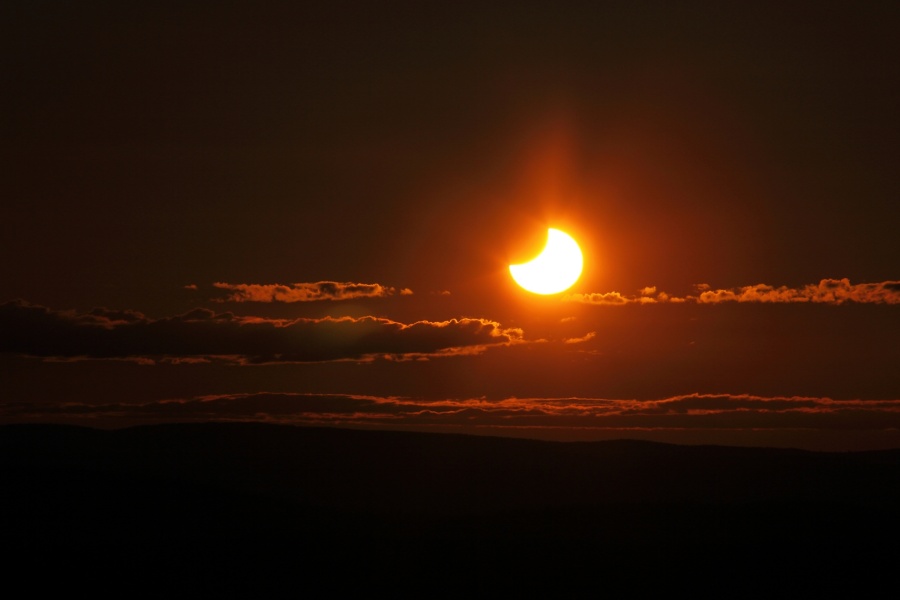 On June 1, the shadow of the New Moon was cast across a land of the midnight Sun in last year's second partial solar eclipse. This picture of the geocentric celestial event above the Arctic Circle was taken near midnight from northern Finland's Kaunispää Hill in Lapland. Of course the region's reindeer were able to watch as both Moon and Sun hugged the northern horizon just above a cloud bank. Also visible from parts of Alaska and Canada, the eclipse began at sunrise in Siberia and northern China at 19:25 UT, ending about 3.5 hours later north of Newfoundland in the Atlantic Ocean. Remarkably, just one lunation later, on July 1 the New Moon's shadow again reached out and touched the Earth in a partial solar eclipse, limited in visibility to a relatively small area in the Antarctic Ocean. This is the beginning of what most people are going to see in the evening around around or before sundown in the United States on May 20th.
__________________
1st in Kommisar's 2009 SM Tournament 1st in I Love You`s 2009 New Year`s Tournament 3rd in EnR's Mashfest '08 tournament 5th in Phynx's Unofficial FFR Tournament 9th in D3 of the 2008-2009 4th Official FFR Tournament 10th in D5 of the 2010 5th Official FFR Tournament 10th in D6 of the 2011-2012 6th Official FFR Tournament FMO AAA Count: 71 FGO AAA Count: 10 Bluearrowll = The Canadian player who can not detect awkward patterns. If it's awkward for most people, it's normal for Terry. If the file is difficult but super straight forward, he has issues. If he's AAAing a FGO but then heard that his favorite Hockey team was losing by a point, Hockey > FFR PS: Cool AAA's Terry - I Love You An Alarm Clock's Haiku beep beep beep beep beep beep beep beep beep beep beep beep beep beep beep beep beep - ieatyourlvllol |
|
|

|
|
|
#120 |
|
Crazy Cat Lady
Community Manager, User Support
Join Date: Aug 2007
Location: Ontario, Canada
Age: 30
Posts: 1,079
|
What's in the sky tonight?
May 19, 2012 -Venus, moving lower in the west every evening as twilight fades, is now 2° left of much fainter Beta Tauri, which has been descending almost in parallel with it. Have you been monitoring the crescent Venus this month? -Partial/annular solar eclipse tomorrow! On Sunday afternoon, all but easternmost North America will experience at least a partial eclipse of the Sun. So will the Pacific and (on the morning of May 21st local date) the eastern half of Asia. The eclipse will become annular — with the rim of the Sun a brilliant ring surrounding the dark silhouette of the Moon — along a path from south China and parts of Japan across the Pacific to the California-Oregon coast and from there southeastward to end at sunset in Texas. If you are not in the path of the Eclipse, you can watch it happen online live here.[U Astro Picture of the Day: May 19, 2012  On June 15, the totally eclipsed Moon was very dark, with the Moon itself positioned on the sky toward the center of our Milky Way Galaxy. This simple panorama captures totality from northern Iran in 8 consecutive exposures each 40 seconds long. In the evocative scene, the dark of the eclipsed Moon competes with the Milky Way's faint glow. The tantalizing red lunar disk lies just above the bowl of the dark Pipe Nebula, to the right of the glowing Lagoon and Trifid nebulae and the central Milky Way dust clouds. At the far right, the wide field is anchored by yellow Antares and the colorful clouds of Rho Ophiuchi. To identify other sights of the central Milky Way just slide your cursor over the image. The total phase of this first lunar eclipse of 2011 lasted an impressive 100 minutes. Parts of the eclipse were visible from most of planet Earth, with notable exceptions of North and Central America. While the Milky Way Bluearrowll is probably seeing right now (weather permitting) is not going to feature a total eclipse deep in it, tomorrow's Annular Solar Eclipse should more than make up for that.
__________________
 FMO AAAs (22): Heavenly Spores, .357 Magnum, Pure Ruby, VS Boss Battle, Black, You Goddamn Fish, Faint Breath, Epilogue, Crimson Flood, Zombie Killing Blood Spilling, Saffron City (offline), Fast Asleep, R2, Her Majesty, Defection, Happy Meal, Bit Blue, Stupor of Peace, Tightwad, Progressive jikuu shoujo! Urashima Taroko-chan!, Annihilator Method, Skyfire Ace |
|
|

|
| Sky Kitten |
| View Public Profile |
| Find More Posts by Sky Kitten |
 |
| Currently Active Users Viewing This Thread: 1 (0 members and 1 guests) | |
| Display Modes |
 Linear Mode Linear Mode |
 Switch to Hybrid Mode Switch to Hybrid Mode |
 Switch to Threaded Mode Switch to Threaded Mode |
|
|










